

The Cost of Travel in Peru: A 2023 Budget Breakdown
Peru is such a wonderful country to travel in.
Cusco embodies European classiness while Lima is bustling and vibrant. Machu Picchu is full of enchantment while Huacachina mysterious and rare. Colca Canyon is stunningly vast while Arequipa is surrounded by volcanoes. But there is one characteristic each Peruvian destination has in common: heart. The Peruvian heart beats loudly and proudly, and I dare you not to fall in love with it, too.
In Peru, there’s something for everyone, no matter the type of adventure you might be craving.
The most recognizable Peruvian destination is Machu Picchu and let me just start by saying, yes, it’s worth it. But there is so much to see in this bountiful country, so it would be worth your time and money to explore more than just one corner. I found getting around the country easy and cheap to do.
Peru is on the modest side in the way of costs. Which is exciting because that means you can fit more in for less.
I mainly stayed in guesthouses, and utilized the public transportation system, including flights, buses, trains, and taxis. Lima was the most expensive stop, with its pricier restaurants, hotels and nightlife, but outside of the capital I found costs to be more than reasonable.
January, May and June are the busiest months of the year to visit Cusco. Aim to travel outside of these times so your money goes further. But if you find yourself in Cusco during the busy time, go anyway!
La Ciudad Imperial, or the Imperial City, is a shining star in Peru. Situated in the Inca Region, and adjacent to the Urubamba Valley, this city is the main base for those looking for a Machu Picchu and Sacred Valley adventures. Yet, Cusco is an adventure all its own. The main square is dazzling with standout architecture framing dozens of restaurants, bars and coffee shops overlooking visitors snapping photos and milling about. It’s easy to waste time exploring the cobblestoned streets of Cusco (I sure did!) but eventually you will want to make your way up to the famous mountain.
The last stop on my trip was Huacachina. It’s an oasis in the middle of nowhere resembling a slither of life where there appears to be none. It’s stunning because it’s peculiar. A small town consisting mainly of hotels, restaurant and bars surrounding a shallow oasis in the middle of sand dunes – It’s a sight to see.
If you’re not pressed for time, the Gringo Trail hits all the right places across the country. Expect the journey to take two or more weeks (if you aim to hit all the spots). The famed path starts in Lima and follows the curve, stopping in Paracas, Huacachina, Nazca, Arequipa, Puno and Cusco.
Today, I’m going to be sharing how much you can expect to spend on a trip to Peru.
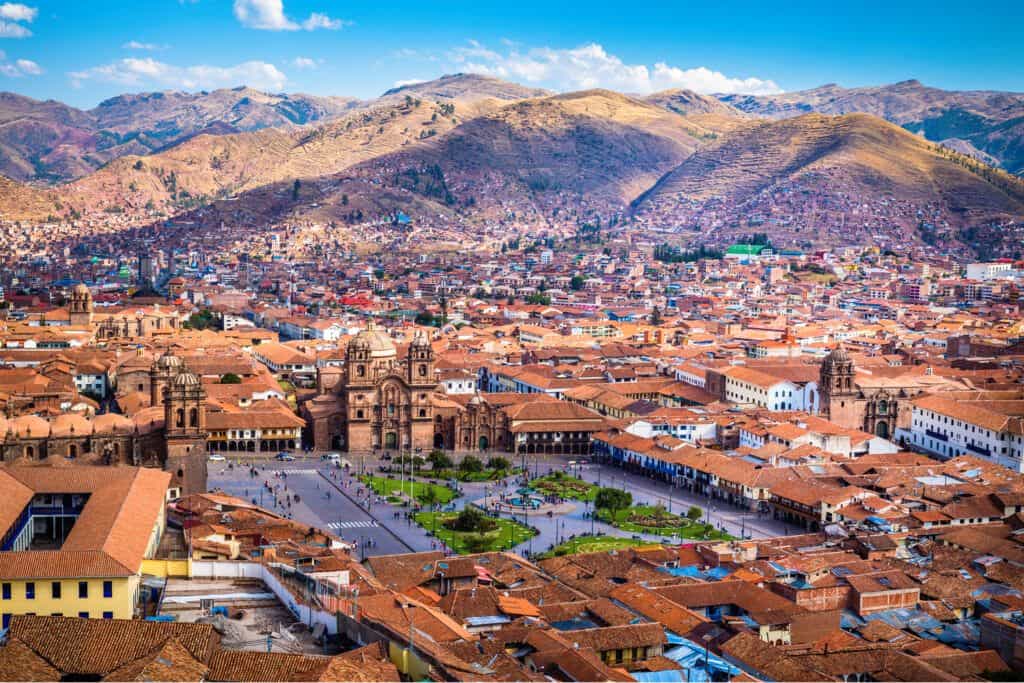
Peru’s Gringo Trail: Where to Go
If you’re starting to plan your trip to Peru and aren’t quite sure where to go, you may find it useful to know that there’s a ready-made route, set up for you to follow.
Allow me to introduce you to the Gringo Trail. It is, essentially, the main itinerary that most visitors follow around the country, taking you to the very best that the country has to offer. Most visitors will fly into Lima, then follow the route in a counter-clockwise direction over to Cusco. Here’s a map:
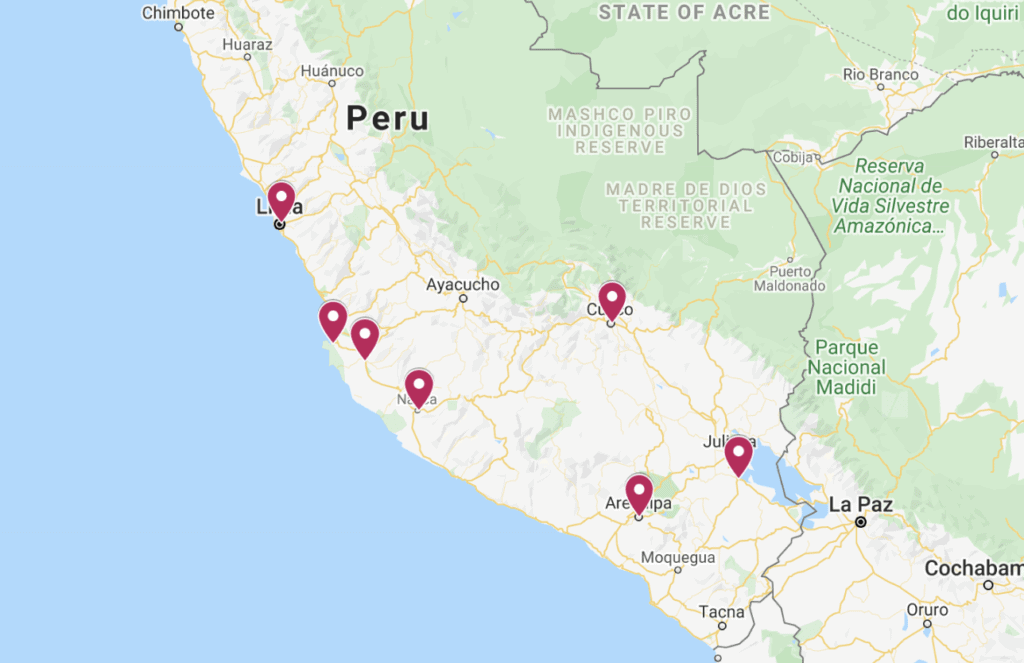
If you have two weeks to spend in the country, I recommend breaking up your time as so:
Day One: Lima Day Two: Lima Day Three: Paracas Day Four: Paracas Day Five: Nazca Day Six: Huacachina Day Seven: Huacachina Day Eight: Arequipa Day Nine: Arequipa Day 10: Puno Day 11: Puno Day 12: Cusco Day 13: Cusco / Machu Picchu day trip Day 14: Cusco
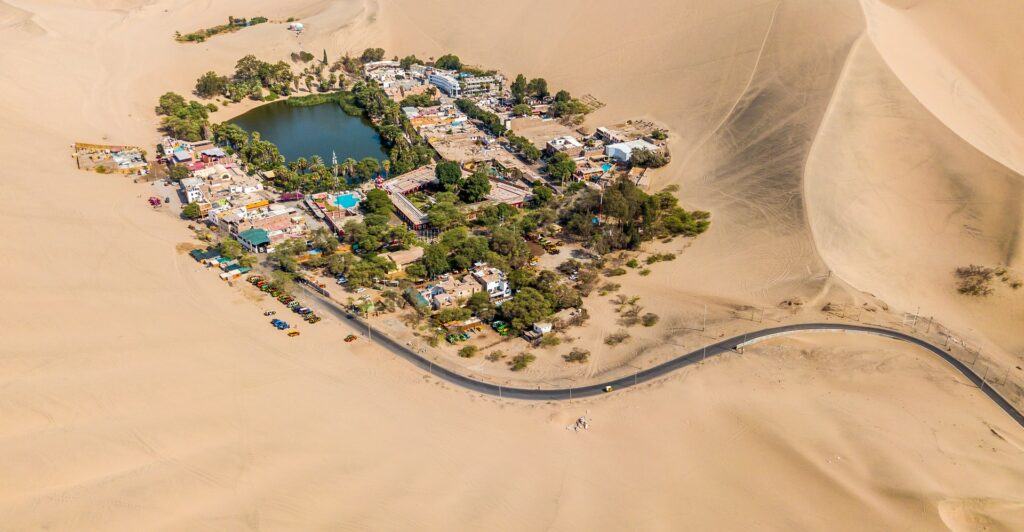
The Cost of Accommodation in Peru
You can visit Peru on any budget, from a $10 a night hotel in Cusco that’s rated 9 on Booking to a spectacular $270 a night lodge on the shores of Lake Titicaca. Overall, though, I think you’re going to be pleasantly surprised by the prices of lodging in Peru: it’s inexpensive and high-quality.
In this blog post, I’m going to be focusing on value . Because whether you’re travelling as a solo backpacker on a shoestring, as part of a couple on a mid-range budget, or as a family looking for a little luxury, value is the one thing you’re going to be looking for. That doesn’t mean cheap — it means offering up more than similarly-priced options.
There’s some seriously great value accommodation up for grabs in Peru, so to start with, I’m going to cover the cheapest way to travel the country.
If you’re on the tightest of tight budgets, there are several options that’ll land you with free accommodation while you’re in the country. Courchsurfing allows you to connect with locals by sleeping on spare sofas in their homes. It doesn’t cost a penny to do so and is a fantastic way to gain an insight into Peruvian daily life away from the tourists. There are over 100,000 hosts in Peru, so there’s sure to be someone who’s right for you.
Housesitting is a more upmarket way to avoid paying for accommodation, as it’s aimed at the mid-range and luxury travellers. You’ll be looking after homes and pets while their owners are on holiday, and the houses can be extremely luxurious. This option works best if you don’t have fixed travel dates, as you’ll be agreeing to dates that the owners set.
Finally, when it comes to free accommodation, you could take a look at WorldPackers in Peru , where you’ll be able to volunteer for locals in exchange for food and board. There are some seriously cool options available on the site, from helping out at a local surf school to lending a hand at building an eco-sanctuary in the rainforest. Readers of this site get a $10 discount for WorldPackers with the promo code neverendingfootsteps .
If you’re not looking to travel for free and just want a clean and comfortable room to sleep in, there are plenty of great options, too.
One of the most affordable ways to explore Peru is by staying in a hostel. I stayed in several over my first visit to the country and was impressed by the quality of the hostels, as well as how many there are to choose from. Let’s look at the best-reviewed hostels in the country.
- The best hostel in Lima is easily Pariwana Hostel , where dorms are priced at just $11 per person , and private doubles come in at $39 per night . As an added bonus, it’s right in the centre of Miraflores: my favourite neighbourhood in Lima!
- In Paracas , you can’t get better than Atenas Backpackers , where double rooms are priced at just $19 a night . In a town where most hostels are rated poorly, this well-reviewed spot is a no-brainer.
- You’ll likely be heading to Nazca while you’re in Peru, and if so, I recommend Nazca Travel One Hostel , which has double rooms for $22 a night . Staff are friendly and can help you with booking your scenic flights, the breakfast is generous, and the rooms comfortable.
- Huacachina is home to Banana’s Adventure Hostel , where dorms are priced at $17 a night and doubles at $28 a night . No wonder it’s the best-rated budget accommodation in town, as it’s home to the most epic swimming pool. It’s well-worth staying here while you’re getting your oasis on.
- What about Arequipa ? Way Kap Hostel is the only place I’d consider staying. Not only is it inexpensive at $6 a night for a dorm, but the beds are comfortable, the rooms are slick and modern, and the staff so friendly.
- And finally, Cusco , where you have to stay at Nao Victoria Hostel (dorms $11 a night ; private doubles $40 a night ). It’s peaceful and laidback, right in the heart of town, and the staff can help you out with anything you need — including leaving your backpacks with them while you hike Machu Picchu.
Overall, then, you can see that you can expect to spend around $10 a night for dorms in Peru, and around $20-40 a night for a private double room.
Okay, but what if you’re not a budget traveller and just want to stay in a lovely, well-reviewed hotel or guesthouse that’s good value for money and has all the things you need from a place to lay your head? I’ve got you! When I visited Peru, I opted to spend half of my trip staying in backpacker hostels and the other half in well-reviewed guesthouses. For around $60 a night , you’ll be able to stay in an excellently-reviewed hotel, in a central location with friendly staff.
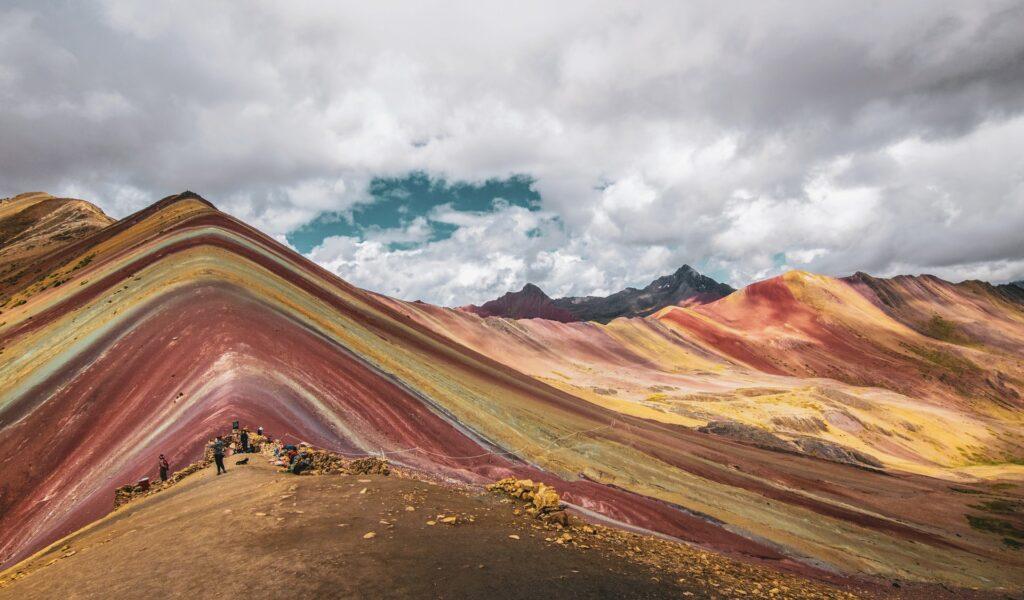
Where to Stay While Traveling in Peru
When I’m travelling, I’m always conscious to book the absolute best accommodation out there — well, as long as it doesn’t amount to hundreds of dollars a night. I can easily spend several hours researching accommodation for every stop along my way, ensuring I’ve chosen the place in the best location with the friendliest staff, and the greatest value for money.
My biggest tip? When you head to Boo k ing to find a hotel, ignore the results that are sorted under “Our Top Picks” — that’s a list of all of the hotels that pay Booking the highest commission, some of which have some pretty poor write-ups. Instead, opt to sort the properties by “Top Reviewed”. That way, you’ll be able to see which options genuinely have the best reviews.
But all that to say, when I was planning my trip to Peru, I put in the hard work so you don’t have to. Here’s where I recommend staying:
Lima: Ana Frank Hospedaje ($70 a night for a double room) — Kick-off your Peru trip with the best-rated hotel in town! Ana Frank Hospedaje is the most beautiful property with the loveliest owners ever. Ana and Frank will take you into their home, welcome you, and have you feeling like you’re family. The hotel is right in the heart of Miraflores — my favourite neighbourhood — yet still quiet and peaceful, so you can sleep. The rooms themselves are clean, large, and comfortable, and the shower pressure some of the best you’ll encounter in Peru.
Paracas: Casa Paracas (108 a night for a double room) — This is a lovely spot, a block back from the beach, close to the main square, with easy access to the boat tour companies and best restaurants in town. The owner, Francisco, is a gem, whipping up excellent breakfasts in the morning, arranging tours for you throughout the day, and even picking you up from the bus station so you don’t have to walk. With a beautiful view of the ocean from the property, this makes for a wonderful stay in Paracas.
Nazca: Casa Hacienda Nasca Oasis ($65 a night for a queen room) — Nazca isn’t the nicest of areas in Peru, but if you’re keen to see the Nazca Lines, it’s inevitable that you’ll end up spending one night in town. Still, Casa Hacienda is the best option out there for travellers, with a peaceful garden, large swimming pool, and helpful staff. Just ask at reception and they’ll be able to help you arrange safe onward travel, book a tour to see the Nazca Lines for you, and help you explore the archaeological sites in Nazca that are often overlooked.
Huacachina: The Upcycled Hostel ($31 a night for a double room) — It’s all about the vibes in this hostel, as the place is full of the coolest, colourful decorations — all upcycled, of course. It’s in a great location, too, within walking distance to the dunes, but not directly in the party zone, so it’s still peaceful. You also get access to a good-sized swimming pool and some of the best food in the country. Join in with cocktail-making classes, salsa lessons, or simply chill in the beautiful garden. In a place that seems to attract uniformly poor accommodation options, the Upcycled Hostel is easily the best option in town, no matter your budget.
Arequipa: Las Torres de Ugarte ($50 a night for a double room) — This is such an adorable hotel, right in the heart of everything you’ll want to see in Arequipa. The breakfast is fantastic, the rooms are large and spotless, and the owners so sweet. As an added bonus, you’ll have access to the rooftop terrace, which overlooks the city and offers some seriously special views.
Puno: Uros Waliski Lodge ($85 a night for a double room) — I suspect just looking at the photos on the Booking listing will be all it takes it have you committing to stay here. And if the photos don’t? Well, I’d be very surprised. This is a once-in-a-lifetime experience; the opportunity to stay on a peaceful island away from all of the Puno day-trippers, experiencing a slice of authentic local life. As an added bonus, all of the excursions on the lake are free! They’re included in your room price. Honestly, this is one of the most wonderful places on Lake Titicaca.
Cusco: MOAF Cusco Boutique Hotel ($60 a night for a double room) — There’s a reason why this hotel is the top-rated in all of Cusco. It’s due to the location, which is close to all of the markets, restaurants, and tourist attractions. It’s due to the friendly staff who go out of their way to ensure you have the best trip ever. It’s due to the ability to easily book all of your tours through them, whether you want to hike to Machu Picchu or see Rainbow Mountain. And it’s due to the delicious, filling breakfast. I wouldn’t consider staying anywhere else in Cusco.
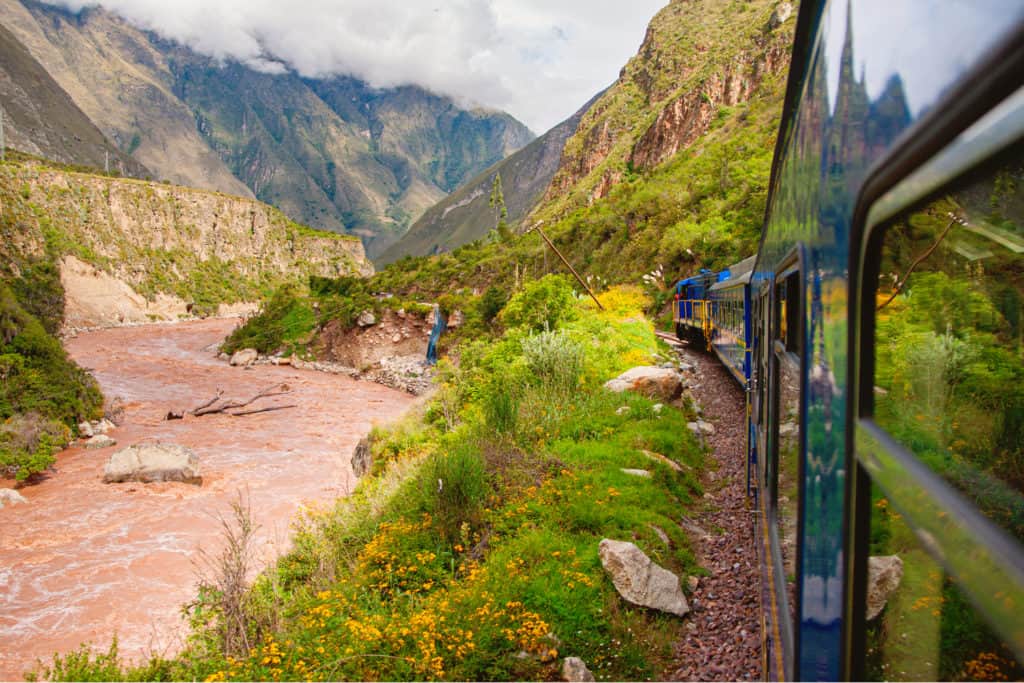
The Cost of Transportation in Peru
Travelling across Peru is super-easy, and there are tons of options to help you do so. While I was in the country, I used planes, buses, trains, colectivos, and taxis, and loved getting to experience such a diverse range of transportation.
If you’re short on time, it’s worth taking a look at the offerings from domestic airlines, like LATAM , as sometimes flights within Peru cost the same as the buses. As an example, I paid just $38 for a flight from Cusco to Lima, at the end of my trip, skipping the 22 hour[!] bus trip and paying just an extra $14 to do so.
If you’re not in a rush and really want to see as much of Peru as possible, you’ll be impressed with the country’s extensive bus network. I recommend Tepsa and Cruz Del Sur as the best bus companies for visitors to Peru, (Tepsa is a bit cheaper), as both are safe and reliable options. I found both of these companies to be cheaper than the alternatives, like Oltursa, and they were so much easier to navigate during the booking process.
So much can you expect to pay when bussing your way around the country? In 2023, you’ll be looking at the following:
- Bus from Lima to Cusco with Tepsa: $16
- Bus from Lima to Arequipa with Tepsa: $15
- Bus from Lima to Cusco with Cruz Del Sur: $24
- Bus from Cusco to Ica with Cruz Del Sur: $23
- Bus from Lima to Ica with Cruz Del Sur: $5
Not bad, right?
When you’re not travelling from city to city, you’ll most likely utilise the country’s taxis, and yes — Uber is available in Peru.
When hailing a taxi on the street, make sure you agree on a price point before getting in the cab, or make sure the meter is on. And prepare to have an argument over that, as you do in basically every country around the world.
Colectivos (shared taxis) are another option for saving money, and one we utilized often. These colectivos can be a car, bus or minibus, and you can hail them pretty much anywhere in the country. They charge a set fare and are often waiting at popular destinations until they have a certain number of passengers.
The Tren Eléctrico , or the Electric Train, in Lima is a terrific choice for travel within the city’s limits, with multiple lines linking various sites and districts. You can expect to pay $1.80 for a card that you can use between stations (costs between stations vary) and then reload when needed.
When it’s time to venture outside of Lima, you have plenty of options.
If you’re not pressed for time, the Gringo Trail hits all the best spots across the country, and most travellers opt to follow its route. This famed path starts in Lima and offers up stops in Paracas, Nazca, Huacachina, Arequipa, Puno, and Cusco. Expect the journey to take two or more weeks (if you aim to hit all the spots) but if you opt for a quicker expedition, you can see the main destinations within a week. Have three weeks? You’ll be able to go slower and ensure you see it all without rushing.
So, what’s the easiest way to traverse the Gringo Trail?
Peru Hop is an awesome company (and concept!) for all of my backpackers out there! They offer the flexibility, convenience, and safety of an upscale tour company but with a decent price tag. A three-day trip across the Gringo Trail starts at $159 and includes a six-stop hop-on hop-off pass, pick up and drop off at hostels, an on-board Peruvian guide, free access to various sites along the route, and more. Seriously, you get so much for your money with Peru Hop, especially as they squeeze in many attractions most tour companies brush past.
Getting to Machu Picchu from Cusco was an adventure! This was the only time I used a train during my Peruvian travels, and it happened to be one of my best ever experiences. The ride is like a dream, surrounded by endless greenery, raging waters, and sharp cliff-sides.
PeruRail runs from Cusco/Ollantaytambo to Machu Picchu for $38. Keep in mind there are bundled options, some guided and some self-guided, that get you to Machu Picchu for a flat price. If you’re not a hiker, taking the train to Machu Piccho is an experience that can’t be missed.
The average cost of transportation is: $17 per day
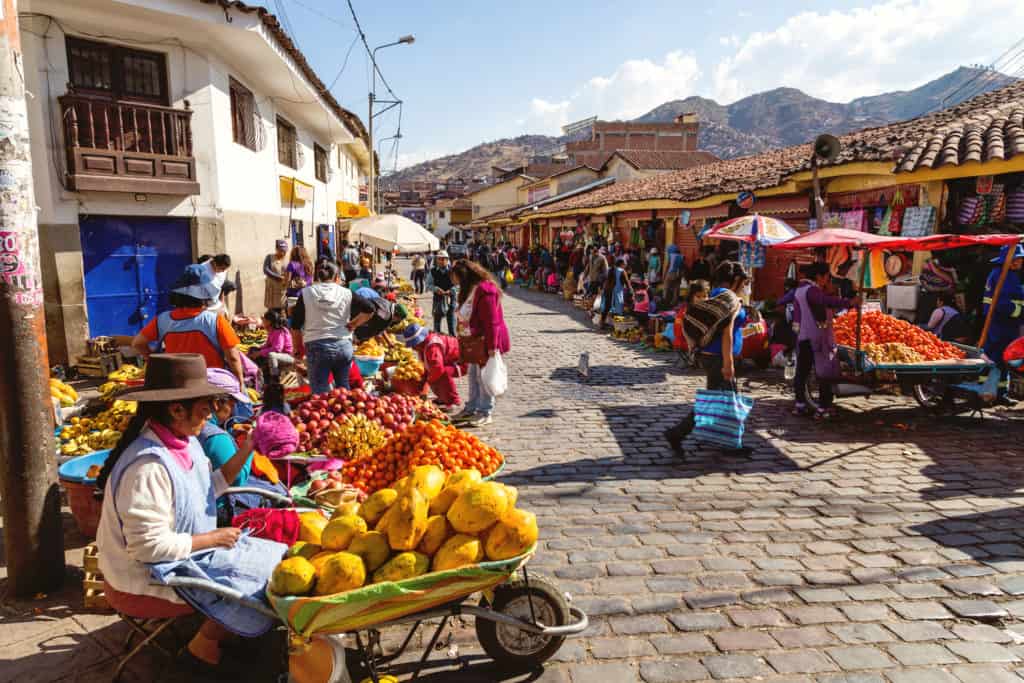
The Cost of Food in Peru
Peruvians are food geniuses, with a heritage influenced by Spanish, Asian, Italian, and African regions, all blended together in order to create a unique culinary identity. They have perfected the art of contrast within a plate, often mixing hot with cold and sweet with savory.
Eating out in Peru is an inexpensive way to sample the local delights, so there’s little reason to cook meals yourself. A typical breakfast includes bread and butter with ham or jam, as well as seasonal soups and coffee or tea, and averages just $3.
Lunch is kind of a big deal here, so much so that its time dictates business hours. Plan your midday meal to take place between 1 and 3 p.m., and prepare to work your way through a starter, main course, drink, dessert, and a siesta . Did I mention I love this country? Lunch will set you back $6, and dinners are similar in cost, depending on your splurge level, but you can expect to between $5 and $10.
Ceviche, or Peruvian sushi, is the most iconic dish in the country and typically includes sea bass, lime, and various spices. Think of ceviche as Peru’s food mascot, but it’s not the only dish on the menu. Lomo saltado (stir-fried beef), papa a la huancaina (creamy, cheesy and spicy potatoes) and pollo a la brasa (rotisserie chicken) are all staples you should sample while you’re in the country.
Having said that, I practically ate ceviche for breakfast, lunch, and dinner with zero complaints.
In the bigger cities like Lima, Arequipa and Cusco you’ll find an increase in prices for these dishes. For example, ceviche prices throughout the country range from $3 to $15 while lomo saltado goes from $2 to $11. Pollo a la brasa ranges from $2 to $5.
Street grills are common in Peru, but you’ll find they’re more abundant in smaller towns and villages. You can get chorizo, marinated chicken breast, or a hunk of cecina for a mere $1.50, so if you’re backpacking around the country, this is an affordable way to stay full.
Pisco sours are a way of life when it comes to alcoholic beverages in Peru. Delicious, but tart, the drink flows in all regions in many different forms. If you’re not into sour drinks, order a pisco on the rocks, it’s most similar to tequila in taste. Pisco cocktails go for about $6.
Vino in Peru is not revered as top notch, however Vista Alegre offers a respectable selection for the – practically free – price of $1 per bottle. while Tacama’s wines are around $7 a bottle. If you fancy yourself a wine buff, check out an international blend from Argentina or Chile instead. Beer is cheap in Peru. A large bottle will put you back $1.30. Look out for popular Peruvian brews, Pilsen Calloa and Cristal.
The average cost of food in Peru is: $18 per day
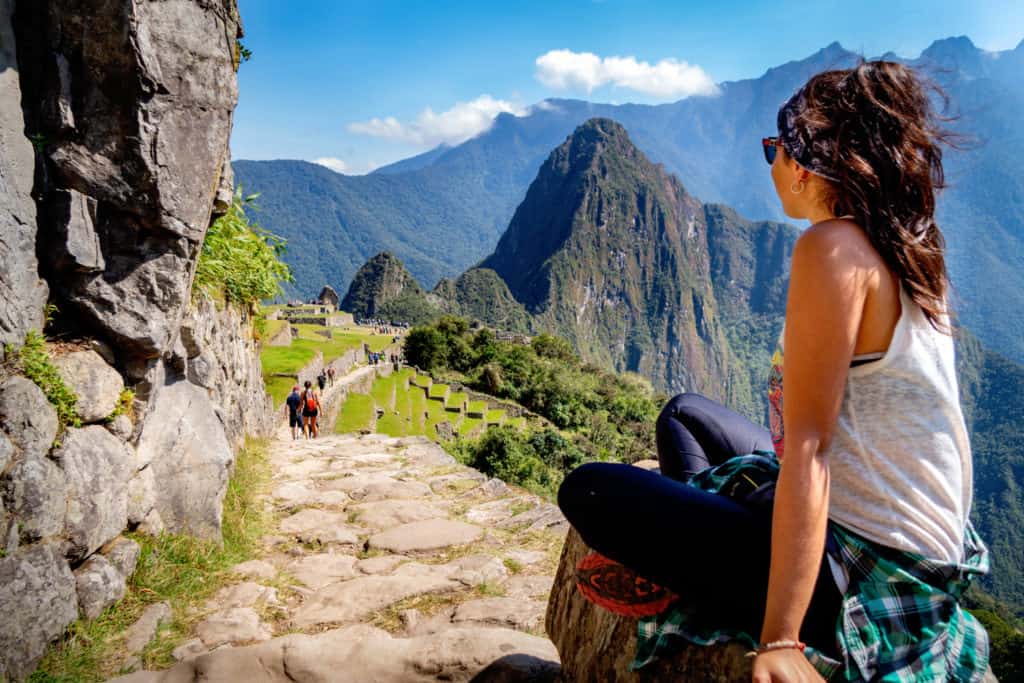
The Cost of Activities and Entrance Fees in Peru
Whether you love the beach, the mountains, or the rainforest, Peru has something for you.
Machu Picchu is, of course , the country’s national treasure, and world-famous for a reason. No matter how you choose to get there (hike, bus, train) you’ll need to devote at least a day to the excursion. I left at 4 am from Cusco and arrived back around 9 pm that same night, paying $38 for the train. It’s a long day but worth every step of the trek.
Sandboarding in Huacachina was a tumbling adventure. The rolling dunes are photogenic, inviting, and surprisingly soft — just in case you take an unexpected dive. For $15, our tour took us out for a half-day trip in the desert, which included transportation in a buggy and hours of shredding the sand.
What if you don’t have much cash to splash?
Hiking is the perfect way to see more of the Peruvian landscape, and you don’t have to spend a penny to do so. Colca Canyon is often overshadowed by Machu Picchu, but it’s ample in trails and thick with stunning terrain and steep canyons. If you’re up for the challenge, try the descent into Colca Canyon from the Cruz del Cóndor lookout — trust me, it’s unbelievable .
Get Your Guide is one of my favourite travel websites — it helps you filter through all of local tour companies to find the cheapest and highest-rated experiences, without having to spend hours trawling through TripAdvisor and forums. I book all of my tours through them these days, and can’t recommend them enough.
The average cost of activities in Peru comes to $36 per day .
The Cost of Travel Insurance in Peru
If you’ve read any other posts on Never Ending Footsteps, you’ll know that I’m a great believer in travelling with travel insurance. I’ve seen far too many Go Fund Me campaigns from destitute backpackers that are unexpectedly stranded in a foreign country after a scooter accident/being attacked/breaking a leg with no way of getting home or paying for their healthcare. These costs can quickly land you with a six-figure bill to pay at the end of it.
In short, if you can’t afford travel insurance, you can’t afford to travel.
Travel insurance will cover you if your flight is cancelled and you need to book a new one, if your luggage gets lost and you need to replace your belongings, if you suddenly get struck down by appendicitis and have to be hospitalised, or discover a family member has died and you need to get home immediately. If you fall seriously ill, your insurance will cover the costs to fly you home to receive medical treatment.
I use SafetyWing as my travel insurance provider, and recommend them for trips to Peru. Firstly, they’re one of the few companies out there who will actually cover you if you contract COVID-19. On top of that, they provide worldwide coverage, don’t require you to have a return ticket, and even allow you to buy coverage after you’ve left home. If you’re on a long-term trip, you can pay monthly instead of up-front, and can cancel at any time. Finally, they’re way cheaper than the competition, and have a clear, easy-to-understand pricing structure, which is always appreciated.
With SafetyWing, you’ll pay $1.50 a day for travel insurance.
How Much Does it Cost to Travel in Peru?
With all of that being said, it’s time to tally up all of my travel expenses in Peru, in order to give you an idea of how much you can expect to spend while travelling in this wonderful country:
Accommodation: $37 per day Transportation: $17 per day Food: $18 per day Activities: $36 per day Total amount spent per day: $108
Planning a Trip to South America?
I have a bunch of budget breakdowns for South American countries for you to peruse:
- The Cost of Travel in Bolivia
- The Cost of Travel in Chile
And don’t forget to check out The Cost of Travel, well, Everywhere : my master list of detailed expense reports, covering the cost of visiting over 50 countries around the world!
Are you planning a trip to Peru? Have any questions? Let me know in the comments below!
Related Articles on Peru 🇵🇪 23 Fantastic Things to Do in Lima, Peru (2023)
Lauren Juliff
Lauren Juliff is a published author and travel expert who founded Never Ending Footsteps in 2011. She has spent over 12 years travelling the world, sharing in-depth advice from more than 100 countries across six continents. Lauren's travel advice has been featured in publications like the BBC, Wall Street Journal, USA Today, and Cosmopolitan, and her work is read by 200,000 readers each month. Her travel memoir can be found in bookstores across the planet.
Related Posts

The Cost of Travel in Mauritius: My Detailed Budget Breakdown

The Cost of Travel in Thailand: My Detailed Budget Breakdown
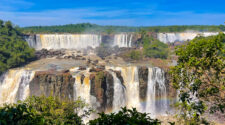
The Ultimate Guide to Iguazu Falls: Argentina and Brazil

2023: My Travels in Review

The Cost of Travel in South Korea: My 2024 Budget Breakdown
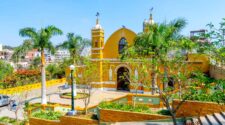
23 Fantastic Things to Do in Lima, Peru
Didn’t find a better, in depth article on Peru than this… it’s simply brilliant and extremely informative and well written ! You’ve really done a great, great job for all fellow travellers, please accept my sincere compliments and regards🙏🏼🙏🏼🙏🏼
I’m from India and my daughter and I plan a 15 days travel to Peru in August of 22. Although your article has almost everything for planning a trip, we have some destinations in mind which you don’t mention hence a request to you for assisting in forming our plan. Our points of interest;
1. Land at Lima. 2. Nazca. 3. Hucachina. 4. Arequipa. 5. Cusco. 6. Rainbow Mountain. 7. Colca Canyon. 8. Manu Nature Reserve. 9. Humantay Lake. 10. Amazon Forest. 11. Lima and return.
Most of the above aren’t in any particular order for the simple reason that we don’t know what the right order is and what are the number of days we’ll need at each place. Also, what transportation we should use for optimising on time but not missing the natural scenery the travel will offer. I know it’s a lot of information I ask for but I‘ll be very grateful if you could provide the necessary assistance.
Hi Lauren, Only just discovered your blog after deciding on Peru to celebrate my 50th birthday with my husband and children who will be 15, 17 and 19 (my daughter is also planning to study Physics and loves travelling:-)). What do you think of renting the car in Peru? I don’t think we will enjoy taking the buses as prefer to have more freedom as a family and somewhere to store our luggage between the places to stay too (will be looking at airbnb as well as all hotels you recommended). Is car a good option in Peru? One more question if I may, would you recommend Amazon Forest? It sounds like an incredible adventure but I am not sure what to expect really. Grateful for your views on this. Many thanks, Ewa (ps we live on London and it will be our first off the beaten track adventure together! :-)).
Leave a reply Cancel reply
Your email address will not be published. Required fields are marked *

Peru Travel Guide
Last Updated: September 1, 2023
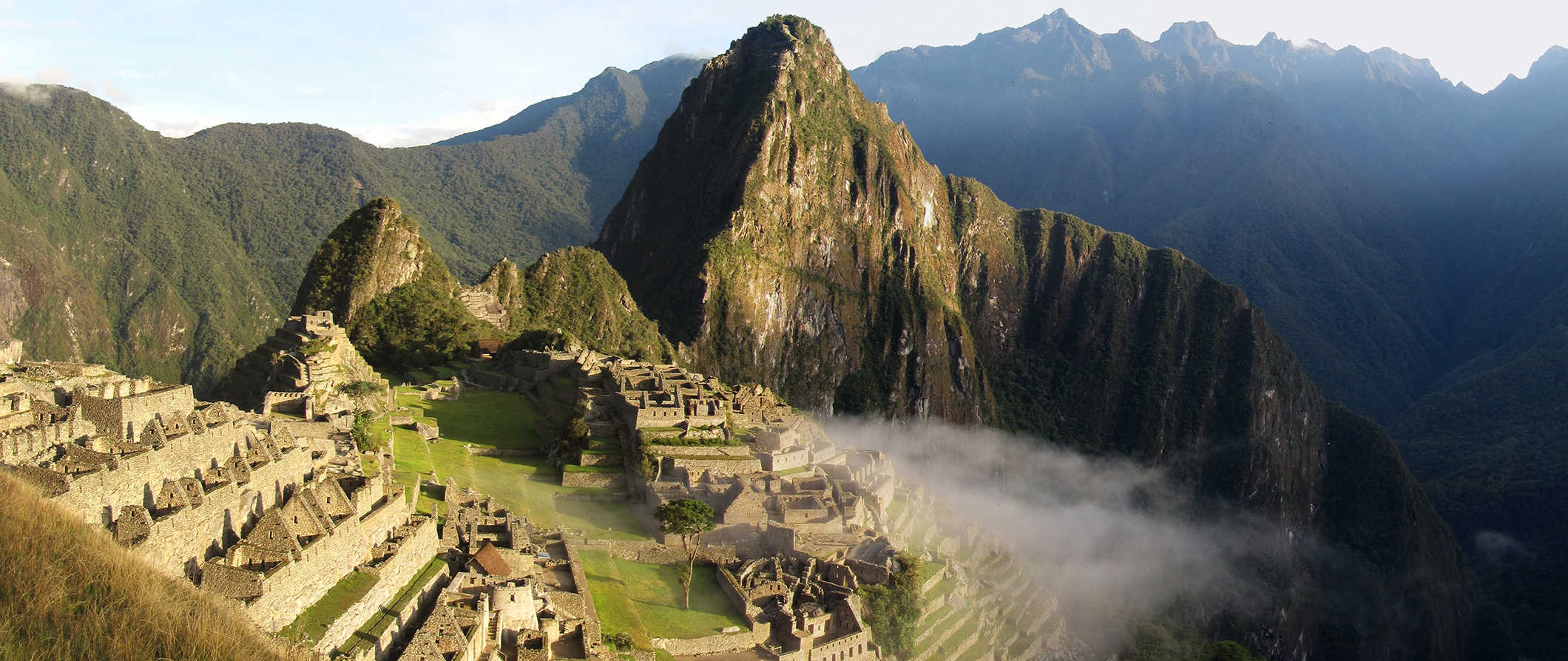
Travelers flock to Peru to hike the famous Inca Trail, explore the lush jungles, and devour their way through the incredible food scene of Lima.
But while the Inca Trail and Machu Picchu attract the majority of the attention (2,500 people visit Machu Picchu every day), there is much more to see and do in Peru if you’re willing to get out there and explore.
From the famous Lake Titicaca to the beaches in the north to the vibrant indigenous culture, Peru is bursting with things to see and do.
While many travelers just visit for a week to see the highlights, you can easily spend a month here (or more) and still not see everything.
Best of all, traveling around Peru is inexpensive. You don’t need a lot of money to visit here (even if you hike the Inca trail).
This guide to Peru can help you plan your trip, save money, and make the most out of your time in this beautiful destination!
Table of Contents
- Things to See and Do
- Typical Costs
- Suggested Budget
- Money-Saving Tips
- Where to Stay
- How to Get Around
- How to Stay Safe
- Best Places to Book Your Trip
- Related Blogs on Peru
Top 5 Things to See and Do in Peru
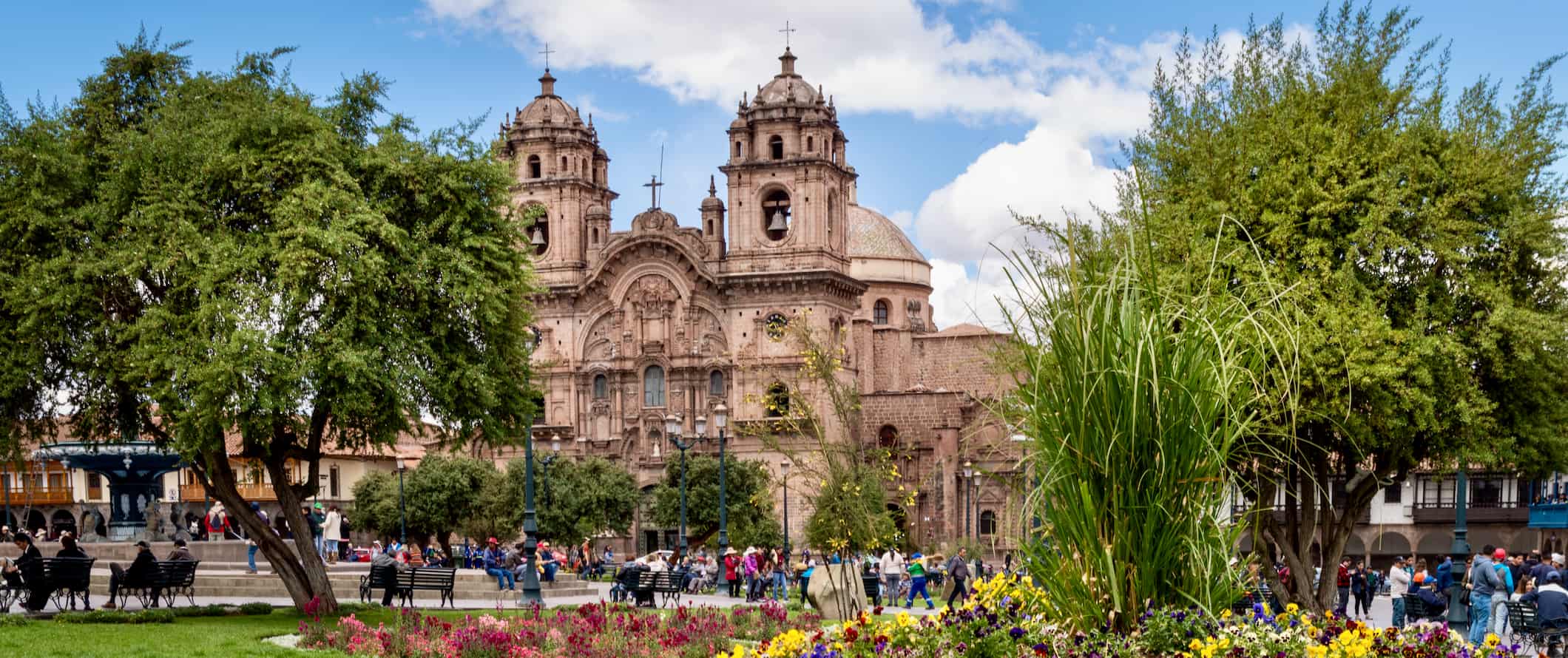
1. Explore Machu Picchu
This legendary “lost city of the Incas” is one of the most-visited tourist attractions in South America. Here you have the chance to wander around the old Inca city observing ancient aqueducts, granite and limestone temples, and other forms of Inca architecture that are all beautifully preserved. There are two ways to see Machu Picchu depending on the amount of adventure and exercise you want. There is a 4-day/3 night hike that takes you through 43 kilometers (26 miles) of steep, yet scenic uphill terrain along winding Andean mountain trails starting from Ollantaytambo. The Inca Trail gets you to the majestic Machu Picchu at dawn in time to see it before the clouds arrive mid-morning. The alternative is to wake up super early to get the train there and enter along with the tour groups competing for the beautiful morning sunset photos. (There are also longer 7-8 day hikes too if you want an even bigger challenge. Multi-day hikes start around 2,600 PEN. You can also just buy a day pass if you don’t want to hike.
2. Check out Lima
Lima is a chaotic and beautiful introduction to the country. Check out the trendy, vibrant Miraflores neighborhood that overlooks the Pacific and has plenty of restaurants and bars to try. Also, visit the Larco Museum to see its pre-Columbian artifacts, the Aliaga House for Peruvian art and artifacts, and Plaza Mayor for colonial beauty. Tour the city’s colorful markets for both food and shopping, wander around the world’s only Cat Park, or check out the Park of Love for good luck in love. At night, head to the artsy Barranco district for the nightlife and try a local drink with pisco, a local brandy. The city is a foodie hub too so don’t forget to try the ceviche!
3. Fly over the Nazca Lines
The Nazca Lines are a series of ancient geoglyphs that dominate the San José desert and Nazca Valley. There are over 10,000 lines and 300 different plant and animal figures that make up this UNESCO World Heritage Site. No one really knows how they got there (maybe aliens?) but the park itself is free to visit. If you want to splash out and get a better view, take a scenic helicopter or plane tour (they cost around 400 PEN).
4. Relax at Lake Titicaca
This stunning lake covers over 7,790 square kilometers (3,000 square miles) and sits at 3,810 meters (12,500 feet) above sea level, making it the world’s largest high-altitude lake. With deep blue water and spectacular sunsets across the lake lined with snowy mountains, this lake attracts people from all over the world to the nearby towns, which offer a mix of colonial architecture and bustling markets. There are three islands on the lake that are home to pre-Inca ruins: Isla del Sol, Taquile, and Amantani. Every year, the Peruvian side of Lake Titicaca at Puno celebrates the Fiesta de la Virgen de Candelaria in February. However, the best and driest time to visit is June, July, and August.
5. Hike the Colca Canyon
Other things to see and do in peru, 1. hike the inca trail.
Getting to Machu Picchu is best via the famed Inca Trail . This multi-day hike allows you to see the mountains, jungles, and follow the route the Incas used to take. It is a truly spectacular hike, but it is challenging and you may experience altitude sickness. There are two ways to do this hike: you can sign up to be part of an organized tour, or you can hire your own private guide. You cannot hike the trail independently. Tours start around 2,600 PEN for a 4-day, 3-night tour with a reliable, reputable company. The final leg of the hike can actually get a bit crowded, so if you can do a longer 7-day hike you’ll be able to beat the crowds and enjoy the incredible landscape before you arrive. The driest time is May-October but also unfortunately the most crowded. If you go from November-April, prepare for mud and perhaps rain but fewer crowds.
2. Visit the Islas Flotantes de los Uros
The Floating Islands of the Uros may sound like an Indiana Jones title, but it is actually the name of the group of man-made islands in Lake Titicaca. The islands are home to the indigenous Uros people who have built their own houses, islands, and boats from the tortora reeds which grow along the banks of the lake. This is an extremely touristy site and is a bit exploited as such, so it’s not for everyone. The boat tours start at 165 PEN.
3. Surf at Máncora Beach
Great fresh seafood, watersports, horseback riding, whale watching, fishing with locals, visiting the mangroves, and plenty of relaxation are the order of the day at this popular beach resort. Máncora is one of the finest beaches in South America and its year-round sunshine, two ocean currents, and beginner-friendly waves also make it Peru’s surfing Mecca. Accommodation prices can be expensive from December to March, so it’s best to book in advance. Whale watching costs 135 PEN, surfing classes start at 95 PEN, and SUP tours with sea turtles cost 175 PEN.
4. Step back through time at Batán Grande
Batán Grande, also known as the Sicán Archaeological Complex, is an archaeological site comprising 50 pyramids and tombs, which are thought to date to 750-1300 CE. Located near Chiclayo, this site was once the ancient Sicán capital and has yielded many impressive pre-Columbian artifacts. For example, a gold Tumi ceremonial knife weighing almost seven pounds was recovered from one of the royal tombs! Bring plenty of water, sunscreen, and snacks for the day.
5. Discover Cusco
This colonial city is a major tourist destination and sits on Inca-built stone foundations not far from Machu Picchu. The area is popular with trail walkers, history lovers, and party goers who come to enjoy the city’s nightlife and festivals. Cusco is the undisputed archaeological capital of the Americas and an essential part of your trip to Peru. The Cusco Tourist Ticket grants admission to most of the popular archaeological sites and attractions in the Cusco area (with some notable exceptions, including Machu Picchu). Note that transportation and guide services are separate. You can purchase either a 10-day pass that includes admission to over 16 sites (130 PEN) or one of several different “circuit” tickets that include admission to a smaller number of sites and are valid for one day only (70 PEN). Be sure to visit Coricancha (15 PEN) and Sacsayhuaman (included in the Cusco Tourist Ticket) during your visit. Right outside Cusco, take a day trip to the incredible Rainbow Mountains. For great food, head to Green Point. Plan to spend around 3-5 days in Cusco as there is plenty to see and it’s a good place to acclimate before doing any hiking as the city sits at 3,200 meters (10,500 feet) above sea level.
6. Get your Amazon fix in Iquitos
Accessible only by boat or plane, jungle-locked Iquitos is the largest city within the Peruvian rainforest. The city sits at the mouth of the Amazon and is the perfect destination for eco-tourism. The nearby Pacaya Samiria National Reserve is Peru’s largest reserve at two million hectares. It’s home to a huge range of nearly 1,000 birds, mammals, fish, reptiles, and more. A 3-day, 2-night tour through the reserve starts from around 1,400-1,500 PEN per person including food.
7. Sandboard in Huacachina
This little town is a desert oasis and a welcome relief after hiking through Machu Picchu. It’s very affordable and hostels here offer great deals for sandboarding and sand buggy tours around the nearby dunes. Two-hour tours cost about 100-125 PEN, which includes a sand buggy driver and sandboard rental. Most tours leave around 4pm so you can catch the sunset on the dunes. There is also a lagoon surrounded by palm trees in Huacachina, and you can rent a rowboat to paddle around it. A half-hour rental costs around 5 PEN per person. Huacachina is easily reached by bus from Lima, Cusco, Nazca, Arequipa, and Paracas.
8. See penguins in Paracas
Paracas is in the south of Peru and is sometimes called the “Poor Man’s Galapagos” for its impressive wildlife, consisting of over 400 different species. Thousands of birds, as well as large sea lion and penguin populations, call the area home. You can visit the Paracas National Reserve via an organized boat tour. Be sure to go early. A full-day tour of Paracas includes a boat trip to the Islas Ballestas and a bus trip around the national reserve in the afternoon. It costs about 150 PEN.
9. Walk through the White City
Arequipa is a beautiful city with a historical center that was constructed primarily from volcanic rock. Start getting to know the city by wandering around the Plaza de Armas and take in the city’s architecture over a glass of wine overlooking the main square with views of the stunning Basilica Catedral de Arequipa. Then, visit the gorgeous, vibrantly colorful Santa Catalina Monastery, see a frozen Inca mummy, and enjoy the local cuisine with favorites like shrimp soup or spicy stuffed peppers. It’s easy to see why Arequipa is undoubtedly one of the most beloved destinations in the country; everyone who visits here loves it.
10. Go to El Parque de la Reserva
This park in downtown Lima is home to the largest water fountain complex in the world, called El Circuito Mágico del Agua . There are 13 distinct fountains in total, including the Tunnel Fountain of Surprises, the Children’s Fountain, and the Fantasia Fountain, whose water jets are synchronized to music during the evening laser light shows. The park is open daily from 3pm-10pm, with beautiful, colorful light shows taking place at 6:50pm, 7:50pm, 8:30pm, and 9:30pm. The entrance fee is 4 PEN. The park also hosts a lot of events and is a popular place with dog owners too.
11. Visit Chachapoyas
This region in the Andean mountains was home to the Chachapoya civilization that lived there between 500-1432 (they were eventually conquered by the Aztecs). Today, you can visit Kuelap, the fortified city at known as “The Machu Picchu of the North.” The ruins are accessible via a guided tour, 4-hour hike, or cable car from the nearby town of Nuevo Tingo for 21 PEN roundtrip. Be sure to also visit Gocta, a beautiful waterfall that, at 770 meters (2,526 feet), is one of the tallest in the world. You can get there by taking a tour from Chachapoyas.
12. Tour Trujillo
Trujillo is the second-oldest Spanish city in Peru, located on the coast with eternal spring-like weather and widely considered the capital culture of Peru. While here, visit the archaeological site of Chan Chan, the world’s largest adobe city ever built and the largest pre-Columbian city. It was built by the Chimu, a civilization that inhabited the area until 1470 when they were defeated by the Incas. Admission is 11 PEN. Be sure to also visit Huanchaco, a small fishing town directly on the beach.
13. See Vinicunca, Rainbow Mountain
Chances are you’ve seen these colorful mountains on social media. Over the past few years, Rainbow Mountain has become a huge tourist attraction. Just keep in mind that the colors are not as vivid in real life and the place is super crowded (it’s a very popular site). Day trips and multi-day hikes are available from Cusco, usually starting around 110-135 PEN per person. There is also an “Alternative” Rainbow Mountain called Palcccoyo where you can enjoy an incredibly colorful scenic panoramic at 5,200 meters (17,060 feet). If you want to escape the hordes of people (though it’s also pretty busy these days).
14. Hike the Salkantay
If you want an alternative to the busy Inca Trail, try hiking the Salkantay. It sees a fraction of the tourists and is half the price of the Inca Trail — but just as stunning! There aren’t as many ruins, but there are epic mountain views and summits of up to 5,200 meters (17.060 feet)! Hikes can vary in length, but the 7-day hike offers the best views. You’ll need to be in decent shape though. 5-day hikes start around 1,700 PEN.
Peru Travel Costs
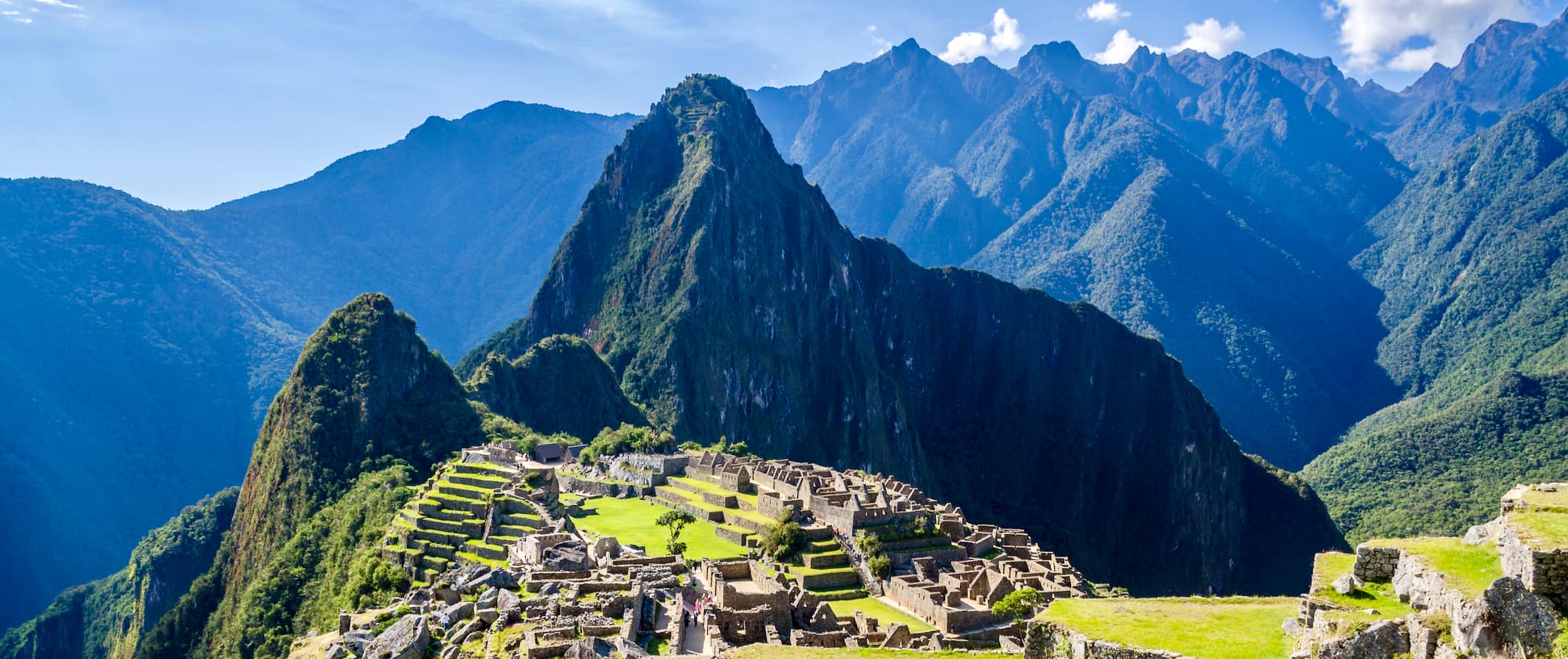
Accommodation – A bed in a 4-6-bed dorm costs 35-65 PEN while a bed in a dorm with 10 or more beds generally costs 32-38 PEN. A private room costs 115-170 PEN per night. Free Wi-Fi is standard and most hostels also have a kitchen or include free breakfast.
Budget hotel rooms with basic amenities like Wi-Fi, TV, and occasionally free breakfast cost around 85-105 PEN per night.
On Airbnb, which has limited availability in Peru, private rooms average around 100 PEN while entire homes start at 200 PEN per night. Book early though or prices will double.
For those traveling with a tent, wild camping is permitted as long as you’re not on somebody’s land.
Food – Cuisine in Peru varies from region to region, though you can expect to find staples like potatoes (most potatoes in the world originated here), quinoa, seafood, and indigenous animals like guinea pig and alpaca. Be sure to try ceviche, which is the national dish (it’s a seafood dish with fresh raw fish). Other popular dishes include stir-fried beef, roasted cuy (guinea pig), arroz con pato (rice with duck), and roasted chicken.
Overall, dining out in Peru is very inexpensive. Street food is incredibly cheap, costing 5-7 PEN for a meal from a parrilla (grill) set up on the side of the road. A plate of food at a casual takeaway restaurant serving Peruvian cuisine costs around 10 PEN.
A meal of traditional cuisine at a casual restaurant with table service costs around 15-25 PEN. If you want to splash out, a three-course meal at a mid-range restaurant costs 45 PEN.
Fast food (think McDonald’s) is 20 PEN for a combo meal. A large pizza is around 28-30 PEN.
Beer is around 8 PEN while a glass of wine or a latte is around 9 PEN. Bottled water is 2 PEN. A cocktail is 15-20 PEN and up, though many restaurants have extended happy hour specials (sometimes even all day).
If you plan on cooking, expect to pay 60-80 PEN per week for groceries such as pasta, rice, seasonal produce, and some meat. The best places to shop are the local markets, though Plaza Vea is the big grocery store chain with affordable prices as well. However, given how cheap food is here, it’s best to just eat out all the time. Buy snacks and fruit at the markets but eat out all other meals.
Backpacking Peru Suggested Budgets
On a backpacker’s budget of 135 PEN per day, you can stay in a hostel dorm, eat out for a few meals at cheap local street stalls and cook some meals, limit your drinking, take the bus to get around, and do mostly free or cheap activities like relaxing on the beach and going hiking.
On a mid-range budget of 400 PEN per day, you can afford a private Airbnb room, eat out for all your meals, drink more, take the occasional taxi to get around, and do more paid activities like going surfing or day-tripping to Machu Picchu.
On a “luxury” budget of 700 PEN or more per day, you can stay in a hotel, eat out anywhere you want, drink as much as you’d like, take some domestic flights, and do a longer multi-day trek to Machu Picchu. This is just the ground floor for luxury though. The sky is the limit!
You can use the chart below to get some idea of how much you need to budget daily, depending on your travel style. Keep in mind these are daily averages — some days you’ll spend more, some days you’ll spend less (you might spend less every day). We just want to give you a general idea of how to make your budget. Prices are in PEN.
Peru Travel Guide: Money-Saving Tips
Peru is generally pretty cheap, but it is easy to splash out here on food and tours. Here are a few hacks to cut down your costs in Peru:
- Stay at hospedajes – These are family-run hotels and are the cheapest accommodation you can find outside of hostel dorms. Try to stay in these as often as possible.
- Take public transportation – Embrace public transportation to get around — it’s super affordable so skip the taxis. You’ll save a fortune.
- Eat the meal of the day – These are set meals, often including multiple plates, that restaurants offer. Look around for set menu meals to eat out on the cheap.
- Travel off-season – For a low-cost trip, the best times to visit Peru are the fringe months of April and May or September and October. Prices are usually cheaper during these months.
- Take the colectivos – These are cheap buses that cost around 2-10 PEN for a ride. They are a bit confusing as they don’t necessarily have a schedule, but there is always a door person whom you can ask if the bus is going to your location. There are not always marked bus stops, so look for gathering crowds.
- Book tours last minute – If you are looking to do the Inca Trail and have a bit of extra time to wait for a deal, showing up in Cusco and booking a last-minute tour can save you lots of money. Booking months in advance means paying the premium price but if you can wait your patience may be rewarded. I wouldn’t recommend trying to get on last-minute if you have your heart set on doing it though since it might not work out.
- Go on a free walking tour – This is a great way to learn the history behind the places you are seeing and avoid missing any must-see stops. Free Walking Tour Peru has tours that can guide you around both Lima and Cusco. Just remember to tip your guide at the end!
- Bring a water bottle – The tap water here isn’t safe to drink so bring a reusable water bottle with a filter to save money and reduce your plastic use. LifeStraw is my go-to brand as their bottles have built-in filters to ensure your water is always clean and safe.
Where to Stay in Peru
Peru has a ton of hostels. Here are some of my favorite places to stay throughout the country:
- Pariwana Hostel (Lima)
- 1900 Backpackers Hostel (Lima)
- Loki Hostel (Cusco)
- Kokopelli (Cusco)
- Wild Rover Hostel (Cusco)
- Hospedaje Turistico Recoleta (Cusco)
- Arequipay Backpackers Downtown (Arequipa)
- Loki del Mar (Mancora)
- The Point Mancora Beach (Mancora)
How to Get Around Peru
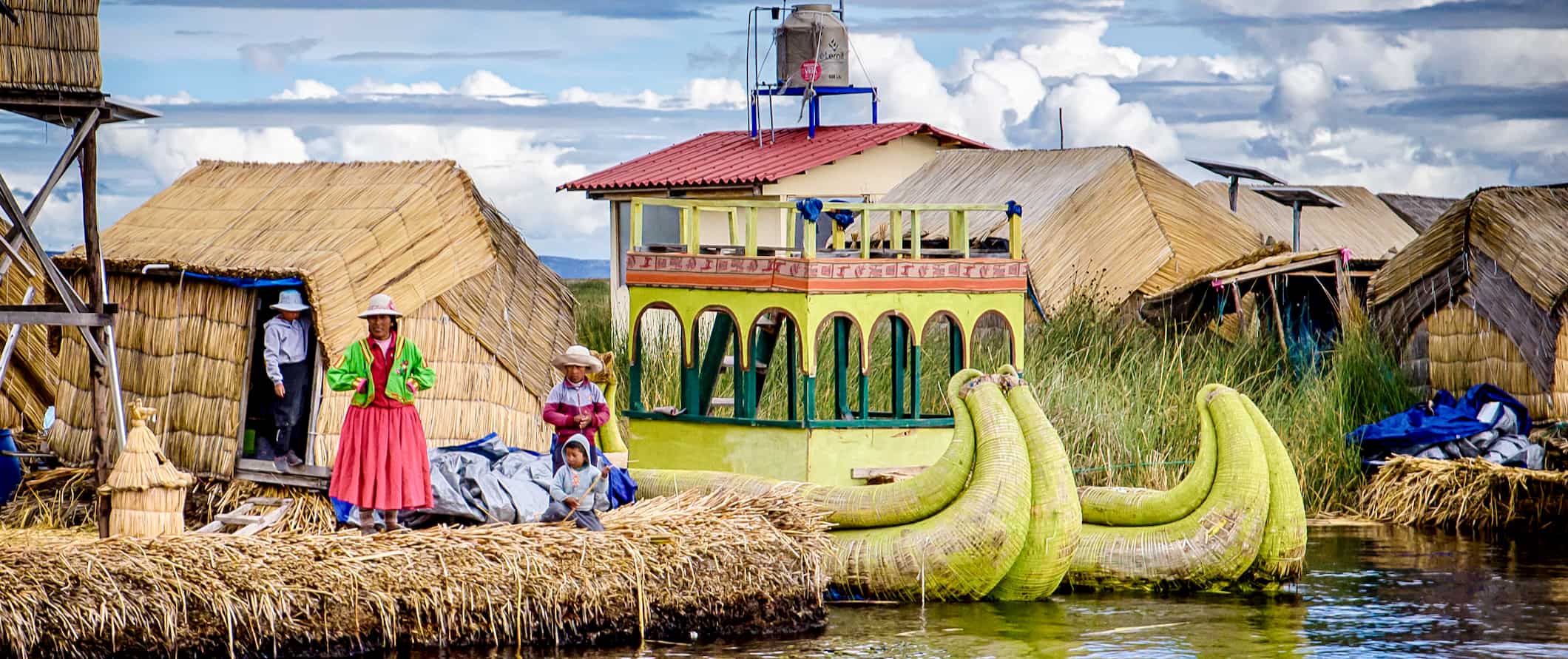
Public transportation – City buses cost around 1.50-3 PEN per trip. Microbuses ( colectivos ) are available and prices vary depending on the distance. Trips generally cost 2-10 PEN, though they are a bit hectic and take some getting used to.
Bus – Buses can take you all over Peru and are the most common way to get around for budget travelers. The usual price for a 10-hour bus journey is around 40 PEN depending on how nice the bus company is. You can use Cruz del Sur to look up bus schedules and prices. Keep in mind that any journey through the mountains will be a slow ride! Lima to Cusco takes over 21 hours and costs 185 PEN, though you can get a ticket for as low as 39 PEN if you book in advance.
Peru Hop is another reliable and comfortable bus company designed for backpackers. This bus is a hop-on/hop-off service you can take around the country. Three-day journeys from Lima to Cusco start from 683 PEN, while 7 days in Southern Peru costs 836 PEN.
Flying – Peru has five international airports (Lima, Arequipa, Cusco, Iquitos, and Piura), as well over a dozen airports with domestic service. LATAM, Avianca, and Star Peru are the main domestic airlines.
Flying between destinations isn’t always the cheapest option, but it’s a whole lot quicker. A flight from Lima to Cusco takes just over an hour (as opposed to the 21 hours by bus) and prices start around 250 PEN. Lima to Arequipa starts around 200 PEN.
Train – Like the rest of South America, the rail system in Peru is basically non-existent. There are nice tourist options though, like PeruRail and Inca Rail, which both run trains between Ollantaytambo and Machu Picchu Pueblo (the gateway to Machu Picchu). On PeruRail, tickets start from 179 PEN. Inca Rail also runs between Cusco and Machu Picchu Pueblo with tickets starting around 220 PEN.
From Lima, there’s just one train: the Ferrocarril Central Andino, the world’s highest passenger train, which travels across the Andes to Cerro de Pasco and Huancayo. One-way fare starts from 230 PEN. However, service is limited — sometimes the train only runs once a month. Journeys are currently suspended due to Covid so be sure to check their website for updates.
Car rental – I don’t suggest renting a car here as the drivers are aggressive, the roads are poorly maintained, and accidents are common. If you do decide to rent a car, use Discover Cars to find the best prices.
When to Go to Peru
Peru has just two seasons: wet and dry. May through October is the dry season, while November through April is the rainy season. The wettest months are from January to the end of April. This isn’t a great time to visit Peru — at least not in the mountain areas, where roads and hiking trails may become blocked or closed.
Most people come to Peru from the beginning of May to the end of November, with July and August being the busiest months. May and September are great months to visit, as tourism slows down slightly but temperatures are still pleasant.
If you want to spend more time in the mountains, June to September has clear, sunny days (but chilly nights). This is a good time to trek the Inca Trail. It’s also the best time to visit the Amazon Basin, when mosquitos are fewer.
Temperatures on the desert coast can get as high as 25-35°C (77-95°F) from December to April, while temperatures cool off from May-October. In the highlands from May-October, you can expect temperatures to reach 20-25°C (68-77°F).
How to Stay Safe in Peru
Peru is a pretty safe place to backpack and travel around, even for solo travelers, and even for solo female travelers. Your biggest worry is petty theft, which is rampant in the bigger cities and on overnight buses. Don’t flaunt expensive jewelry or belongings. Avoid taking your phone out in public if you can. Lock your bags on overnight buses and keep your valuables secure and out of sight. It’s easy to get robbed if you aren’t careful here (especially at night).
If you’re in Lima, don’t walk around alone at night, unless you’re in the safer neighborhoods (Miraflores and Barranco). Smaller cities and towns are perfectly safe to walk around alone day and night.
Solo female travelers should generally feel safe here, however, the standard precautions apply (never leave your drink unattended at the bar, never walk home alone intoxicated, etc.).
Scams aren’t super common but if you’re worried about getting ripped off, here’s a list of common travel scams to avoid .
If you’re doing any hiking, check the weather in advance and bring plenty of water. If you’re hiking to Machu Picchu, arrive early to adjust to the altitude. 3-5 days early can make all the difference!
If you experience an emergency, dial 011 for assistance. If you’re in one of the bigger cities, you can also seek out the tourism police.
For more in-depth coverage of how to stay safe in Peru, check out this post that answers some frequently asked questions and concerns.
The most important piece of advice I can offer is to purchase good travel insurance. Travel insurance will protect you against illness, injury, theft, and cancellations. It’s comprehensive protection in case anything goes wrong. I never go on a trip without it as I’ve had to use it many times in the past. You can use the widget below to find the policy right for you:
Peru Travel Guide: The Best Booking Resources
These are my favorite companies to use when I travel. They consistently have the best deals, offer world-class customer service and great value, and overall, are better than their competitors. They are the companies I use the most and are always the starting point in my search for travel deals.
- Skyscanner – Skyscanner is my favorite flight search engine. They search small websites and budget airlines that larger search sites tend to miss. They are hands down the number one place to start.
- Hostelworld – This is the best hostel accommodation site out there with the largest inventory, best search interface, and widest availability.
- Booking.com – The best all around booking site that constantly provides the cheapest and lowest rates. They have the widest selection of budget accommodation. In all my tests, they’ve always had the cheapest rates out of all the booking websites.
- Get Your Guide – Get Your Guide is a huge online marketplace for tours and excursions. They have tons of tour options available in cities all around the world, including everything from cooking classes, walking tours, street art lessons, and more!
- SafetyWing – Safety Wing offers convenient and affordable plans tailored to digital nomads and long-term travelers. They have cheap monthly plans, great customer service, and an easy-to-use claims process that makes it perfect for those on the road.
- LifeStraw – My go-to company for reusable water bottles with built-in filters so you can ensure your drinking water is always clean and safe.
- Unbound Merino – They make lightweight, durable, easy-to-clean travel clothing.
- Top Travel Credit Cards – Points are the best way to cut down travel expenses. Here’s my favorite point earning credit cards so you can get free travel!
Peru Travel Guide: Related Articles
Want more info? Check out all the articles I’ve written on Peru travel and continue planning your trip:
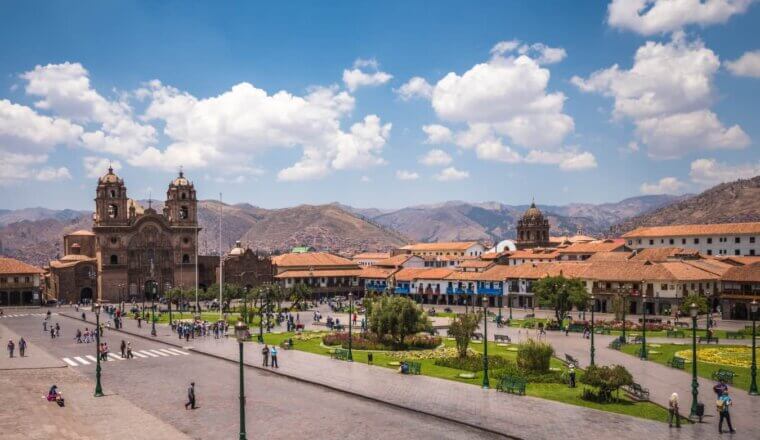
The 6 Best Hostels in Cusco
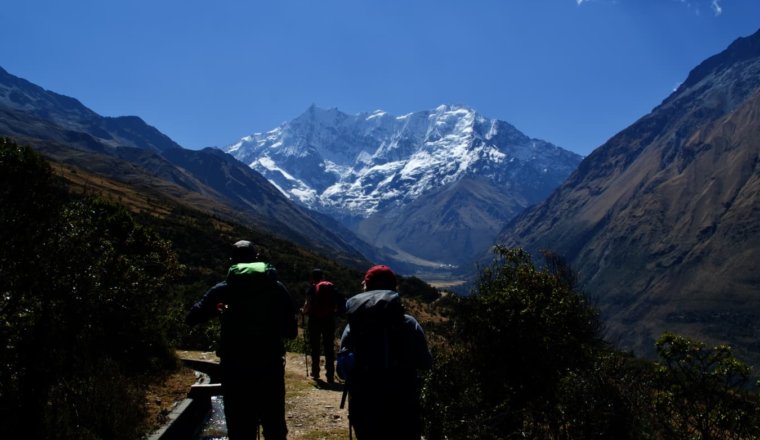
The 4 Best Tour Companies in Peru
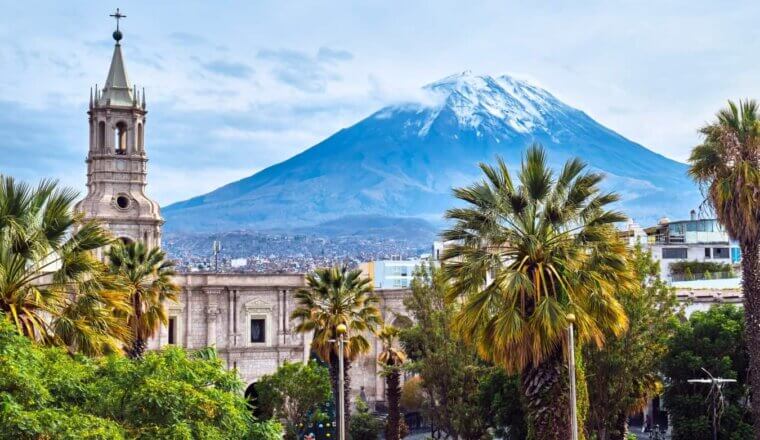
Is Peru Safe to Visit?
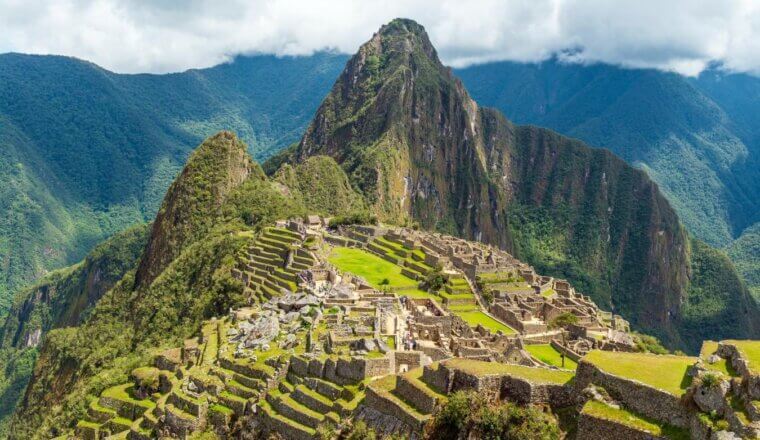
How to Hike the Inca Trail
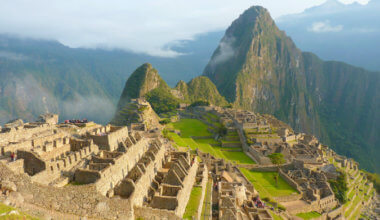
How to Turn Right at Machu Picchu and Find Atlantis
Get your free travel starter kit.
Enter your email and get planning cheatsheets including a step by step checklist, packing list, tips cheat sheet, and more so you can plan like a pro!

- Where To Stay
- Transportation
- Booking Resources
- Related Blogs
- Travel Planning Guide
How much does a trip to Peru Cost?

How much money should you budget for your trip to Peru?
- How much does a one-week trip to Peru cost?
- How much does a two-week trip to Peru cost?
- How much does a one-month trip to Peru cost?
- Hostel Prices
- Hotel Prices
The Cost of a Trip to Peru
A trip to Peru for one person usually costs between $22 and $182 per day and $43 to $364 for two people. This is a wide range of costs, and the daily average per person from our data is $60 (S/.224) per person. This average includes food, accommodation, sightseeing, and local transportation expenses contributed from other travelers. Prices can vary based on travel style and activities. While the overall price for a trip to Peru is dependent on your personal travel style and the specific places you visit, if you book standard accommodation and travel with an average level of convenience, then your budget should be somewhere within this range. Also, the prices for individual destinations such as Lima, Arequipa, and Machu Picchu may vary, but generally fall somewhat close to this range. Below you can find a breakdown of travel expenses by category, plus a comparison of guided tour costs versus traveling independently.
If you're traveling independently in Peru, budget travelers should plan to spend around $22 (S/.81) a day for their trip. This includes stays at budget hotels or hostels, affordable food options, local transportation, and low-cost activities. For those on a mid-range budget, plan for around $60 (S/.224) a day which would cover the cost of a typical hotel, normal restaurants, and a variety of major attractions. Higher-end luxury travelers should allow for $182 (S/.680) per day, which allows for luxury hotel stays, nice restaurants, and private tour options. These price ranges are based on our extensive travel cost data for Peru from other travelers along with hotel and tour data from travel companies.
How much does a one week trip to Peru cost?
When planning a one-week trip to Peru, most visitors to Peru spend between $152 and $1,275 for their trip, with the average cost falling around $421. This estimate includes essential aspects such as sightseeing, local transportation, food, and accommodations. With a full week, you'll have sufficient time to explore one, two, or possibly three locations within Peru, depending on the amount of time you want to spend in each place. The most popular places worth considering are Lima , Arequipa , and Machu Picchu . Keep in mind that these numbers are based on overall averages and may vary depending on your individual preferences.
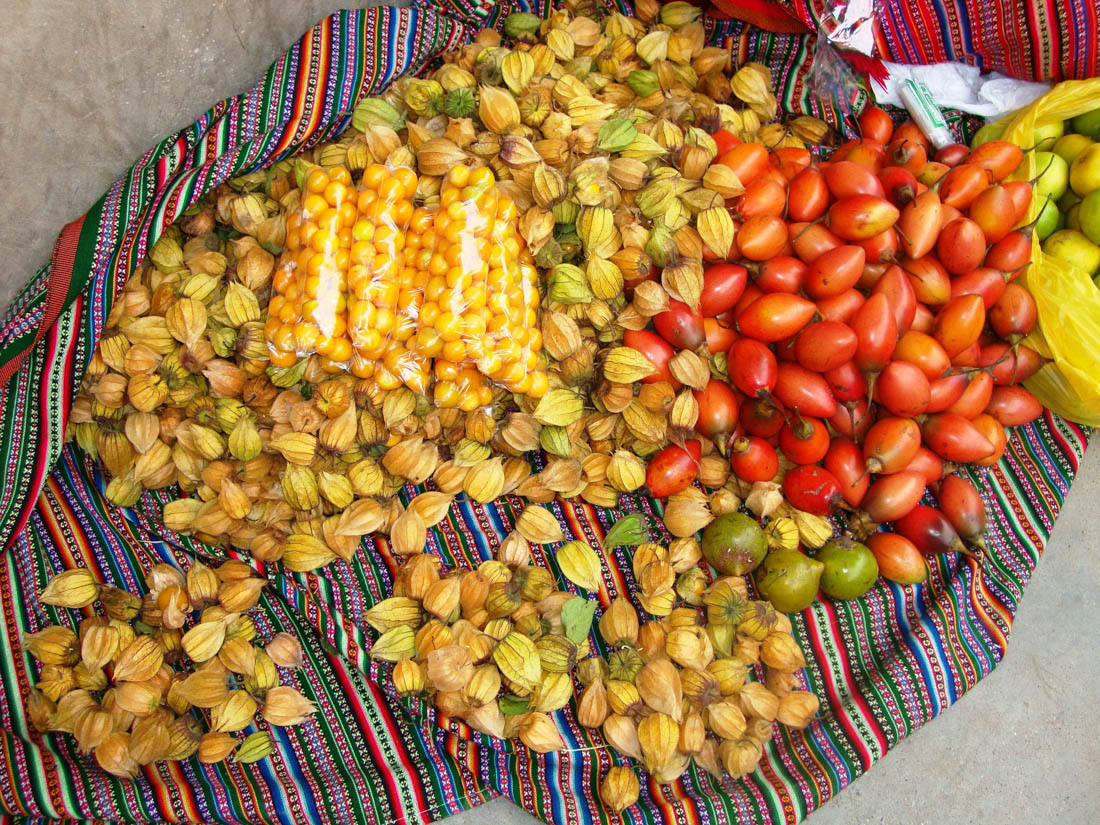
How much does a two week trip to Peru cost?
With two weeks, you should budget between $303 and $2,550 for your trip to Peru. The average price for a two week trip is $841. Two weeks will allow you enough time to visit between three and five places. If you're on a budget, you might want to consider some of the more affordable places such as Arequipa and Huaraz.
How much does a one month trip to Peru cost?
With a month-long trip to Peru, expenses can be anywhere from $650 to $5,464 with the average being $1,802. The cost of travel is dependent on your overall style of travel. If you have a full month, you'll likely want to stay at a vacation rental with a kitchen during at least part of your trip so that you can prepare your own meals. Backpackers often prefer hostels for the same reason. Hostels also offer a more social atmosphere at a very affordable price range.
Hostel Prices in Peru
With more than 240 hostels in Peru, the average price is $11 per night for a dorm bed. Hostels are a terrific option for younger independent travelers looking to save money while staying social during their trip. With many types of hostels, it can be overwhelming to sort out the best places, though. Our analysis of the hostels in Peru not only found the average price, but also uncovered some surprises about the overall quality, amenities, and atmosphere of hostels in the region. You can see more details from our analysis about typical hostel prices in Peru here .
Here are a few sample prices from popular hostels in Peru.
- $17 for a dorm bed at Pariwana Hostel Cusco in Cusco more details
- $10 for a dorm bed at Pariwana Hostel Lima in Lima more details
- $9 for a dorm bed at Alpes Huaraz in Huaraz more details
Hotel Prices in Peru
You'll find a wide range of hotel options across Peru. Below are prices for some of the destinations, and for more details see our analysis of hotel costs in Peru .
Antigua Casona San Blas
Manto hotel lima - mgallery.
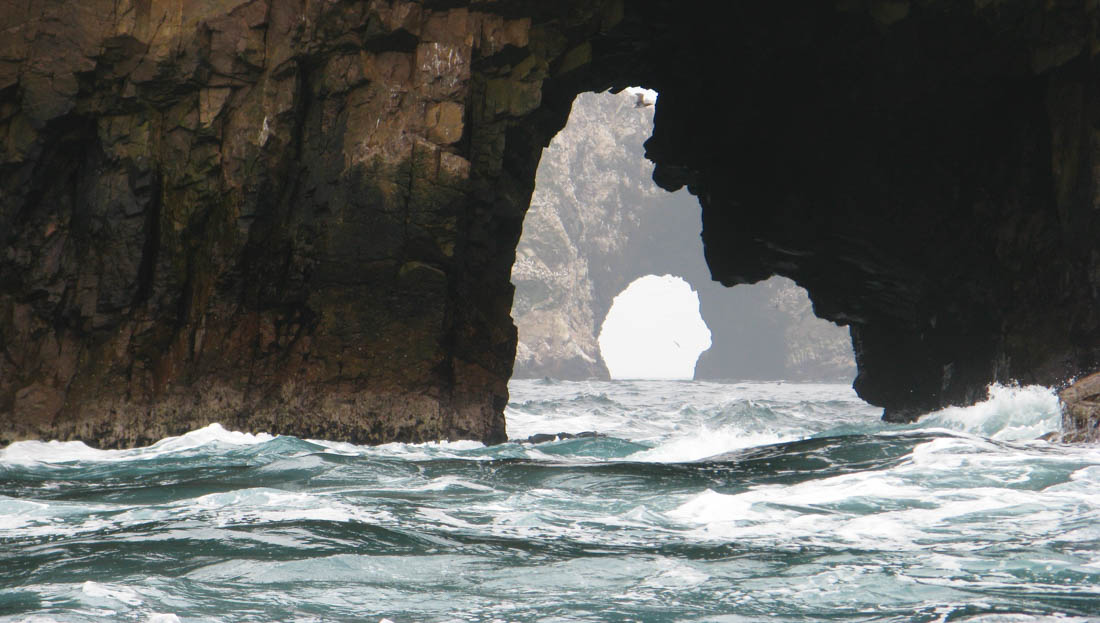
Should you do an organized tour or travel independently in Peru?
When planning a trip to Peru, there are two primary options to choose from: organized tours and independent travel. Organized tours offer a convenient and hassle-free experience, as all the details of your trip are handled by travel experts. Additionally, you'll have the benefit of an expert guide who can provide valuable insights and knowledge during your journey. This option is often favored by travelers who appreciate the convenience and ease it offers, with many tours providing transportation and expert guides to enhance the overall experience.
On the other hand, independent travel provides a different set of advantages. It offers a higher level of freedom and flexibility, allowing you to customize your itinerary and explore at your own pace. This option appeals to travelers who value the ability to make spontaneous decisions and have more control over their travel plans. The independence of traveling on your own can provide a sense of adventure and the opportunity to immerse yourself in the local culture on a deeper level.
Ultimately, the choice between organized tours and independent travel depends on your personal preferences and travel style. Consider your desired level of convenience, the amount of guidance you prefer, and the level of flexibility you seek when making your decision. Both options have their own merits, and the decision should be based on what aligns best with your travel goals and preferences.
Comparing Trip Costs in Peru
When we compare the prices of organized tours to the average costs of independent travelers, we can see that sometimes the prices are fairly even.
Tours vs. independent Travel: Pros & Cons
Organized tours.
- An expert guide familiar with the culture
- Convenient transportation
- Fellow travelers to socialize with
- Well researched activities
- Efficient and thought out itinerary
- The security of have a trip leader if something goes wrong
- Limited options
- Usually not customizable
- The fast pace often means you can’t visit one place in depth
- Usually more expensive than independent travel
- There may be limited time to interact with the local culture and community
Independent Travel
- Completely customizable
- Opportunity to visit off-the-beaten-path destinations
- Can fully immerse yourself in the local culture
- Freedom to move at your own pace
- Flexibility to change your itinerary at any time
- More affordable
- Challenging to plan an efficient itinerary
- Transportation may be challenging or inefficient
- Booking and trip planning can be a hassle
- Popular sights may sell out well in advance
- If something goes wrong, you're on your own
Are organized tours more expensive than independent travel in Peru?
Organized tours average $235 per day in Peru, and are generally all-inclusive with one large payment. Independent trips usually average $60 (S/.224) per day, and include individual payments to hotels, local transportation, food, and sightseeing. When compared, organized tours and independent trips each come with their own set of challenges and benefits. It's important to understand all aspects of both types of trips to make a fair comparison. You can see our thorough analysis of tour prices in Peru here .
Here are a few sample tours in Peru:
- The Richness of Southern Peru ($1,980) 13 days, 14 destinations more details
- Journeys: Iconic Peru National Geographic Journeys ($4,199) 14 days, 14 destinations more details
- Extended Sacred Valley + Classic Inca Trail to Machu Picchu 5 Days and 4 Nights ($1,100) 5 days, 13 destinations more details
- Peru Tailored (Nazca Lines, Inca Trail, Machu Picchu and Tambopata) - 12D-11N ($5,080) 12 days, 18 destinations more details
- PERU HIGHLIGHTS - 8 DAYS WITH LOCAL FLIGHTS (LIMA TO CUSCO AND CUSCO TO LIMA) ($4,706) 8 days, 13 destinations more details
More for Peru
If you're planning a trip to Peru, check out these other informative travel guides.
We've been gathering travel costs from tens of thousands of actual travelers since 2010, and we use the data to calculate average daily travel costs for destinations around the world. We also systematically analyze the prices of hotels, hostels, and tours from travel providers such as Kayak, HostelWorld, TourRadar, Viator, and others. This combination of expenses from actual travelers, combined with pricing data from major travel companies, gives us a uniqe insight into the overall cost of travel for thousands of cities in countries around the world. You can see more here: How it Works .
Subscribe to our Newsletter
Coupons and discounts! Travel tips!
1 Categories averaged on a per-item basis. 2 Categories averaged on a per-day basis. For example, the Food 2 daily average is for all meals for an entire day, while Entertainment 1 is for each individual purchase. Thus, the overall daily average cost is not a summation of the individual categories.
- You are welcome to reference or display our travel costs on your website as long as you provide a link back to this page .
- For a basic link, you can copy and paste the HTML link code, or this page's address. Address Link HTML Peru Travel Costs " disabled />

Some of the links on this website are sponsored or affiliate links which help to financially support this site. By clicking the link and making a purchase, we may receive a small commission, but this does not affect the price of your purchase.
- Privacy / Terms of Use
- Activities, Day Trips, Things To Do, and Excursions

- Peru Tour Packages
- Customized Tours
- Destinations
- EN EN ES DE
- +51932671370
- Machu Picchu Tours
- Inca Trail Tours
- Salkantay Trek
- Amazon Jungle Tours
- Machu Picchu
- Sacred Valley
- Rainbow Mountain
- Humantay Lake
- Huacachina Oasis
- Huacachina & Paracas
- Lake Titicaca
- Amazon Jungle
- Machu Picchu Guide
- Peru Travel Tips
- Things to do in Cusco
- Things to do in Lima
- Peru Amazon Guide
Home » The Cost of Travel in Peru in 2024
The Cost of Travel in Peru in 2024
- 17 September, 2022
- by Oliver Eberlein
- Reading time: 10 minutes

Home to some of South America’s most incredible viewpoints, deep jungle wilderness, cuisine, and Inca sites, Peru might just be the perfect destination for your next adventure.
With no end to exciting places to visit, Peru is a vibrant country that can be seen on almost any budget.
Whether you’re watching your money or looking to splash out, let’s walk through the costs of traveling in Peru and explore valuable tips on transportation, activities, accommodation, and money exchange.
Overview of Travel Costs for Peru

alexanderfrederiks
Peru tours.
Sarah Anderson 28 May, 2023 at 3:26 pm
Great read, thanks for putting together this information. My friend and I were planning to visit this July. Is it safe to travel to Peru now?
Oliver from Exploor 29 May, 2023 at 10:35 am
Hey Sarah! Absolutely, it is very safe to travel to Peru now. All the sites are open and we have daily departures for all our tours. For more info feel free to review our article about the current situation in Peru.
Cheers, Oliver
Leave a comment
Related posts, plan your perfect peru tour in 5 minutes.
- 14 March, 2022
- by Oliver Eberlein
The Best Time to Visit Peru
- 20 March, 2022
- by Konsti Sobon
The 18 Top Things To Do in Peru
- 8 May, 2022

Let’s plan your dream trip to Peru
All of our tour itineraries are 100% customizable . Just let us know your preferences below and we’ll get back to you within 24-48 hours.
- First name* Last name*
- Starting Date* Number of travelers* 1 2 3 4 5 6 7 8 9 10
- Hotels (Optional, multiple choices possible) Luxury Superior Best Value
- Trip Length 3-5 Days 6-8 Days 9-11 Days 12-15 Days 16+ Days Not sure yet
- Comments* 2500 characters remaining
Lists by Lukiih 🍀
Practical travel guides with less fluff
- 💰 My 2024 Peru Trip Cost: A Budget Breakdown
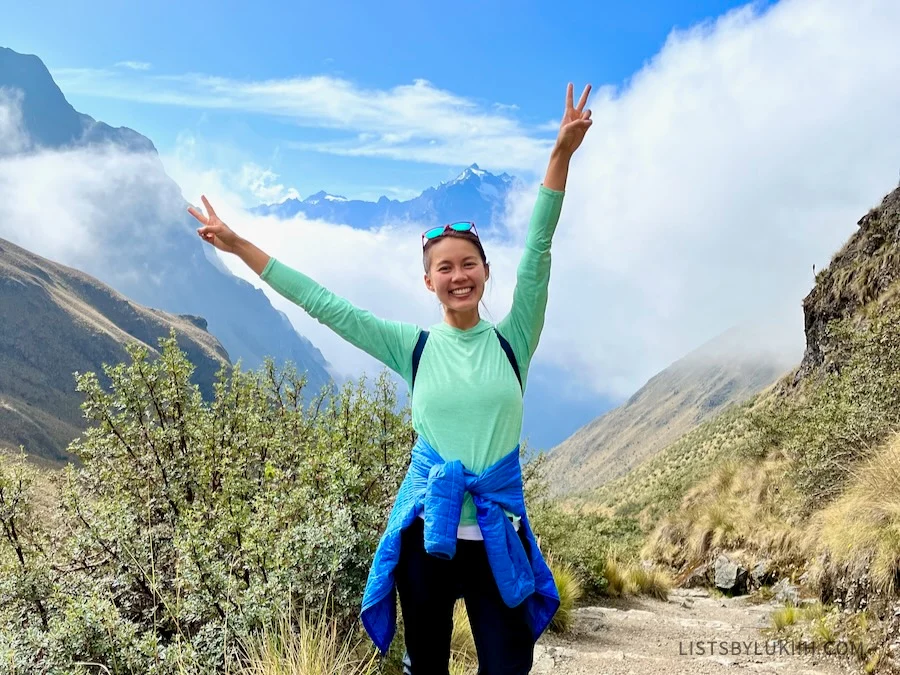
Peru, a country famous for breathtaking natural wonders and archaeological sites, can be visited with a budget of $40 to $130 a day.
My 10-day trip to Peru cost a total of $2,098 . In this post, I share:
- 💰 Expected travel costs
- 💡 Budgeting tips
- 💵 How much cash to bring
- ✈️ My trip’s costs by category
Planning a trip? Here’s what to know about Peru .
- Is Peru Affordable?
- How Much Is a Trip?
- About My Trip
- Cost Breakdown
- Daily Budget: $149
- Flight: $613
- Accommodation: $149
- Transportation: $115
- Entertainment: $1,053
- Withdrawing Cash
- How Much Cash to Bring
- Tipping Etiquette
Lists By Lukiih is readers-supported. When you buy with my affiliate link, I may earn a small commission. Thanks!
Is Peru Affordable To Travel To?
Peru ranks as one of the most affordable destinations in South America. It has a relatively low cost of living, many local markets and street food where you can eat cheaply, and an extremely competitive tourism market that drives costs down.
Along with Ecuador, Colombia, and Bolivia, Peru is among the region’s cheapest countries to travel.
💰 Trip Daily Budget for Latin American Countries
For comparison, I visited these countries in Latin America within a year of visiting Peru, and here’s how much I spent per day at each one:
See all my daily budget for each destination I’ve visited .
How Much Is a Trip to Peru?
This section covers estimated trip costs depending on your travel style. I share my actual travel expenses further below.
🎒 Budget Traveler – Peru Trip Cost
A budget traveler in Peru can expect to spend approximately $40 per day or $650 for two weeks of travel in Peru, excluding flights.
Here’s what a budget traveler’s cost breakdown can look like:
Traveling Peru on a Budget
To travel to Peru on a budget, here are some things you’ll need to do:
- 🏠 Accommodation – For the cheapest options, stay at a dorm-style hostel for as little as $8 a night in major cities like Lima and $6 in places like Cusco . Private rooms at hostels will increase the cost to about $15 a night.
- 🚙 Transportation – Take Peru’s buses, the most common form of public transport for short and long distances. Bus tickets that travel between locations about four hours apart (e.g., Lima to Paracas) can be as low as $12 per ride.
Keep in mind that while local buses are the cheapest way to travel , they can also be difficult for tourists to navigate.
- 🐟 Food – Eat at local restaurants for less than $12 a day, which can save you more than $10 per meal compared to eating at a more touristy restaurant.
- 🦙 Entertainment – One of the best ways to keep costs low is to avoid doing popular Peru tours like Machu Picchu, Sacred Valley, and Colca Canyon. This will save you a few hundred dollars. Try to visit these places on your own if it’s feasible (not all of them are).
Some attractions have relatively expensive entrance fees. Machu Picchu’s admission fee is roughly $45 , but a guided tour of it costs more than $100.
- ☀️ Travel Season – The best time to travel to Peru to save money is during its low season, which runs from January to April. This coincides with the rainy season, but you’ll also experience fewer crowds and some of the best deals on accommodations.
If you plan to do popular tours in Peru (e.g., the four-day Inca Trail hike to Machu Picchu ), your total cost will likely be closer to a mid-range traveler’s budget. This is true even if you travel on a budget in the other categories.
💰 Mid-Range Budget Traveler – Peru Trip Cost
A mid-range budget traveler like myself can expect to spend approximately $130 per day or $1,820 for two weeks of travel in Peru, excluding flights. I break down my trip expenses by travel category below.
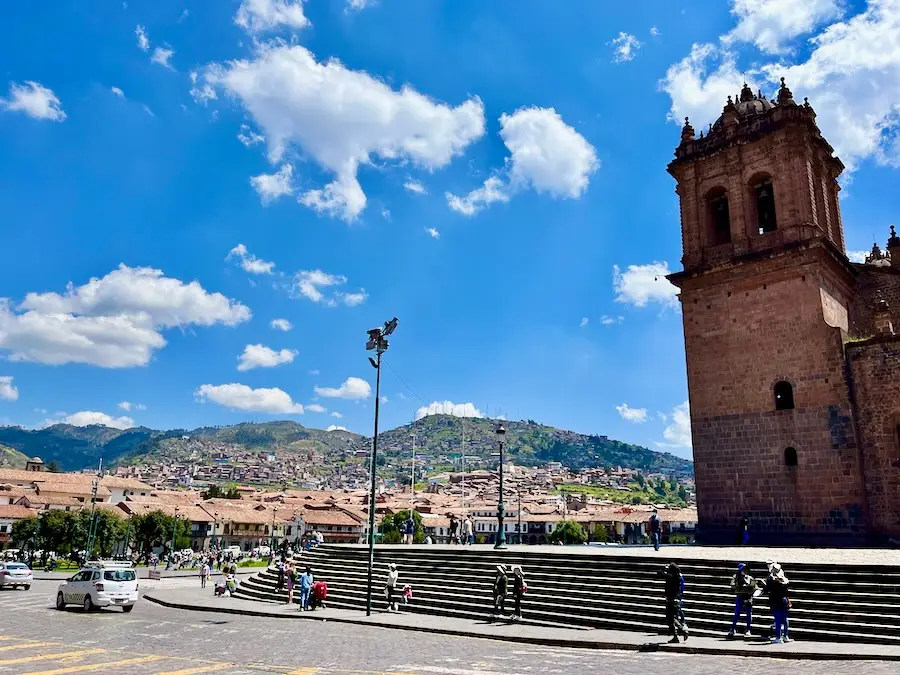
About My Peru Trip
To give context to the expenses below, here’s what you need to know about my trip:
- Lima : 2 days
- Machu Picchu : 4 days
- Huacachina : 1 day
- Cusco : 1 day
- ☀️ Low season . I went to Peru in April, which is part of the low season, coinciding with the wet season.
Peru’s high season is during the dry season from May to October .
- ✌️ Group travel – I traveled with one to three other friends in Peru, so I was able to split costs, such as housing.
- 💰 Mid-range budget – I consider myself a mid-range budget traveler, and these expenses reflect that. I don’t aim to travel on a budget, but I’m thoughtful about how and where I spend.
- 🍀 Self-funded – My trips are self-funded, so I paid for everything listed below. None of my excursions or experiences are sponsored.
- 💵 US dollars – All costs listed in this post are per person and in US dollars, converted from Peru’s local currency, the Peruvian Sol (PEN).
The exchange rate was $1 USD = S/ 3.70 at the time of writing.
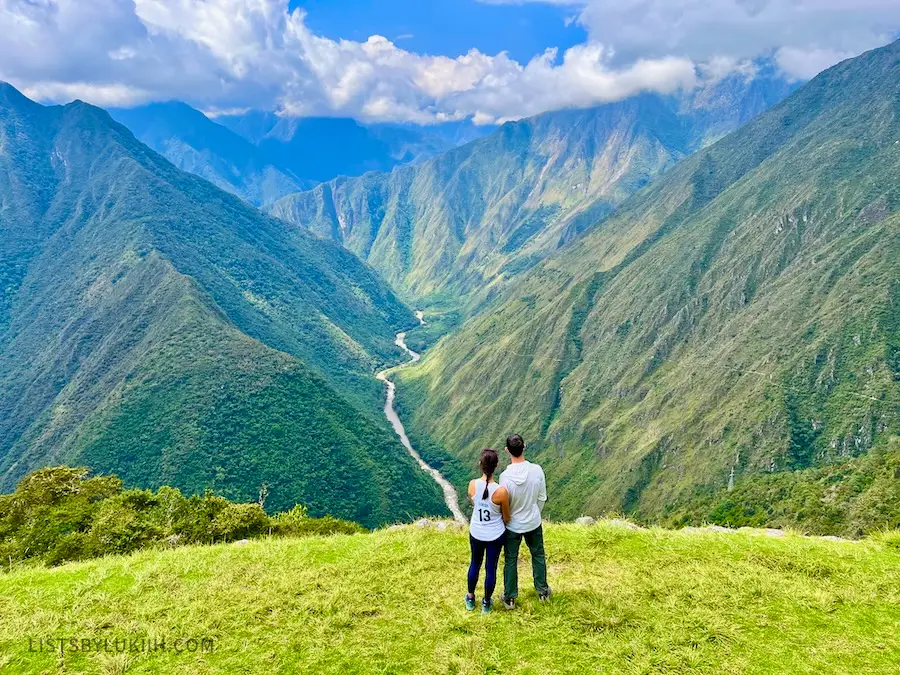
Total Cost for a Peru Trip: $2,098
My 10-day trip to Peru cost a total of $2,098 , including flights.
See the highlights of my trip in this Peru itinerary .
💰 Cost Breakdown for Peru
Here’s a quick overview of my expenses by travel category:
🗓️ Daily Budget in Peru: $149
My Peru trip cost $149 per day , excluding my round-trip flights from and to the United States.
A mid-range budget traveler can expect to spend approximately $130 per day in Peru. This is someone who generally stays at mid-range hotels that cost about $50 per night, eats at a mix of $ local and $$ high-end restaurants, and pays for experiences even if they’re pricey.
✈️ Flight Cost to Peru: $613
My round-trip flight from the East Coast of the United States to Jorge Chavez International Airport in Lima was $613 .
A round-trip flight between the US and Peru that costs under $350 is considered cheap; international flights typically cost over $500.
🏠 Accommodation Cost in Peru: $149
My average cost of accommodation in Peru was $15 per night . I was able to split all my accommodation costs with one other person at all times.
(This total doesn’t include overnight stays on the four-day Inca Trail to Machu Picchu; those are included in the tour price under entertainment .)
Here are the accommodations I stayed at and how much I paid for each:
A private room at mid-range accommodation in touristy cities like Cusco, Lima, and Aguas Calientes will cost approximately $55 a night . Mid-range accommodation in quieter cities that tourists still visit, like Arequipa, Trujillo, and Pisac, will be roughly $25 a night.
🥘 Food Cost in Peru : $170
My average cost of food in Peru was $17 per day.
(This total doesn’t include meals provided by the four-day Inca Trail tour; those are included in the tour price under entertainment . )
A mid-range budget traveler can expect to spend $25 per day on food in Peru.
Cheapest Meals in Peru
Here are the most affordable meals I ate during my trip:
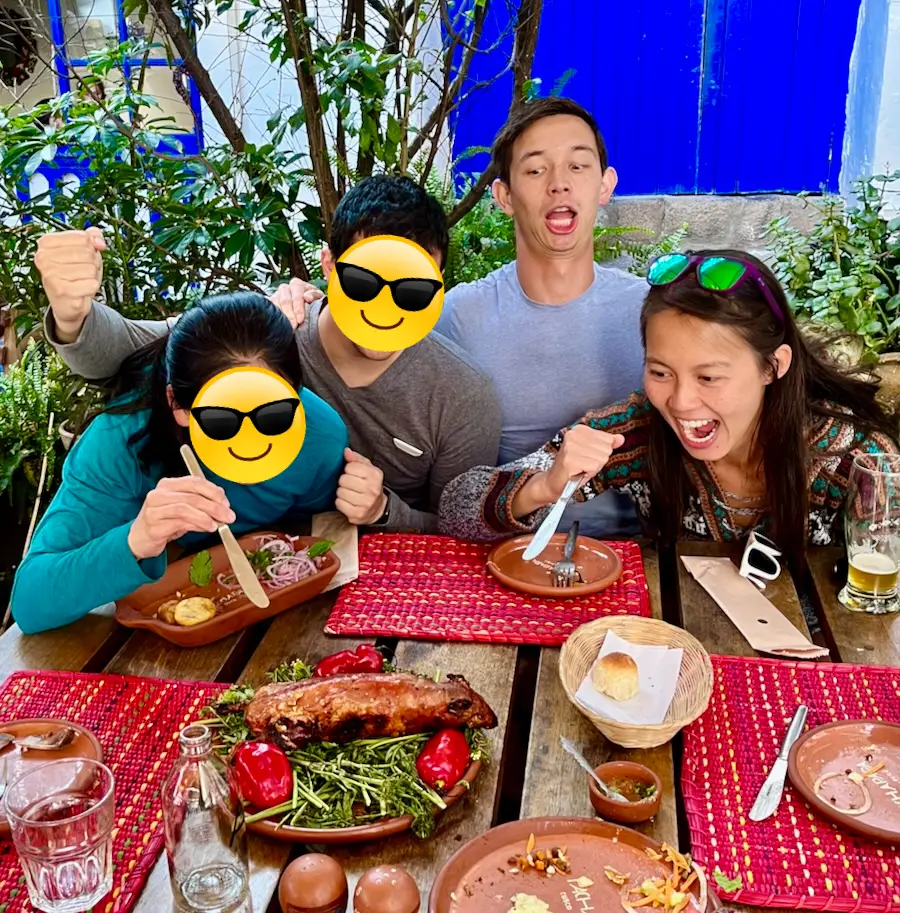
You can eat street food at local markets to save on food. However, it’s not uncommon for tourists to get stomach issues in Peru, so consider taking a street food tour if you have a sensitive stomach.
Most Expensive Meals in Peru
Here are the most expensive meals I ate during my trip:
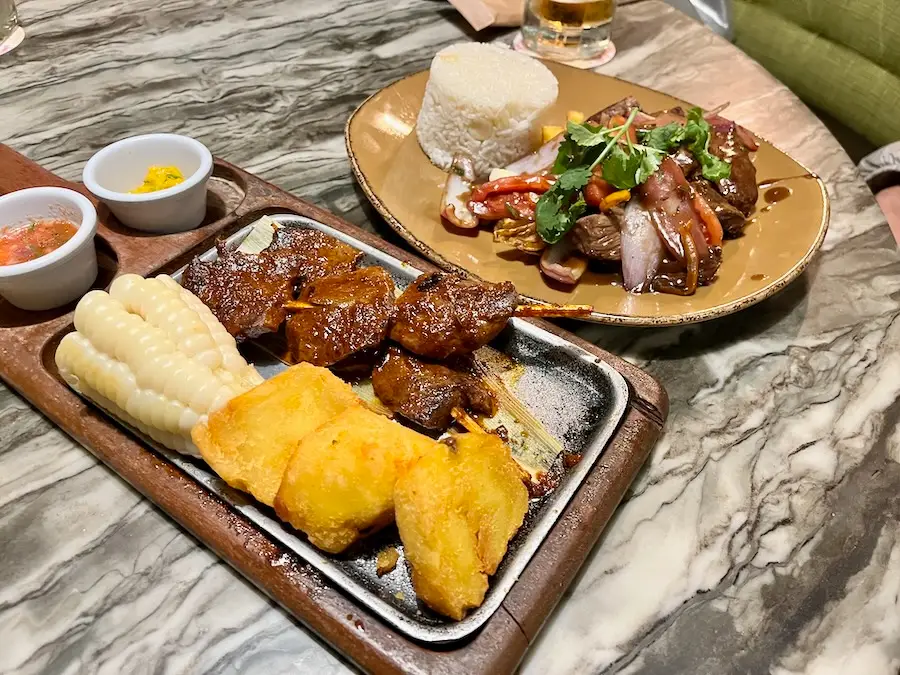
Lima is known as the gastronomical capital of South America , so you’ll find restaurants ranging from budget to high-end.
🚙 Transportation Cost in Peru: $115
My average cost of transportation in Peru was $11 per day.
( This total doesn’t include transportation provided by the Inca Trail or Huacachina tours; those are included in the tour price under entertainment .)
Here are the transportation methods I took and how much I paid for each:
For short distances, Uber is available and relatively affordable in tourist places like Lima, Cusco, and Arequipa. Split with one other person, my Uber rides to the Cusco and Lima airports averaged about $6 per ride . For long distances, buses are the most common transportation method in Peru.
🦙 Entertainment Cost in Peru: $1,053
My average cost of entertainment in Peru was $105 per day. This total includes a 10% to 20% tip at certain places.
Here are all the activities and attractions I paid for and how much each cost:

Expected Cost for Peru’s Top Attractions
Although Peru is an affordable country to visit, many of its main attractions will significantly increase your trip’s budget.
- Machu Picchu – My unforgettable Inca Trail trek to Machu Picchu, a UNESCO World Heritage Site, costs over $800, and you generally don’t want to pay less than $650. Anything less likely means the tour operator isn’t paying its porters well.
If you plan to visit Machu Picchu, make sure you’re prepared for altitude sickness .
- Sacred Valley and Rainbow Mountain – If you’re already in Cusco for Machu Picchu, adding a trip to the beautiful Sacred Valley costs around $40 . A trip to the colorful Rainbow Mountain costs about the same .
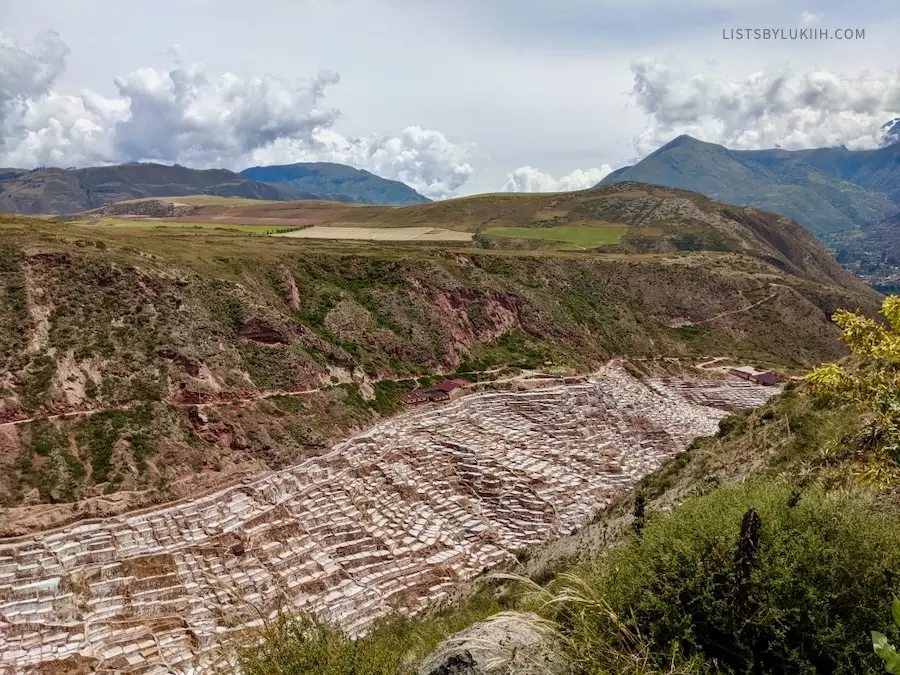
- Colca Canyon – A trip to one of the deepest canyons in the world ranges from $40 for a full-day tour to $100 for a multi-day trekking tour .
- Lake Titicaca – An overnight stay in the largest freshwater lake in South America can cost up to $260 .
- Nazca Lines – The best way to see the mysterious Nazca Lines is by air, and a typical plane tour costs at least $100 .
- Amazon Rainforest – The famous Amazon Rainforest covers almost two-thirds of Peru, and staying there for a few days will cost at least $450 .
Do You Need Cash in Peru?
Peru’s economy is largely based on cash transactions , especially in non-tourist areas, so bring some cash. Major cities like Lima have a great credit card infrastructure, and you will only sometimes need cash there.
Below are tips on bringing and using cash in Peru.
💵 1. USD is widely accepted in Peru.
The US dollar and Peruvian soles are widely used in Peru, so you can withdraw cash in either currency.
If you use USD, expect to receive change in soles, and remember that you may not get a favorable exchange rate.
🏧 2. Carry about $60 worth of cash per day in Peru.
On a typical day, a mid-range budget traveler in Peru will need at least $60 in cash to cover food, transportation, and attractions. A daily cash expense breakdown can look like this:
- $20 at local markets, restaurants, and cafes
- $30 to tip tour guides, drivers, and other service workers
- $10 for shopping and miscellaneous spending
I keep my cash in my crossbody bag , but if you want extra protection against pickpocketing , carry it in a hidden money belt instead.
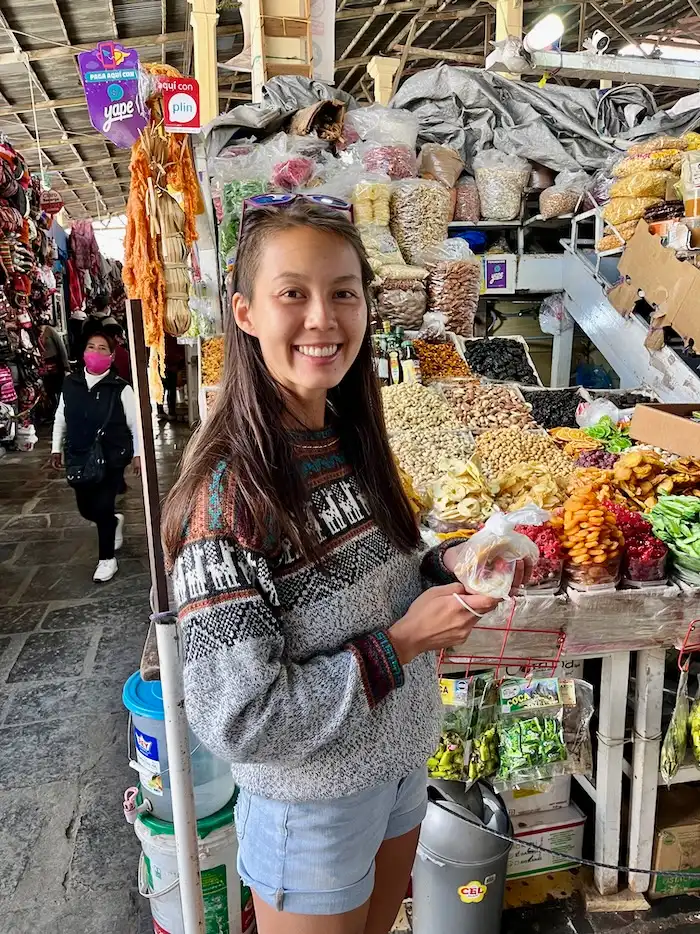
💰 3. Tipping is customary in Peru.
In Peru, a 10% to 15% tip is customary and standard. Tips are expected for tourist activities.
Tipping is best done through cash and small bills , especially when you’re tipping tour guides who may need to split tips with other workers.
See other essential travel tips for Peru before visiting.
Peru Trip Planner 2024
To make your travel preparation easier, download the trip planner below. It has destination-specific travel information, itinerary, map, and packing list.
My trip planners are built on Notion, which I use for all my travel planning. I genuinely love this tool and creating an account is free .
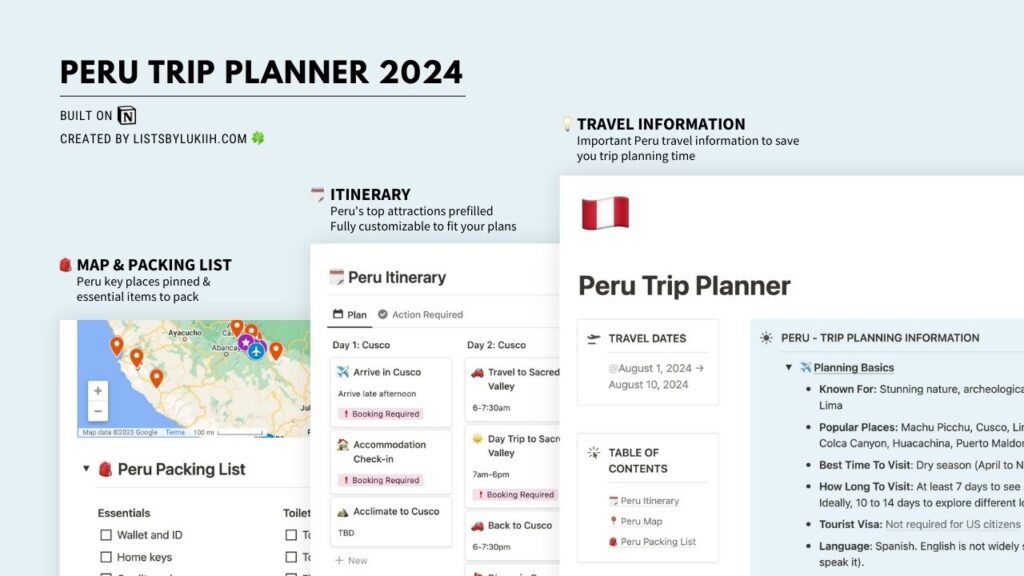
Thoughts? Questions? Leave a comment below .
Peru Travel Guides
- 🇵🇪 Planning a Trip to Peru: 11 Practical Things To Know
- ⛰️ 10 Adventurous Days in Peru: An Efficient Itinerary
- ☀️ Inca Trail to Machu Picchu: Firsthand Review & Tips
- 🏜️ Huacachina Day Trip: Firsthand Review & Tips
🧋 Support Lukiih
Lists by Lukiih is a humble website that I fund with my own savings. If you find my tips helpful, I appreciate you saying thanks with a bubble tea !
I’m an older single traveler wanting to go to Peru from Costa Rica. I prefer a tour for safety in # reasons and I’d like to go to the best sites. I can get my own airline tickets but looking for a tour group once there that does it all- hotels transportation meals etc. Can you recommend a tour co?
Leave a Reply Cancel reply
Your email address will not be published. Required fields are marked *
Save my name, email, and website in this browser for the next time I comment.
The Cost of Peru Travel: Daily Budget
It’s not easy to put a figure on the cost of traveling in Peru. Even among shoestring backpackers, daily budgets can range from almost impossibly low to comparatively decadent. But if you want a rough idea of how much you might spend on a day-to-day basis in 2024, read on…

The Daily Cost of Peru Travel
First, let’s look at the overall cost per day based on your expenses. Budgets mentioned include ONLY the basics: accommodation, food, & transport. (Additional expenses are mentioned further down)
$1 USD = 3.24 PEN
- Low-budget travel: $25-30 USD per day (roughly 80-95 PEN)
- Mid-budget travel: $35-40 USD per day (roughly 110-130 PEN)
As the name already defines it, low-budget travel at $25-30 USD is very low. To get on by that, you’d need to really be holding back: only very basic hostels, cheap set-meals and just local transportation.
The mid-budget travel is the most common for all travelers. At $35-40 USD, you will find good hostels, great food and getting around town with Uber or street taxis.
And for those looking for comfort and maybe a luxurious experience, the daily cost will start from $45 USD and up. Hotels range from 100-1000+ PEN ($30-400+ USD) to high-end restaurants ranging from 40-100 PEN ($15-35 USD) per meal.
Bear in mind, here in Peru you get what you pay for. The more basic the hostel is the further away it tends to be from the touristic places, as well as have less facilities such as hot water, free breakfast, etc. Cheap set-meals could mess with your stomach if you’re not used to local cuisine and local transport can be confusing in the chaotic traffic.
Additional Expenses
Now that the basic daily cost has been covered lets talk about the additional expenses. Even if your basic day-to-day expenses are low, your daily average will rise due to tours, treks, inland travel and many other activities done while traveling. Things to consider include:
- Flights: Although Peru’s domestic airlines aren’t hideously expensive they aren’t cheap either. It’s a good option for those short on time (3-5 days) but if you have more time it’s better to travel by bus this way you get to discover more destinations as well as save money. A few internal flights can quickly eat into a budget, and you may end up missing some incredible spots such as Huacachina or Arequipa along the way.
- Buses: Bus tends to be the preferred travel option for travelers in Peru. Buses are relatively cheap but since costs can add up, especially when you factor in all the taxi costs of going to and from terminals. A highly recommended option is Peru Hop , the first and only hop-on, hop-off bus company which provides pick-ups and drop-offs to your hotel/hostel. It offers a flexible bus pass (50+ options), in which you can stay however long you want in any of the destinations, letting you enjoy at your own pace. Apart from this, there is onboard bilingual assistance on all their busses, as well as discounts on accommodation and restaurants in all the destinations. Learn more about Peru Hop here .
- Tours & Treks: If you’re heading to Peru for the first time, you’ll almost certainly go to Machu Picchu (and maybe hike the Inca Trail). Then there’s a flight over the Nazca Lines, a guided trek into Colca Canyon, a stint on Lake Titicaca… the list goes on. Think of tours to major attractions as additional expenses and calculate your overall budget accordingly. Check FindLocalTrips.com for comparing operators and prices.
- Drinks: Probably one of the biggest additional expenses for all travelers. Beers (620 mL) cost 10-12 PEN while spirits with mixers can cost 15-20 PEN.
- Toiletries: Hygienic products can be found anywhere in Peru (unless you’re deep in the jungle or mountains) with supermarkets like Wong or Metro selling everything to the likes of pharmacies like MiFarma and InkaFarma. Luckily they tend to have many offers on products making the expense lower.
Overall, if you’re trying to budget for your upcoming backpacking trip to Peru, $30-40 USD per day seems like reasonable including the additional expenses. But, like everyone says, it’s better to always have more than to have less!

YOU MAY LIKE

Start planning your trip to Peru in 2021!
Sign up to get all you need to know about Peru destinations for 2021!
Get your FREE sample trip plan from our HowToPeru travel experts!
How many days will you have in peru, how many people traveling.

Thanks! Your personalised itinerary will be emailed very soon!
PERU TRIP PLANNER
Get your sample trip plan from our
HowToPeru travel experts!

- Work With Me

- Sierra Leone
- South Africa
- New Zealand
- Falkland Islands
- Netherlands
- Accommodation
- Electrical Gear
- Essential Gear
- Working Abroad
- Blogging Resources
Americas , PERU , South America
How much does it cost to travel peru.
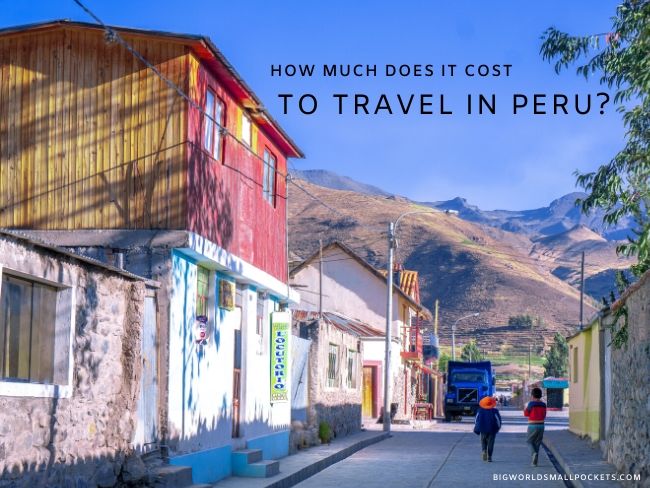
Well congratulations!
Signs indicate that if you’re reading this post, you’re probably thinking about travelling to Peru and let me just start by saying you definitely should!
One of the South American giants, this country is a feast for travellers and while I certainly wouldn’t consider it off the beaten track, there’s still plenty of less or undiscovered gems to unearth in this dazzling diversity destination.
And when it comes to the costs of travelling Peru, this is a good yardstick to use too.
Yes there’s many well-trodden parts of Peru, like Machu Picchu, which unsurprisingly can be a little pricey to visit, but there’s also a lot of places where you can find some amazingly affordable travel experiences too.
And of course, there’s always cheaper ways to see the popular hot spots as well!
So read on to learn more about how much it costs to travel Peru and what your trip budget might shape up to be if you’re planning on visiting soon…
Related Posts
- When is the Best Time to Visit Peru?
- 55 Best Things To Do in South America
- Top 21 Things to Do in Cusco… 9 of which are Free!
This budget is based on the trip I made to Peru in late 2019, with all prices correct at this time.
This page contains affiliate links meaning Big World Small Pockets may receive a small commission on any purchases at no extra cost to you.
An Intro to this Peru Travel Budget
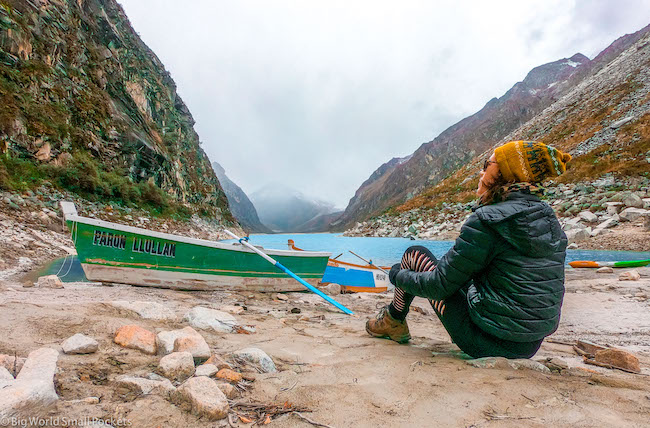
This budget is based exactly on my travels in this amazing country in late 2019, so you can trust it’s entirely authentic.
Obviously it involves travelling in Peru on a budget i.e. eating in cheap, local restaurants and staying at cheap local hostels, because I’m a budget travel blogger, yet it also includes some added extras, which perhaps might not be considered budget travel items, but which are incredibly worthwhile – such as some epic hiking trips, which you quite frankly can’t miss in Peru.
In terms of structure, I’m going to give you a breakdown of different travel categories so that, if you are travelling for longer or with a bit more / less cash, you can do your own workings about how much it might cost you to travel in Peru.
And then, at the end, we look at overall costs of what an average 2 week budget trip to Peru might set you back.
This budget won’t include the cost of any visas (although for Peru you probably won’t need one), nor the cost of international flights, (I always use Skyscanner to find the best deals) so don’t forget to factor those in as well.
The budget also doesn’t include prepping any gear you might need for your trip or taking out travel insurance.
Alternatively, if you’re a long-term traveller, digital nomad or frequent remote worker seeking travel health cover, check out Safetywing’s Nomad Insurance policies.
And with that preamble out the way, let’s get on with answering the question about how much it costs to travel in Peru….
Just enter your details below and I'll email it you - simple!
Information will be sent to the email provided above
#1 Accommodation
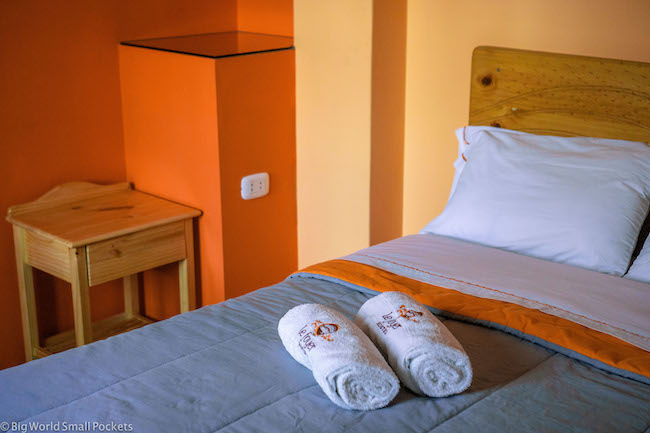
With Peru now well and truly on the traveller map, there really is every bracket of accommodation available here – from dorm beds in huge hostels to ritzy luxury hotels, especially in destinations like Cusco.
And as a budget traveller, there’s no prizes for guessing which end of the scale I inhabited!
But even with a mix of dorm beds and private rooms in hostels (with a bit of camping thrown in here and there), I wouldn’t consider Peru super cheap on the accommodation costs.
In fact, outside of hiking excursions, accommodation is one of biggest costs when you travel Peru because it’s a service aimed at the tourist market and therefore higher than any of the local services like food and transport.
In fact, accommodation accounted for around 25% of my total spend in the country (and yes I use a very geeky, but helpful app called TravelSpend to track this stuff!)
Accommodation in tourist hot spots such as Lima (where basically everyone passes through) or Cusco (where lots of travellers base themselves) tend to be higher than those in smaller villages or towns that receive fewer tourists.
As an example, I paid $10 USD for a dorm bed in Lima and $25 USD for a private room – not bad if you’re sharing the private room, but harder to stomach if you’re a solo traveller.
FYI. I highly recommend staying in the Barranco area of Lima (it’s def the best) and La Unsha Hostel there is great!
In smaller towns, such as Paracas on the coast or Pisac in the Sacred Valley, a private room set me back just $12 USD and a dorm was more like $7 USD.
Across the whole country, you can benchmark a dorm at between $6-11 USD and a budget private room at $12-$25 USD.
So choose your accommodation type, multiply this by the number of nights you’re planning to spend in Peru and you’ve got your rough accommodation budget mapped out!
And if you want to learn about some of the best hostels, then check this list of my recommended backpackers in Peru and my top picks for hostels in Cusco .
Standards of budget accommodation in Peru tend to be very good and most backpacker hostels are clean with good wifi, free breakfast and open-air communal areas.
One thing to watch out for is hot water (make sure they specifically say they have it) and kitchens – it’s often cheaper to eat out in Peru and the food is so delicious here why wouldn’t you!
When you’re out hiking in this country, camping is often the only option.
Most multi-day trekking tours provide tents and mattresses, but you’d be wise to bring your own sleeping bag and silk liner , otherwise you’ll have to hire one.
When it comes to your own gear, make sure it is suitable for cold, altitude conditions.
#2 Transport
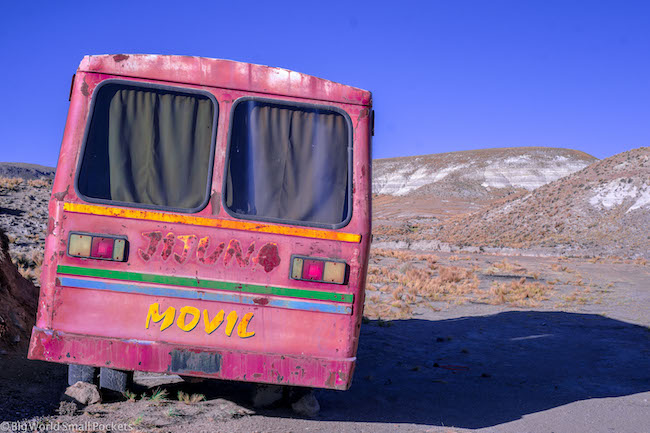
The thing we have to remember about transport when we’re talking about how much it costs to travel in Peru, is how huge this country is!
15 hours on a bus and you barely scratch the surface of this giant nation.
Because of this, most people who only have a short time to visit usually stick to the south of the country exploring Lima, Arequipa, Cusco and their surrounds.
Nevertheless even sticking to just these destinations requires long journeys between them.
Long-Distance Buses
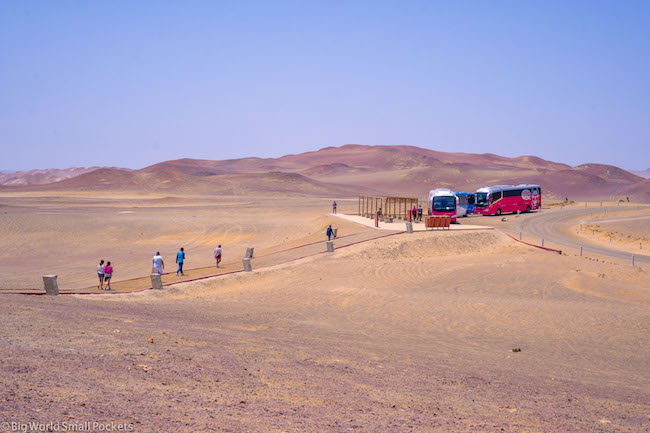
The cheapest way to do this is via an overnight bus service, which will save you the cost of a night’s accommodation.
Bus services tend to vary in Peru, based on price, but most are very affordable, especially if you avoid the tourist-geared services which offer more luxury. Compare prices here .
Cheaper companies are Oltursa, Civa and Movil, but if you’re travelling overnight you may consider the few extra dollars to take a luxury service a good investment… I certainly did!
Cruz Del Sur are one such luxury company, otherwise the excellent Peru Hop service is ideal for solo travellers, or those hitting up South America for the first time, with their guided bus services that offer great security and set routes that mean you have to organise less!
As a guide, here’s some bus prices for popular Peru journeys:
- Cruz Del Sur from Lima to Huaraz: $28 USD
- Oltursa from Lima to Arequipa: $28 USD
- SuperCiva from Arequipa to Cusco: $16 USD
- Peru Hop from Lima to Arequipa and onto Cusco with 7 stops included: $179 USD
If you’re short on time, or don’t fancy a long bus ride, then you can also use domestic flight services to get around Peru.
Obviously these will be more expensive and increase your carbon footprint, but they will be quicker.
Here’s some example flight prices in Peru:
- Lima to Cusco: $40 USD
- Arequipa to Lima: $35 USD
It’s worth noting that domestic flights in Peru (and neighbouring countries such as Bolivia and Chile) tend to offer quite good value for money, but that crossing international boundaries in the sky, tend to hike prices up significantly.
BUDGET TIP: If you’re travelling between different countries in South America therefore, it can often be cheaper to fly domestically, but cross borders by land.
Taxis & Collectivos
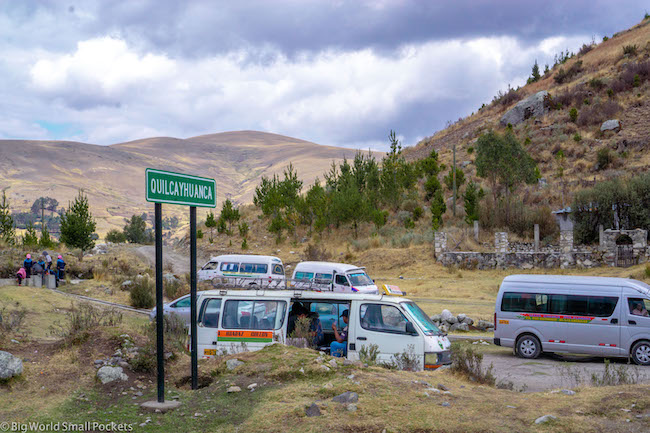
For small travel distances in Peru, such as within Lima, ride-sharing apps like Uber are the best way to go.
Ensuring you don’t get ripped off, as well as helping you navigate any language barriers, you can learn more about why I love ridesharing apps when I travel here .
You can expect to pay around $5 for an Uber ride in Lima between, say your hostel in Barranco / Miraflores and a centrally-located long-distance city bus station.
There’s also a metro in Lima it’s safe to use and here, like every other town in Peru, collectivos are in operation.
Collectivos are minivans used to travel short distances around cities or between villages and nearest towns.
They are incredibly cheap with most rides I took costing under $1 USD, and the best way to discover routes near where you’re staying is to ask at your accommodation reception desk.
#3 Tours & Activities
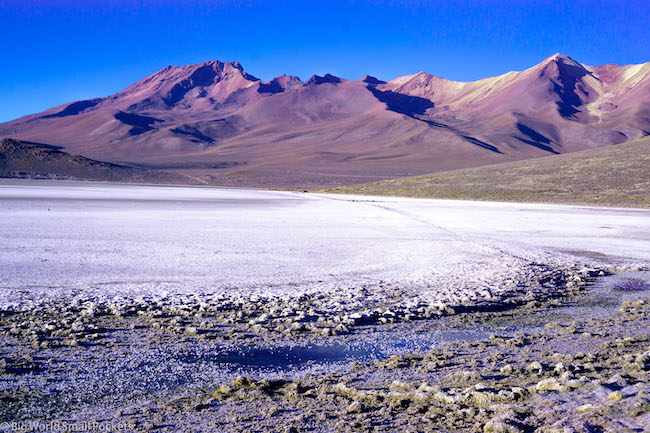
There’s no getting away from the vast quantities of tours and activities you can enjoy in Peru and the fact that there’s no point trying to cover them all – either in your trip or here in this article… the possibilities are just too endless!
So, to give you some ideas, I’m going to stick to some of the country’s greatest highlights giving you an idea of prices here, as well as some handy budget tips about how to do some of them cheaper:
- Half-Day Trip to Ballestas Islands aka the Poor (Wo)man’s Galapagos: $20 USD
- Sunset Sand Boarding Adventure in Huacachina: $13 USD
- Peruvian Cooking Class & Market Tour : $40 USD
- Day Trip to Rainbow Mountain from Cusco : $28 USD
- Day Trip from Lima to Ruins at Caral : $240 USD
Budget Alternative: Independent day drip to Pachacamac ruins: $15 USD. Learn more in my post about the best Lima day trips .
- Colca Canyon 1 Day Tour : $95 USD or Colca Canyon 3 Day Trek : $300 USD
Budget Alternative: Alternative 3 Day Colca Canyon Adventure with Le Foyer Hostel: $155 USD, or there’s a 2 Day option available for $105 USD. And you can get a further 10% off these prices by emailing Hendry at Le Foyer Hostel in Arequipa at [email protected] and quoting BWSP ! Learn more about the amazing experience I had on my alternative Colca Canyon tour with Hendry in my post here .
- Sacred Valley Day Trip from Cusco : $39 USD
Budget Alternative: Take a few days to see the ruins and traditional towns in this area, which allows you to take in the ruins via public transport and without a guide, making it much cheaper. When it comes to spending the night, I recommend the towns of Ollantaytambo (stay at Mama Simona ) and Pisac (stay at Wolf Totem ).
- Inca Trail to Machu Picchu from Cusco : $677 USD or the Salkantay Trek to Machu Picchu from Cusco : $369 USD
Budget Alternative: Lose the crowds and the hefty price tag and get your big Cusco hike fix via the much more undiscovered Choquequirao Hike for around $250 USD. Heading to a set of ruins only currently accessible on foot (although they do plan to build a cable car to them, so get in quick!) this is a tough hike that you can even make without a guide if you have the camping gear and the stamina! Learn more in my post about my Choquequirao trek experience .
- Train to Machu Picchu from Cusco : $127 USD
Budget Alternative: Ditch the train and go for the option that takes you by bus to Hidroelectrica, from where you can walk to Aguas Calientes and then up to MP: $36 USD. Learn more in this post I wrote , or check out more details here .
And don’t forget, in all the major cities in Peru there’s free walking tours that will cost you just a few dollars in tips.
Plus, in so many areas of Peru there are trails, sights and markets you can enjoy for nothing.
#4 Entrance Fees & Guides
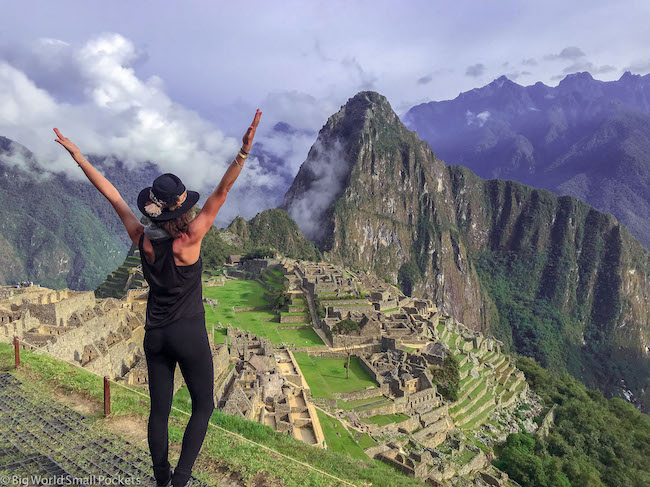
Entrance fees and guides can be hard to price up in Peru, because if you take a tour or a guided trek to many of the most popular ruins and sights, these will be included in the price.
See the above section on tours and activities for more deets.
Otherwise, if you take some of my budget alternative tips, it’s likely you’ll pay entrance fees yourself as you independently travel to different attractions.
Of course, there’s many free and cheap attractions in Peru, but for the big daddies you gotta cough up.
Here’s some examples:
- Entrance to Pachacama Ruins by Lima: $4 USD
- Hot Springs Entrance in Colca Canyon: $3 USD
- Santa Catalina Monastery Entrance in Arequipa: $12 USD
- Entrance to Inca Museum in Cusco: $2.50 USD
- Entrance to Choquequirao Ruins: $18 USD
- Entrance to Machu Pichu: $65 USD
- Cusco Tourist Ticket (10 days): $40 USD
This last option is a great money saver if you think you’ll be visiting a lot of the ruins around Cusco as it’s a combined entrance ticket that will save you money if you’re visiting just 2 or 3 sights including museums. It covers 16 sights in total, both in and around Cusco.
The 10 day option is good if you have a decent amount to explore all this city has to offer otherwise, there’s a couple of smaller circuit 1-2 day options too for $20 USD. Learn more about the Cusco Tourist Ticket here.
#5 Food & Drink
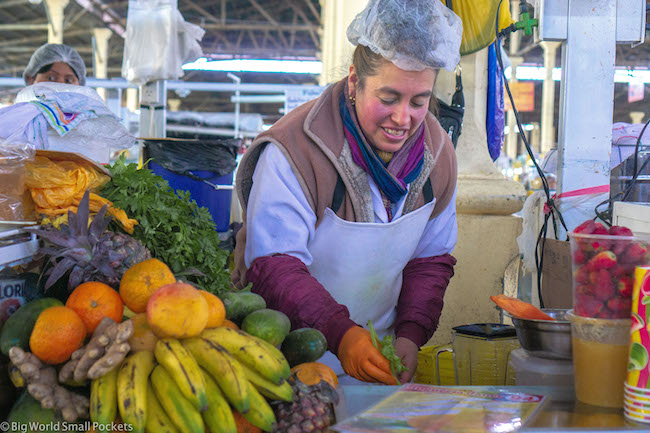
For those not in the know, I’ve got good news!
Peru is a foodie paradise and eating / drinking all the local goodness here is a huge part of your travel experience to come!
And if you eat locally, which you definitely should, then food and drink here is very affordable too.
Most hostels and hotels in Peru include breakfast in their prices.
While this is often a simple affair of cereal, fruit, yoghurt and toast, it’s an ample start to the day and one less meal to worry about.
When it comes to lunch, a fresh juice plus a sandwich in a local market will set you back just $1-3 USD, as will a good espresso coffee at a tourist café.
Supermarkets are plentiful in Peru and good value offering packets of nuts, seeds, crackers and other snacks that are good for hiking trips. They also sell big bottles of water.
The best value here is to buy a 5l bottle and then decant it into a smaller metal water bottle you carry with you during the day. This saves money and plastic waste.
Most supermarkets only offer dried goods however, so head to the great local markets to pick up fresh fruit and vegetables for just a few dollars.
Beers are cheap in Peru too, especially when bought in a store, or at a cheap local place, costing $1-2 each.
For dinner, if you eat in local cafes / restaurants, you can expect to pay around $5 USD for a good feed.
If you want to splash and out in a fairly decent restaurant in Peru however – which you can certainly do in Lima and Cusco – then prices start from around $12 USD including a drink
#6 Other Expenses
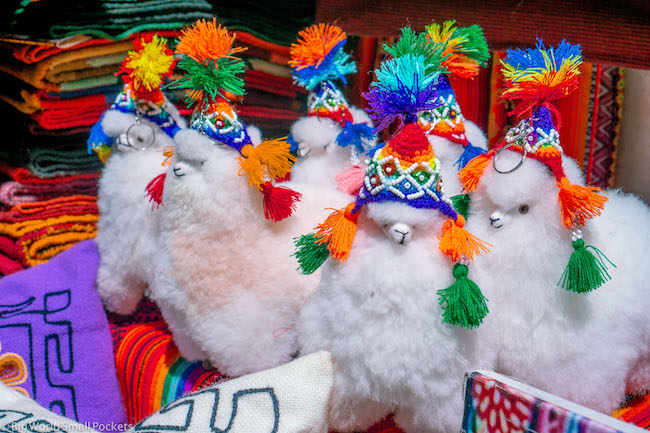
And finally when it comes to Peru travel costs, you’ve got to factor in all those other incidental expenses like laundry (once a week should do it) and possibly a SIM and data package too.
I used several different SIM cards while in Peru (I was there over 2 months so needed to mix it up), but as a benchmark, you’re looking at around $15 USD for a 30 day tourist card with around 10GB data .. yes I use a lot, it’s a work thing!
Laundry in Peru can normally be arranged through your hostel or at local laundromats in larger towns.
In general, you’ll pay by the kg, with an average weekly load costing around $3-4 USD.
Sometimes you can pay more for express services, which can be very handy if you only have a day or so between hikes and no clean socks!
2 Week Example Trip
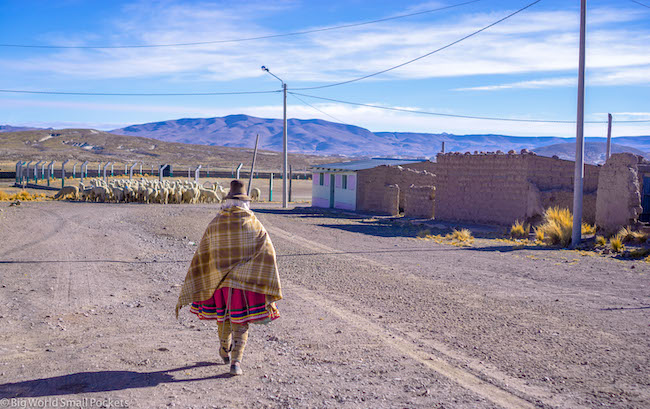
I wanted to give an example trip at the end of this article about how much it costs to travel in Peru, so you can see in practice what you might need for a trip.
For this, I’ve chosen a 2 week backpacker trip for a solo traveller, based on my suggest Peru itinerary , which I think has you seeing the best parts of this huge country in a limited time.
Here’s what an example budget might look like…
- Total Accommodation in Dorm = $10 x 14 nights = $140 USD
- Total Transport Spend = $125 USD including 2 domestic flights, several taxi rides and some long-distance bus rides
- Total Tours and Activities = $280 USD including budget trips to the Colca Canyon, Rainbow Mountain and Machu Picchu.
- Total Entrance Fees & Guides = $110 USD
- Total Food and Drink spend inc. coffee and alcohol = $145 USD
- Other Expenses = $20 USD
The rough amount you can therefore expect to spend in Peru over a fortnight is around $820 USD.
This is roughly $55-60 USD per day, which is in the region of £40-45 GBP per day or 50-55 Euros.
Please remember this is based on a budget travel tier and will vary wildly depending on how many activities you do, whether you stay in dorms or private rooms and how much you eat and drink!
- You could cut this significantly by travelling only on buses (not domestic flights) or taking out a few large ticket items such as side trips to destinations around Cusco and Arequipa… although given these were some of my highlights in Peru, I’d think carefully about this!
Sometimes you’ve got to ask yourself what you’ll remember more – the few dollars saved or the amazing time you had!
PIN IT TO PINTEREST!
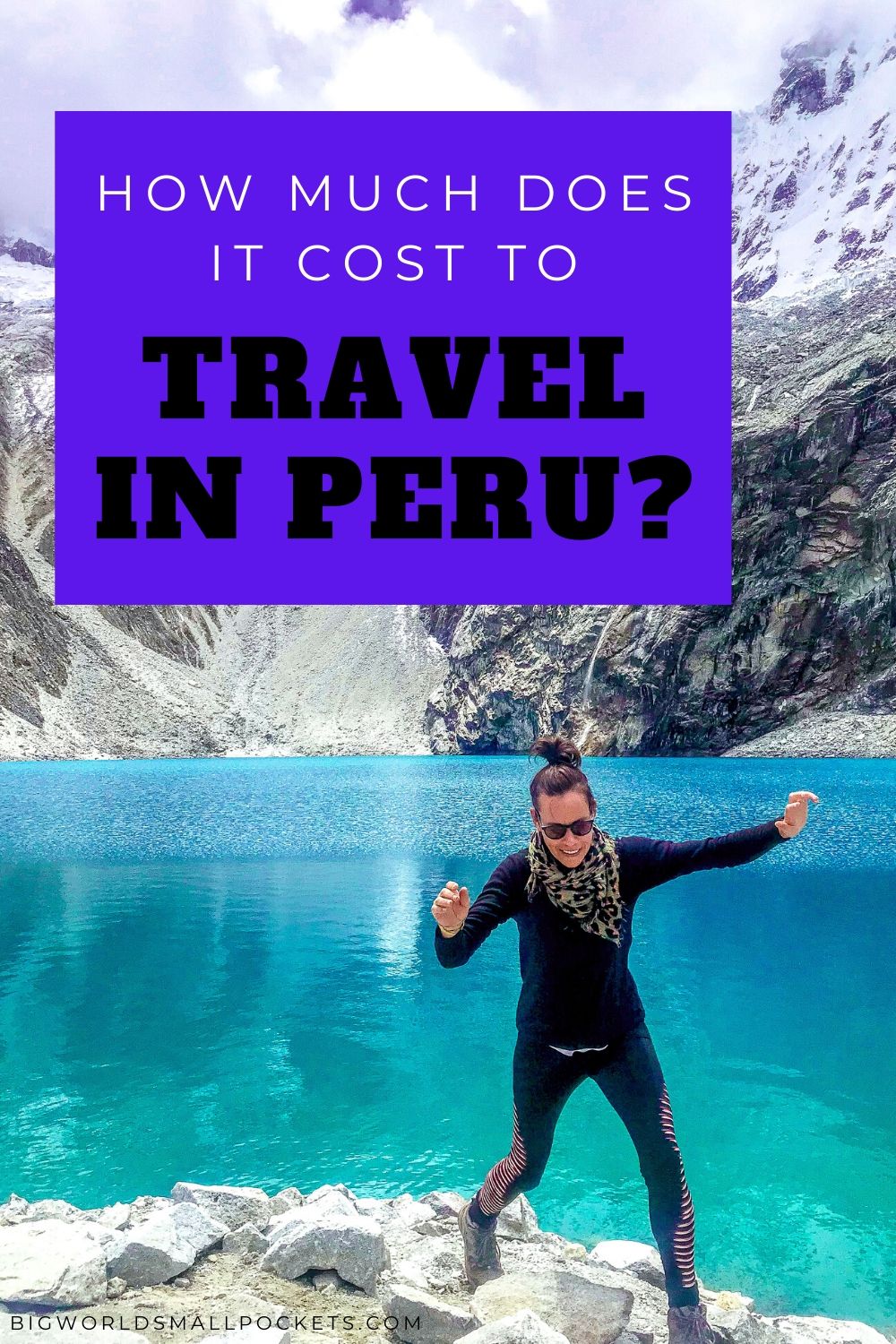
And there it is guys, the full breakdown of my answer to the question – how much does it cost to travel Peru?
Do you think this is cheap or pricey?
Let me know your thoughts in the comments below…
Creator of Big World Small Pockets, Stephanie Parker is a travel addict! Originally from Jersey in the Channel Islands, Stephanie adventures the world collecting tips, advice and stories, to share with a smile
Leave a Reply Cancel reply
Your email address will not be published. Required fields are marked *
This site uses Akismet to reduce spam. Learn how your comment data is processed .

How to plan a Trip to Peru on a budget
Are you planning on traveling to Peru on a budget?
This South American nation is an all-time favorite for travelers heading around the continent. Here we can see epic ancient ruins, go hiking in the Andes as well as spot many exotic animals within the jungle .

What's in this guide?
In this guide we will take a look at how you can travel around Peru on a budget.
This includes how to find cheap hostels, as well as affordable meals and transport methods. We’ll also mention other important things to know before traveling here.
Is Peru worth visiting?
Peru is one of the most diverse countries you can visit in this continent. Here we can find all kinds of landscapes ranging from deserts and jungle, to high-altitude mountains and the wild coast. Your main task will be trying to fit all of this in!
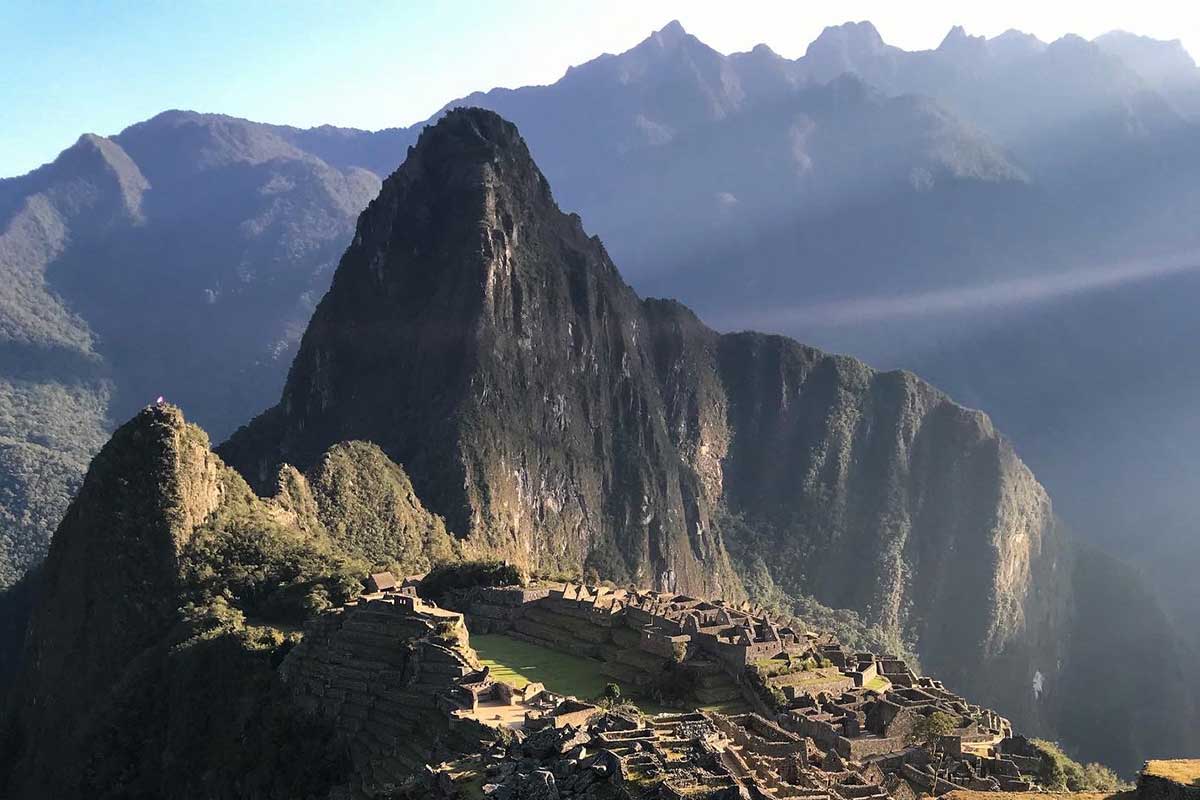
We’ll also find a proud culture here. This can best be explored in markets (such as those around Cusco ) and also in the food (some of the best dishes here we recommend trying includes Papa a la Huancaína, Lomo Saltado and of course Ceviche).
How many days in Peru do you need?
Overall we have found that 3-4 weeks is the perfect amount of time to travel around Peru . With this time we can get to know the cities of Lima, Arequipa and Cusco, as well as other worthwhile towns like Huacachina , Nazca and Huaraz.
It’s also enough time to head on a few multi-day trips (which you’ll definitely want to do here which include mountain hikes, as well as visiting the Amazon Jungle on a multi-day tour from Iquitos ).
Of course if you plan on just visiting one or two regions, then you could do this in around a week. It all depends on your particular timeframe, although we would recommend adding more time rather than less here.
Things to know before traveling to Peru
I (George) have spent numerous years both traveling and living around Peru. I’ve seen it all, so below I’ll share my best tips for you to have the best experience possible.
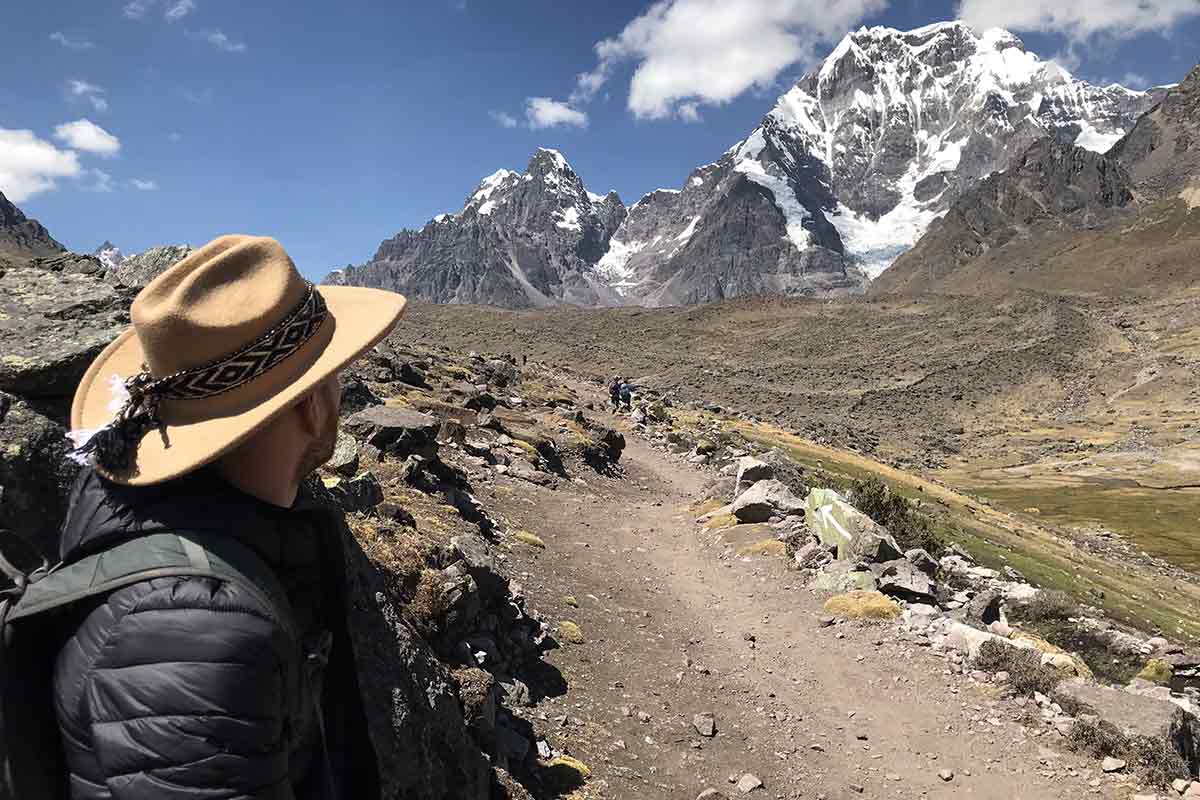
George’s pro tips for visiting Peru on a budget:
- Keep an Open Mind – Yes of course Cusco and Huacachina will be on your itinerary, but also try to discover more places when here. Some are still not well-known, but offer some pretty epic experiences (in my case this was Chachapoyas).
- Pack a Range of Clothes – Regardless of when you’ll visit in the year, you’re going to find all kinds of climates in Peru. You’ll need warm clothing (and a coat) for the Andes, long trousers and a poncho for the Amazon, as well as light clothing for the Pacific beaches.
- Combine Buses and Domestic Flights – Whilst buses remain the cheapest way to get around, you’ll also find local flight operators (like Sky) to be super cheap too. This is definitely a more convenient way of cutting down on some of the longer bus rides – which can be as long as 24 hours in some cases!
As a first timer in Peru, I (Dan) had to learn how to navigate from scratch. When landing in Lima from Medellin , the first thing that I had to get my head around was the currency.
Language and Currency
Let’s now look at some of the other important elements of backpacking Peru on a budget that most travelers will need to consider during their trip.
The dominant language spoken throughout Peru is Spanish, and especially so along the coast.
You don’t need to be completely fluent, however picking up even a few phrases before heading out here can really improve your overall experience . Not only can you navigate better, however locals will also be warmer towards you too.
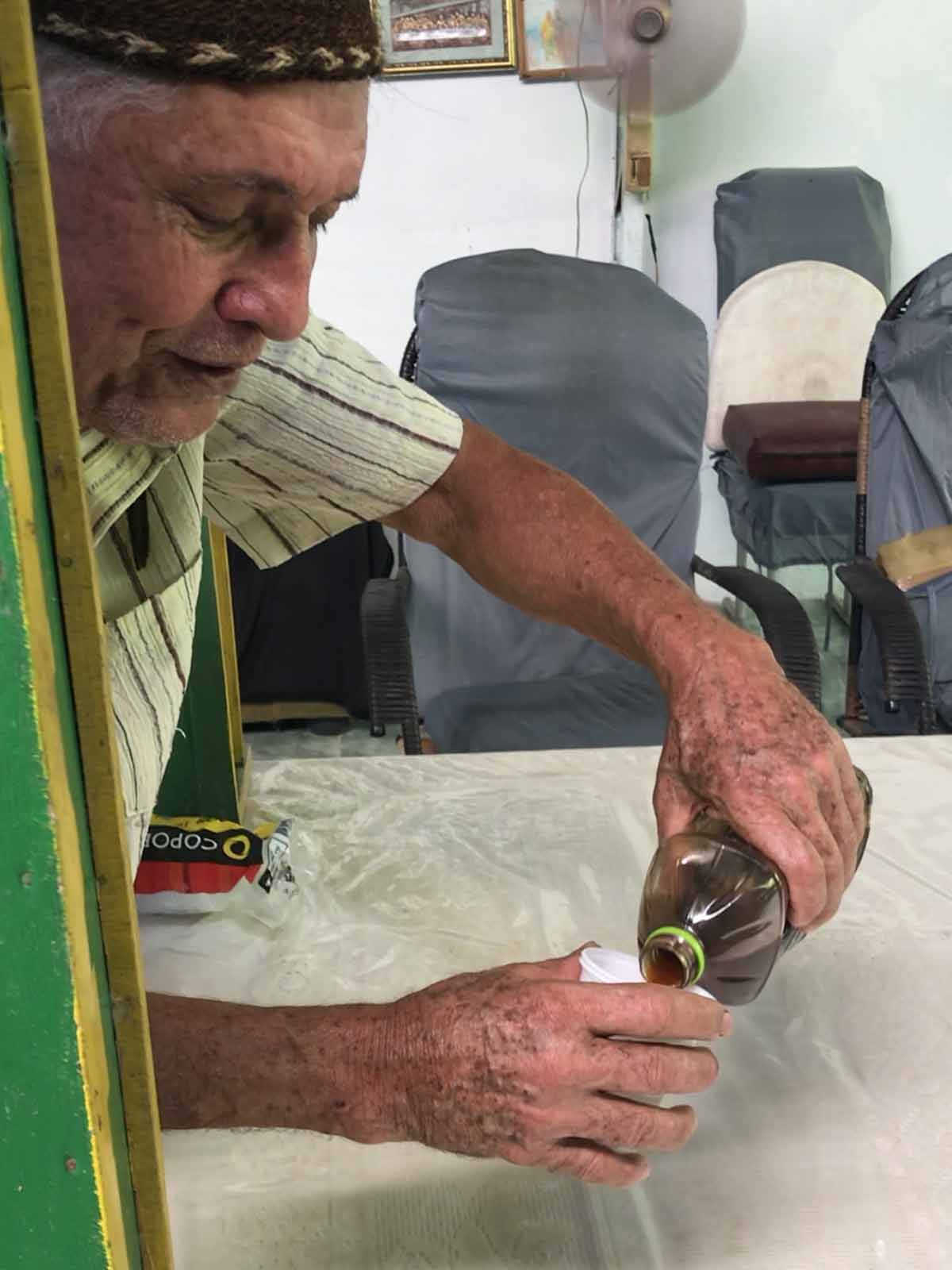
Dan recommends this phrase book as a way to pick up some Spanish before you go.
Knowing Spanish is enough to travel all corners of Peru, including the really remote areas and towns. However it’s important to know there are as many as 80 indigenous languages spoken throughout the country.
In the Andes mountains, Quechua and Aymara are also spoken which remained despite the Spanish invasion. We’ll also find that in the Amazon Jungle there are dozens of local tribe languages used! However the majority will still know Spanish even if it’s not their preferred language on a day-day basis.
In Peru they use the Sol, which at this time of writing (2024) means that $1 USD = 3.5 Soles It’s a good idea to withdraw Soles before you arrive , as the airport ATMs are not that great.
If arriving from either Bolivia or Ecuador , then you can also exchange currencies at a decent rate. Of course in big cities like Lima and Cusco you can get by using Dollars for big purchases.
However for most other things (like transport and buying from local stores) you’ll need local Soles. You can check currency sites such as XE who provide up-to-date and accurate exchange rates.
Getting Around Peru
There’s 3 main ways of getting into Peru. The first is flying into Lima, followed by using buses to cross from Ecuador or Bolivia. Thirdly we also have the boat from Brazil , although this is the least common option (given it’s in the middle of the Amazon Jungle).
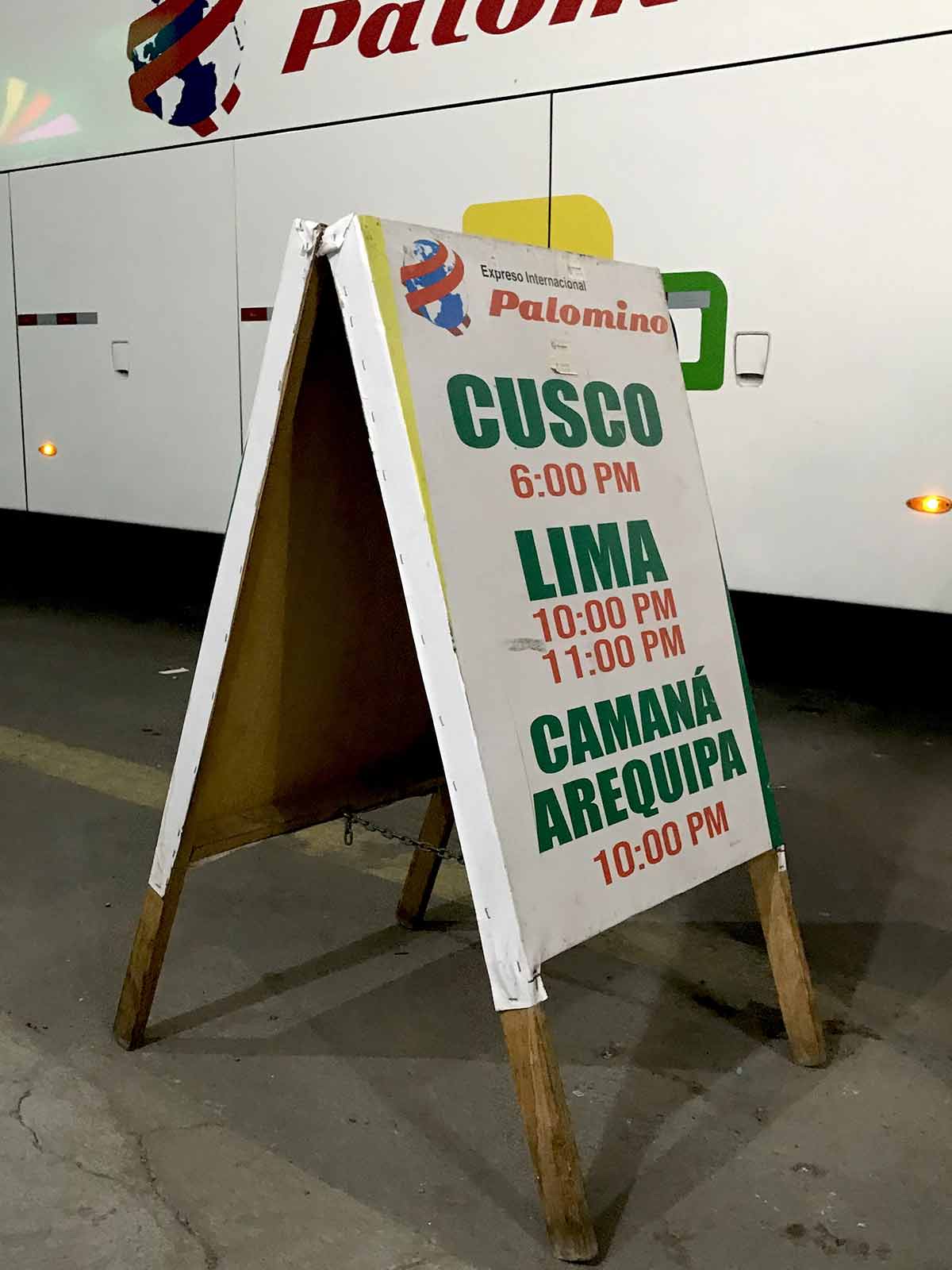
Once in Peru, you’ll find that buses are the cheapest and most efficient way of getting around . Prices are quite affordable, and you’ll find plenty of bus providers who serve different routes. You can also find ones that are more luxurious than others, which offer 160° reclining seats.
You can also use domestic flights, which can be found at a good price in Peru. The most popular ones are from Lima to Iquitos as well as Lima to Cusco, given travel times on land would take over 20 hours. You’ll also find some to be similar to the bus costs, which is a better choice given you’ll save on travel times.
Costs and Budgeting
One of the most important factors to plan before heading off is your budget. Generally in Peru things are pretty cheap, although it’s important to set a budget given there’s lots of tours and transport that you’ll most likely use.
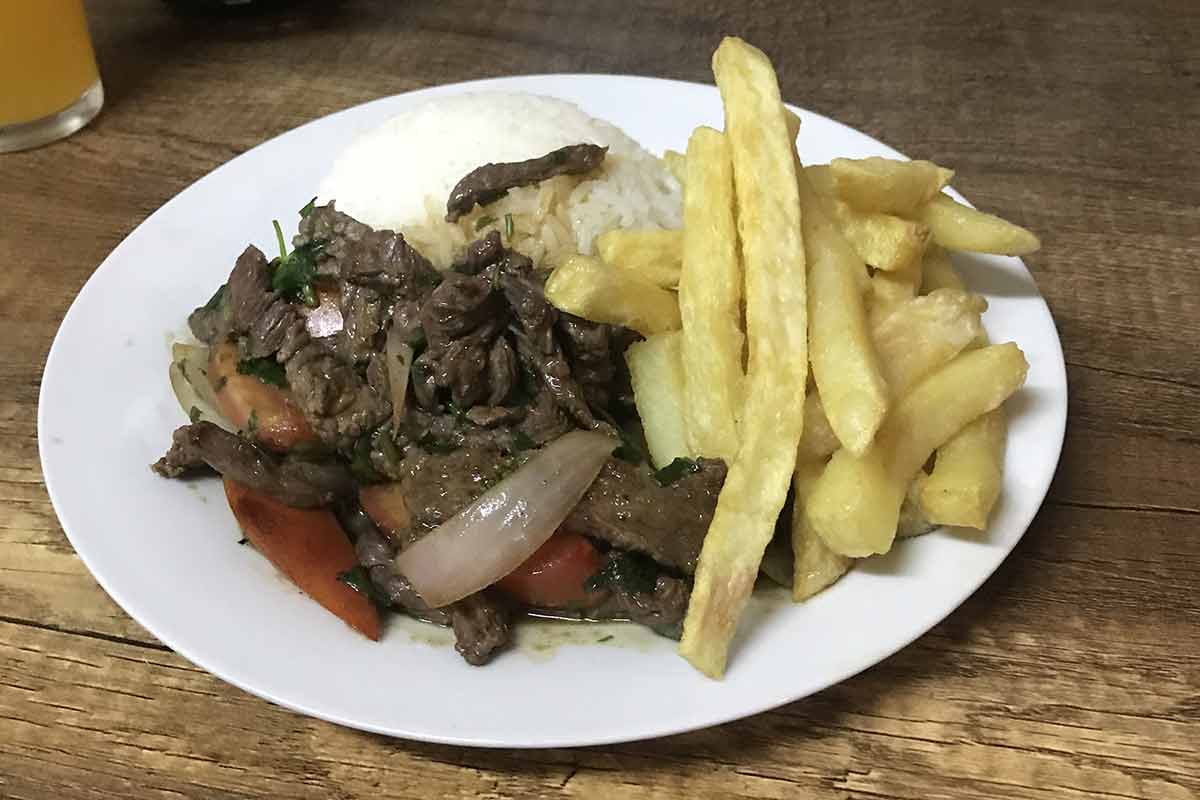
Let’s take a look at how much things tend to be , as well as how to plan a both reasonable and realistic budget. The costs we listed here are correct as of 2024.
Peru Travel Costs
Let’s take a look at the typical costs that you’ll be spending on a day to day basis in Peru. Remember these can and will vary depending on where you are!
For example in the upscale areas of Lima (such as Miraflores or San Isidro) you’ll often pay much more compared with a remote town in the Andean Mountains (such as Pisac).
- Average Dorm Bed = $5-11
- Private Single Room in a Hostel = $12-24
- A Street Food Dish = $3-4
- A Meal at an Inexpensive Restaurant = $5-9
- Beer at a Local Bar or Dive = $2-4
- Beer at a Touristy Bar = $3-5
Peru Travel Budget
Setting your daily budget is really important before your trip. This will help you to travel longer, and also avoid any nasty surprises when checking your bank account.
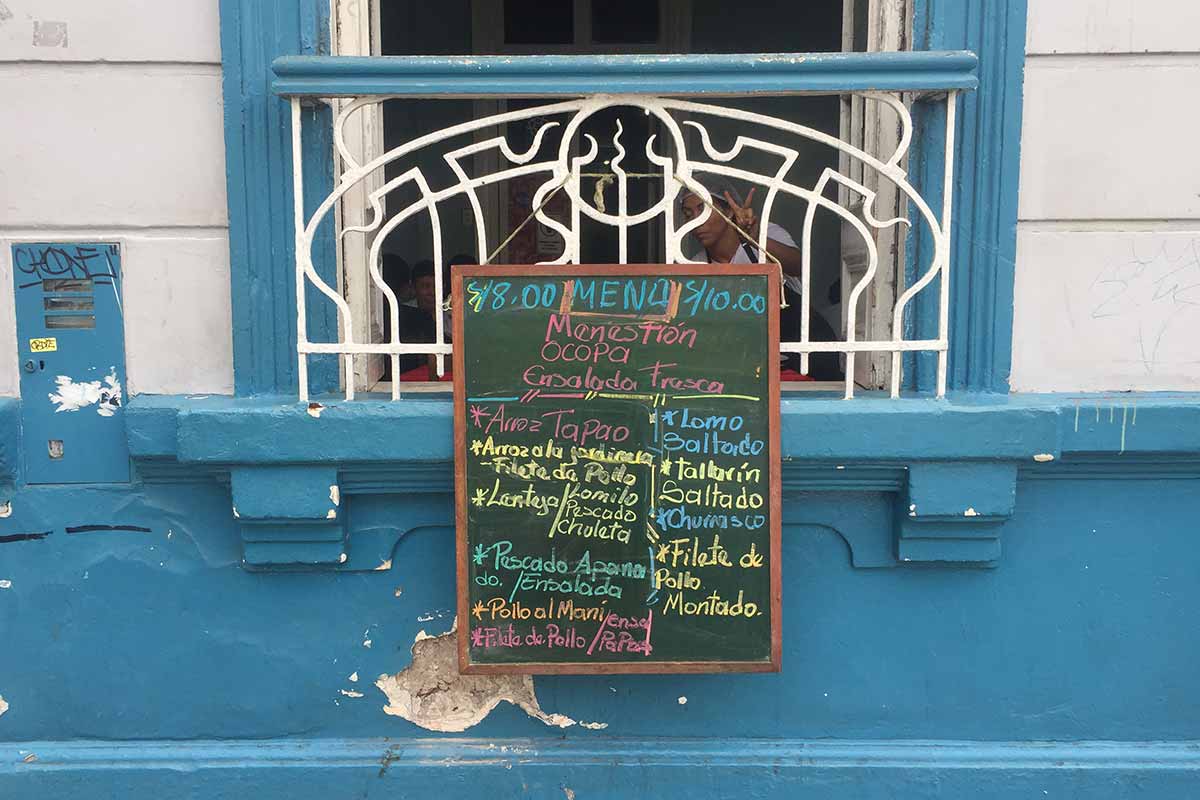
In Peru, the average backpacker will be spending roughly £20-25 a day . This includes staying in a nice hostel , eating local meals (look out for the Menú del día which can be found in most places) as well as getting around the cities using public transportation.
It’s important to remember that you will have extra costs that you will need to plan in advance for. This includes your flights to and from Peru, tours as well as long-distance buses between destinations.
Peru Trip Planning
Planning well before your trip to Peru is vital. Below we’ll go through some of the main things you’ll want to prepare well for before heading to Peru.
What to Pack for Peru?
As already mentioned, there’s a good chance you’ll be visiting a range of different climates throughout your trip to Peru. This means you’ll want to pack a range of different clothes . You can refer to our Peru packing list if you want the full checklist.
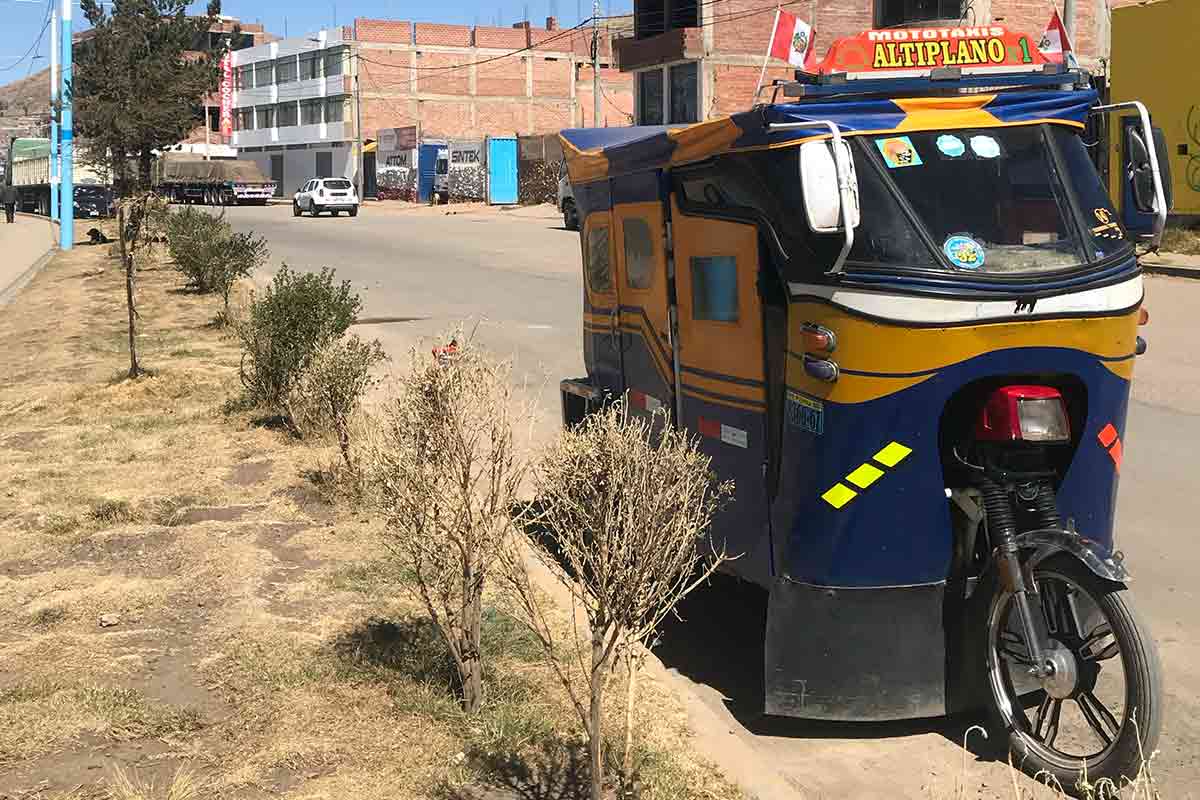
The coastal areas can vary depending on when you visit (such as Lima , Trujillo etc). In the dry season it’s cooler, so a pair of jeans and a jumper will be needed in the evening.
During the wet season it can get pretty hot during the day, so be sure to bring light clothes with you. The Amazon Jungle is hot year-round, so be sure to wear loose and breathable clothing.
You’ll also need solid hiking boots ( guys see here , and ladies see here ) for when heading out tours, as well as long trousers for those deeper jungle hikes. Rain is heavy throughout the year here, so be sure to carry a durable poncho with you too.
Lastly we have the Andean mountains, which are popular for those heading to places like Cusco and Huaraz . Temperatures are pretty cold throughout the year, so be sure to bring a thick jumper and coast. You’ll also want gloves and a hat for when heading on the higher-altitude day trips and treks. Make sure to wear sunscreen too, given the sun here is intense and can burn quickly!
Below is a basic list of the most common injections that travelers heading to Peru can get. As always, please see your doctor as we are not medically trained or qualified to give advice.
They’ll tell you exactly what you need for each specific country.
- Hepatitis A
- Yellow Fever
Got travel insurance for Peru?

How to plan a trip to Peru on a budget
And that’s all for our guide on how to travel Peru on a budget.
One of the most popular countries to go backpacking around in South America, Peru also remains one of the cheapest . It’s more than possible to stick to a daily budget of $25, which includes staying in nice hostels, eating three filling meals as well as using local transport to get around.
If you’re currently planning your trip, be sure to read our Peru Backpacking Itinerary for more ideas on what to do when traveling around this epic Andean nation.
👉🏽 P.S. If you’ve found this guide helpful, buy us a coffee here to say thanks! Or, support us by downloading our South America Travel Bible to get our best content.
“ Dear traveler! Some links in this post contain affiliate links. Meaning, if you click through and make a purchase, book a hostel or sign up for a tour, we may earn a small commission at no additional cost to you . Your support means a lot and helps us to carry on traveling and maintaining the quality of this site for you.”
Similar Posts
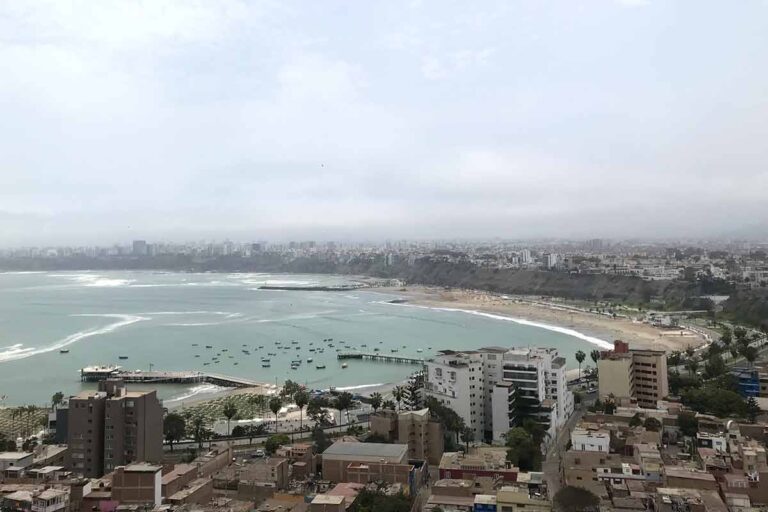
Is Lima Safe? 2024 Travel Safety Guide
Welcome to our Lima travel safety guide. The Peruvian capital is slowly making its way onto more travel itineraries, and not just for the usual layover either. After all – there’s a reason George decided to live here after over a year of traveling! Here you’ll find incredible colonial architecture, cute plazas, ancient ruins and…
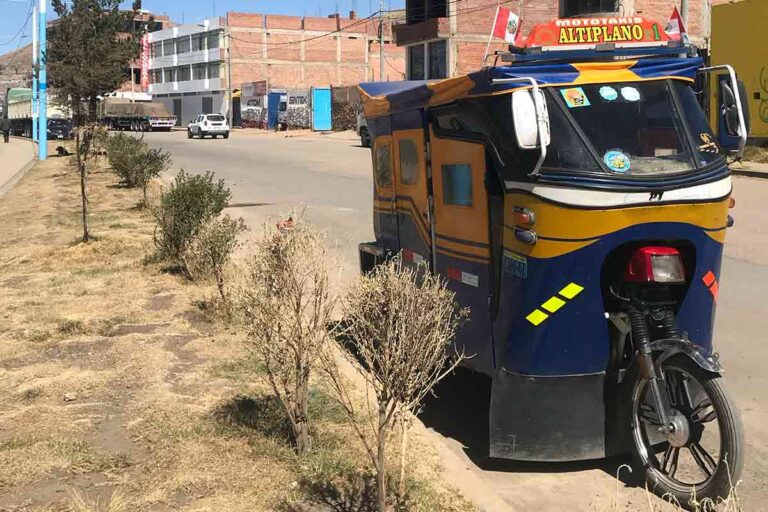
Is Peru expensive?
Is Peru expensive and how much money do you need when traveling here? This diverse country is best-known for its Andean mountains and mysterious cultures, however there’s much more to explore in Peru. From enjoying the towns along the Pacific coast to venturing trying various tasty dishes, there’s a lot more going for this South…
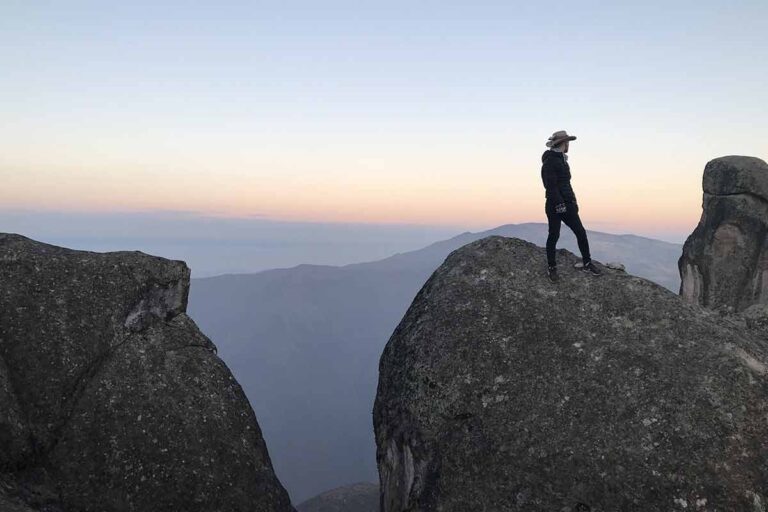
Best time to visit Peru 2024
Peru is a truly fascinating country to visit. It is here we can explore various ancient ruins, hike through some unforgettable landscapes as well as throw ourselves into a culture which is known for its old traditions and mouth-watering foods. In this guide we’ll explore the best time to visit Peru, which includes whether this…
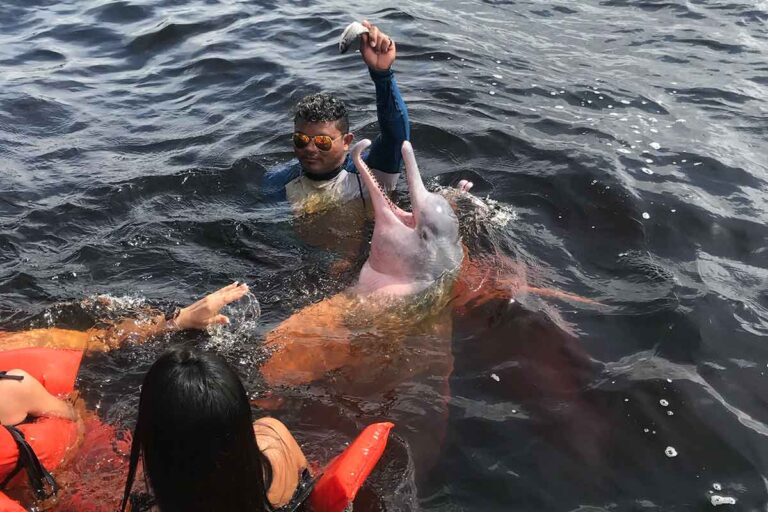
Amazon Rainforest Tours in Brazil
The most expansive jungle region on the planet, the Amazon Rainforest is one those must-visits when touching down in this continent. You can visit this rainforest in various countries, however Brazil’s portion remains the largest and most accessible (below we’ll focus solely on the Brazilian Amazon). Amazon Rainforest Tours in Brazil In this guide we’ll…
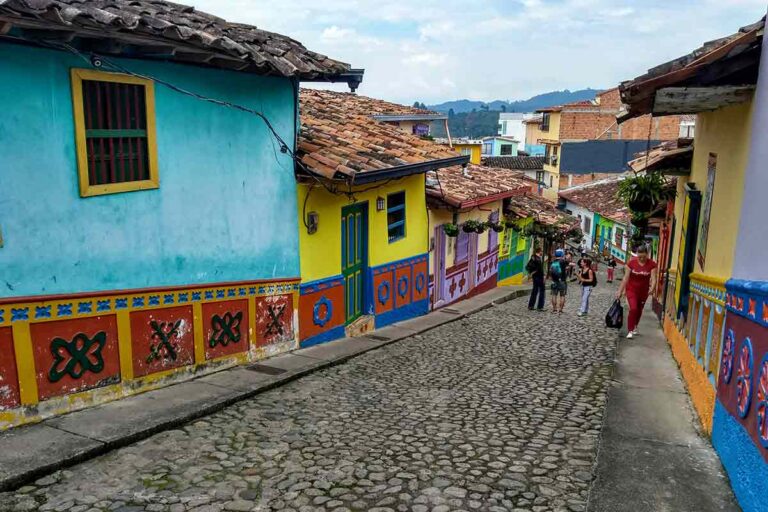
10 days in Colombia itinerary
Welcome to our 10 days in Colombia itinerary. This thriving country is full of culture and epic sceneries, from the famed coffee region of El Eje Cafetero to the beaches along the Caribbean coast. Within Colombia’s big cities such as Medellin and Cali, you can also find some really heated nightlife scenes, as well as…
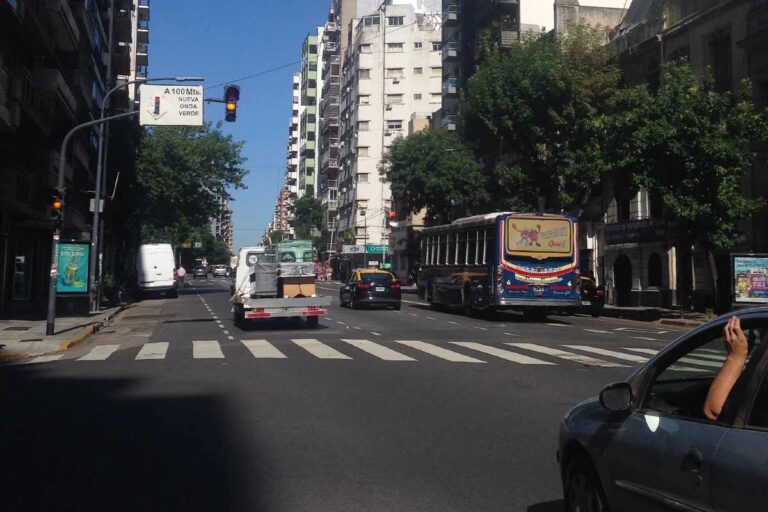
Is Buenos Aires Safe?
Welcome to our Buenos Aires safety guide. A bucket list city for most travelers heading to South America, the Argentinian capital has tonnes going for it. Here we can visit impressive sights such as the Recoleta Ceremony and the Teatro Colón, as well as try out a Tango dancing class (or watch the locals put…

© Gianella Castro

Peru is as complex as its most intricate and exquisite weavings. Festivals mark ancient rites, the urban vanguard fuels innovation and nature bestows splendid diversity.
Best Time to Visit
Best places to visit, attractions, must-see attractions.
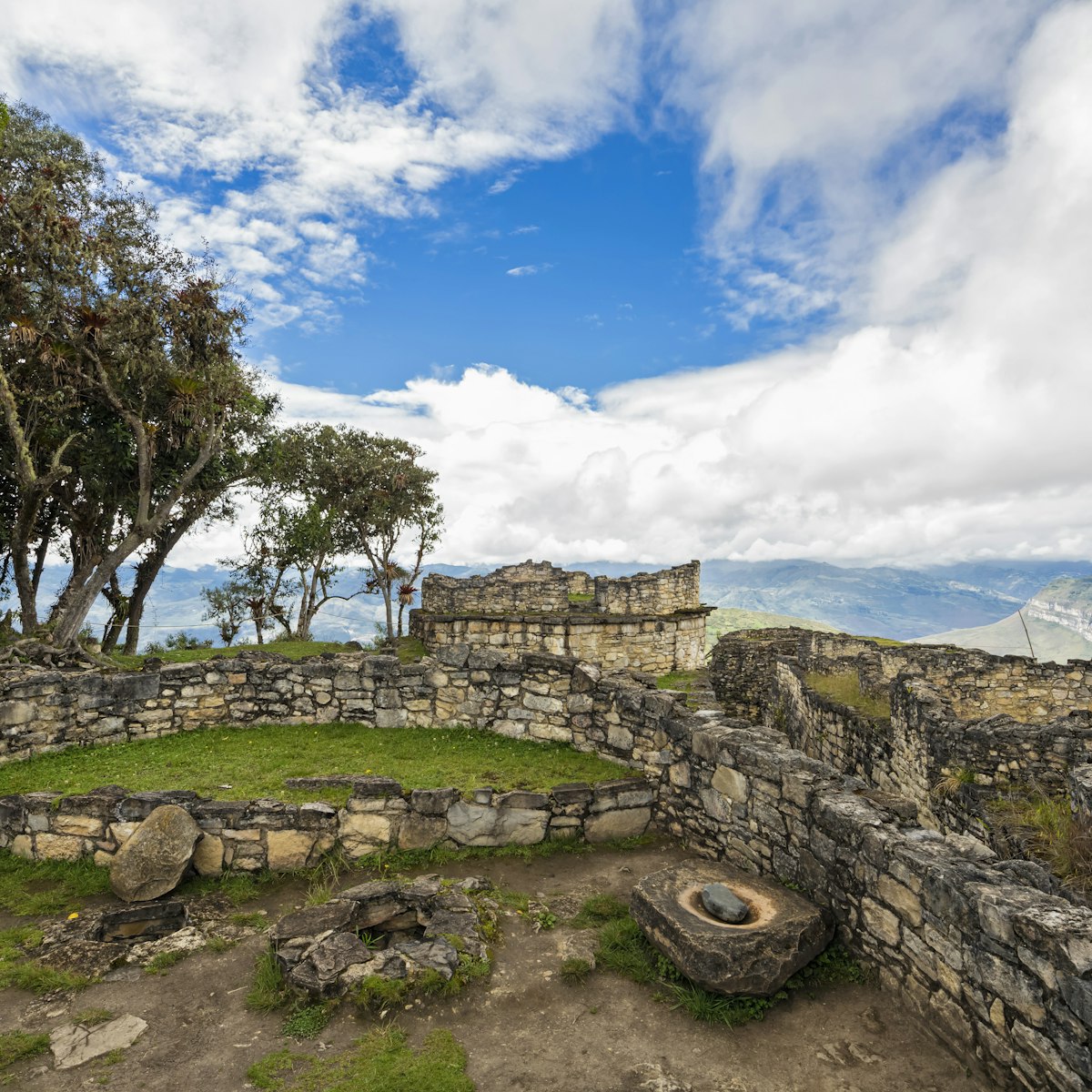
Travelers have their heads literally in the clouds when visiting the walled jungle fortress Kuélap in the northern highlands of Peru – the gateway to the…

Laguna Parón
Cordillera Blanca
The largest lake in the Cordillera Blanca — a snowcapped range of the Andes in west central Peru — and a gorgeous natural reservoir, Laguna Paron is a…

Chavín de Huántar
Huaraz & the Cordilleras
In most people's minds, Chavín is less a town and more a set of ruins – not any old ruins, but the erstwhile ceremonial center of one of Peru's most…

North Coast
Before metal or ceramic was invented and well before the Maya and Inca cultures ruled, there was Caral, the oldest civilization in the Americas. Having…
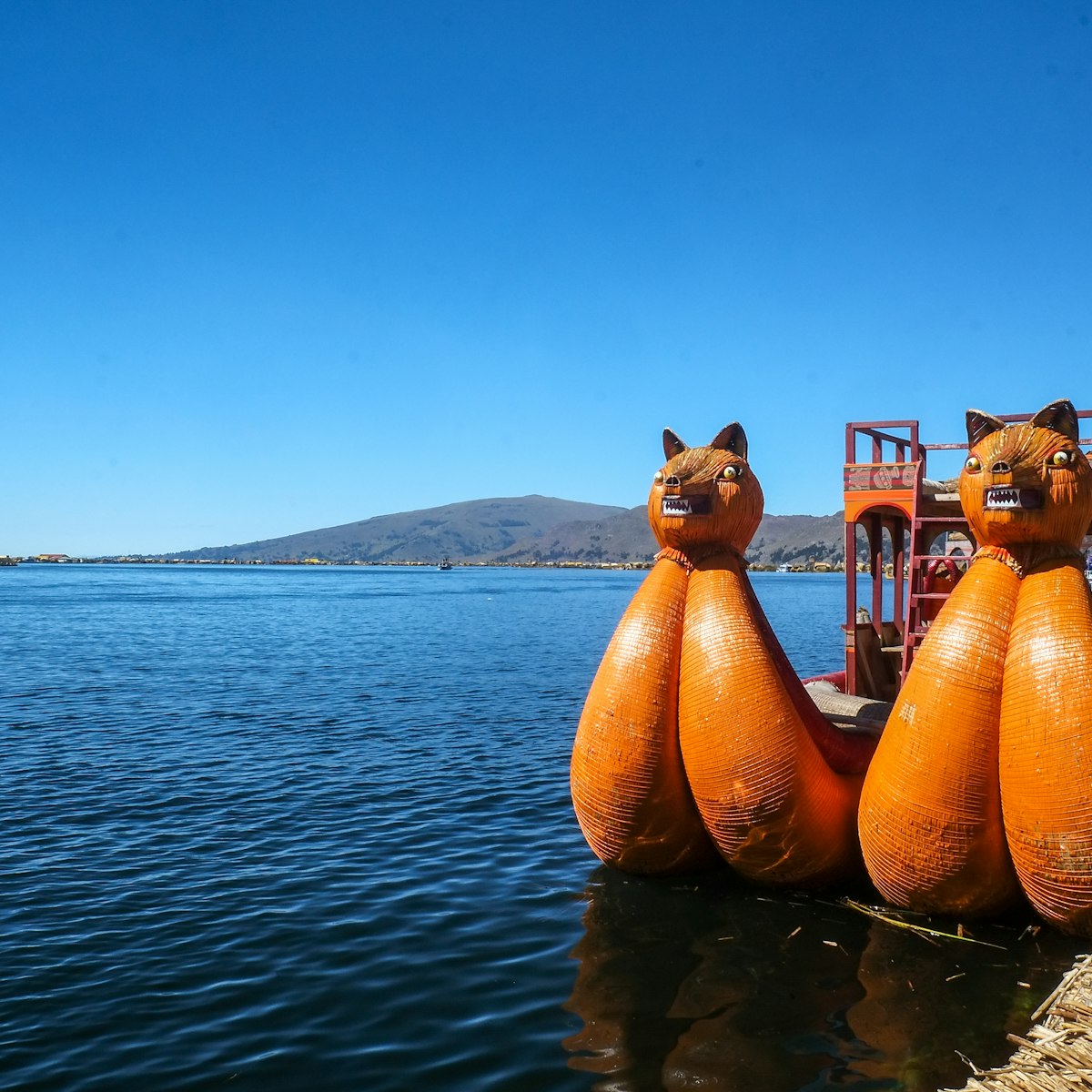
Isla Amantaní
Lake Titicaca
Of the small remote islands dotted around Lake Titicaca, Isla Amantaní is the least visited. Its population is just 4000, is a few kilometers north of the…

Belén Mercado
At the southeast end of town is the floating shantytown of Belén, consisting of scores of huts, built on rafts, which rise and fall with the river. During…
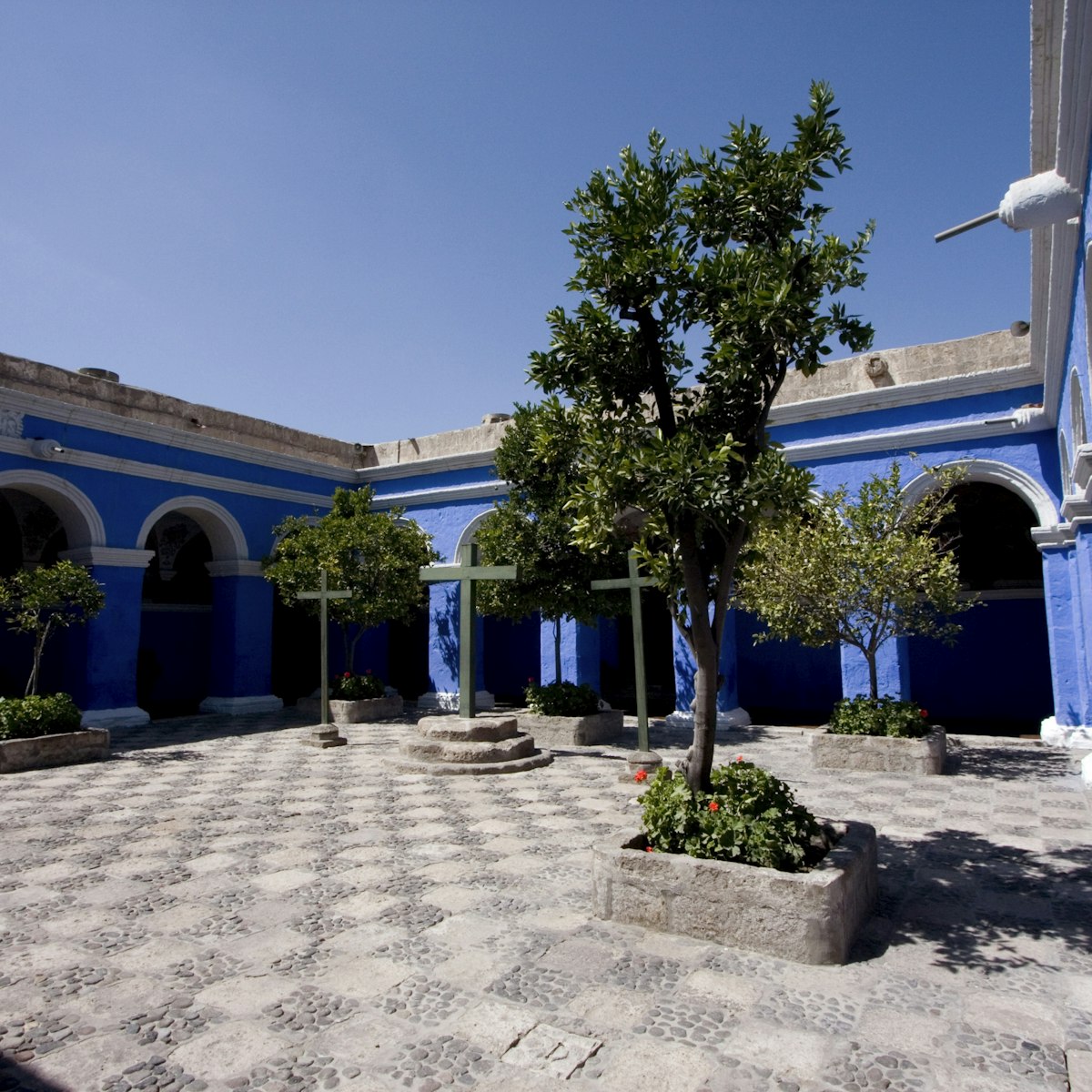
Monasterio de Santa Catalina
This convent shouldn’t be missed, even if you’ve overdosed on colonial edifices. Occupying a whole block and guarded by imposing high walls, it is one of…
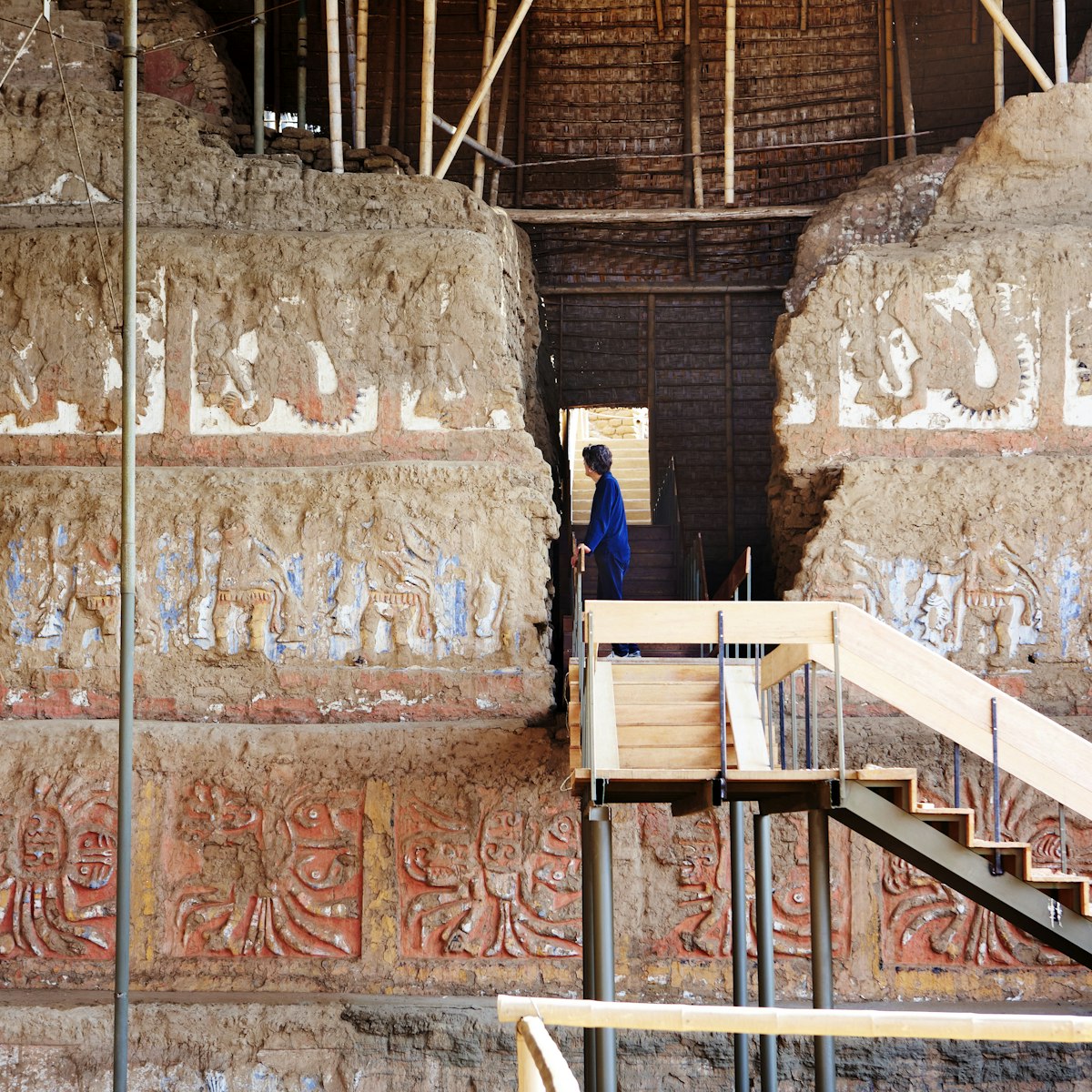
Huacas del Sol y de la Luna
If there's one must-see archaeological site in the region, this is it. The Temples of the Sun and the Moon, attributed to the Moche period, are more than…
Top picks from our travel experts
The 10 best experiences you can have in peru.

Reserva Nacional de Paracas
South Coast
This vast desert reserve occupies most of the Península de Paracas and houses remote beaches backed by dramatic arid landscapes and plenty of wonderful…

Islas Ballestas
Grandiosely nicknamed the ‘poor man’s Galápagos,’ the Islas Ballestas make for a memorable excursion. The only way to get here is on a boat tour, offered…

Parque Nacional Manu
Amazon Basin
This vast national park in the Amazon Basin covers almost 20,000 sq km and is one of the best places in South America to see a stunning variety of…
Planning Tools
Expert guidance to help you plan your trip.
Best Things to Do
With the Andes, the Amazon rainforest, and an epic coastline, Peru is a wonderland for adventurers. These are our 10 favorite experiences you can't miss.
Things to Know
Gain local insight on Peruvian culture, etiquette and safety before you travel to this South American hotspot.
Transportation
Exploring Peru is a real adventure and worth every minute of extra planning. Here’s our guide to getting around once you're here.
Visa Requirements
Curious if you need a visa for visiting Peru? Here's all you need to know.
Money and Costs
Peru has long been a destination for backpackers on a budget and now other travelers have caught on – here's how to make your money go further on the road.
Traveling with Kids
Every adventure-seeking family with a great appetite should have Peru on their "dream destinations" list. Here are the best things to do there with kids.
Best Road Trips
From lesser-known pre-Incan archaeological sites to lush jungles and tranquil beaches, these are the best road trips in Peru.
Plan with a local
Experience the real Peru
Let a local expert craft your dream trip.
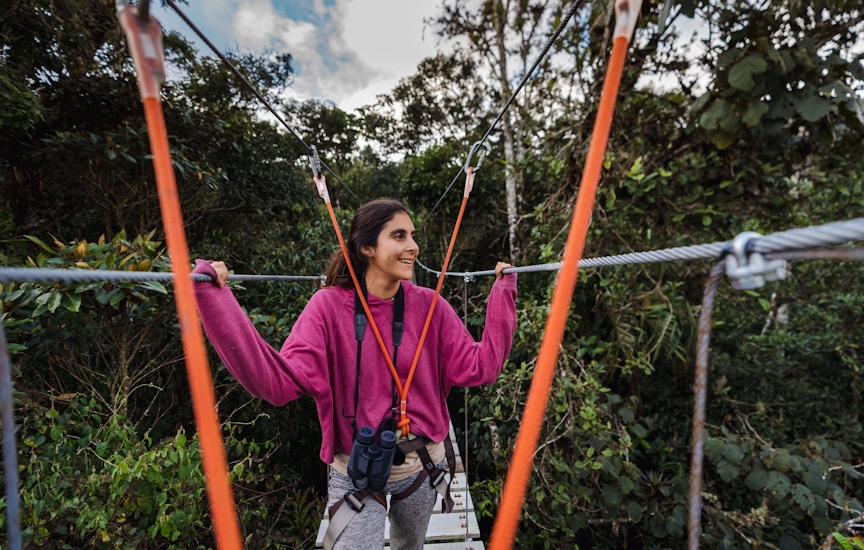
Latest stories from Peru
Filter by interest:
- All Interests
- Adventure Travel
- Art & Culture
- Beaches, Coasts & Islands
- Food & Drink

Jun 11, 2024 • 5 min read
Starting this month, Machu Picchu has introduced new circuits to preserve the archeological site. Here's how to find the right route for you.

Jan 30, 2024 • 7 min read

Jan 10, 2024 • 6 min read

Jan 2, 2024 • 11 min read

Dec 14, 2023 • 3 min read

Nov 26, 2023 • 6 min read

Nov 16, 2023 • 6 min read

Nov 14, 2023 • 7 min read

Nov 10, 2023 • 9 min read

Nov 8, 2023 • 6 min read
in partnership with getyourguide
Book popular activities in Peru
Peru and beyond.

Cost of a Trip to Peru, IN, US & the Cheapest Time to Visit Peru
The average price of a 7-day trip to Peru is $1,361 for a solo traveler, $2,444 for a couple, and $4,582 for a family of 4 . Peru hotels range from $54 to $247 per night with an average of $95, while most vacation rentals will cost $140 to $640 per night for the entire home. Average worldwide flight costs to Fort Wayne International Airport ( FWA ) are between $569 and $754 per person for economy flights and $1,786 to $2,366 for first class. Depending on activities, we recommend budgeting $45 to $82 per person per day for transportation and enjoying local restaurants.
See below for average , budget , and luxury trip costs. You can also look up flight costs from your airport for more tailored flight pricing.
The Cheapest Times to Visit Peru, IN, US
On average, these will be the cheapest dates to fly to FWA and stay in a Peru hotel:
- January 8th to March 11th
- April 16th to April 29th
- August 13th to November 18th
The absolute cheapest time to take a vacation in Peru is usually late January and early February .
Average Peru Trip Costs
Average solo traveler.
The average cost for one person to visit Peru for a week is $1,089-$1,938 ($156-$277 per day)
Food, Travel, and Sightseeing : $45 to $82 per day for one person’s daily expenses
Flights : $360 to $626 for economy
Lodging : $69 to $91 per night for one 2 or 3-star hotel room
or $101 to $123 per night for a 1-bed vacation rental
Average Couple’s Trip
The average cost for a couple to visit Peru for a week is $2,182-$3,394 ($312-$485 per day)
Food, Travel, and Sightseeing : $90 to $164 per day for two people’s daily expenses
Flights : $720 to $1,252 for economy
Average Family Vacation
The average cost for 4 people to visit Peru for a week is $3,528-$5,910 ($504-$844 per day)
Food, Travel, and Sightseeing : $180 to $328 per day for four people’s daily expenses
Flights : $1,440 to $2,504 for economy
Lodging : $138 to $182 per night for two 2 or 3-star hotel rooms
or $141 to $185 per night for a 2-bed vacation rental
Traveling Cheap to Peru
How cheap can you make a vacation to Peru? The cheapest trip to Peru is about $112 per person per day for travelers willing to take standby flights, deal with inconvenience, and otherwise limit travel expenses. About 0% of rentals are available in the $0 to $100 range for an entire place, and vacation rentals can be booked for as low as $140 per night. These inexpensive rentals must be booked as early as possible and may not be in the most desirable areas. 1-star hotels are more likely to be available, with rooms starting at around $46.
Even cheaper trips are possible depending on where you live and whether you can drive. Check the cheapest times to fly for more saving ideas.
Budget Solo Traveler
The lowest cost for one person to visit Peru for a week is $783-$1,993 ($112-$285 per day)
Food, Travel, and Sightseeing : $21 to $41 per day for one person’s daily expenses
Lodging : $46 to $54 per night for one 1-star hotel room
or $140 to $180 per night for a 1-bed vacation rental
Budget Couple’s Trip
The lowest cost for a couple to visit Peru for a week is $1,290-$2,906 ($184-$415 per day)
Food, Travel, and Sightseeing : $42 to $82 per day for two people’s daily expenses

Budget Family Vacation
The lowest cost for 4 people to visit Peru for a week is $2,580-$5,380 ($369-$769 per day)
Food, Travel, and Sightseeing : $84 to $164 per day for four people’s daily expenses
Lodging : $92 to $108 per night for two 1-star hotel rooms
or $224 to $288 per night for a 2-bed vacation rental
Overall it is possible but not easy to travel to Peru cheaply.
The Cost of a Luxury Peru Trip
There is no true ceiling on the cost of a luxury trip, so our estimates are based on what most people do in Peru.
Luxury Solo Traveler
The high-end price for one person to visit Peru for a week is $2,252-$11,330 ($322-$1,619 per day)
Food, Travel, and Sightseeing : $86 to $164 per day for one person’s daily expenses
Flights : $918 to $1,734 for first class
Lodging : $122 to $247 per night for one 4 or 5-star hotel room
or $640 to $1,408 per night for a preferred vacation rental
Luxury Couple’s Trip
The high-end price for a couple to visit Peru for a week is $3,772-$14,212 ($539-$2,030 per day)
Food, Travel, and Sightseeing : $172 to $328 per day for two people’s daily expenses
Flights : $1,836 to $3,468 for first class
Luxury Family Vacation
The high-end price for 4 people to visit Peru for a week is $7,544-$24,200 ($1,078-$3,457 per day)
Food, Travel, and Sightseeing : $344 to $656 per day for four people’s daily expenses
Flights : $3,672 to $6,936 for first class
Lodging : $244 to $494 per night for two 4 or 5-star hotel rooms
or $960 to $2,112 per night for a preferred vacation rental
Peru Hotel Prices
The cost of staying in Peru is about average than the average city. On average hotels are less expensive than vacation rentals. Luxury vacation rentals are more expensive in Peru due to very high property costs. The graphs below show how much cost can vary depending on the type of experience you’re looking for.
Peru Lodging Cost by Star Status
The average price for the class of hotel is on the (y) axis. The hotel class (out of 5 stars) is on the (x) axis.
Prices are based on Peru hotel averages and may not reflect current prices. In some cases, we extrapolate prices to estimate costs, and hotels with your desired star rating may not be available.
Vacation Rental Prices
The percent of vacation rentals in the price range is on the left (y) axis. Price range is on the bottom (x) axis.
There are many options for vacation rentals across many price ranges in Peru.
Flight Costs to Peru
Averaging flights around the world, prices go from a high of $754 average in late July to a low of $569 in late January and early February. Median flight price is $467. These prices are based on millions of flights. For Peru our data includes 271 originating airports, and 75 airlines. The area has average variance in price compared with other locations. Flying to Peru from an airport like Shevchenko ( SCO ) in Aktau (Kazakhstan) for an average $5,051 trip fare will obviously cost a lot more than from an airport like Detroit Metro Wayne County ( DTW ) in Detroit, MI (the United States) at an average of just $150.
Average Flight Cost by Season
Average flight cost by day of week.
The cheapest day to fly in is typically Tuesday, and the cheapest day to fly back is usually Wednesday. Click here to see data for the cost of flights from your airport. In Peru, the difference between the cheapest and the most expensive week is about $185, so you can easily save about 32% simply by using our free flight guides and booking in advance.
Daily Expenses Budget
Daily vacation expenses vary more based on what you’re interested in doing. A fine dining restaurant with drinks around Peru can easily cost $310 per person or more, while a standard nice meal might be about $21 per person. Private tours can cost $615 per day, but self-guided tours to see the outdoor sights can be free. Costs vary wildly, so recommendations are made based on the cost of living and averages we see for this type of vacation.
Other Peru Guides
Travel costs nearby.
- Wabash, IN, US
- Kokomo, IN, US
- Logansport, IN, US
- Rochester, IN, US
- Marion, IN, US
- Gas City, IN, US
- Warsaw, IN, US
- Northern Indiana, the United States
- Huntington, IN, US
- Plymouth, IN, US
Travel Costs in Popular Places
- Bogota, Colombia
- Pune, India
- Barcelona, Spain

Borders Of Adventure
Leading Culture and Adventure Travel Blog by Becki Enright. Looking at the world with a different angle to change perceptions of misunderstood places, for the best in travel.

Adventure Travel , Peru
This Is How to Travel to Peru – All You Need to Know Guide
Disclaimer: This post contains affiliate links to handpicked partners, including tours, gear and booking sites. If you click through or buy something via one of them, I may receive a small commission. This is at no extra cost to you and allows this site to keep running.
A Peru travel guide to show you how to travel to Peru adventurously and safely, with tips on transport, treks and sightseeing highlights.
Those who travel to Peru are usually those also stepping foot on the South American continent for the first time since the country serves as an easy gateway to wider adventure.
Peru is a diverse spectrum of landscapes beyond its famed jungle and highlands and the stretch of desert on the west coast. It dazzles with its Colonial architecture, marvels with mystery as people seek out its ancient Inca sites and the pilgrimage to Machu Picchu, and tempts people into its untouched nature from deep canyon to high mountain peak as travellers seek out adrenalin fuel with a view.
Despite being more on the trodden path (with a chance to get off it a little), and because it is one of the cheapest of the 12 countries that make up the continent, travelling to Peru can still seem overwhelming for the first time visitor.
My visit to Peru also marked my first time in South America. I searched high and low to gather all the information I needed to capture the scenic and historical highlights, make the most of my budget and time, and stay safe when South America still has a less than desirable reputation in parts.
Here, I’ve pulled everything you need to know as a comprehensive one-stop Peru travel guide, from what to see and how much you spend, to safety and the most responsible, ethical travel choices you can make here.
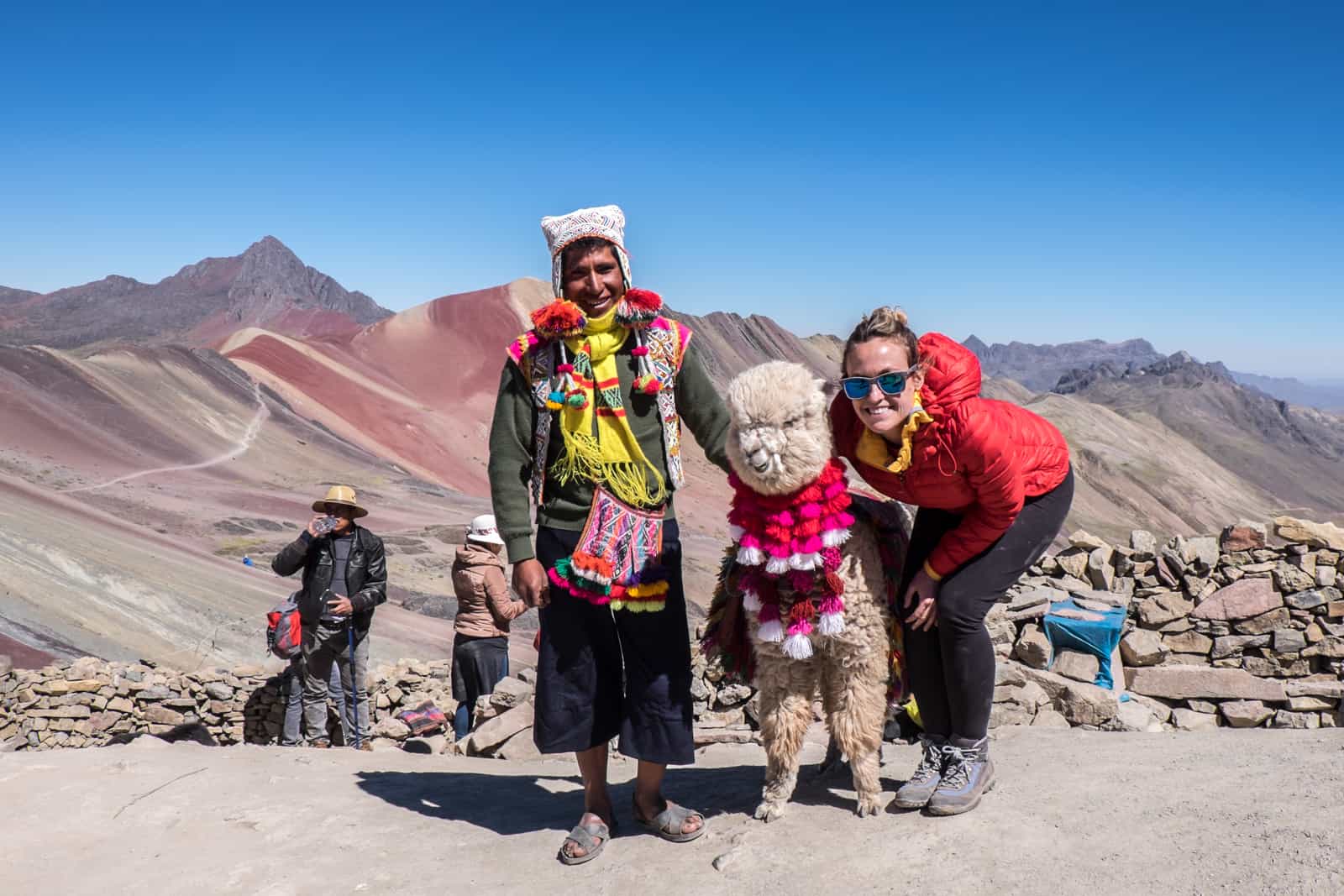
Wet vs. Dry Seasons in Peru
Wet vs. dry landscape in peru, do you need a visa for peru, ecuador to peru, bolivia to peru, use the peru hop bus – the best bus travel in peru, flights to peru and travelling to and from lima airport, travelling in the north of peru, flights in peru – travelling from lima to cusco / cusco to lima, colca canyon, puno and lake titicaca, cusco and the sacred valley, free walking tours in peru, booking day trips and experiences, where to stay in lima, where to stay in paracas, where to stay in huacachina / ica, where to stay in nazca / nasca, where to stay in arequipa, where to stay in puno, where to stay in cusco, search and book a hotel in peru, the inca trail to machu picchu, the salkantay trek, the lares trek , taking the train to machu picchu, laguna 69 trek, trekking to rainbow mountain and red valley, trek in colca canyon, solo or group travel tours in peru, ccaccaccollo women’s weaving co-op, parwa community restaurant, parque de la papa, nunay reimy restaurant in cusco, the inti runakunaq wasin youth drop-in centre in cusco, positive social impact projects in lima, using the peruvian soles, atms in peru, cost of transport in peru, cost of treks in peru, cost of accommodation in peru, cost of trips and tours in peru, cost of food and drink in peru, safety tips for peru and scams to avoid, is lima safe, the best food in peru, internet in peru, drugs in peru, when is the best time to visit peru.
The easiest way to determine when is the best time to travel to Peru is by breaking it down into the country’s wet and dry seasons:
- May to October / November is the dry season in Peru
- December to March / April is the rainy season in Peru
- April and November are typically considered the shoulder seasons in Peru, where anything goes as the seasons pass over
- February is the hottest month in Peru, and August is the coldest.
Peru is an adventure holiday capital. Therefore, considering the country’s diverse topography from desert to jungle, the weather outcome also depends on where you plan to visit in Peru and what activities you will be doing.
For example, it’s not a good idea to visit the jungle highland and mountain areas to the north and those around Cusco and the Sacred Valley during the rainy season, where there is a high possibility of trails and pathways even to Machu Picchu being closed. Lima, conversely, would be more accessible since it is situated on the desert coastline.
As the Tourism website states, Peru is “a country of open doors,” and for American and Western European countries, no visa is required for travel.
The citizens of the following countries do not require a Peru visa :
- North America: the United States, Canada, and Mexico.
- South America: All South American countries.
- Central America: All Central American countries except Costa Rica, Cuba, Dominican Republic, El Salvador, Guatemala, Haiti, Honduras, and Nicaragua.
- Europe: All countries within the European Union (EU) and Switzerland.
- Africa: South Africa.
- Middle East: Israel.
- Asia: Brunei, Indonesia, Japan, Laos, Malaysia, Philippines, Singapore, and Thailand.
- Oceania: Australia and New Zealand.
However, check your country’s consulate for up-to-date information and any changes before you embark on your Peru holidays.
You can check if you need a visa and how many days you get upon entry here .
Tourist entry to Peru is a single entry stamp at the airport or land border that grants you a maximum stay of 183 days. You need a passport valid for at least six months and with at least two free pages. The entry stamp cannot be extended once you are inside the country, and any overstay time can be met with a fine.
Travel to Peru from Neighbouring Countries Overland
A Peru trip is surrounded by travel temptation, with borders to Ecuador and Colombia in the north, Bolivia and Brazil in the east, and Chile to the South. That makes Peru a perfect starting point for onward travel or the ideal country to travel to, paired with a neighbour.
Entering Peru from neighbouring countries overland requires you to do some immigration legwork afterwards. Immigration authorities may not allow you to leave Peru without proof of a valid exit stamp from the last country you visited, and it is required by law to apply for an entry stamp once you are in Peru. That is if you didn’t get an entry stamp at the land border. You will need to show authorities various documentation of your travel journey.
Via Huaquillas (the most popular), Macará or La Balsa at Zumba . If you enter Peru overland from Ecuador, you will need to get your passport stamped with a Peruvian entry stamp at the local immigration office where you are staying.
If you enter Peru from Bolivia via Copacabana , make sure your passport is stamped with a Peruvian entry stamp at the immigration office in Desaguadero or Copacabana (near Puno, which is a known traveller hub).
What is the Best Way to Travel Around Peru?
A large country with a lot of ground to cover, it’s important for this Peru travel guide to cover the best, safest and most cost-effective way to get around. Through means I’ve tried and tested.
Furiously researching how I would travel from Lima to Cusco and see everything from the sand dunes, colonial cities and the manmade habitable lake islands in between, I mostly came across stories of dodgy local bus rides and rip-off taxi drivers.
Travelling within Peru is no longer difficult. In this research, I came across a great and relatively new bus service in Peru called Peru Hop, which gave me a pass to try out during my two-week journey from Lima to Cusco.
Peru Hop offers a multi-stop Flexi ticket in either direction between Lima and Cusco (and one that also takes you to La Paz, Bolivia), stopping at Paracas, Huacachina, Nazca, Arequipa and Puno in between. More than just a transport service, it acts as a flexible experience where you can tour Peru independently, adapting to your interests and itinerary. There are even extra, exclusive stops and Peru tours along the way.
It means having one ticket, one easy-to-use online booking system, maximum flexibility, and not dealing with rogue travel agents or the hassle of local bus stations. You can see the major cities and hotspots easily and safely (everyone who boards the bus has to have a valid seat booking, from which their passport details are logged) , be picked up and dropped off at your hostel, and have the help of an onboard local guide who speaks English and Spanish.
Tickets start from $159 (valid for one year); you can read my full Peru Hop review here .
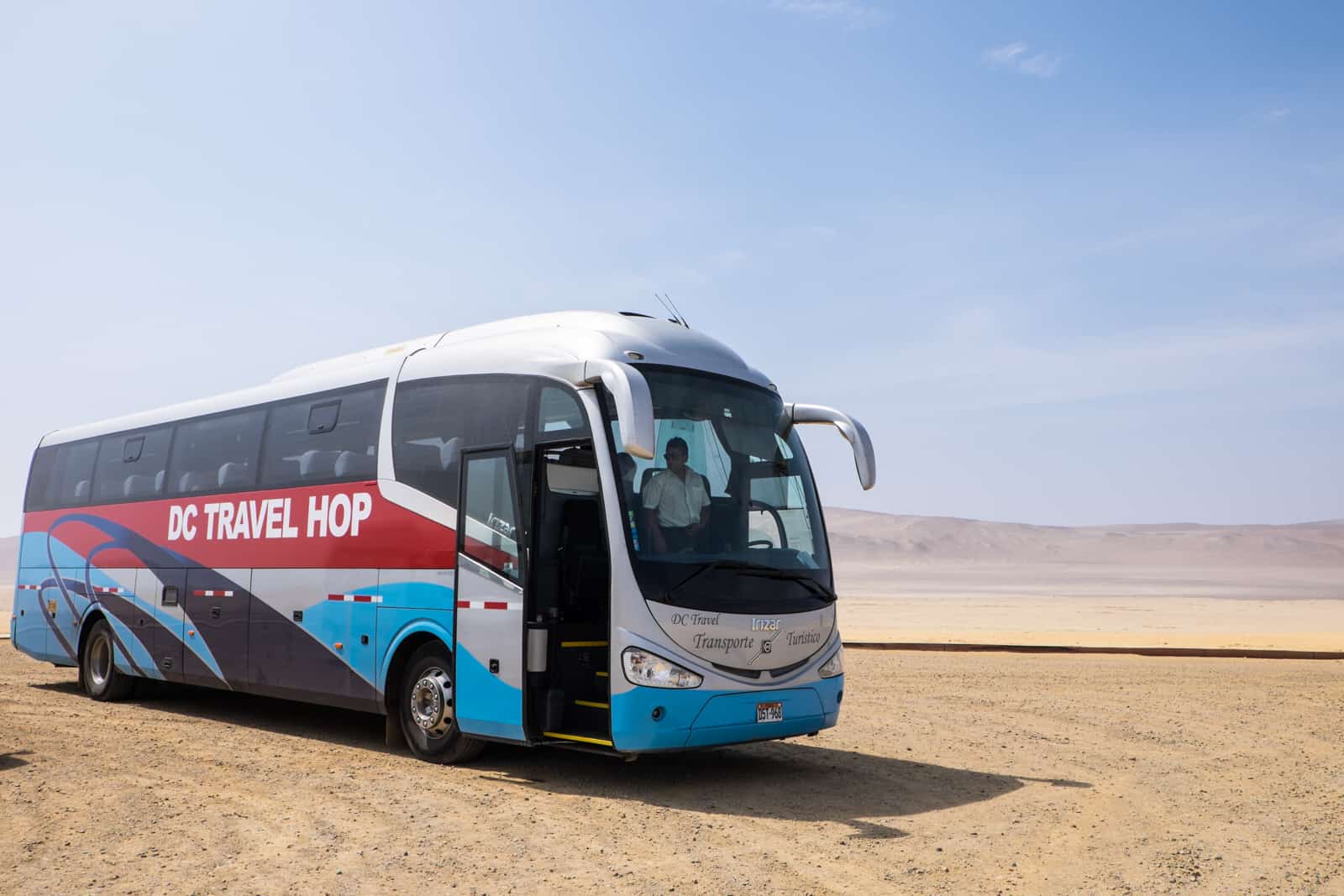
Buses are the easiest means of getting around Peru, with the Peru Hop service being great for accessible travel on the southern loop through major sites.
The best-priced flights to Peru usually get you to Lima, which becomes the main starting hub for the majority of travellers. The company behind Peru Hop also operates the Airport Express Lima bus that has multiple stops in the city centre.
You can book online or show up and hope for space. This is a cheaper option than the taxi pick-ups organised by many hostels, although I much preferred the organised taxi option late at night.
Peru Hop currently doesn’t offer any bus service in the north of the country, which is a shame and is a service I hope comes in time. Many travellers I met making their way to northern Peru for grand treks such as Laguna 69 used local buses (with many citing there were enough gringos riding them not to feel too sketchy and isolated).
You can book buses here via the Cruz Del Sur website .
If you want to travel from Lima to Cusco (or vice versa) without any stops in between, the easiest way is via an internal flight. Many use Lima as a cheap flight route from their home city to then fly to Machu Picchu, making it a more popular direction.
While you might find a good deal with Peruvian Airlines, I recommend Latam, which has a good safety record, is more of an established pan South American airline, has regular routes between cities, and isn’t too expensive. You can land a flight for around $60 if you get lucky.
Sightseeing Peru – Where to Visit
Typically on the first visit to Peru, travellers will visit the ‘southern loop’ between Lima and Cusco, with Cusco often the only or main stopping point because of getting to the Sacred Valley and Machu Picchu. This is a shame, as there are plenty of places to visit in Peru on this loop with great historical interest or famed natural landscapes.
Those with more time typically venture north for the famed Laguna 69 trekking route or do so on a second visit.
You will likely start in Peru’s capital because of the regular flight routes. Lima is a sprawling coastline metropolis, with much of its outer residential areas completely off-limits. Most visitors stay in the safer touristic neighbourhood of Miraflores, from which you can mix modern city hangouts with Inca ruins and beaches. Others stay in the bohemian area of Barranco, known for its artist and alternative scene.
Downtown Lima is accessible from both and is usually visited as part of a day trip. It’s largely sketchy beyond the small cluster of squares and streets where you’ll find grand buildings from cathedrals to Palaces around Plaza de Armas and colourful streets peppered with ornate wooden balconies as you wander between local cafes, restaurants and stores.
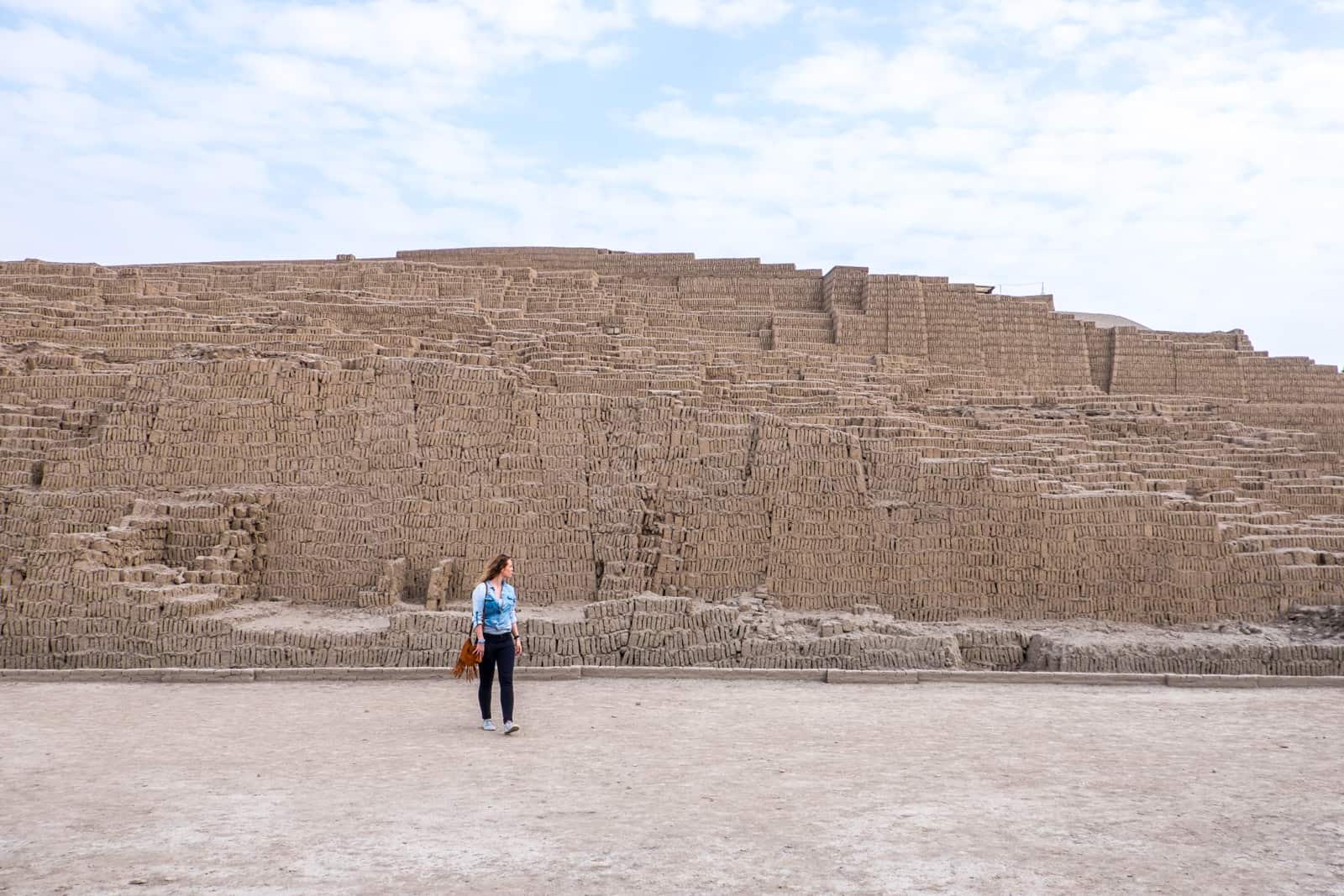
Huaca Pucllana Inca Ruins in Lima.
Coastal Paracas may not have much going on apart from its super chill vibes, but people come here to head out on a speedboat to visit the protected Ballestas Islands. Dubbed the “Poor Man´s Galapagos”, this is a chance to spend two hours spotting wildlife, including pelicans, penguins, birds and sleepy sea lions in the Paracas National Reserve.
The contrasting sweeping desert plains of Paracas National Park, marked by cliff drops and jagged rock formations, are also another highlight. However, there are plenty of nature-focused things to do if you decide to stay for a few lazy days.
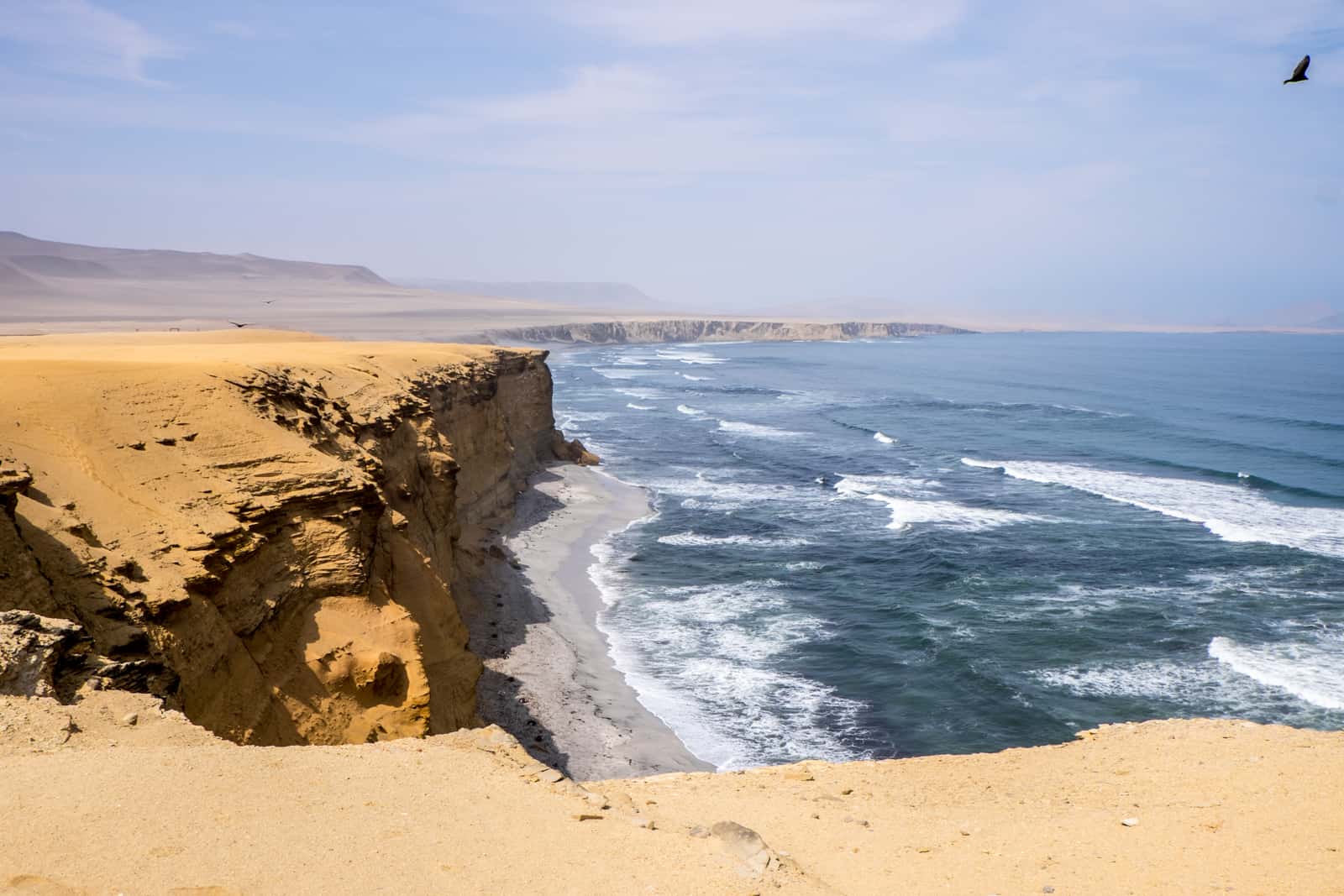
The coastline of Paracas National Reserve, Ballestas Islands, Peru.
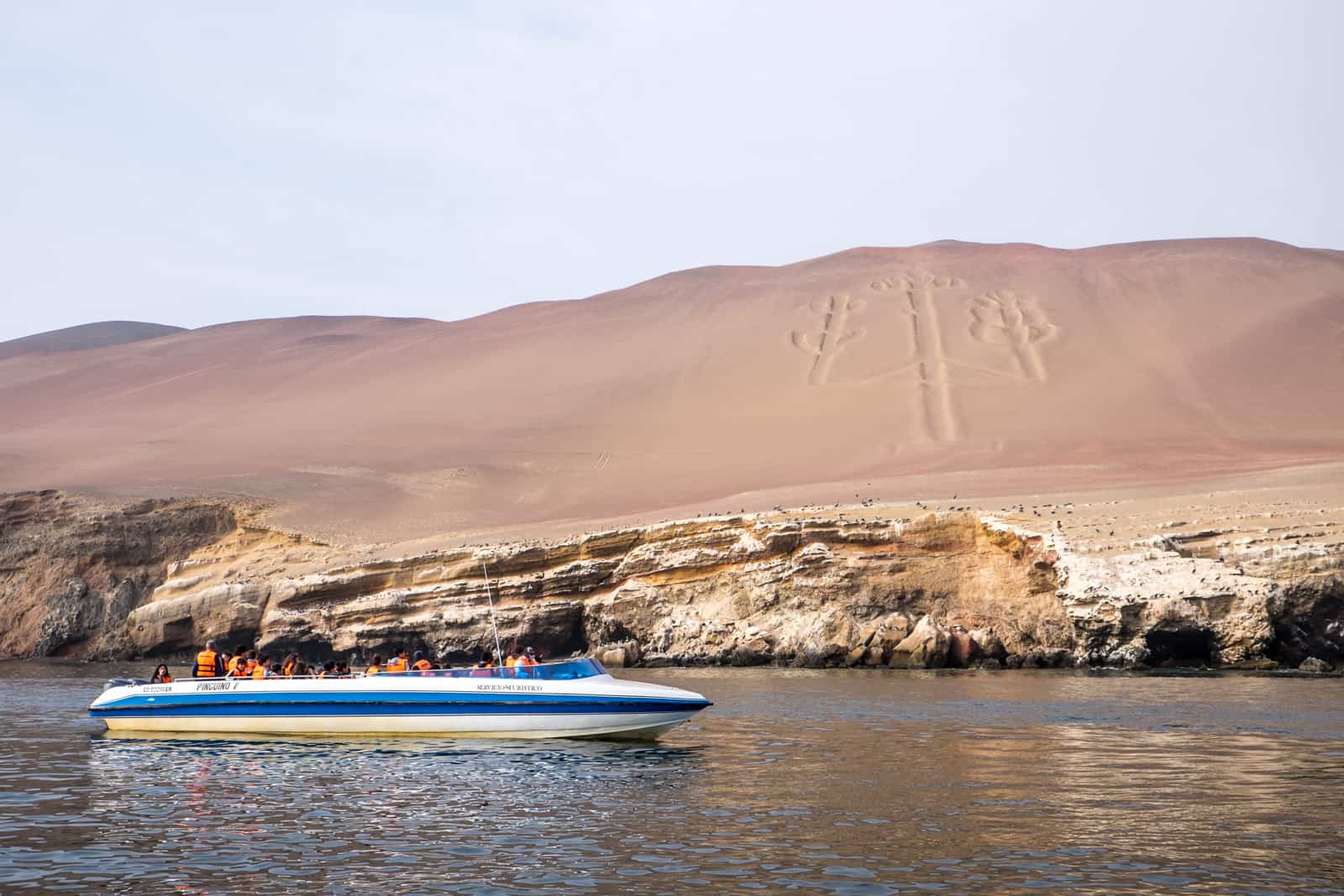
See the famed Paracas Candelabra geoglyph rock carving.
Huacachina is all about the mighty sand dunes. As soon as you arrive in this desert oasis town, you’ll realise it’s surrounded by a ring of golden mounds.
The best way to experience them is by strapping yourself into a sand buggy and enjoying a fast and bumpy nature coaster ride to some of the highest points and stomach-churning ploughs down. Alternatively, you can also learn how to Sandboard down, which is a real thrill ( beginner tips here ). Travellers also come here to indulge at the nearby Pisco vineyards.
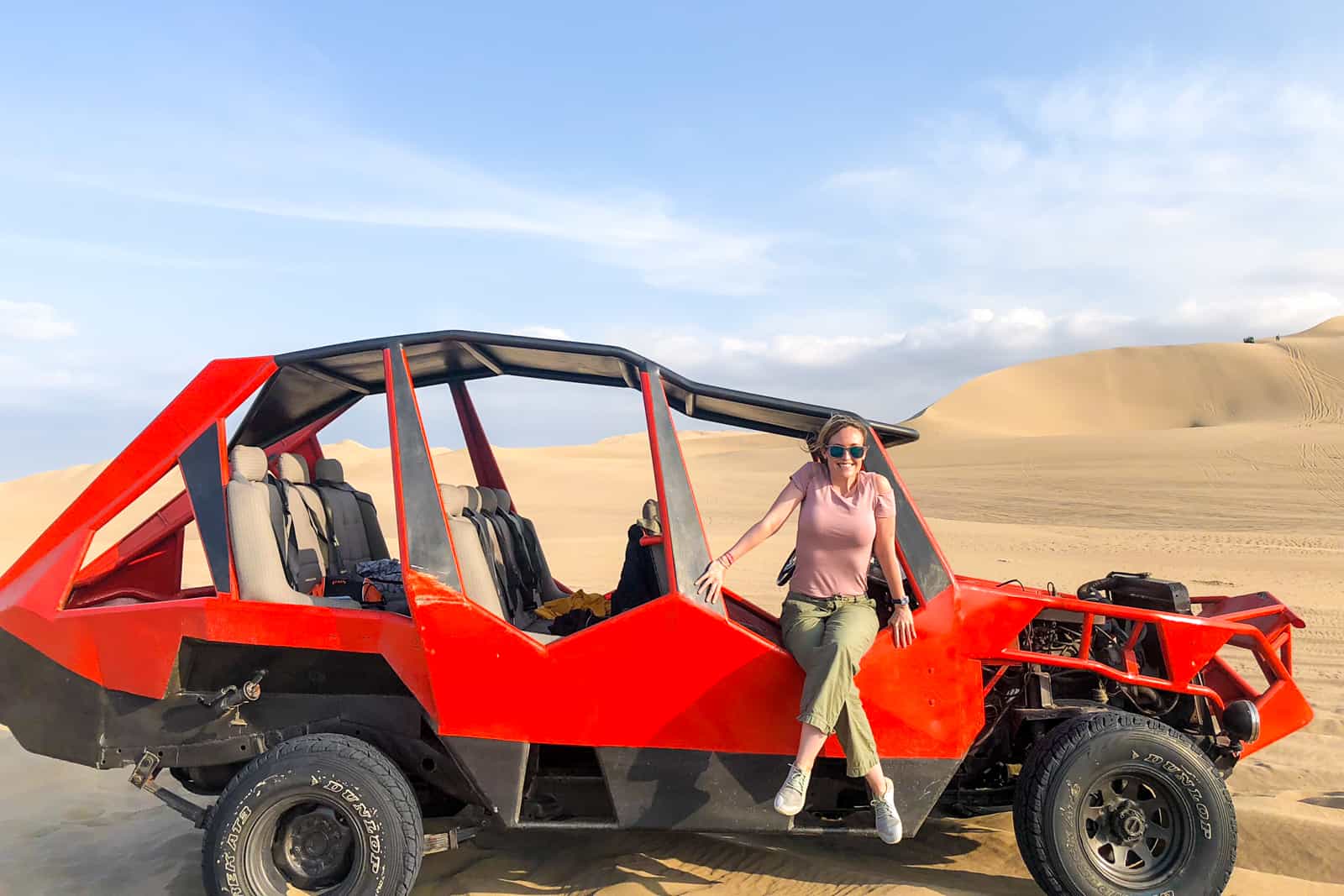
The sand buggy ride to the Huacachina sand dunes in Peru.
The 2,000-year-old geometric Nazca Lines are a world-famous site, despite the fact we still do not know exactly why these markings in the desert were created . This UNESCO world heritage site remains a mystery, and you can’t pass through without taking a look for yourself.
Three of the Nazca Lines can be viewed for free from a tower that is perched along the Trans American Highway. Still, the best way to see all the mysterious shapes and symbols is via a dizzying plane flight as you curve around the desert basin trying to spot the spider, condor, monkey, whale and astronaut.
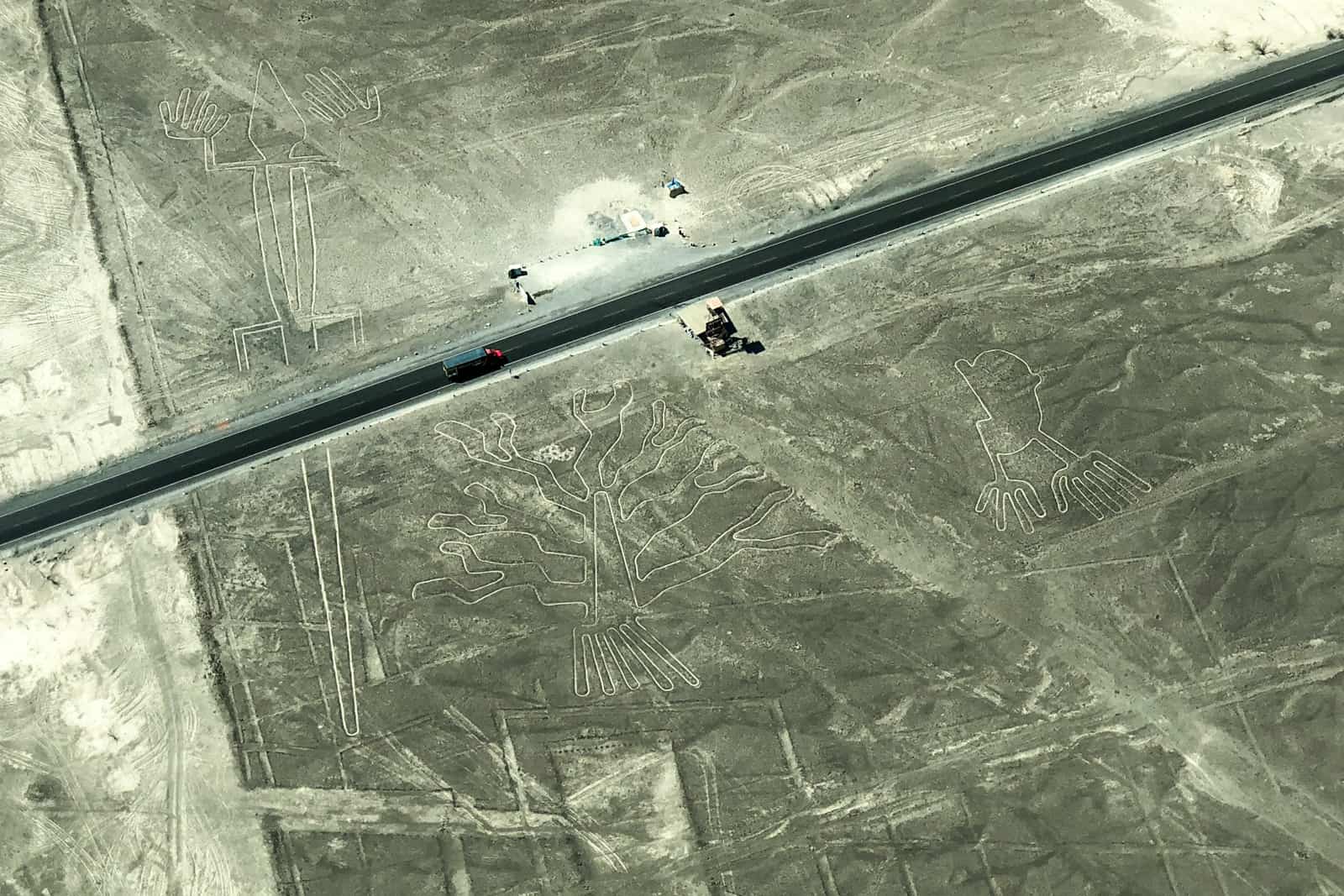
View from the plane shows a road cutting through some of the geoglyphs carved into the Nazca Desert. A viewing tower has been set up for those who do not want to fly over.
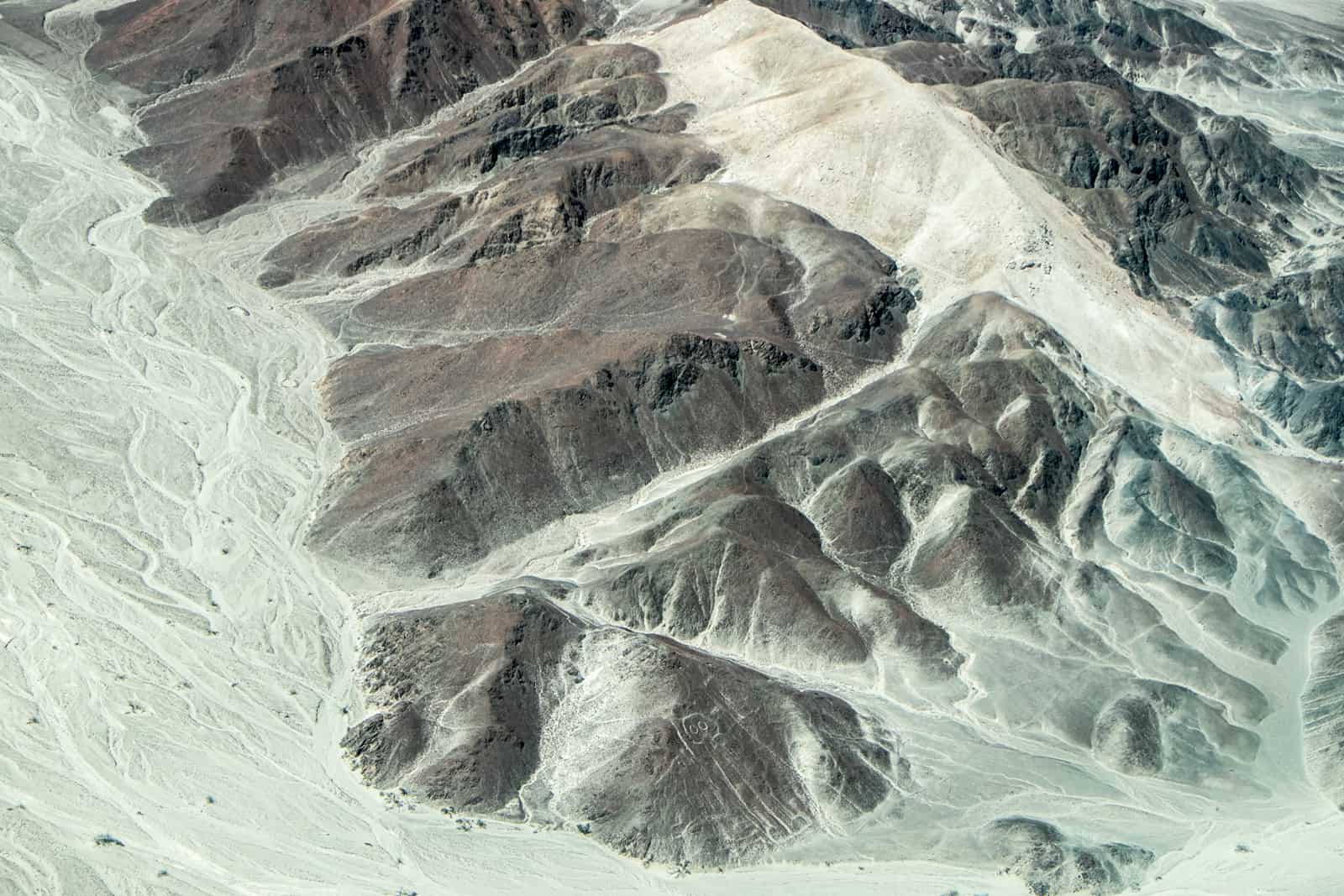
Can you spot the astronaut? It’s one of the famed desert soil-carved Nazca Lines in Peru.
Arequipa is a beautiful city decked in colonial architecture, with a panorama of mountain peaks, including the dominant Misti volcano. For a historical introduction and some hidden neighbourhoods and viewpoints, take the free walking tour offered daily.
A full day alone can be granted to the Santa Catalina Convent (Monasterio D Santa Catalina), dubbed “a city within a city.”
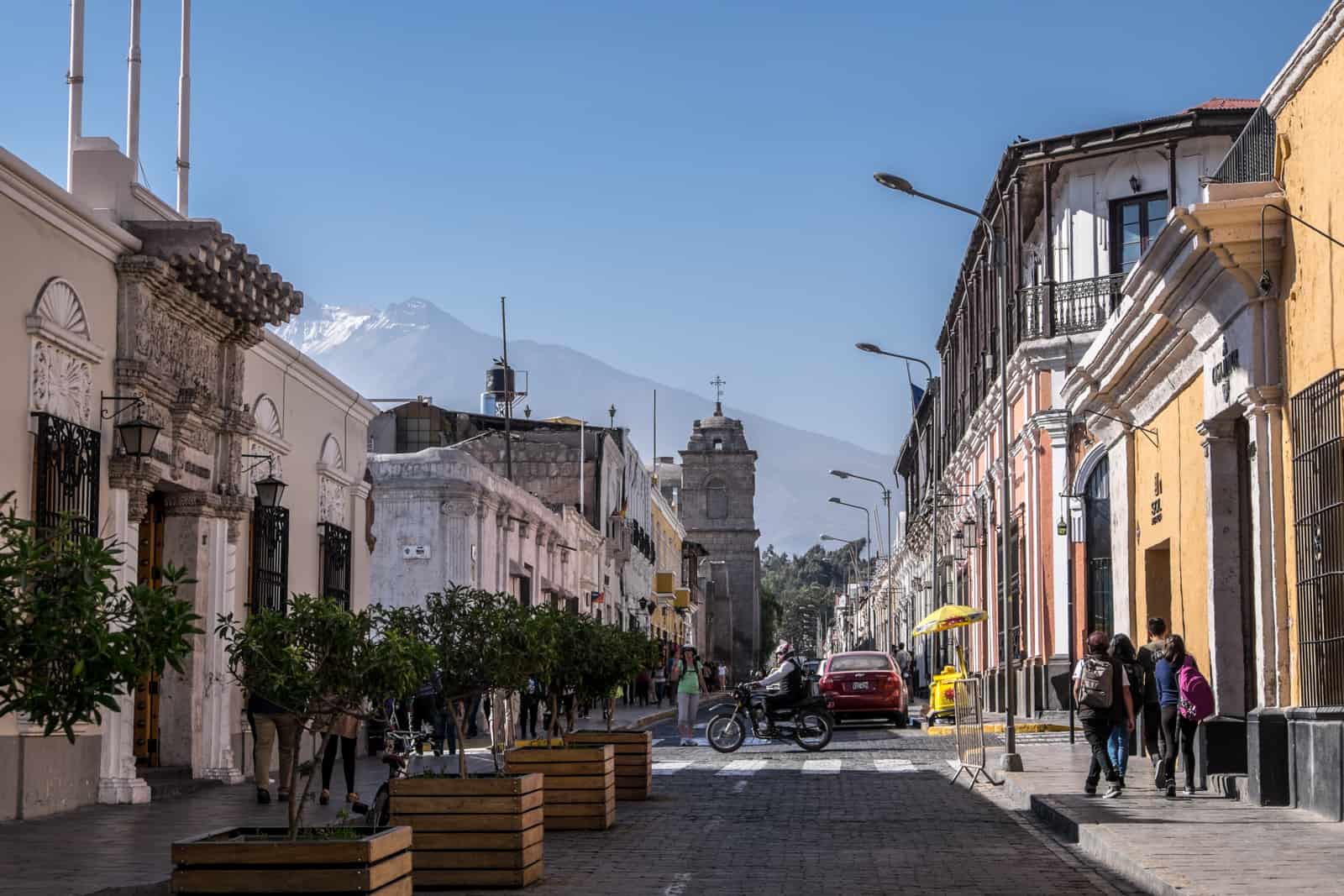
The Misti Volcano can be seen from the streets of Arequipa, Peru.
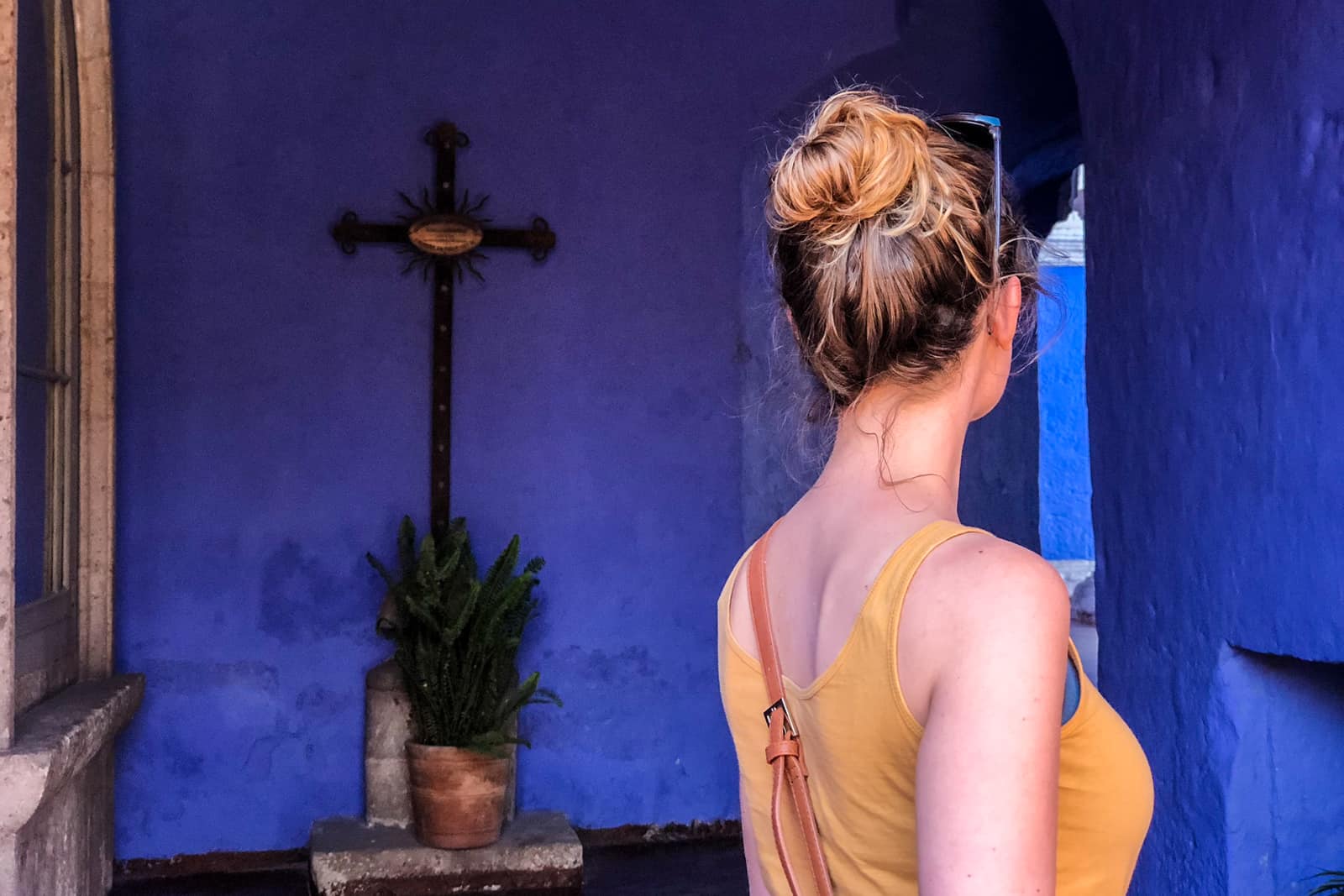
Visit the Santa Catalina Convent in Arequipa.
Four hours from Arequipa is Colca Canyon – the second deepest canyon in the world that is said to be twice as deep as the Grand Canyon.
Attracting everyone from day-trippers to hardened trekkers, not only can you view the Andean Condor birds in flight from above, as well as find majestic viewpoints to surrounding volcanoes, but also you can hike down into the Canyon, stay overnight in the oasis below and hike out at sunrise. It was a painful, but unforgettable landscape to experience.
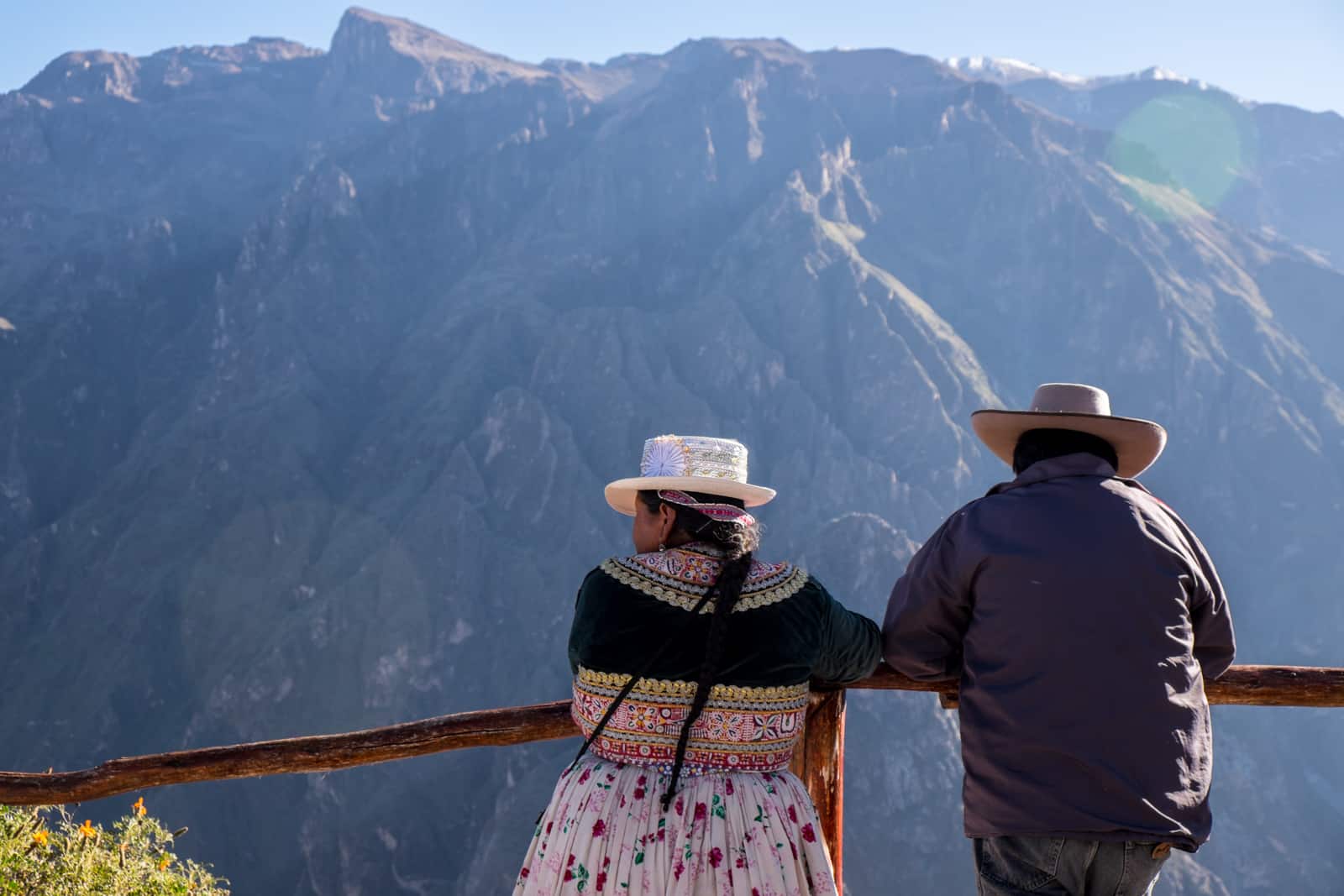
Join the locals visiting Colca Canyon on a day trip from Arequipa, Peru.
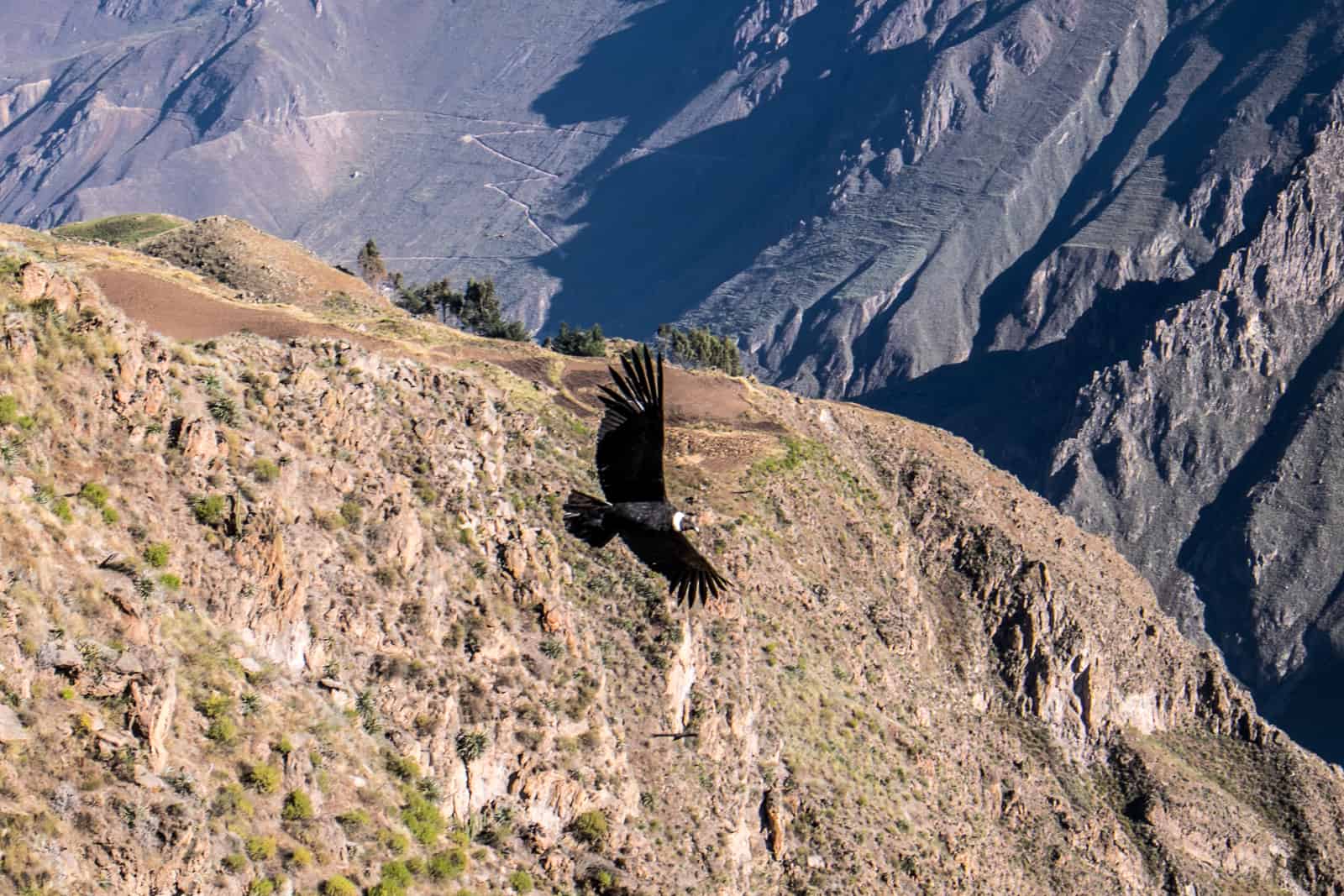
A condor in flight in the Colca Canyon – a highlight of a visit here.
Puno is famous for Lake Titicaca – the highest navigable lake on Earth at over 3,800 meters above sea level.
It’s here that people visit the man-made floating reed islands, with the chance to stay overnight with a local family on one of the remote islands a bit further out. I recommend this option if you have time, as I found the half-day and day tour trips set up only for tourists. Not to mention it has induced a culture of begging, even amongst the local children.
Others come to Puno, extending their lake visit as a means to also connect into Bolivia via Copacabana.
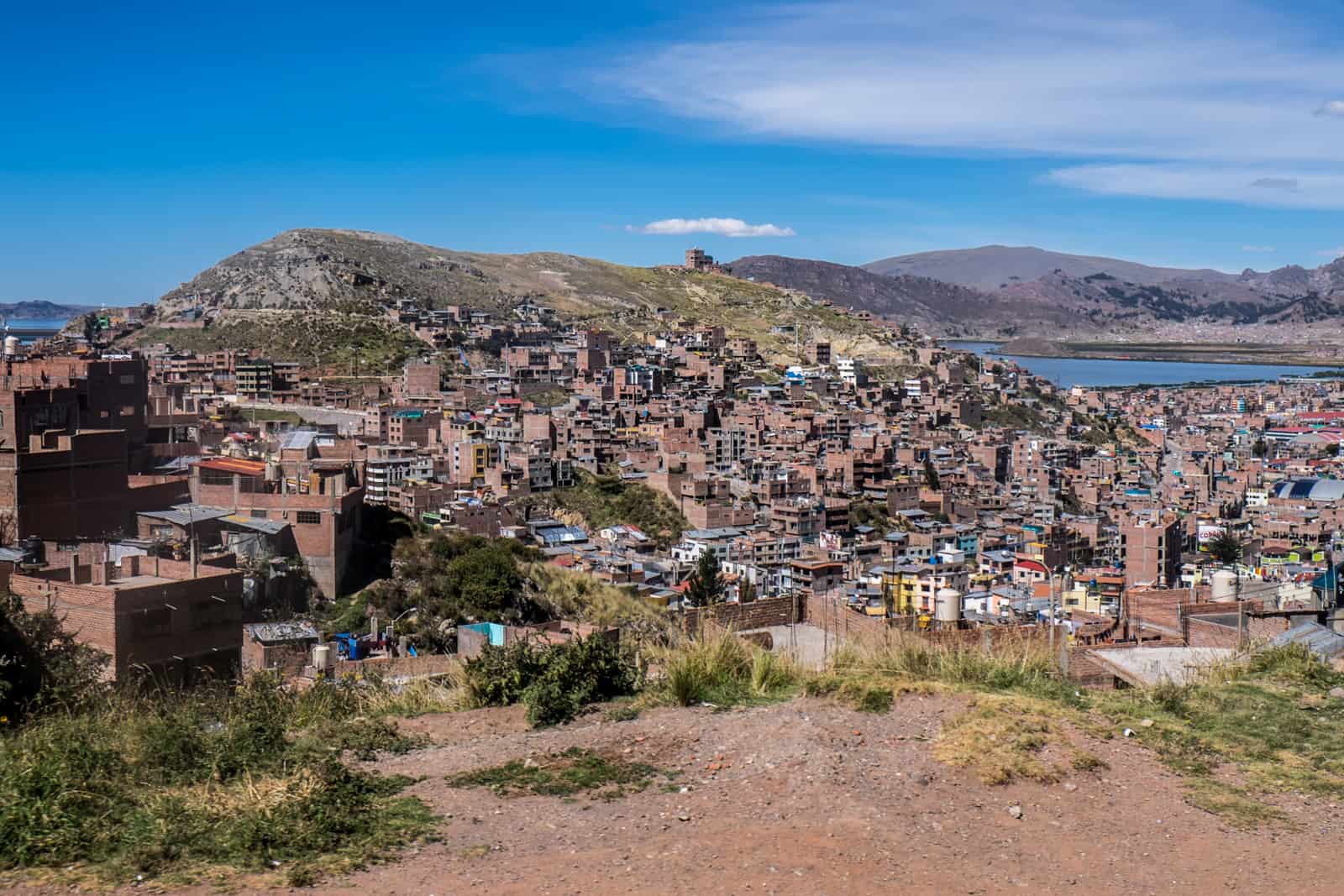
Visit Puno to see Lake Titicaca.
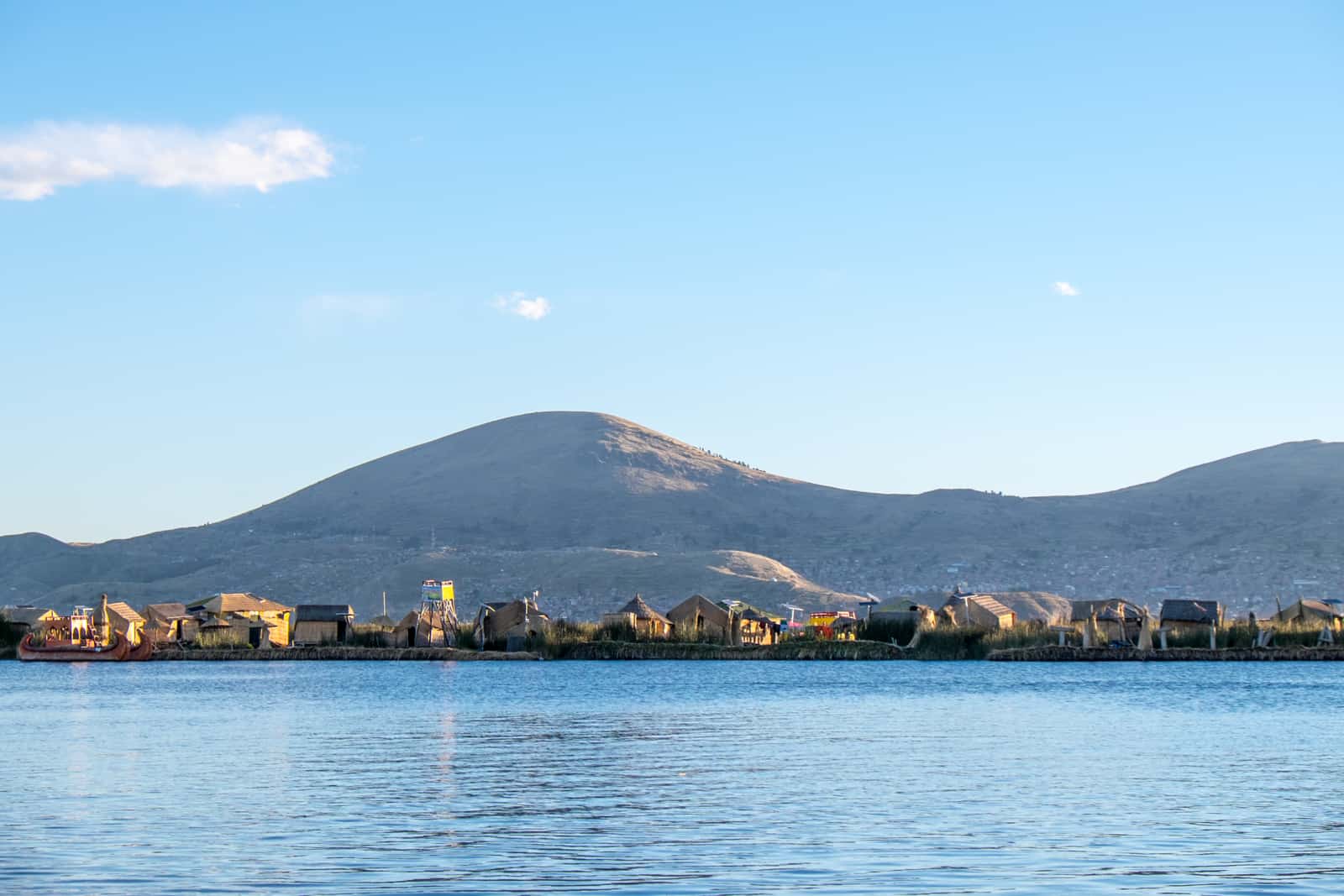
Travel to Peru and visit the unique reed houses on the floating islands on Lake Titicaca, Peru.
Cusco, once the capital of the Inca Empire, is, of course, the starting point for those on their way to the famed Machu Picchu – the grand highlight of any Peru trip.
However, there’s more to Cusco than a gateway for those making the pilgrimage to the ancient Inca Site. The centre of Cusco itself is full of sites, including Colonial architecture and stone walls and ruins of Inca days that line the steep cobble-stoned streets.
Fun tours in Cusco can be found in abundance if you want deeper historical and cultural insights. Hip coffee shops, vegan cafes and restaurants, independent design stores and funky hangouts define the city, especially in the bohemian San Blas neighbourhood.
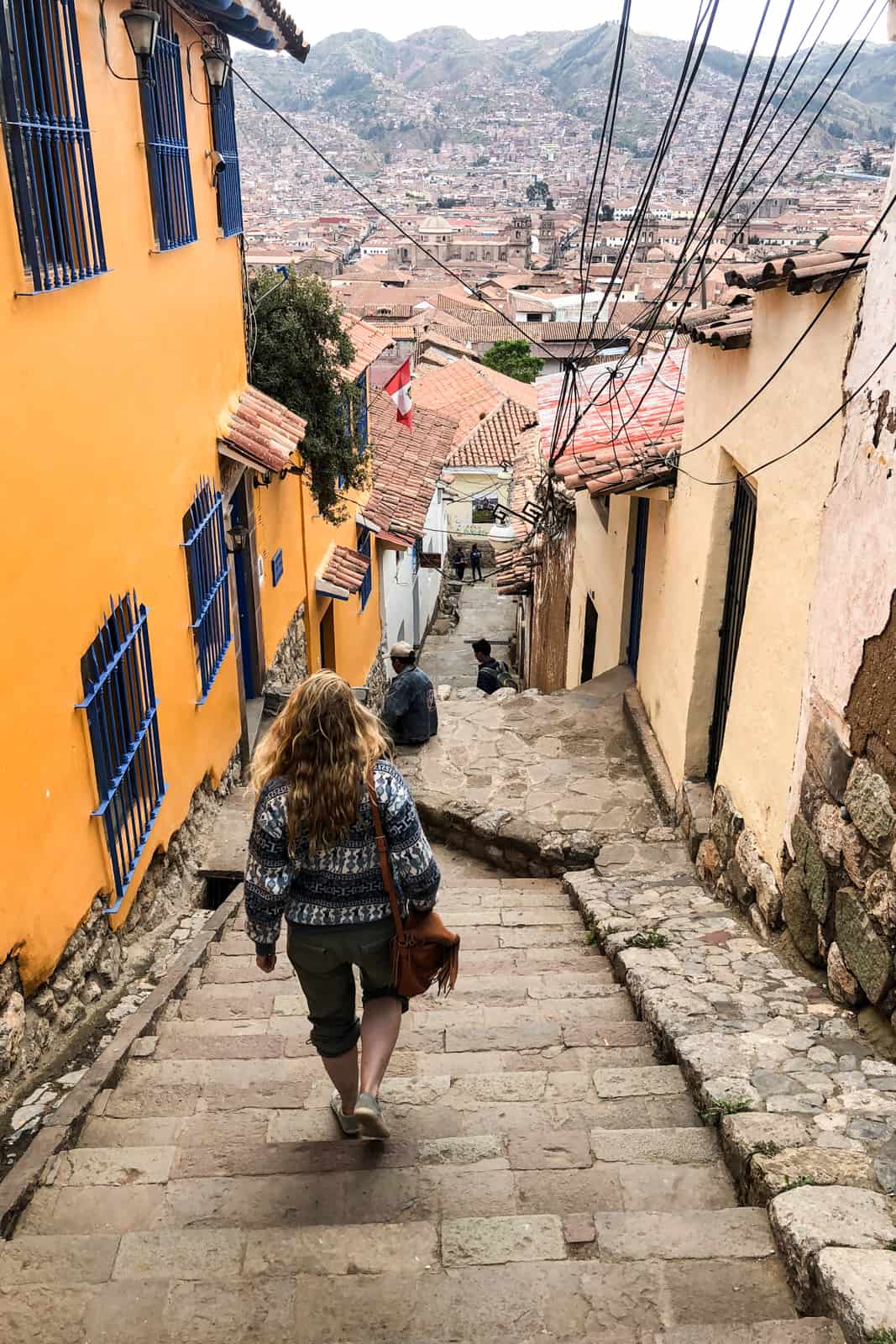
The high altitude cobbled streets of Cusco valley.
There are also a few key sites and treks that make for great day trips from Cusco, including.
The Salinas Salt Ponds are a terrace system of evaporated salt ponds a short drive from the town of Maras, located around one hour outside of Cusco. A man-made layered landscape in the Sacred Valley, these salt basins have been in use since the days of the Incas, with a section now open to the public to marvel at.
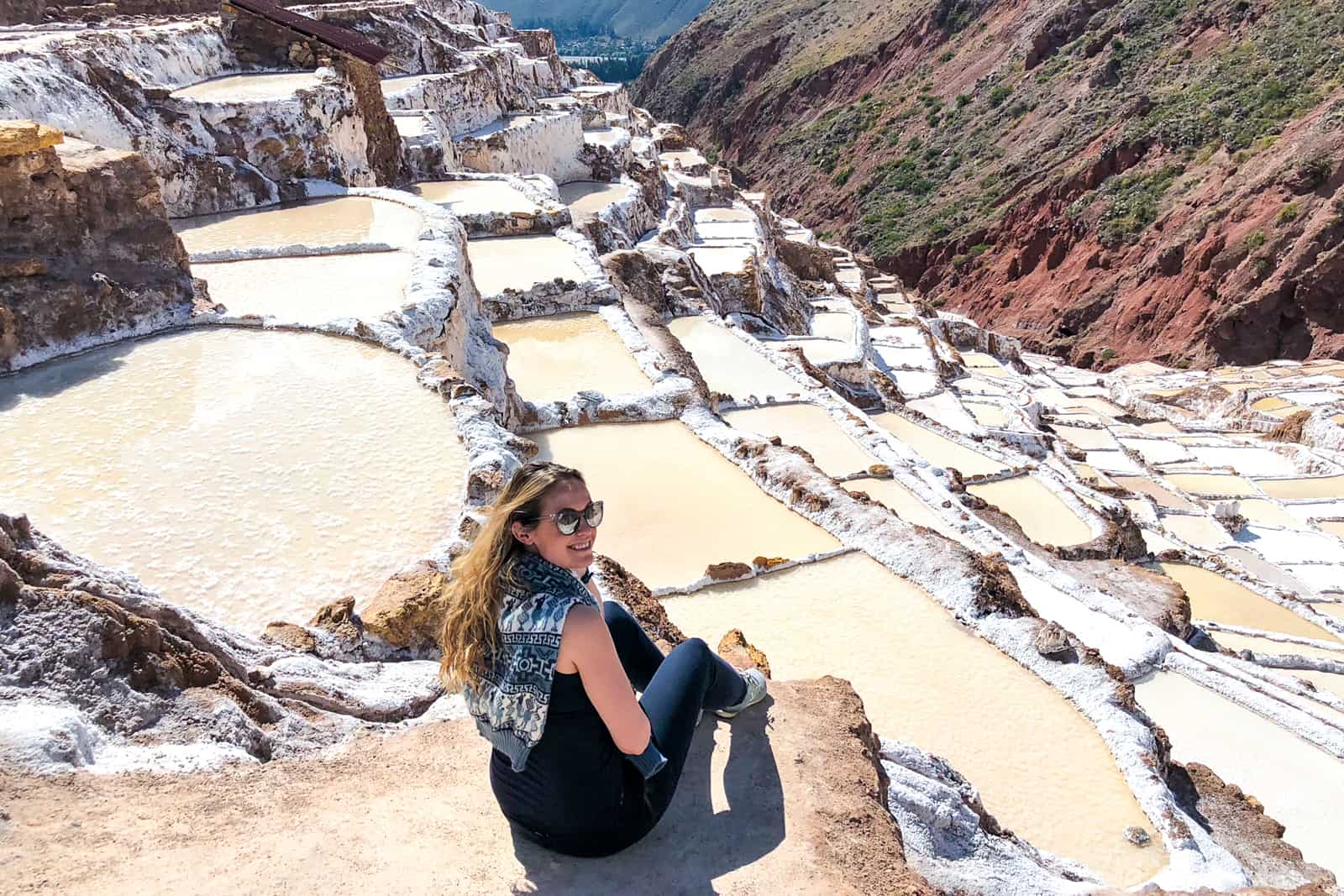
One of Peru’s best places to visit is the Salinas Salt Ponds in the Sacred Valley, Cusco.
Moray is an archaeological site of ringed Inca ruins in a remote area near Maras (and easily combined with Salinas). Defined by its circular terraces at a plateau of 3,500 metres, it is believed this was used for agricultural research, with the different terrace levels having unique microclimates.
Sacsayhuaman is a hilltop Inca citadel that sits on the northern fringes of Cusco and is said to be a fortress overlooking the city. It is known for its huge dry stones that fit together in the same way as those on the old Inca walls in Cusco – without any mortar or filling such as soil or clay.
Things to Do in Peru – Further Suggestions
In Lima, Cusco and Arequipa, I used free walking tours (payment based only on tips). I used the company Free Walking Tour Peru in both Lima (for Downtown Lima and Barranco walking tours) and Cusco (for an orientation and history walk) and highly recommend them both for cultural and historical insights, as well as a good balance of fun.
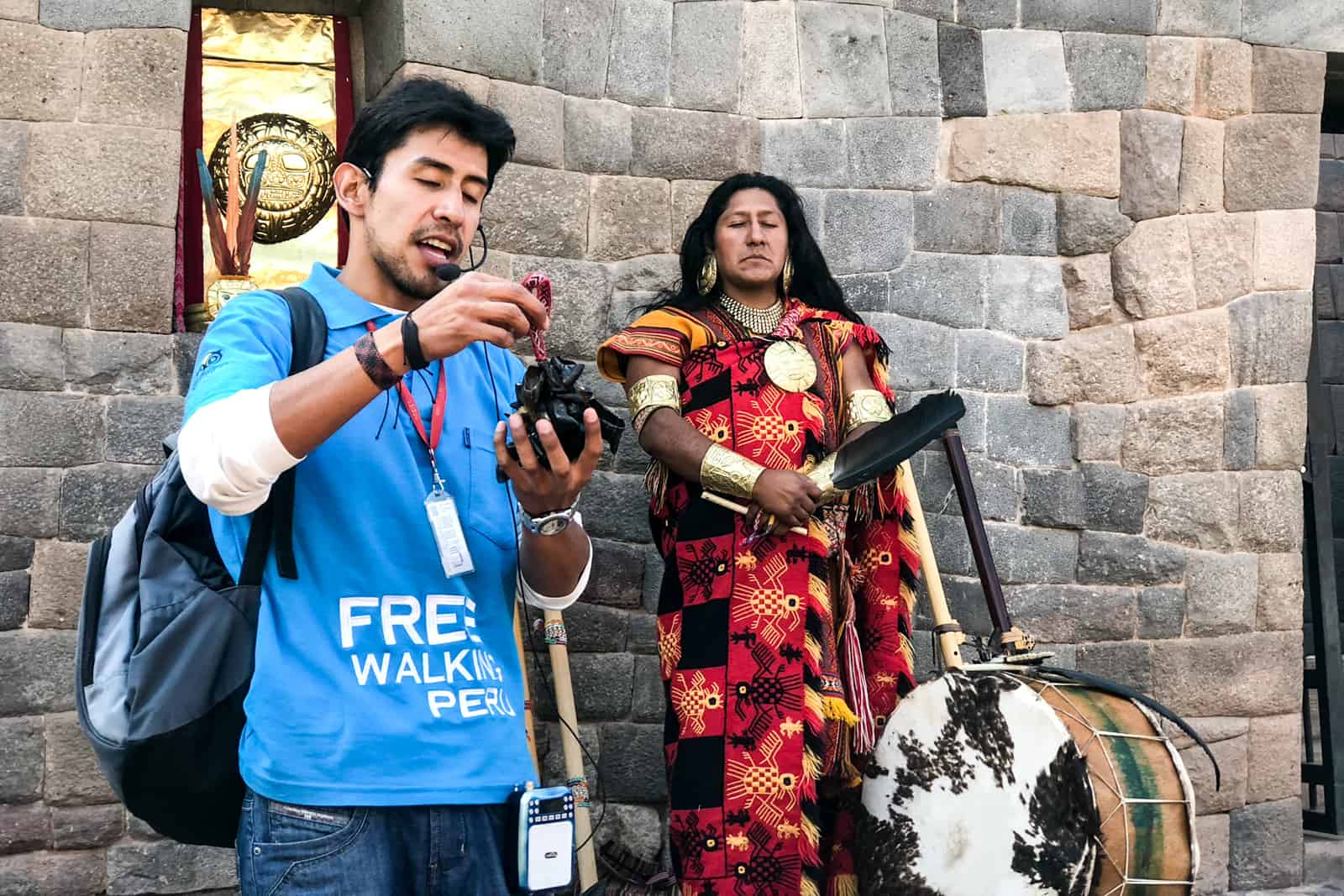
Go on a free walking tour in Cusco for orientation and an introduction to Inca history and culture.
Most hotels and hostels offer ideas and services for excursions and experiences. Many are packed full of maps and leaflets detailing local companies. Others offer their own, like cooking classes and Spanish lessons. When booking day trips or short excursions, I used Find Local Trips, one of South America’s largest and most trusted tour booking platforms and GetYourGuide
Where to Stay in Peru
I lived it up in a luxury hotel and stayed in a dorm and private room at a hostel. There’s a mix of everything in the city to suit all budgets and preferences of atmosphere from quiet to party.
- Casa Andina Premium – Beautiful boutique-style hotel on a quiet street just a few blocks from Parque Kennedy.
- Pariwana Hostel – One of the hostels you hear about on the grapevine. Close to the beach and complete with terrace and bar, table tennis table and continental breakfast.
- Alpes Lima – I stayed in both their dorm room property (home to the rooftop bar) and their second property two blocks away that has private rooms and a quieter environment.
- Pool Paradise Lima – The only hostel in Miraflores with an outdoor pool.
- The Point – For those wanting to hang out in the arty, hip neighbourhood of Barranco.
- Paracas Backpackers House – More chilled, family-run hostel just a five-minute walk to the coastline.
- Kokopelli Backpackers – More of a party hostel, with its own pool and lively bar.
- Banana’s Adventure Hostel – New, funky, modern touches and great atmosphere. The place I wish I had stayed after finding it.
- Casa de Arenas – The biggest hostel in this tiny town, complete with bar and pool but is a little worn and the staff attitude isn’t very welcoming.
- Le Casa de Bamboo – The quiet traveller’s option, complete with a small bar.
Not many people stay overnight in Nazca. Instead, they pass through on the way to Arequipa. For those wanting to chill here and break up the journey, the following places were recommended.
- Nazca Travel One – Central, family-run establishment.
- Hotel Alegria – Considered one of the best hotels in this area, and the bonus is it has a pool.
- Casa de Avila – I adored this cosy, quiet 3-star hotel and treated myself to four nights here (at only $40 a night) to get some proper rest pre and post-Colca Canyon trek. It’s less than a 10-minute walk to the very centre and the Plaza de Armas. You can also take a Peruvian cooking class here.
- Wild Rover – The party hostel with a pool. Part of the Irish hostel chain in Peru.
- Flying Dog – The quieter, chilled out hostel with lounge areas and easy access to the centre of the city.
- Suites Independencia – We left our bags here as we explored on day trips before catching the night bus, but a friend stayed overnight so I got to see the rooms. Basic, spacious room right in the very centre of town.
- Pacha Suites is also a centrally based accommodation and was a mid-range option that was recommended.
- Staying with a local family found on Airbnb was an option fellow travellers recommended me for those wanting a proper homestay experience on Lake Titicaca.
- Casa del Carmen – A family-run, quiet, cosy residence located in the cool arty district of San Blas. Carmen is very motherly and always on hand to help, although the only downside is you may be asked to move around if you are there for many days as there doesn’t seem to be a set system in place for the rooms. But for $25 for a private room in central Cusco, I wasn’t going to complain too much.
- Wild Rover – The party hostel option in Cusco for revelling travellers.
- The popular Kokopelli Backpackers chain in Peru also has a base in Cusco. It’s right on the main square, although it can be pricey.
The Best Way to Visit Machu Picchu and the Sacred Valley
Getting to Machu Picchu is undoubtedly the highlight of Peru, and figuring out the best treks and Machu Picchu tours and days trips is the eternal question in planning.

Trek through the mountains of the Sacred Valley to reach Machu Picchu.
Machu Picchu Treks
The most popular of all, this four-day trek takes you through various communities and the ancient Incan ruins of the Sacred Valley, set within stunning Andean scenery. The final day marks the start of a pre-dawn to reach the Sun Gate before sunrise as you enter the magnificent Machu Picchu.
A lifeline of Peru tourism, it is important to visit Machu Picchu as responsibly and ethically as possible.
G Adventures Inca Trail Tours – Awarded the best operator for the Inca Trail route.
Inca Trail 4-Day Trek – A highly rated trek on GetYourGuide with a local operator.
Huayna Picchu Hike — This entry ticket grants access to the 2,693 m peak, which offers elevated views over Machu Picchu’s Inca citadel. Only 400 people per day are allowed to visit Huayna Picchu, so book ahead.
Dubbed an alternative trek to the Inca Trail, this route crosses the Salkantay Pass at 4600m, following a trail descending into cloud forest. The final point of the hike is to the Inca site of Llactapata, where you get the first look at Machu Picchu from a distance.
See Salkantay trek dates and book here .
This three-day hike through the mountains of the Sacred Valley is more about the untouched natural scenery than Inca ruins, reaching highs of 4800m. The scenic train journey from Ollayntambo to Aguas Calientes completes your trip to Machu Picchu.
See Lares trek dates and book here .
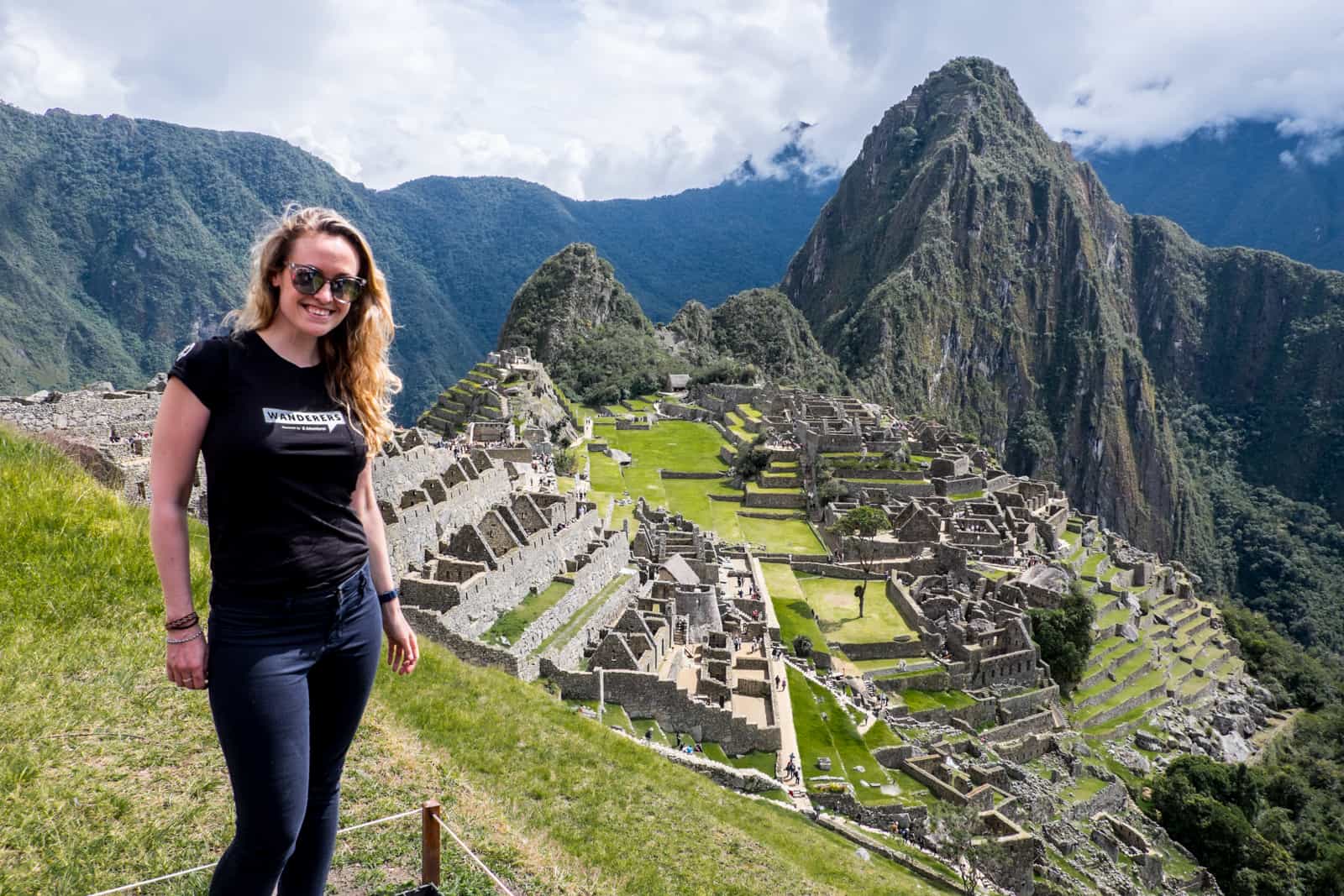
There are plenty of ways to get to Machu Picchu – which will you choose?
For those who do not embark on the Machu Picchu trek that leads you directly to the site by foot, the train is part of the final journey to this ancient Inca citadel, 2430m above sea level.
A train is also a great option for those who do not wish to trek or who cannot fit time for a trek into their Peru itinerary. It means everyone gets a chance to view Peru’s most renowned pilgrimage site, which remains a mystery as to why it was built.
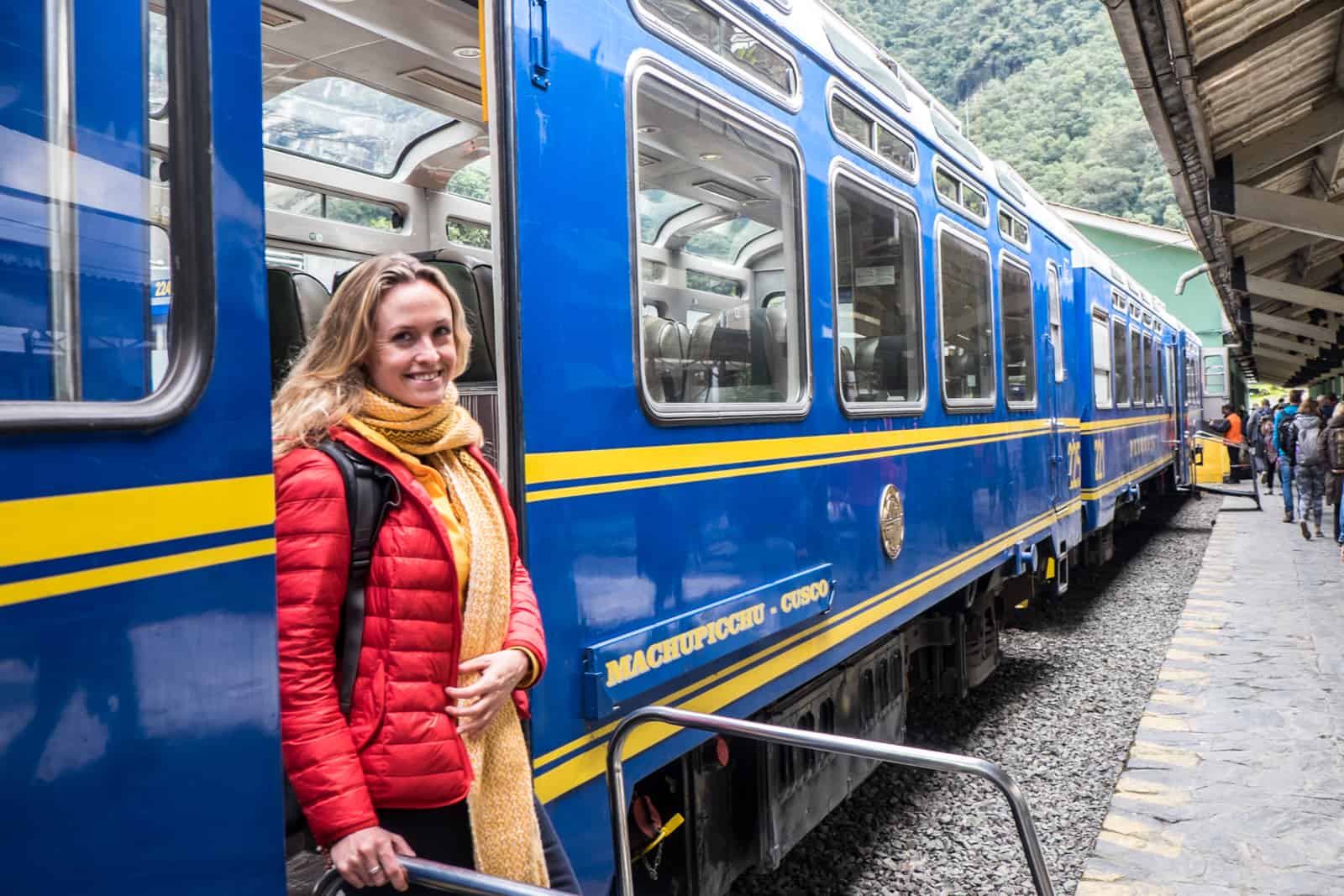
The Peru Rail train to Machu Picchu.
The Peru Rail trains depart from either Porary or Ollantaytambo station, located in the Sacred Valley. It’s an incredibly scenic three-hour and 50-minute or one-hour and 50-minute journey to the station of Aguas Calientes.
From here, you catch a bus up the winding valley to the entrance to the Machu Picchu site. It is advised to book your bus ticket in advance to avoid the long queues.
Permits are only needed for the Inca Trail and not for entrance tickets to Machu Picchu . However, your entrance tickets need to be booked in advance, alongside your train ticket. You must bring your passport – it is checked both at the Machu Picchu entrance and when you board the train.
Tours of Machu Picchu with a registered guide are highly recommended for those who want detailed insight into each aspect of its design and the history of the Inca people.
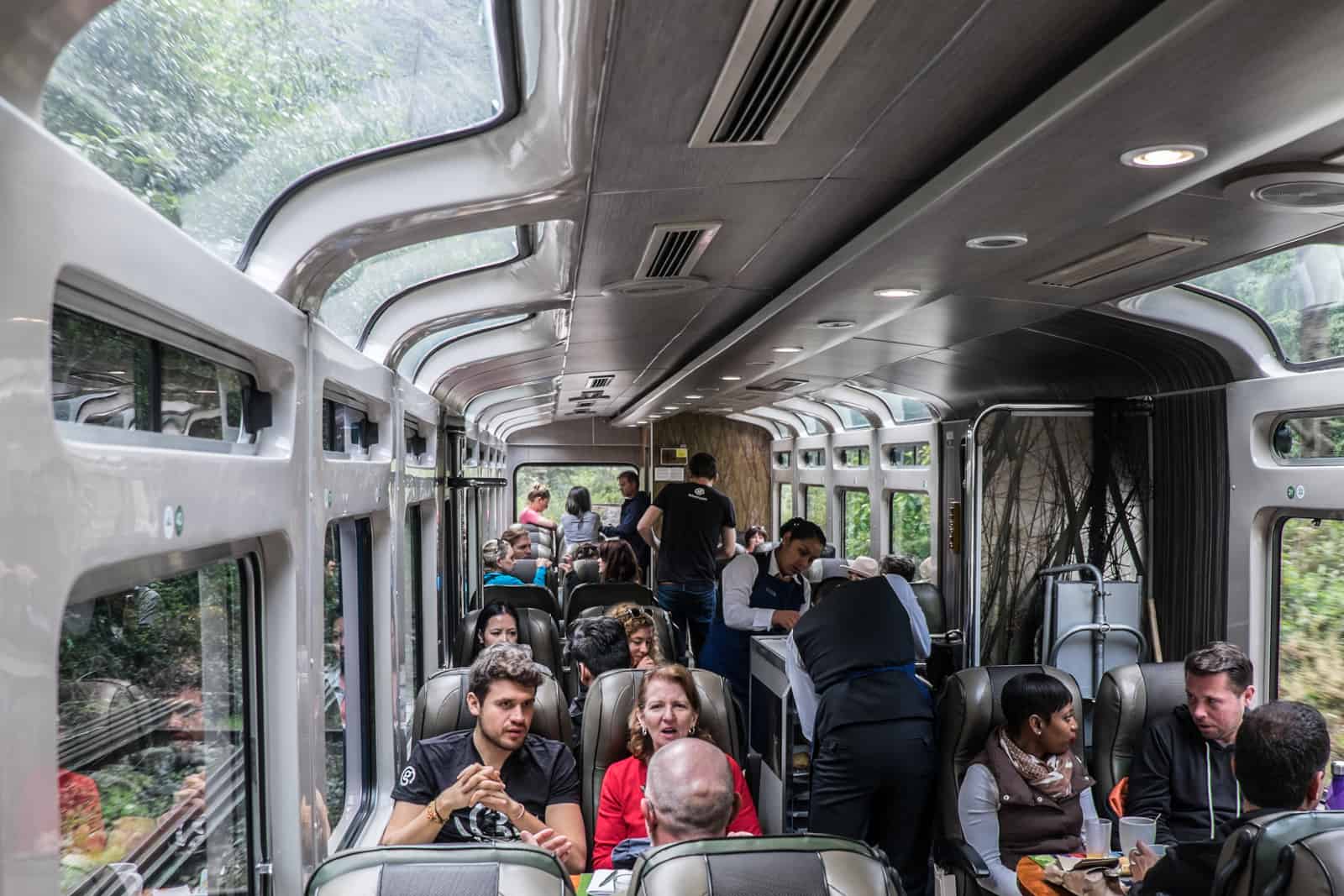
One of the most beautiful train journeys you can take.
Peru Rail Ticket to Aguas Calientes (one way): $50 – $70+
Book Here direct at Peru Rail
Bus Ticket: $12 one way / $24 return
Book Here via the Machu Picchu ticket service or order a pre-booked round-trip bus ticket here .
Machu Picchu entrance ticket: €38 / $46 (152 Peruvian Soles)
Trekking in Peru
Aside from the Machu Picchu treks, Peru has a variety of stunning trekking options tempting the explorer, whether that’s day trips from Cusco, canyons in the south or more technical lagoon hikes in the north.
This super scenic trek is located in Huascaran National Park – a two-hour bus journey from Huaraz (nine hours northeast of Lima), which travellers use as a base for this expedition. Forest tracks, snow-capped mountains and steep rocky pathways lead to the magnificent turquoise mountain lagoon at 4500m. This can be completed in one day, but more adventurous souls choose multi-day trekking routes to cover more ground in the region.
Rainbow Mountain has become a very popular trek in recent years after the site was discovered when snow on the mountains melted to reveal the incredible lines of colour, giving the Vinicunca mountain (also called Montaña de Siete Colores – Mountain of seven colours) its name.
A hard day trek, which peaks at 5,000 metres above sea level, the struggle of the altitude is worth it for the unique view at the end. Get yourself on a Rainbow Mountain trek with a very early start to avoid the crowds (we left Cusco at 3 am), and look for a trek that takes in the Red Valley on the way back. *Article coming soon*
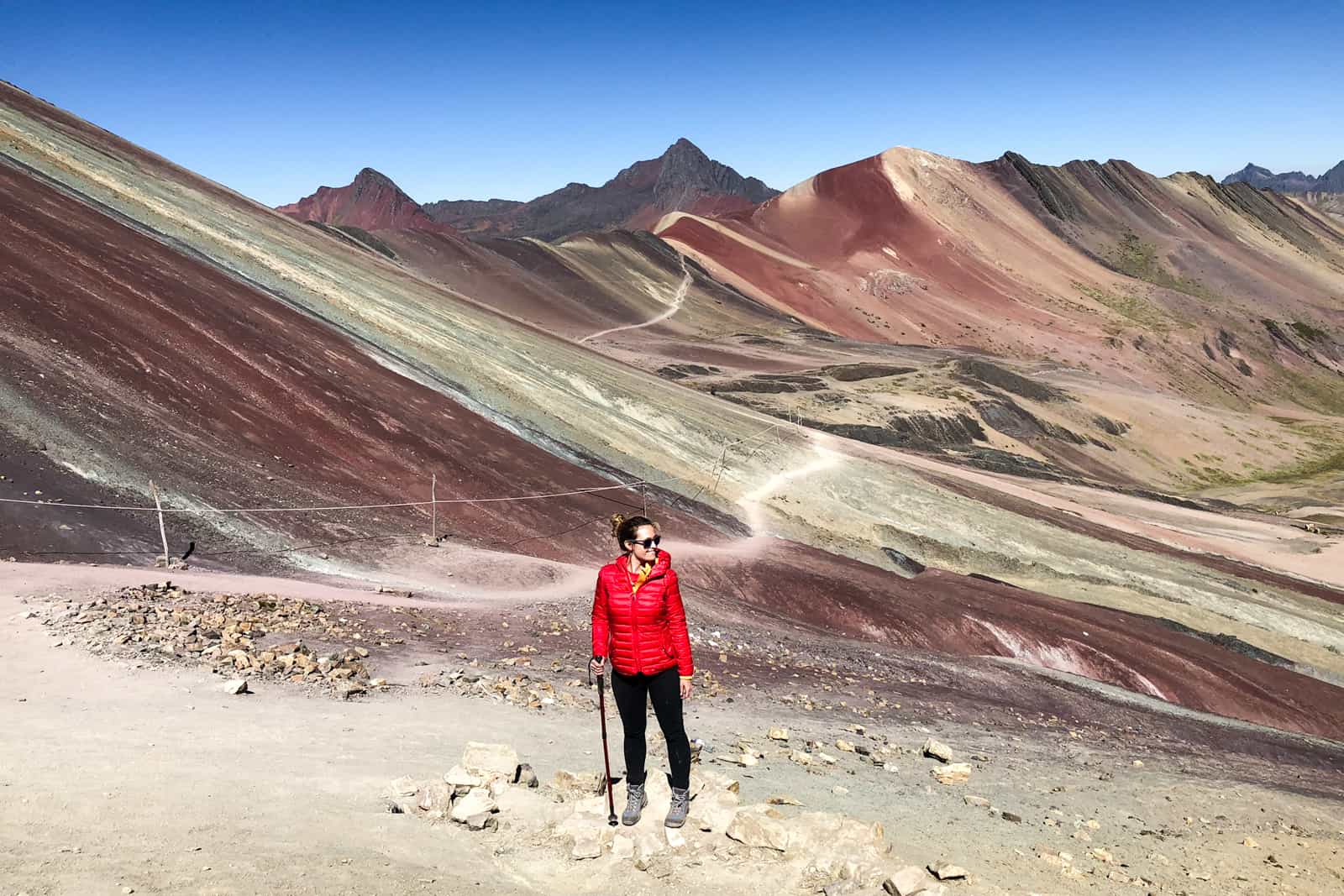
The views you reach when trekking Rainbow Mountain in Peru.
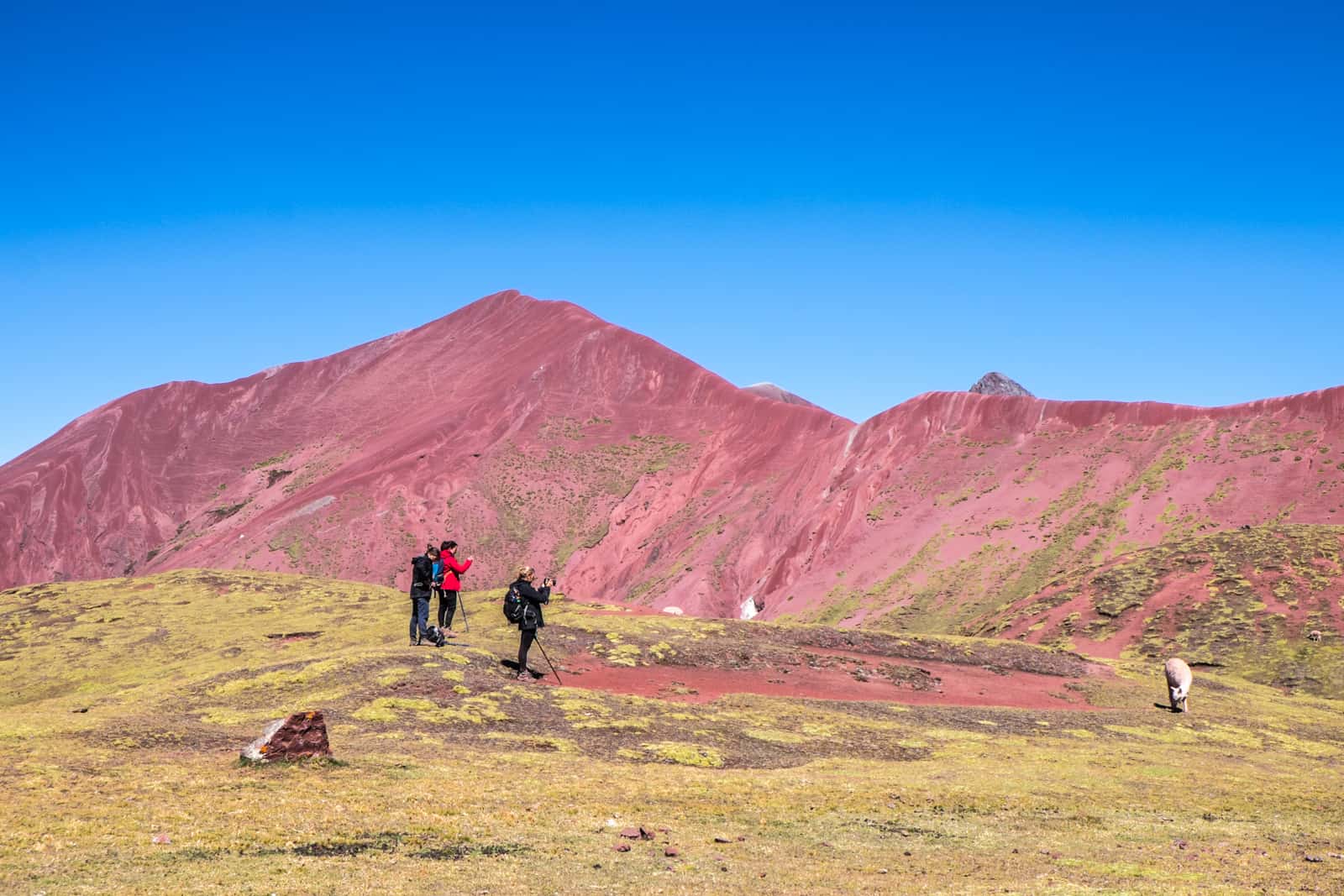
Trekking in the Red Valley on the way back from Rainbow Mountain.
And don’t believe those who say it’s a secret they wish they had kept. Over 1,000 people from the local community are employed, including over 200 people renting the horses. That’s a lot of community regeneration and a community thanking us over and over for sharing this wonderful site.
Trekking in Colca Canyon is no easy feat, yet it is just as much an accolade as it is a chance to be embedded in some of the most incredible scenery in Peru. Why? It’s the second biggest and second deepest canyon in the world.
I chose the two-day trekking option to get more immersed in the canyon landscape and national park, located four hours drive from Arequipa.
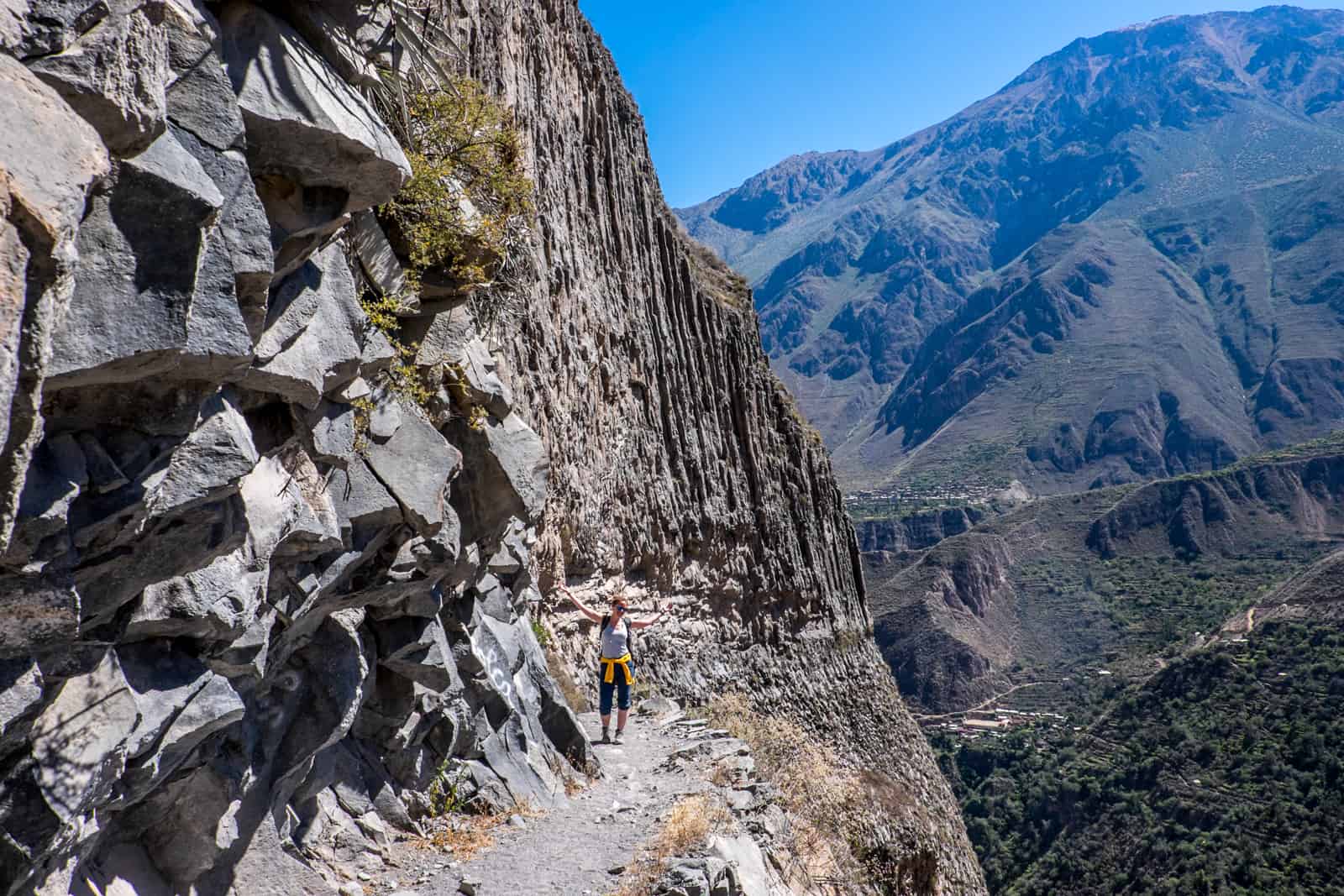
The start of the two-day Colca Canyon trek.
This trekking route also included short stops at the best scenic viewpoints throughout the canyon, before and after the trek, which included long winds down and a VERY steep (and relatively painful) three-hour climb out on the last morning starting at 5 am.
Not everyone wants to travel solo; others may be limited on time and want the ease of having everything organised with a local guide. In Peru, I mixed small group trips with solo travelling.
Peru tours are also a great starting point to cut your teeth on the South America travel circuit, where a tour might be just the familiarity and confidence you need to get started. Here’s a taster of some small adventure group tour options and itineraries, including those that mix Peru with neighbouring countries.
Browse and book 50+ Peru tour options here.
As an official ambassador for G Adventures, I encourage taking their tours to Peru, having met some travellers using them as their introduction to South America. I have been travelling with G Adventures for over a decade, and they advocate responsible travel.
In Peru, where differing levels of poverty and corruption still exist, it’s important to travel as ethically minded as possible, where local communities and social enterprises can benefit from your visit.
Responsible Travel in Peru – Social Impact
One of the main reasons I was in Peru was to visit a collection of incredible projects of positive social impact in Lima and Cusco, set up by G Adventures and their charitable arm, Planeterra. These are projects where tourism footfall and the money we spend benefit local communities when travelling through. It can also serve as a means of empowerment, helping preserve culture and allowing for the continuation of micro-enterprise within communities as one person’s success can fund another business idea.
Travellers pass through these projects on G Adventures’ small adventure tours in Peru or on their way to Machu Picchu on the renowned Inca Trail trek , or you can also visit these sites independently with a bit more planning.
Positive Social Impact Projects in Cusco and the Sacred Valley
Ccaccaccollo Women’s Weaving Co-op was G Adventures’ first social enterprise project. While men in the Sacred Valley are often employed in agriculture or as porters for treks, women now have the opportunity to work and continue a beautiful tradition.
Here, travellers have the chance to not only visit the community and see how the weaving co-op is set up but also have a chance to buy a range of handmade souvenirs from jumpers, scarves and items for the home.
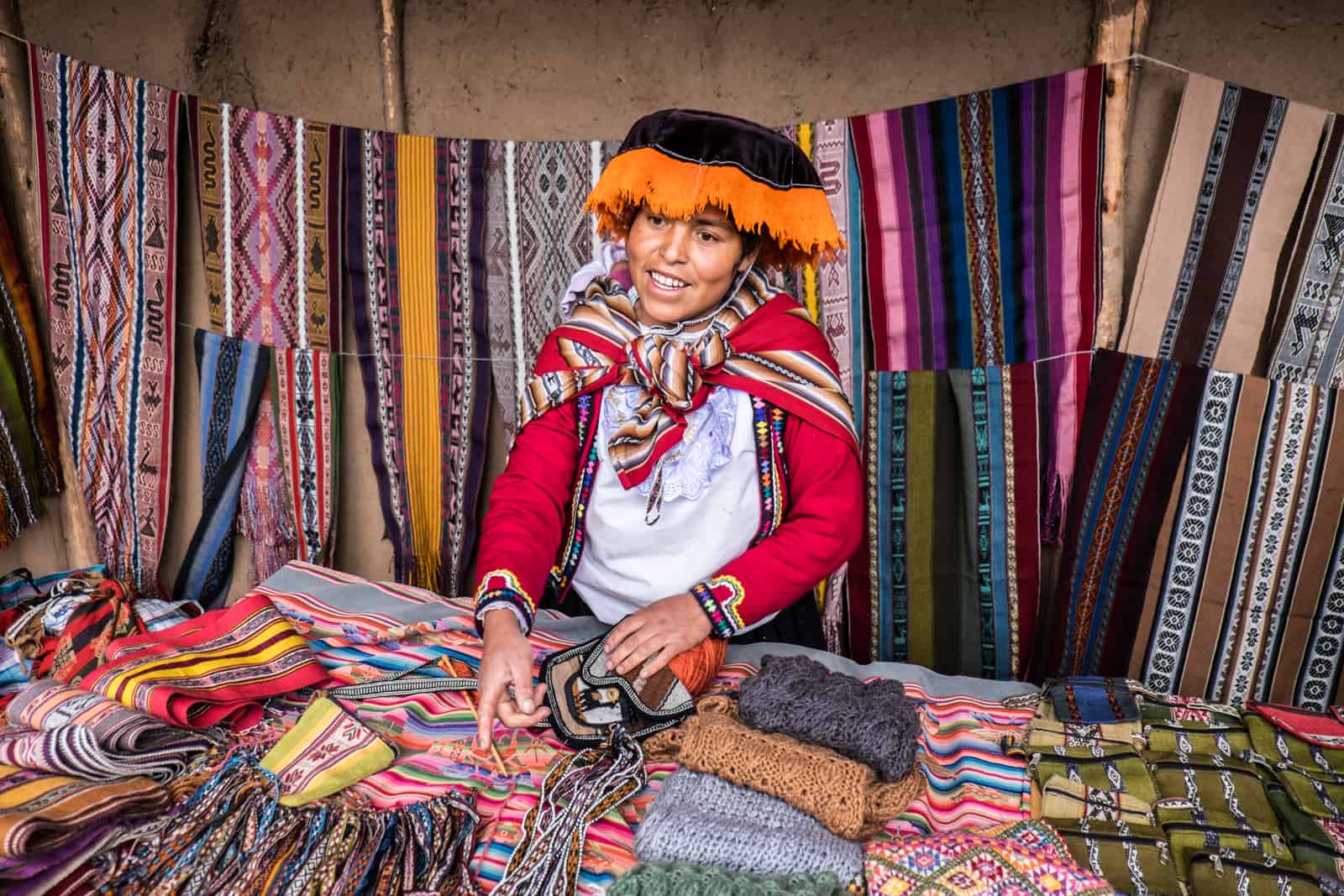
Buy handmade souvenirs from the Ccaccaccollo Women’s Weaving Co-op in the Sacred Valley.
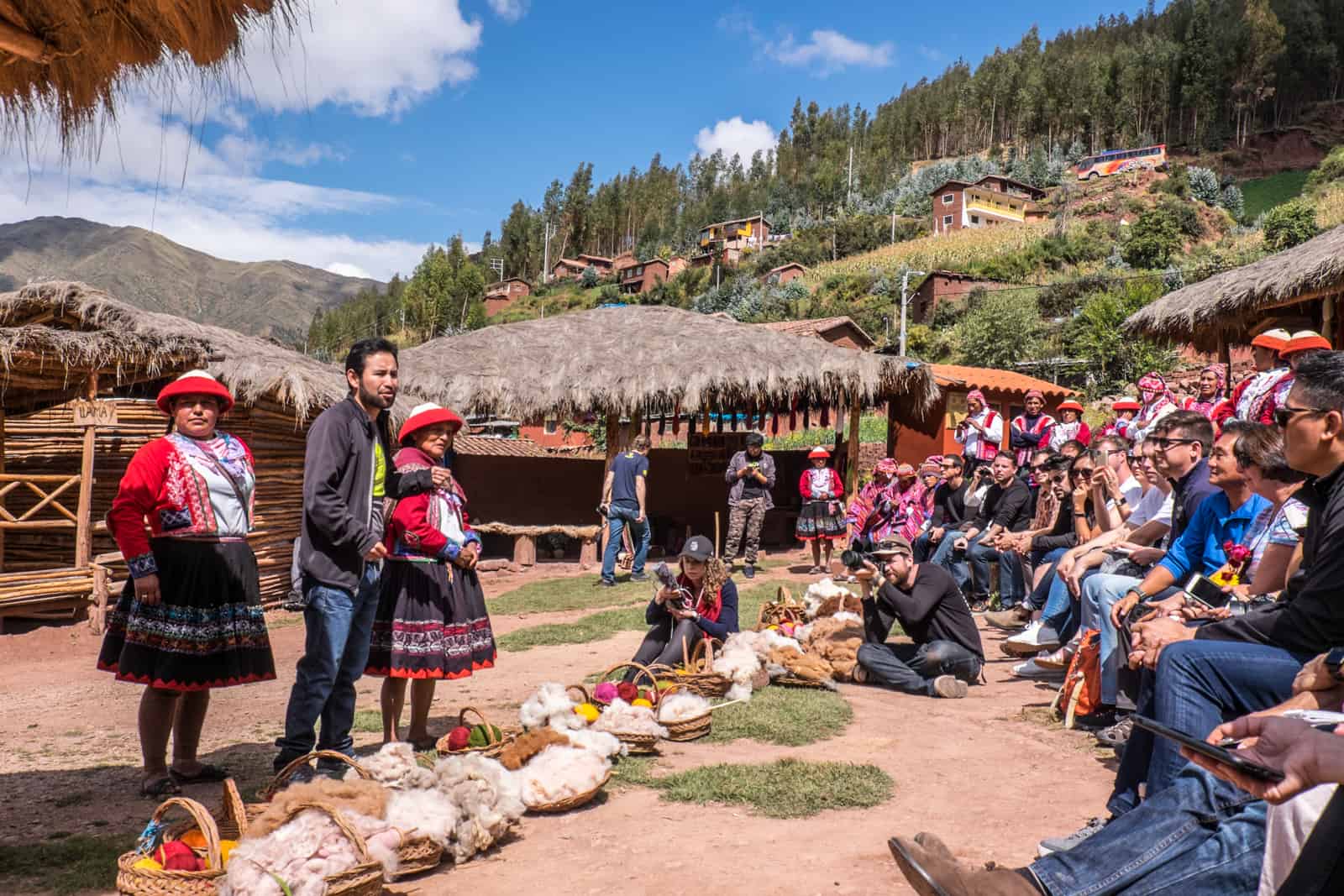
The group learns about how the women of this area continue the beautiful tradition of weaving.
50km from Cusco, in the village of Huchuy Qosqo in the Sacred Valley, a community struggled due to limited access to economic opportunities. Yet travellers were passing nearby, and so an idea was set in place for the construction of the Parwa Community Restaurant.
Over 1,500 G Adventures travellers pass through each month, eating meals using ingredients sourced from local farmers, served by those who are given hospitality training and employment benefits. All income earned by the restaurant is reinvested back into community social projects, including separate micro-enterprises, like Warmicha, which sells various locally made snacks to travellers hiking their way to Machu Picchu.
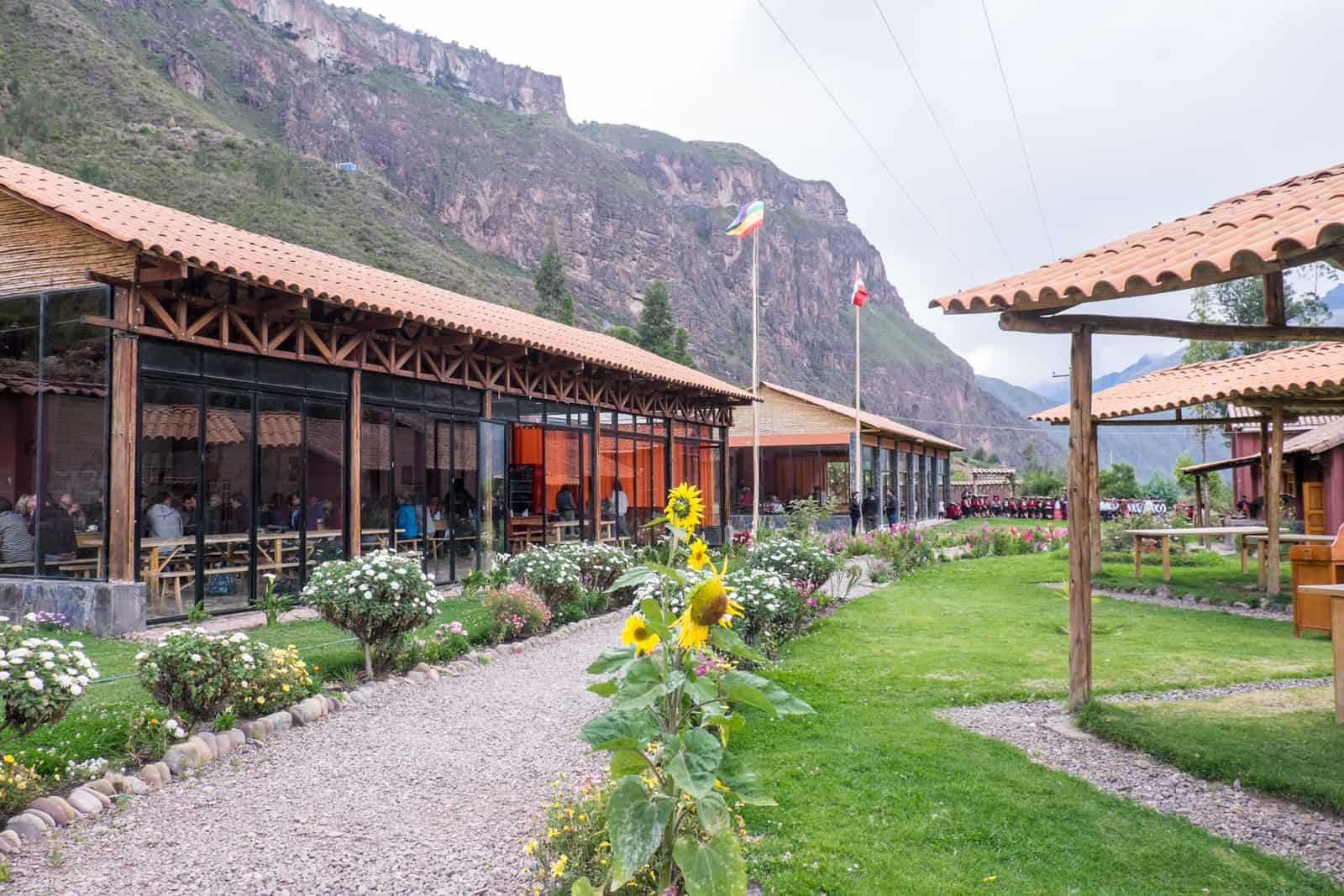
The Parwa Community Restaurant in the Sacred Valley near Cusco.
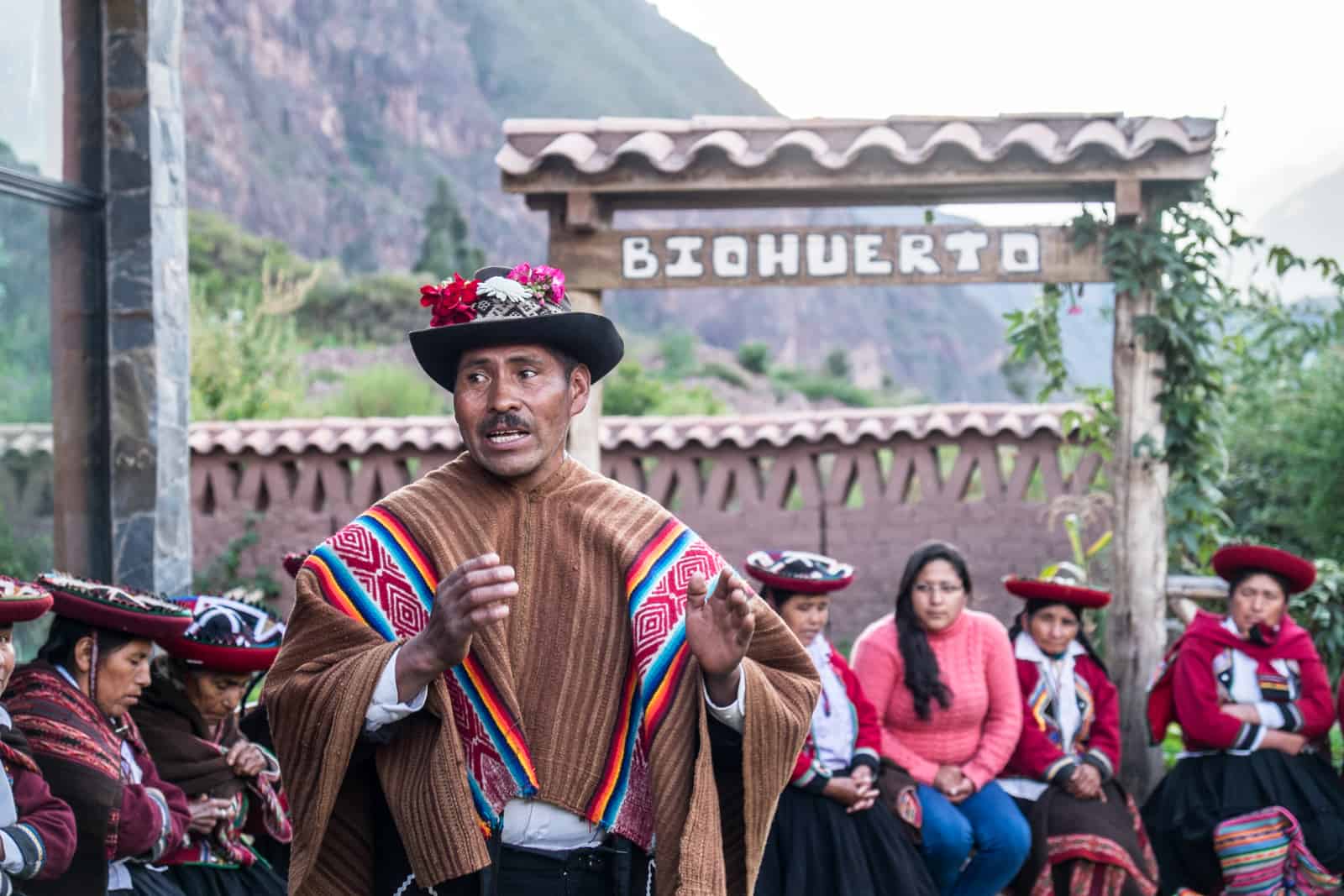
Meeting the indigenous Parwa Community in the Sacred Valley, Peru.
Parque de la Papa (Potato Farm) is a conservation project dedicated to potato seeds. Over 6,000 indigenous community members work together to preserve the 3,000 species of potato in this area. This provides not only economic opportunities and the preservation of indigenous culture but also preserves agricultural biodiversity unique to this region of Peru.
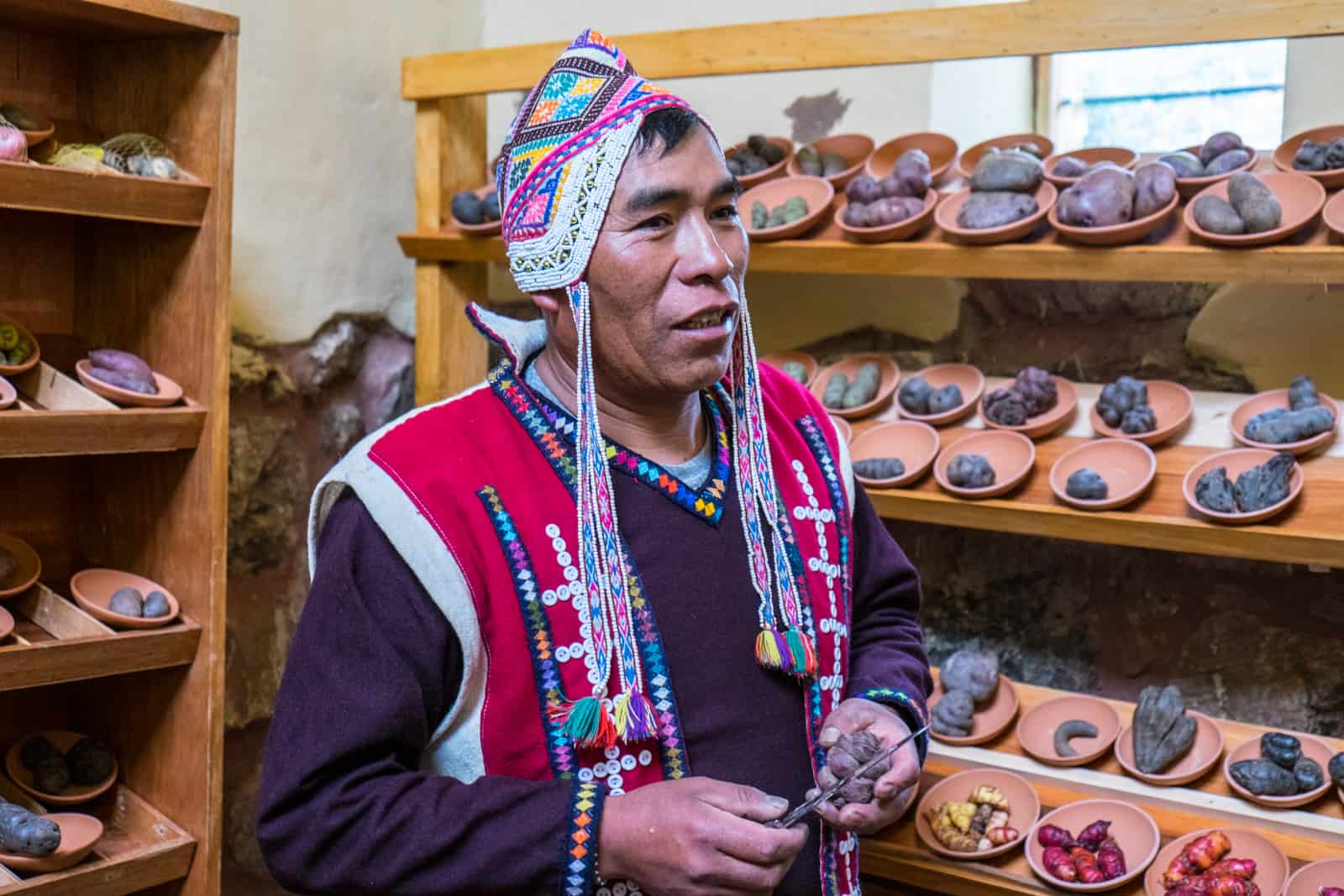
Learning about the 3,000 varieties of potato in Peru at the Parque de la Papa conservation project.
A former G Adventure Chief Experience Officer (CEO) set up Nunay Reimy restaurant in Cusco. Travellers on G Adventures trips visit this restaurant, where a portion of the establishment’s profits is returned to the community.
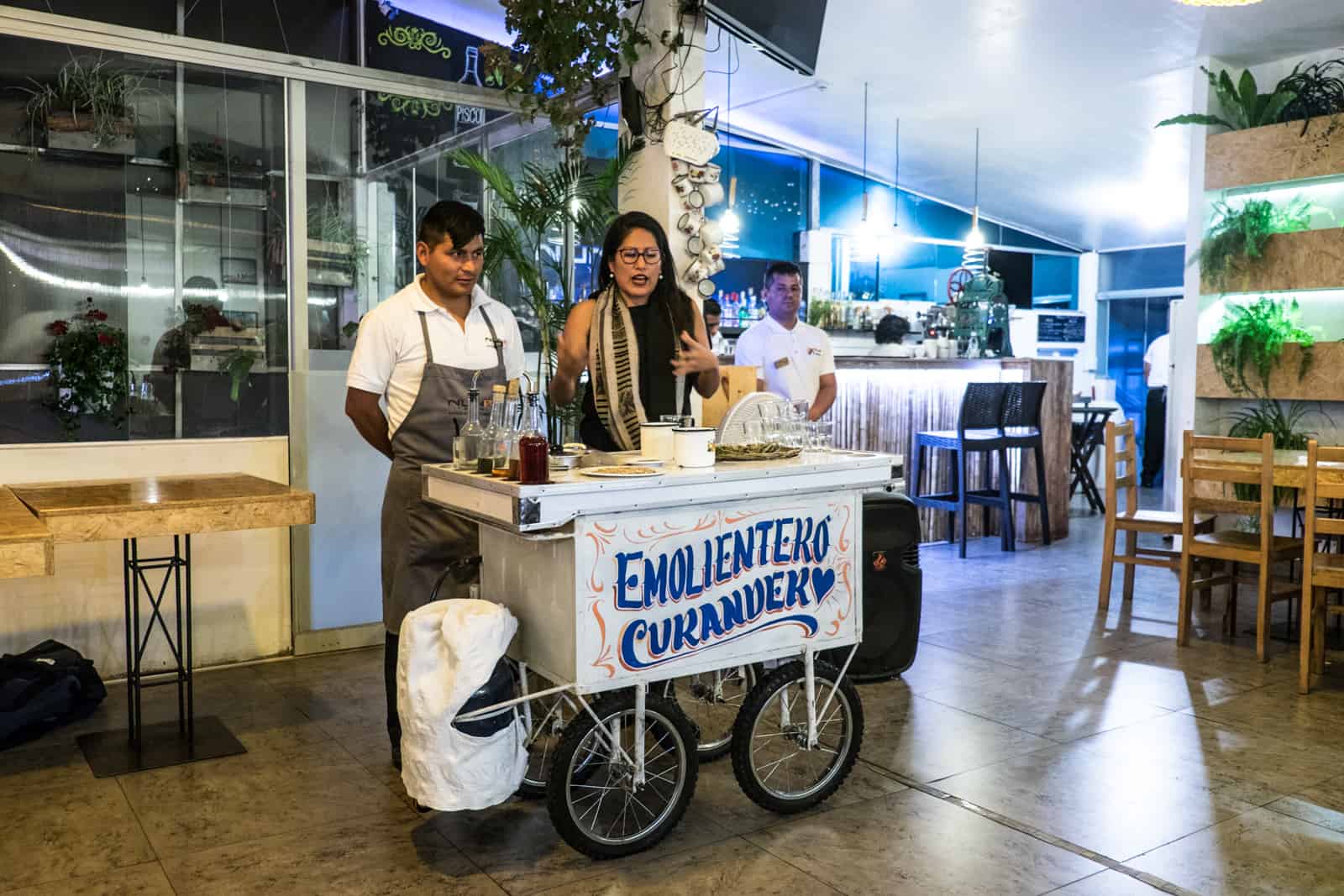
Cuisine insights at Nunay Reimy restaurant in Cusco.
One of the first big Planeterra projects for G Adventures, money to build the centre was raised by a huge five-year-long international fundraiser by G travellers. Children who live in extreme poverty in Cusco are usually forced to drop out of school and beg on the street to help their families.
You will be contributing to a project that provides children from poor families with a place to get guidance and support. You can support the centre in your visit by buying handicrafts produced by the children who have the opportunity to train in various workshops such as leatherworking and jewellery-making.
Bite Peru was the first project to come out of the ‘G Values Fund’ where former CEOs looking to move on from their role are given the opportunity to submit a business plan for an idea they can set up at home, with the best and most socially viable being granted the funds for it to start.
What was initially set up to provide culinary journeys in Lima and its thriving food scene soon turned into other offerings which help change the perception of the city. It was with these guys that I visited the San Juan barrio, as well as the street art project emerging in the socially displaced neighbourhood of Callao. I can also recommend ceviche making classes and market tours with a special focus on fruit tasting.
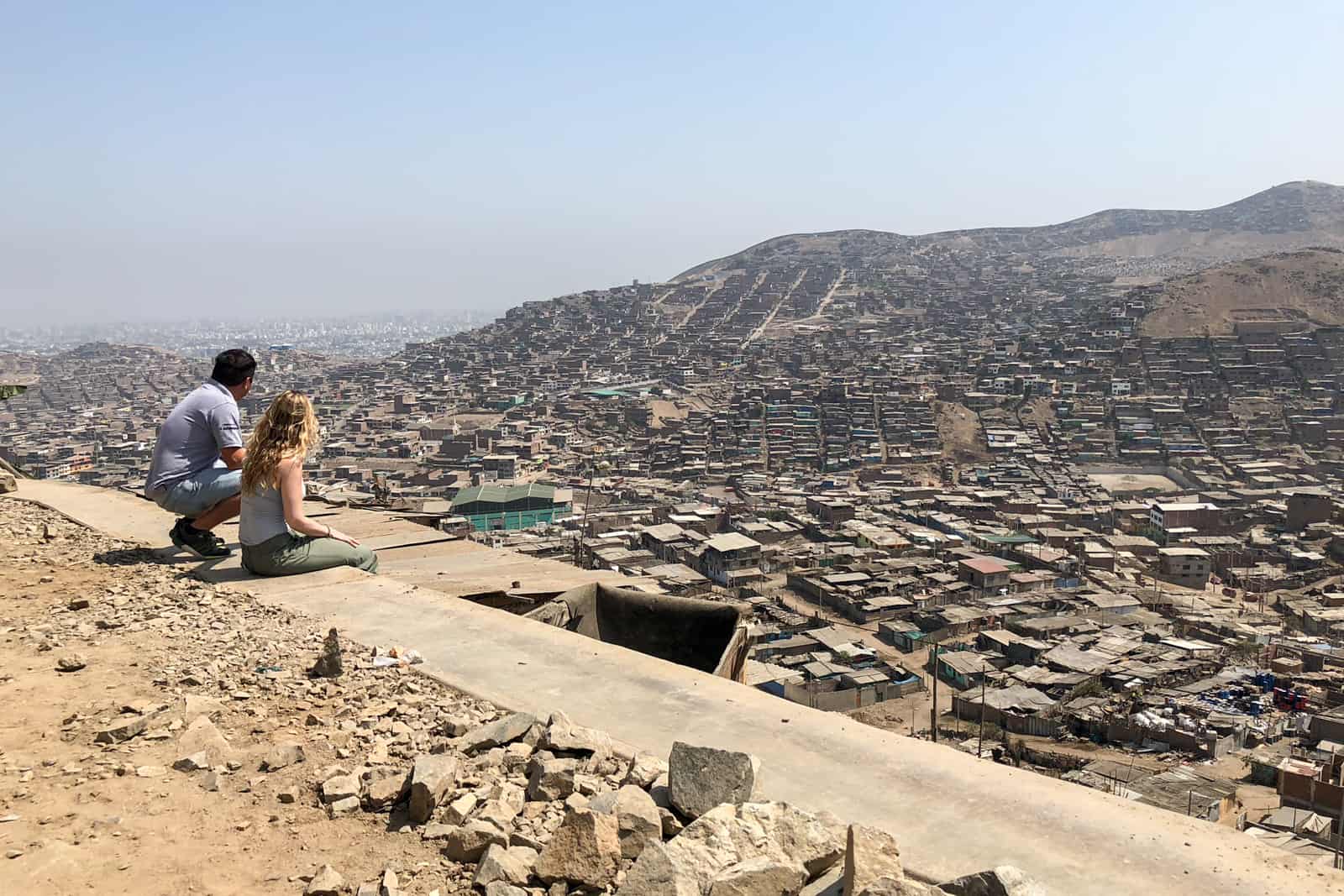
A perception changing tour of the San Juan de Miraflores barrio in Lima, Peru.
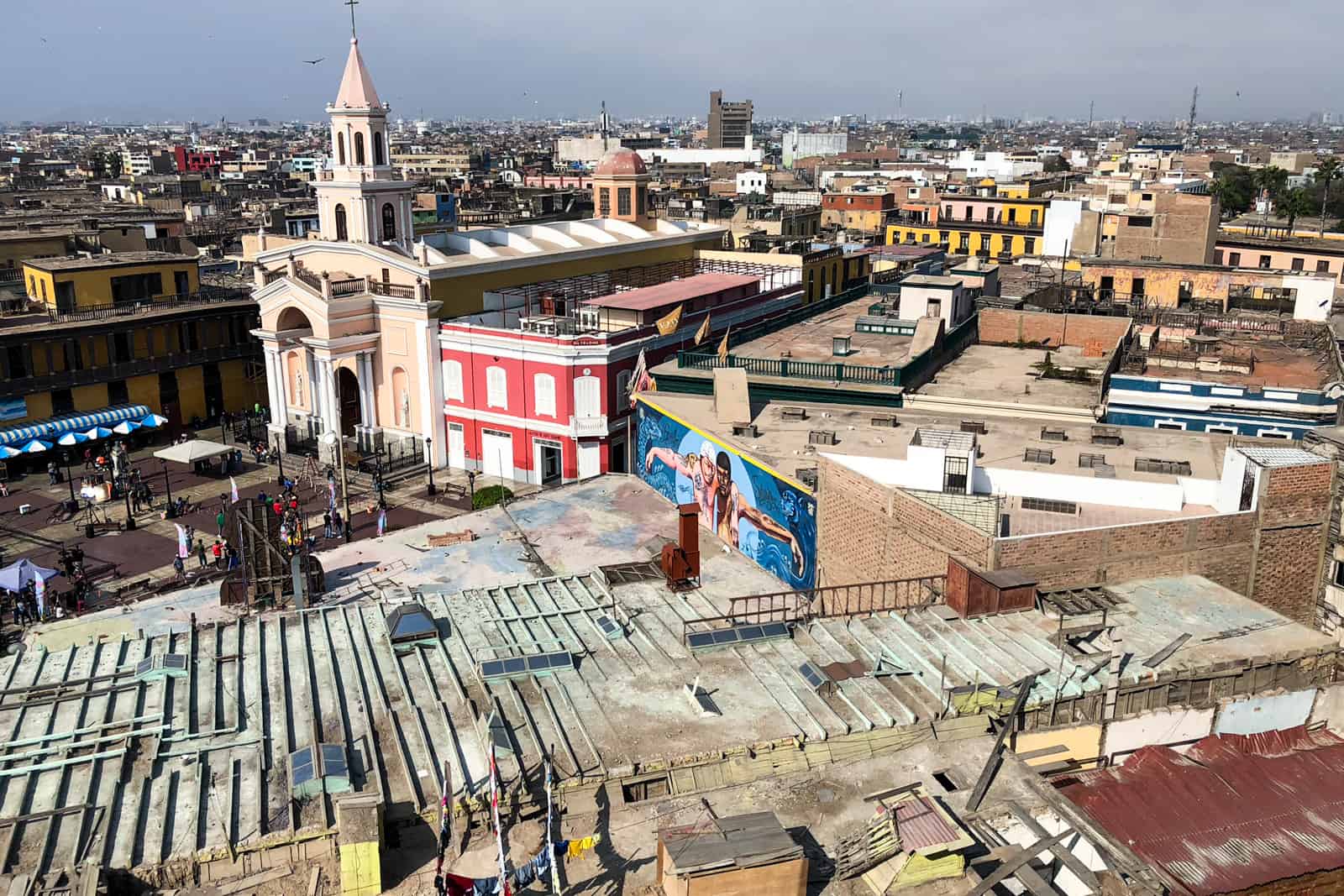
Art is transforming the run-down, dangerous and forgotten neighbourhood of Callao in Lima.
Money in Peru
The currency in Peru is the Sol. It doesn’t take long to get used to it. There are just over three Soles to the US Dollar (USD), around three and a half Soles to a Euro (EUR) and just over four Soles to the Pound (GBP). Rounding up helps you make quick conversions when deliberating prices and making payments.
While some businesses accept US dollars and some ATMs allow you to withdraw it even, it is much easier to pay for day-to-day things with Soles, including food and drink, shopping at local markets and entry to local attractions.
We found that Dollar payments were applied for bigger things and where it was easier to pay by debit or credit card like booking the Rainbow Mountain and Colca Canyon treks and hostel and hotel stays.
I also kept 200 Dollars hidden away in case of emergencies.
There are ATMs in every major city in Peru, typically found near each city’s Plaza de Armas (the main square) . It’s highly unlikely that you will find any ATMs in more rural areas, including villages and small towns.
Like most ATMs in South America, it is wise to use those inside a bank or to avoid using any located on the street at night. I always withdrew money in the middle of the day when plenty of people were around.
I was able to use my Mastercard and Visa debit cards. Despite having a pre-loaded travel card that limits being charged extra ATM fees, I was charged a small fee at every ATM transaction in Peru, no matter what card I used.
The fee for withdrawing money at the Peru ATM was always around $5-$7 per transaction , so I soon learnt to take out hearty amounts each time to cover me for a while. The maximum withdrawal was around $200 – $250 per transaction.
How much does it Cost to Travel in Peru?
Peru is significantly cheaper than the other countries in South America, which adds to its popularity. Like anywhere, your daily budget depends on your style of travel and whether you want to live like a local or live it up in comfort.
The biggest cost for a traveller in Peru is normally a trek, connected to visiting Machu Picchu. My other biggest costs were accommodation, since I always took a private room (average prices for a dorm room in Peru are also listed), alongside more convenient means of transport such as a flexible bus pass and an internal flight.
Costs of Travel in Peru (Average Prices in US Dollars)
- Local, long-distance bus rides: $5-$15
- Intercity El Metropolitano bus in Lima: Under $1 (S/. 2.50)
- Peru Hop ticket: $159 for a ‘Get Quick’ pass / $199 for a ‘Full South’ Pass
- An internal flight between Lima and Cusco: $60-$70
- A taxi between Lima airport and a hostel: $20
- A taxi between Cusco airport and a hostel: $5
- Big Treks like Inca Trail or Salkantay – $600 – $1,000+
- Small two-day treks like Colca Canyon – $50
- Day treks from Cusco like Rainbow Mountain – $50 – $100
- Dorm in a hostel – $10-$15
- Private room in a hostel – $25
- Room in a mid-range hotel – $35-$50
- Two-hour speedboat tour from Paracas to Ballestas Islands: $15
- Two-hour sand buggy tour in Huacachina: $15
- Nazca Lines flight: $80 + 30 Soles ($9) airport tax
- Day trip to Colca Canyon: $25-$30 + 70 Soles ($20) tourist entry ticket fee
- Half-day tour to Lake Titicaca, Puno: $10-$15
- Full-day tour to Lake Titicaca, Puno: $20-$25
- Food in a local restaurant (two courses) –$2-$5
- Food in a gringo restaurant – $10-$20
- Food at a local market – $1- $2
- Coffee: $2-$4
- Local beer: $2
Is Peru Safe to Travel to?
While I have never encountered any major problems in Peru, like anywhere in South America, you need to exercise more caution following the region’s turbulent history, which has largely dissipated and hasn’t affected major tourist areas for over a decade. However, it is good to be aware of petty crimes and scams that can still occur and to keep up to date with any Peru travel alerts from your home country.
‘Express Kidnappings’ – This is where travellers are taken to an ATM and forced to withdraw money, normally as much as they can get and effectively held against their will until they can extract the money. This is said to be a common occurrence, particularly at Lima airport.
Muggings – This form of petty crime in Peru usually occurs in more dark and isolated areas. There have been some cases at major monuments such as Sacsayhuaman in Cusco, the hilltop monument in Arequipa at sunrise and sunset when the crowds disperse. I also never walked alone in Lima at night, even in Miraflores, away from the busy areas like Parque Kennedy.
Something-On-Your-Shoe Distraction – There have been a few stories of someone spilling something on your shoe or dropping money in front of you where you feel inclined to help and pick it up. Distraction is the greatest tool for those wanting to commit petty crimes. Don’t fall for it.
Short-changing – I encountered this on many occasions in both shops and hostels. Always, always check your change. I’ve had everything from being given four 10-cent coins when my change should have been four Sole coins to a hostel receptionist giving me change in coins and conveniently leaving out the 10 Soles note that should have come with it. Refuse to leave until you get your right change. I never gave in.
Always carry a photocopy of your passport and not the real thing! I used a Pacsafe Portable Safe the entire time I was in Peru and locked it to the bathroom sink pipes and/or furniture attached to the wall. I also had photocopies of my travel insurance, vaccinations and relevant trip documents.
Only carry enough cash that you need for the day. I only took my credit or debit cards when I knew I had to withdraw cash. I didn’t carry them around daily and kept them stored with my passport in the safe mentioned above.
Keep your bag with you and in sight at all times. I always had my daypack/handbag slung over my shoulder or on my lap, especially in crowded places.
Avoid travelling at night in Peru. Travelling by night is still not considered the best option, as armed holdups on buses and other transport routes still occur, more so in the far northern reaches of the country and on the Peru-Bolivia border at Lake Titicaca. I only travelled overnight on the Peru Hop tourist bus.
Be aware of what border crossings are accessible or not. For example, many official websites mention that the border to Colombia is best avoided due to narcotics (drug) trafficking.
Don’t withdraw money from ATMs at night, and don’t withdraw money from an ATM in an unpopulated or dodgy-feeling area. Withdraw enough money from an ATM in the centre of major cities so that you have enough with you to last through less busy and remote areas.
Don’t flash your valuables. This might sound obvious, but the number of travellers I saw with a camera hanging off their neck or dripping in expensive jewellery and clothing was abundant. Don’t be an obvious target when you already look ‘gringo’ enough. And especially hide your stuff in less affluent and less touristic areas.
Use Uber, especially at night. As a solo female traveller in Peru, there were times I met friends in town for drinks but didn’t want to walk back through quiet, narrow streets at night, especially in Cusco. Uber was a great choice, and I never had any issues. My Peruvian friends always recommended it.
Hold onto your bag when riding local buses, and don’t put it in the overhead compartment. There are countless stories of theft on buses, as well as a classic tale of someone telling you that you have to move seats when you don’t (this is a strategic move to be able to rob you more easily).
The smaller cities in Peru, as in South America generally, are no more of a major threat than other large cities worldwide. However, the Capitals have a lot of major no-go areas. Therefore in Lima, you absolutely need to know where you can and can’t go and what areas are absolutely and completely off-limits.
It’s wise to do some digging on Lima before you arrive. A handful of neighbourhoods in Lima, in particular, should be avoided – like the Callao district next to the airport and Rimac just across the bridge from Downtown Lima and the Presidential Palace.
Miraflores is the safest neighbourhood in Lima and where you should, ideally, stay. It is the more affluent one where locals can afford security guards at both their homes and to sit guard outside of their business premised all night. Miraflores is, therefore, fine to roam by day, yet I would still exercise caution at night when the residential streets are quiet and there is not a security guard on every corner like those roaming at Parque Kennedy.
Barranco, the more artsy and bohemian neighbourhood south of Miraflores, is also a good choice to either visit or stay when in Lima.
When a new district turns into another, it is not marked, and it is easy for your curiosity to get the better of you. A friend and I accidentally wandered into the neighbourhood of Rimac during our day exploring Lima Downtown. If it wasn’t for a local woman on a balcony furiously waving for us to get the hell out, who knows what might have happened? A Peruvian friend later told me we would have 100% been robbed if we were just one more block east.
Impoverished neighbourhoods back onto the affluent ones like Miraflores, and the city widely sprawls to include some VERY dangerous places. For example, next to the Mercado on the fringes of Miraflores is the neighbourhood of Surquillo. Wander too far in, and you may stand out too much. One traveller’s curiosity saw him robbed and beaten, as was his wife, who was wearing a camera around her neck.
Lima is not the place to show your riches. You can feel the atmosphere drop to another level. Don’t take the risk if you haven’t done your research.
On the other hand, Lima is developing with social enterprise schemes and local tours booming. These are helping the areas to regenerate and educating visitors about Peruvian politics, society, culture and what is happening today. I visited an art project in Callao and the San Juan favela/barrio in the east, guided by locals and with genuine insight into how things work and the changes taking place that could turn things around for those less prosperous here.
Lima is so complex, and it is all too easy to dismiss by spending two days in Miraflores before leaving altogether.
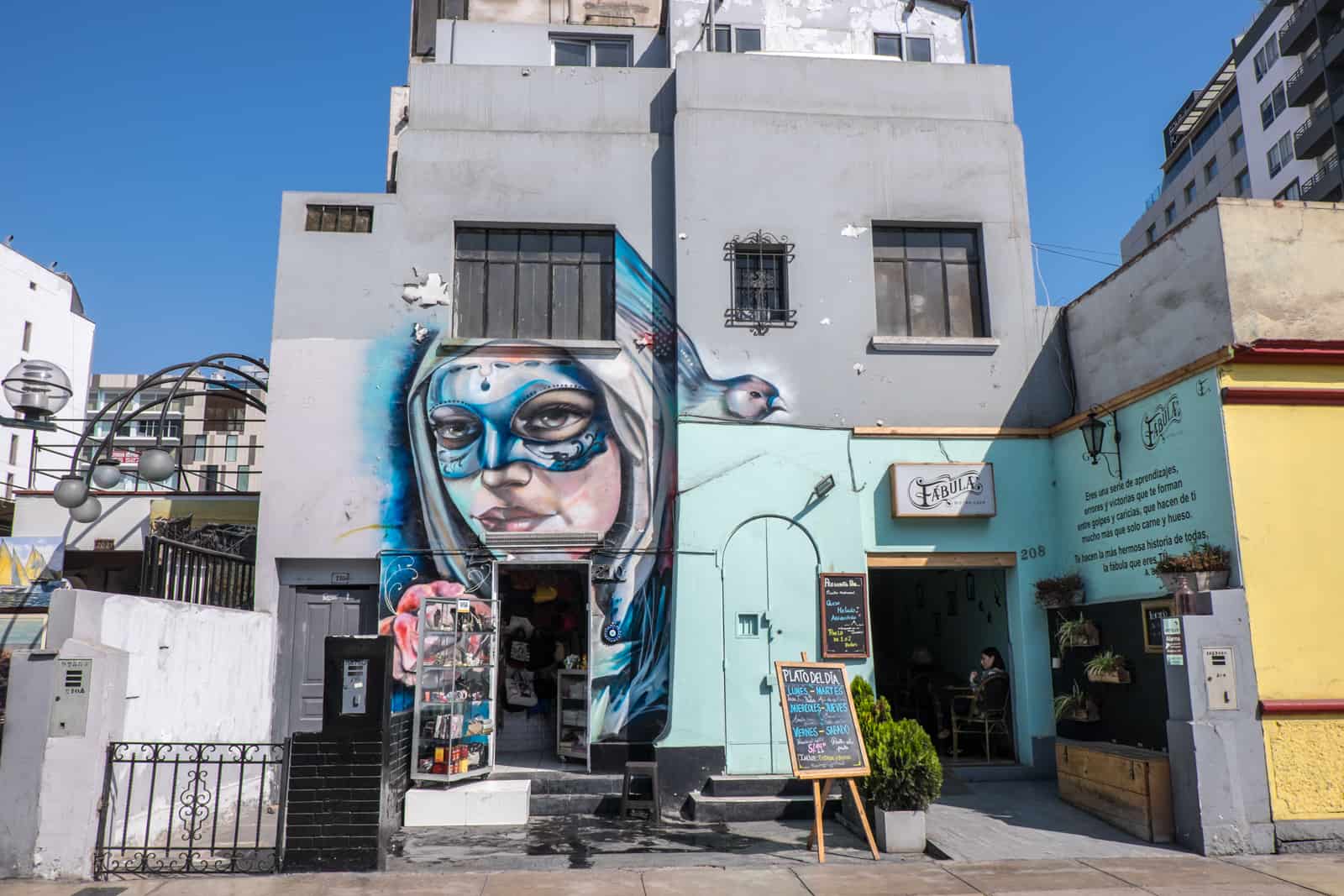
The Miraflores neighbourhood of Lima.
Ceviche is Peru’s classic dish, and Lima is the heart of the dish’s origination. A melody of fresh fish, lime juice and the rich flavours of pepper, onion and chilli combined, it has to be tried at least once as a rite of passage to Peru. You’ll find everyone from local markets to high-end restaurants serving it with their own little twist.
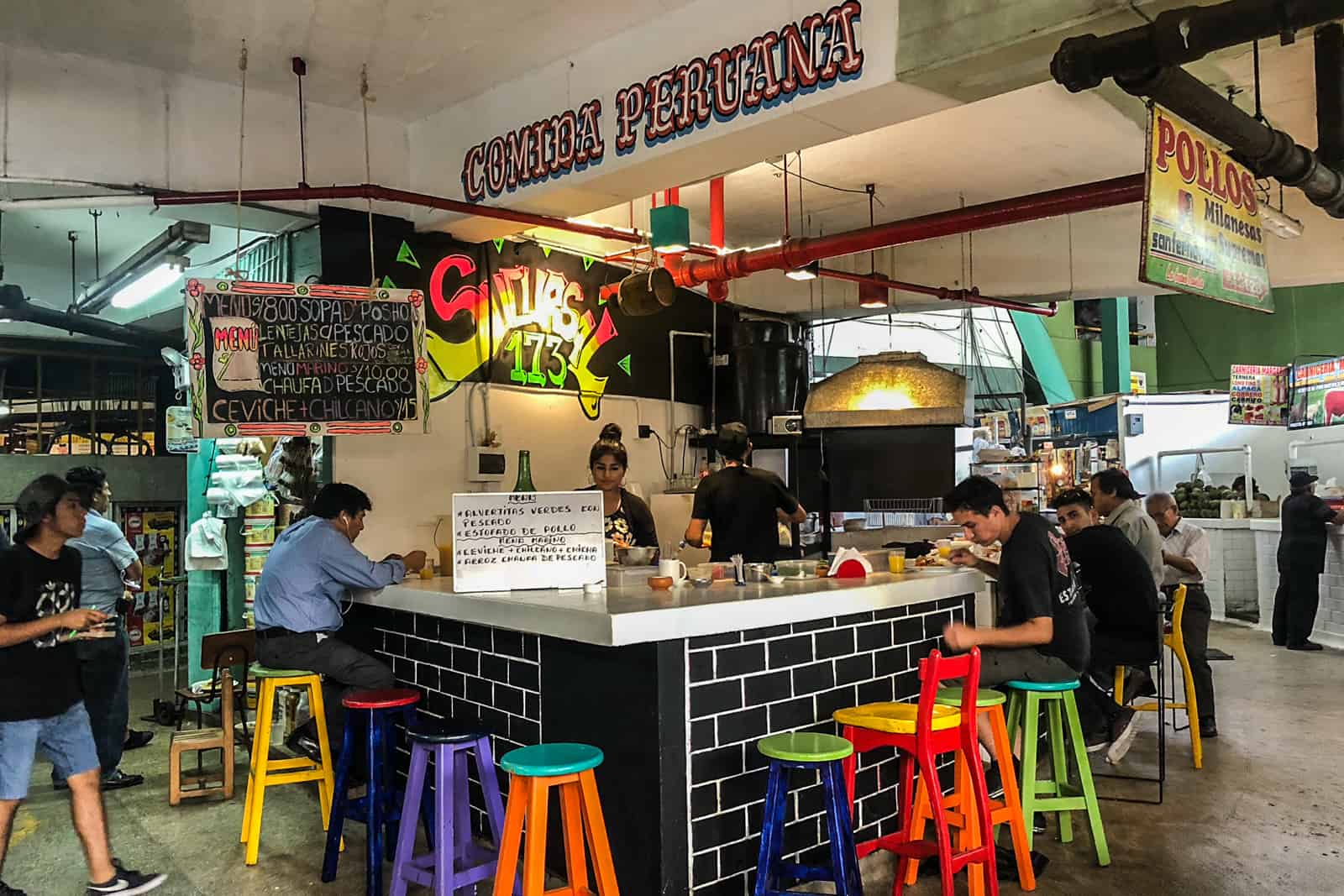
A Ceviche stall in a market in Lima, Peru.
Lomas Saltado is ‘salted beef’; marinated strips of beef are combined with a stir fry type mix of pepper, onion and tomato and served with rice. It’s often also served with fries or a mix of both.
Aji de Gallina is well worth a try, especially since it’s always on the menu when you eat in a local establishment. It’s a yellow cream sauce made from yellow Aji peppers, usually served with meat such as chicken, hard-boiled eggs, potatoes and rice. The best ones normally have a light spicy flavour for an extra kick.
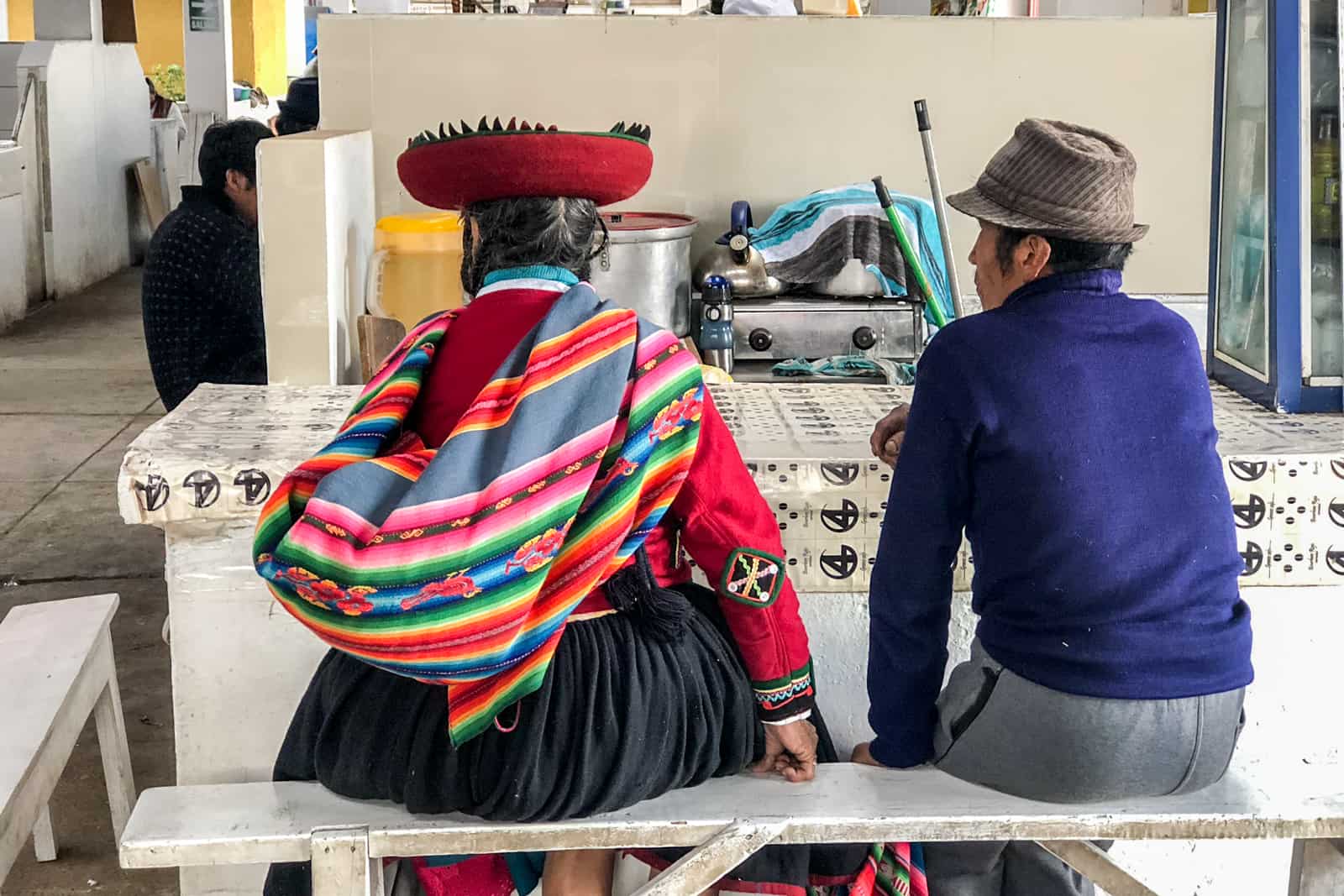
Locals dining at the San Blas market in Cusco.
Pisco Sour. Ok, this is not food, but it’s technically a staple part of the culinary menu. Lemon juice, egg white and Peru’s Pisco (a fermented wine) on ice, topped with bitters, make up this famous and timeless classic cocktail. Of course, in Peru, it’s cheaper and made to perfection.
The Internet in Peru can be patchy and not always fast or reliable, which makes travel in Peru and planning a little frustrating. Get yourself a local SIM card, which saves you from relying on the patchy hostel and guesthouse Wi-Fi. A SIM card in Peru costs about 15 Soles (about $5 USD), and I got a starter package with a local carrier, Claro, for 30 Soles (about $5 USD), which gave me 3MB of data.
Remember to take a copy of your passport to purchase the SIM. The main two carriers are Claro and Movistar, and you will find many convenience stores, supermarkets and other outlets where you can top up. Just look for the flag signs and shop window stickers for Claro and Movistar.
Peru is the largest exporter of cocaine to the western world, with this trading belt up into Colombia enticing ‘Narco Tourism’. While offers of cocaine and cannabis frequently occur on the street, especially in Cusco, don’t be that tourist whose curiosity gets the better of them.
Punishment for drugs in Peru is severe, especially if you try to take drugs out of the country (Google ‘Peru Two’ for an example).
Travel to Peru adventurously, safely, and responsibly. Is there anything else you would add to this list?
Planning a Peru Trip? – Pin It!
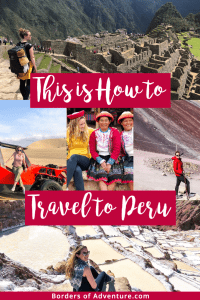
About Becki
Becki Enright is a British Travel Press Award-winning writer whose work focuses on changing perceptions about misunderstood aspects of destinations. Her writing combines storytelling with insight into the social, historical, political and economic factors that shape the country or place in relation to tourism. Becki has appeared live on Sky News and CNN and has contributed to high profile media including National Geographic, Time.com, Guardian online, New York Times, Grazia and Buzzfeed.
4 April 2024 at 7:11 am
Great article 🙂 I’m hitting up Peru for the first time with G Adventures this summer and all the info you provided on their community work was helpful. Cheers! Kim
4 April 2024 at 2:48 pm
Glad it was helpful, and have a great time touring Peru!
10 July 2023 at 9:06 pm
Hi! This was very helpful, I am traveling solo in August and I was wondering if you had an opinion on which city to visit first between Cuzco and Arequipa? Also safety wise what are the best ways to get from airports to our hostels?
17 July 2023 at 4:41 pm
Lima, Arequipa and Cuzco are almost a triangle of cities, so depend which direction you are travelling in. Safety wise, most hostels can arrange an airport pick up for you. Just email them before with plenty of time. And try to get flights that arrive in the day.
29 September 2022 at 3:10 pm
I’m new to solo travelling, as in never done anything more than an overnight by myself. Peru is first on my list. As someone in my shoes, do you think it is best to find an all in one package for my first trip or attempt to plan everything separately, on my own?
1 October 2022 at 8:41 pm
If you are new to solo travelling, maybe find a fun group tour for Peru. South America is a little more tricky to cut your teeth on than say, Asia.
13 October 2022 at 8:55 pm
Great thank you!
Gloria Butner says
8 August 2022 at 4:03 pm
Hi there, interesting information but how do I visit Amazon rainforest, macho picchoo and galapoluos islands in one trip?
8 August 2022 at 6:05 pm
You can’t. The Galápagos Islands are part of Ecuador, and Machu Picchu is in Peru. You can visit the Amazon in both.
20 February 2020 at 4:26 pm
Great guide! I am going in April. Wondering which travel guide to buy now. I always go for Lonely Planet, but wondering if I should try something new that you could recommend?
1 March 2020 at 10:24 am
You could try Rough Guides as well. People are usually in one camp or the other.
Leave a Reply Cancel reply
Your email address will not be published. Required fields are marked *
- Article Archives
- Work with me
- Privacy Policy

- 1 (800) 980-0435 or your travel advisor
How much does it cost to travel to Peru?
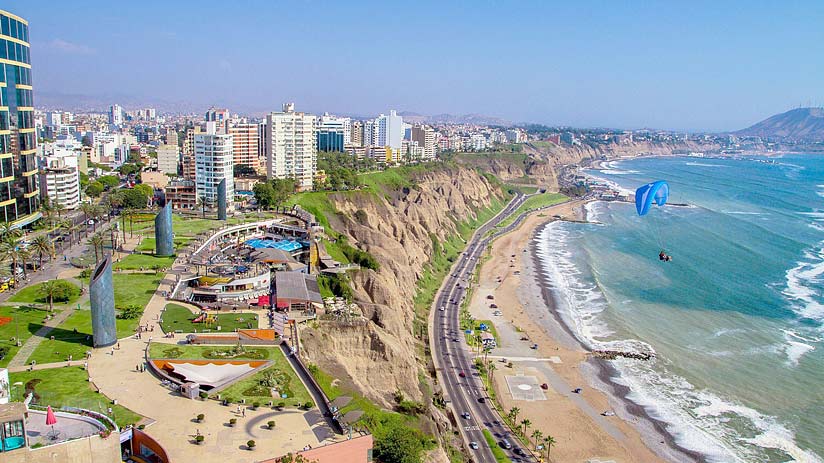
Like most South American countries, Peru won’t break the budget like a trip to Europe or the United States would. And over the past few years, the cost has increased greatly and is not as reasonable as before. But still, Peru remains one of the most interesting and inexpensive countries you will ever visit. That is why together with Machu Travel Peru we made a small article about the cost of traveling in Peru. With something for the budget traveler as well as the luxury traveler. But how much money do I need for a trip to Peru? That will largely depend on how you want to spend your vacation in Peru. Whether you are looking to stay in quality accommodations or looking to stay in cheaper options.
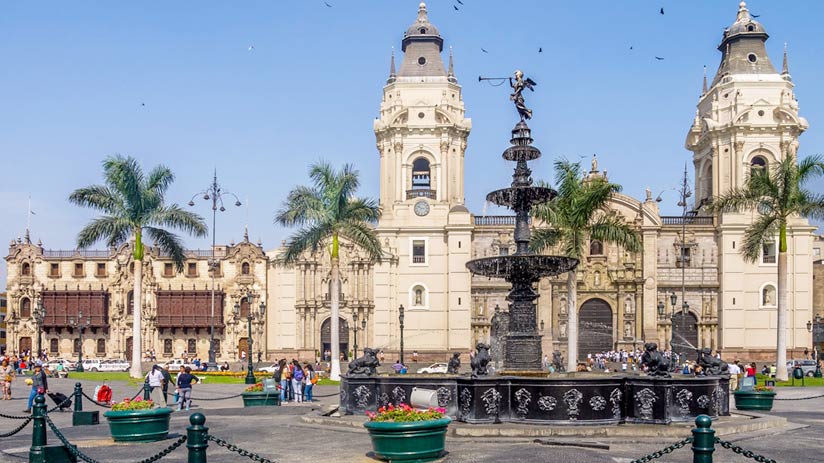
When traveling to Peru you will enter the country in the city of Lima, the capital. The city has gotten a bad rap in previous years for being somewhat dirty and dangerous. But in recent years, the city has undergone a change and is now known for having some of the best Peruvian food restaurants. So you should not miss a wonderful full-day tour in the “City of Kings” . Where you will have the opportunity to know many attractions and important historical buildings . Also, a basic meal or menu, as they are known, will cost you around the US $ 5. Where you will get soup, a main dish, and a drink. This will keep you active throughout the day. This is a good reason to include Lima in your Peru travel itinerary.
Everything you need to know about the cost of traveling in Peru
- Airplane tickets
- Bus tickets
- Train tickets
- Hotels and resorts
- Tours around Peru
- Destinations to visit
- Shopping in the country
- Security Measures
AIRPLANE TICKETS
The Peru travel cost will be largely defined by the way you travel . Either by bus or by plane. But the prices of local flights in Peru are not too high, and in some cases, they are comparable to bus trips. From Lima, you can fly all over the country with many different airlines offering services at many different prices. For example, a flight from Lima to the Inca city of Cusco can cost from around US$90 to US$150 for a one-way flight. This is one of the best choices for travel. If you take one of the cut-price airlines, you may pay less.
But keep in mind that budget airlines may have delays or cancellations without prior notice. So we recommend taking advantage of available offers or simply booking your tickets in advance . Also keep in mind that not all destinations in Peru have direct flights, so you will have to think about getting air tickets.
BUS TICKETS
Peru has a great network of intercity buses and depending on the service, you can catch a bus from Cusco to Puno, where Lake Titicaca is located, for around US$30 per person on a luxury bus with lunch and your own personal television. Fortunately, the bus is the main way to travel for both Peruvians and those travelers on a budget . And there are a wide variety of transportation companies that offer interprovincial services. So much so that you will find a lot of competition in the sector and a great variety of different prices. But we always recommend being guided by those renowned companies. In this way, you will avoid any kind of inconvenience. The Peru travel cost can be much better if you choose to transport yourself through Peru by bus.
TRAIN TICKETS
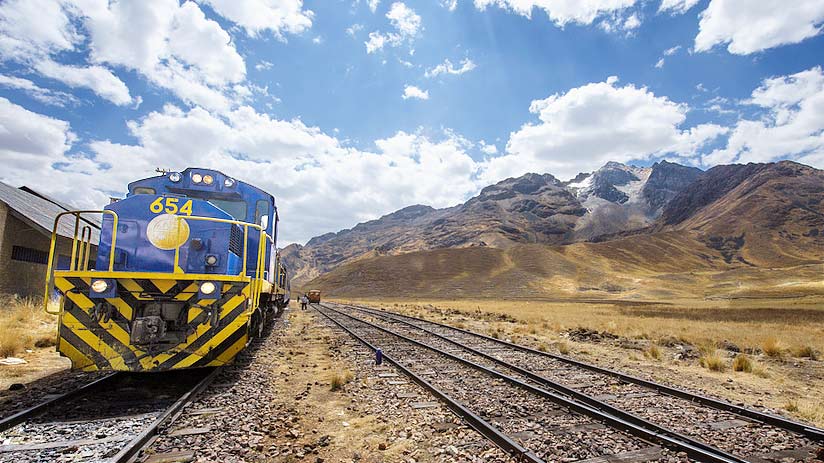
Train travel in Peru is one of the highlights of every tour to Peru . Peru has some of the best train journeys in the world. For train lovers and non-train lovers, there is a train trip for you. Travel to the Inca citadel of Machu Picchu in the tourist train or the super-luxury Hiram Bingham train that travels daily to Machu Picchu. If you are interested in the Hiram Bingham then the round trip will cost around US$800 per person. But luxury trains can add considerably to the Machu Picchu trip cost .
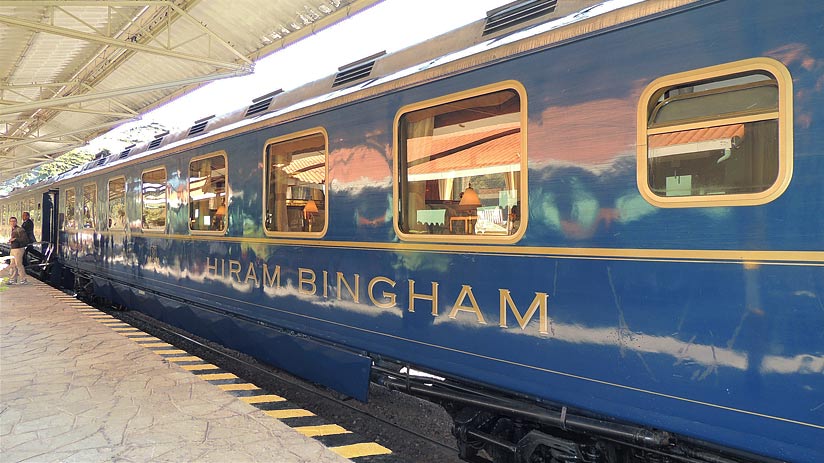
Or you can also opt for a charming train ride from Cusco to Puno, where you will enjoy some wonderful natural landscapes. This train trip is one of the best in Peru and one of the best ways to get to know Lake Titicaca. As with the train trip to Machu Picchu, it is necessary to book this trip in advance if you want not to miss out on the fun. It is true that these train trips can increase the Peru travel cost, but they will make your experience much more magical .
HOTELS AND RESORTS
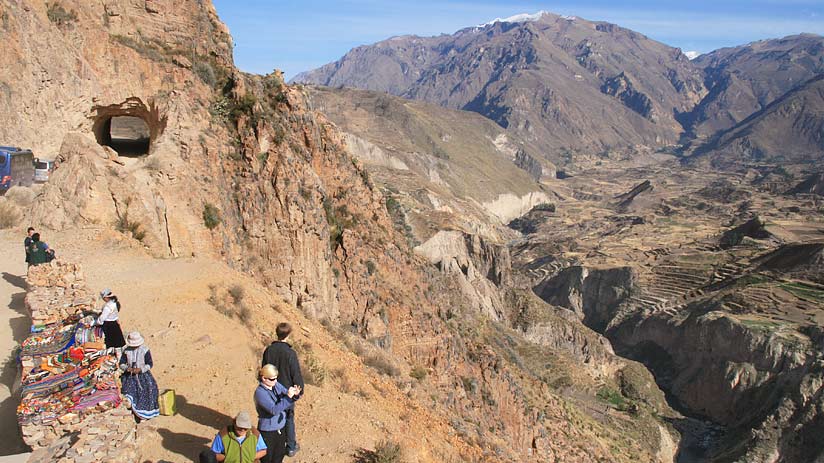
Accommodation is another expense to take into account within the Peru travel cost . Peru has a wide range of accommodation options, both luxury hotels and alternatives for backpackers. If you are a backpacker looking for cheap rooms, you will find rooms starting at around $ 5 per person per night. And if you are looking for the best cheap hotels, these will cost you around $ 20 per person per night.
There are many 3-star mid-range hotels to choose from throughout Peru. A basic three-star hotel will cost you around $ 20 per person per night, while a better three-star hotel will cost more, around $ 30 per person. Going luxury in Peru is affordable with good 4 to 5-star hotels costing between $ 80 and $ 200 per person per night. Some of the best hotels, especially in Cusco, are in old Spanish colonial houses that have been refurbished . And some of these even have wonderful art collections.
Another important thing to keep in mind is the best time to visit Peru . Since depending on the time you choose to travel, prices will change a lot . For example, in the high season of tourism, it is very likely that you will not find accommodations without having made reservations. But on the other hand, if you travel in the low tourist season, you will enjoy lower prices and immediate availability.
TOURS AROUND PERU
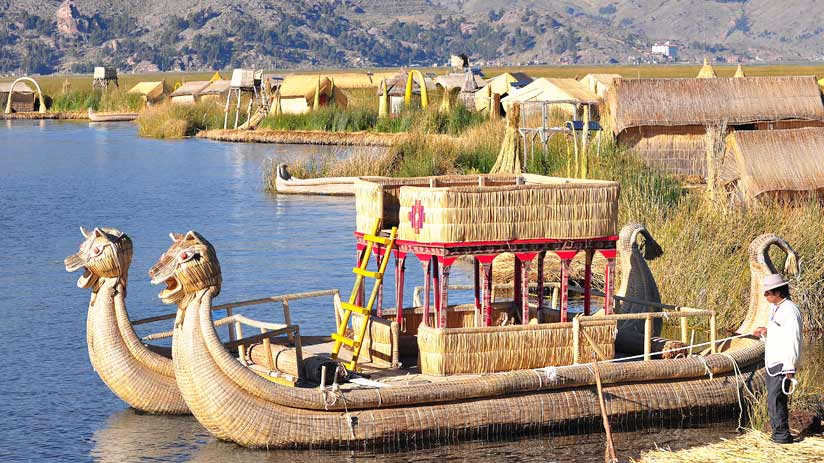
Peru tours are a truly important factor to take into account for the Peru travel cost . You don’t want to miss out on the most attractive side of our country. While in Peru, you will be interested in some travel tours in Peru. There is a big number of tours to choose from in all areas of Peru. In the Southern Peruvian city of Arequipa, you might consider taking a 2-day excursion to the naturally spectacular Colca Canyon. If you have not heard of the Canyon, it is one of the deepest in the world and the views are memorable . See the Condor in full flight as they soar above your head, not afraid of humans that are viewing them from the edge of the Canyon. A 2-day tour without a hotel could cost anything from $80 to $200 per person.
Or also opt for the boat tours inside Lake Titicaca, where you will get to know the wonders of our Andean culture . And if that is not enough, get to know Lima and its distinguished traditional cuisine in its inexhaustible quality restaurants. And finally, do not forget the unique tour of Machu Picchu. Where you can get to know one of the wonders of the world and one of the main attractions of Peru. And don’t worry, as there are numerous Machu Picchu tours to enjoy. From options with train travel, options that include a beautiful hiking trek like the Inca Trail, and much more! And what is the minimum cost of the trip to Machu Picchu? That largely depends on whether you are looking to travel by train or go the Inca Trail. But you can expect to pay in the range of $ 300 to $ 500.
DESTINATIONSTO VISIT
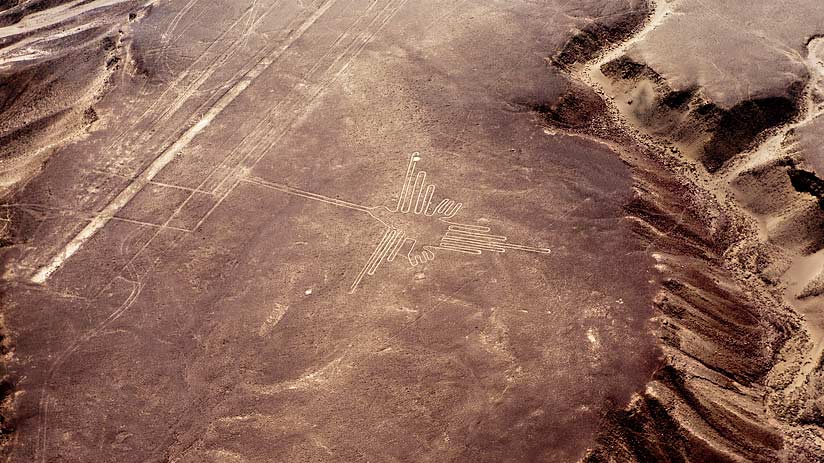
Also in the South of Peru, you’ll find the lakeside town of Puno. Set high in the Peruvian Andes, Puno is on the shores of Lake Titicaca, one of the highest lakes in the world . From Puno, you can experience the Uros Islands. What makes these islands so special is that they are manmade from the reeds that grow around the shores of the lake. The Uros people have lived on the lake for centuries and continue to be semi self-sufficient. A day tour to these islands will cost you around $40 per person. One of the best tourist sites in Peru .
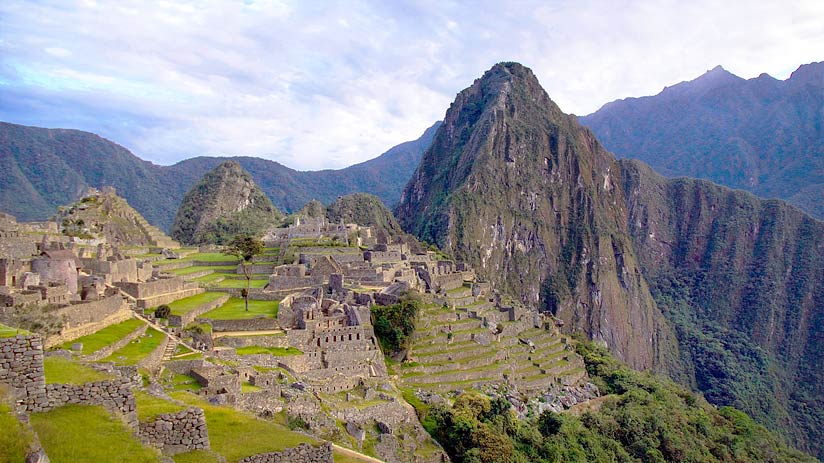
From Lima, travel down the South coast and inland and see the mysterious Nazca Lines . These lines were etched into the desert floor many centuries ago and still, today are a mystery to scientists. The best way to get a great view of the lines is by small aircraft that will take you on a 40-minute flight over the lines. The cost varies a great deal and can be expensive but you should set aside around $200 for the flight. This will affect the Peru travel cost.
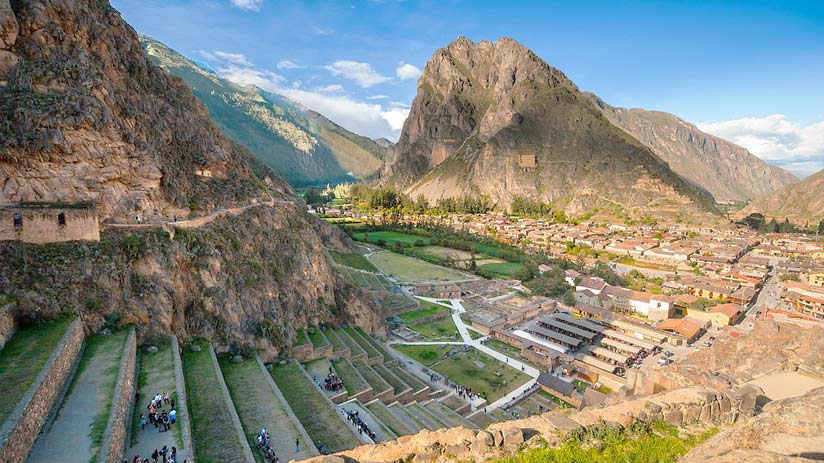
Cusco and Machu Picchu are at the top of most people’s list of places to visit . Cusco has many Inca temples in and around the city that you simply must experience. Not far from the city you can find the naturally beautiful Sacred Valley of the Incas. The Valley is set among the Andes and the temperature is mild. For this reason, the Inca used the Valley to grow all their food to feed the empire. From the valley travel to Machu Picchu where a full-day trip from Cusco will cost you from $250 to $1000, depending on the service you require.
SHOPPINGIN THE COUNTRY
Shopping in Peru can be a highlight, there is much to buy in the many shops and markets located all over Peru . Depending on your spending habits, you may spend a little or you may take home many different Peruvian souvenirs . We recommend going through the different markets of Peru and buying many alpaca products, which is one of the strengths of Peru. We also recommend checking out the different Peruvian-themed products. From key chains, backpacks, mugs, shirts, other clothing products, and much more! The truth is that you will find an endless number of interesting products to take with you to your home.
SECURITY MEASURES
Another important factor to consider for the Peru travel cost would be the security measures that you will take. And while it is true that Peru is a third-world country, it is not as dangerous as people think . It will simply be a matter of being sensible and not exposing yourself in dark alleys or walking alone at night. And is Peru expensive to visit? No, it is not, compared to other European countries, Peru is still quite accessible. Peru’s security is not too different from any other city or destination in the world. Try not to carry your valuables in plain sight, always carry a copy of your credit card with you, and don’t carry too much cash with you. As long as you keep these tips in mind, you will have a wonderful time with your family.
“TRAVEL IS THE ONLY THING YOU BUY THAT MAKES YOU RICHER“
So, Is it worth it to go to Peru? Yes, it is. It’s one of the best tourist countries in South America. And as you will see, the cost of traveling in Peru will be reflected by numerous and diverse factors. From how you want to enjoy your vacations and the days you will seek to stay. In addition to which tours you will seek to enjoy and which destinations to include. There are many things to think about and consider when it comes to Peru travel costs. For this reason, together with Machu Travel Peru , we recommend that you start organizing yourself right now.
We hope that this little article has been of help to you since for us it is a pleasure to show you about our wonderful country. If you want to know more about our tours, you can consult with our qualified advisors. They will be happy to help you with your wonderful dream trip. Don’t miss out on Peru for anything in the world!
Peru has so much to offer, it can be hard to know where to start. With many years of experience in the tourism sector, Machu Travel Peru is happy to help with anything regarding your trip to Machu Picchu and any tours around it . Make your Machu Picchu experience an unforgettable one!
click here: Best Peru Tours
Please note that our tours depart 365 days a year.
Top luxury hotels in Peru

Sumaq Machu Picchu Hotel

Inkaterra Machu Picchu Pueblo Hotel

The Westin Lima Hotel & Convention Center

Inkaterra Hacienda Urubamba

Rio Sagrado, A Belmond Hotel, Sacred Valley

Los Incas Lima Hotel
Peru - the estimated travel expenses for food, public transport, attractions entrance and accommodation., how much does a trip to peru cost.
Currency in Peru is Peruvian Nuevo Sol
Peru prices guide., if you are travelling alone to peru, depending on your expectations, you will pay for an overnight stay from 20 usd (75 pen) for a hostel to 149 usd (565 pen) for a luxury hotel., the other daily costs you have to pay when travelling to peru are:.
- Food 6.40 USD (24 PEN)
- Meals in restaurants 5.00 USD (19 PEN)
- Bottled water 0.74 USD (2.80 PEN)
- Local transportation 2.10 USD (8.00 PEN)
- Entrance tickets 19 USD (72 PEN)
- Alcoholic beverages 4.20 USD (16 PEN)
As you can see - a stay for a few days in Peru can cost 138 USD (523 PEN) or 739 USD (2,800 PEN) , depending on whether you are a frugal tourist or you are planning to spend a luxurious holiday in Peru.
How much Peruvian Nuevo Sol should I have for one week in Peru?
If you want to spend a week in Peru the cost of your stay will be:
- 321 USD (1,200 PEN) - a cheap stay for 7 days in Peru
- 359 USD (1,300 PEN) - a budget travel for 7 days in Peru
- 597 USD (2,200 PEN) for a one week of comfortable stay in Peru
- 1,700 USD (6,500 PEN) for a week of luxury holidays in Peru
How much money do I need per day to stay in Peru?
If you are travelling alone to Peru, 46 USD a day should be enough. If you choose a hotel for your stay in Peru, the price will rise to 51 USD. A couple will have to pay around 92 USD for one day in Peru. A family with two children should have 150 USD for one day stay in Peru.
How to visit Peru on a low budget? How to travel Peru cheaply? How to save money while travelling in Peru?
In order not to exceed reasonable expenses during a trip to Peru, which we estimate at 51 USD (195 PEN) for a one day, you must comply with the following rules:
- Choose to stay in a hostel (20 USD (75 PEN) ) or in a cheap hotel (20 USD (76 PEN) ).
- Use public transport. The price for a one-way ticket is 0.53 USD (2.00 PEN) and for a monthly pass 16 USD (63 PEN) .
- Make your own breakfast and own dinner. Daily shopping cost in the shop is around 6.40 USD (24 PEN) in Peru.
- Choose restaurants outside the city centre and close to tourist attractions. Meal in a cheap restaurant cost around 3.90 USD (15 PEN) in Peru. McMeal at McDonalds (or equivalent meal in other fastfood restaurant) costs approximately 5.30 USD (20 PEN) .
Car-related costs are mainly fuel, road tolls and parking fees. Of course, the price depends on the purpose of the journey and energy efficiency of a vehicle.
In Peru, you will pay for the fuel accordingly:
- Petrol price in Peru is around: 1.40 USD (5.40 PEN)
- Diesel fuel price in Peru is around: 1.30 USD (5.10 PEN)
- 1kg sausage: 9.80 USD (37 PEN)
- 0,5 kg bread: 1.90 USD (7.30 PEN)
- 10 eggs: 2.20 USD (8.50 PEN)
- 1kg cheese: 6.10 USD (23 PEN)
- 1 liter milk: 1.20 USD (4.70 PEN)
- 1 kg apples: 1.50 USD (5.70 PEN)
- Bottle of local beer (0,5 liter): 2.10 USD (8.00 PEN)
Car rental prices in Peru
- What is the average price for a car rental in Peru?
- How much does it typically cost to rent a car in Peru?
- Is it cheaper to rent a car for a week in Peru?
What is most famous in Peru? How much does an average entrance to travel attractions in Peru cost?
The most important tourist attractions in peru that we recommend:, the museums worth a visit in peru:, are there any free attractions in peru what can you do for free in peru, on warmer days, we recommend walking in parks in peru. below is a list of the largest and most interesting parks in peru. parks in peru:, alcohol prices in peru, peru - whisky prices comparison, peru - rum prices comparison, peru - vodka prices comparison, book the best hotels in peru - in partnership with booking.com, compare hotel rates in peru and save up to 80%.

Hotel Boutique Casa San Martin

Selina Arequipa
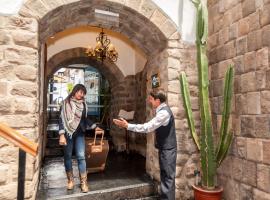
Casa San Blas Cusco Exquisite By Xima

Gran Hotel Bolivar Lima

Costa del Sol Wyndham Cajamarca

Hotel Britania Miraflores
Compare travel cost and expenses in specific cities in peru 2024.

Roberto Moore
- digital nomad and photographer (36 years old, zodiac sign: gemini).

The Ultimate Peru Itinerary: From One Week to One Month of Travel
By Author Arakita Rimbayana
Posted on Last updated: 6th October 2023
Home to an abundance of cultural and archaeological sites, many of which are surrounded by breathtaking nature, Peru is guaranteed to exceed your expectations. And then there’s the local cuisine: many agree Peru’s culinary scene is one of the best in the world.
Whether you’ve got a week or two weeks in Peru (or perhaps even more), there’s plenty of time to explore the country’s famed archeological sites, hit the beach, or head into the jungle, all the while treating yourself to the country’s unique offering of traditional coastal and Andean dishes.
Machu Picchu is on everyone’s list when it comes to a vacation in Peru, and it’s to understand why. In fact, all of our four Peru travel itineraries include a visit to what is by far the country’s premier tourist attraction. But there’s plenty more to add to your Peru vacation itinerary.
Often forgotten, northern Peru also offers big adventure, from surfing to archeological sites that are significantly older – and perhaps more impressive – than better-known Machu Picchu.
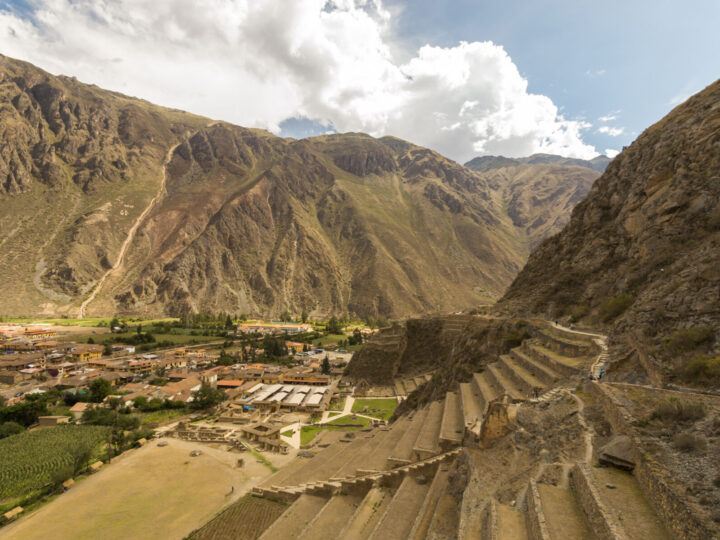
Luckily, these different Peru itineraries can help you explore the country’s most acclaimed destinations and get you off the beaten trail.
Click to navigate this article:
What should you consider before planning your itinerary?
- Altitude sickness is no joke in Peru , especially if you plan to hike or trek. Our itinerary focuses on helping you adjust to the altitude slowly while exploring the best of Peru. Generally, your body needs two weeks to get used to it completely. However, a couple of days of adjustment is better than nothing. Drinking plenty of water and having enough sleep usually help with altitude sickness. You can also consume coca leaf tea and apply herbal oil made for this type of sickness; both are available in most local markets in Peru. Alternatively, consult your doctor before departing your home country as they can prescribe you medication, such as acetazolamide, to ease symptoms of altitude sickness. It’s worth noting that eating spicy, sour, and greasy seafood combined with alcohol can exacerbate the symptoms of altitude sickness. Drinking a cup of coca or muña tea in the morning and after a big meal is one of the known remedies for stomach discomfort.
- Instead of doing both the Colca Canyon hike and the Inca Trail, it’s best to choose only one, no matter how long your itinerary is. There are so many cool things to do in Peru other than just trekking, and it would be a loss to miss them while you’re here. Besides, both trails are strenuous – especially considering the altitude – and you may end up spending the rest of your vacation recovering – rather than enjoying Peru.
- Different regions in Peru usually have different weather conditions. For example, Arequipa is a high-altitude desert where the sun is quite intense, yet Lima and its shores have their own microclimate where winter days are mostly cloudy, but it almost never rains. With that in mind, before you finalize your itinerary, it’s worth reading our article on the best time to go to Peru to learn when’s the best time of the year to travel there.
- Peru is an affordable destination. Dining at a fancy restaurant generally costs less than $50 USD for two, even in the capital city, Lima, while you can expect to spend around $70 USD per night for a decent mid-range hotel, or around $15 USD per night for a bed in a dorm room. Transportation is also very affordable: flights between Lima and Cusco can cost as little as $100 USD one-way, while a bus covering this route can cost as little as $45 USD. As a result, you can cover a lot of distance during even a shorter trip. Read out complete guide to how much it costs to travel in Peru for more information.
- There are only a few direct domestic flights within Peru that don’t travel through Lima . Most flights have at least one stop in the capital city. There are plentiful bus routes throughout the country, although many routes wind through the mountains and it’s wise to always pay for a more expensive bus company, as cheaper operators can be dangerous; we recommend using companies such as Cruz del Sur , Oltursa , TEPSA , Movil and Civa for their higher safety credentials. Bus Bud is a great site for finding bus tickets before you travel, but they are often cheaper bought at the bus station directly. If you have significant issues with motion sickness, do bring medication.
- Public transport in Peru is accessible and affordable. Bus routes pass each city’s popular places, while taxis are cheap, too. A one-kilometer trip usually costs around S/4 ($1 USD) or less. Note that most taxis are unmetered, so it’s best to agree upon the fare before you get into one.
- Packing for your trip to Peru depends a lot on what you plan on doing. To visit Machu Picchu, pack light and comfortable clothing, alongside a waterproof jacket as there’s a high chance of rain. Medication to help you deal with altitude sickness (and motion sickness if you plan on taking long bus rides) is always helpful. Sunblock is very important, particularly in high-altitude destinations such as Cusco where the sun is more powerful. Packing a wide-brim hat is also useful. Check out our complete South America packing list for more details.
Planning Your Trip to Peru?
Save time, stress & money with a customized travel itinerary planned for you by a Peru expert
One week in Peru
Overview of this one-week Peru itinerary:
- Days one and two: Cusco and the Sacred Valley
Days three and four: Machu Picchu
Day five: cusco, days six and seven: lima.
One week in Peru is enough to explore Machu Picchu and the former capital of the Inca, the historic city of Cusco before heading back to Lima for a final few days on the coast.
Day one: Cusco
Instead of Lima, make Cusco your first stop in Peru. Landing here only requires a further one-and-a-half-hour flight from the capital – and which is definitely the best way to get from Lima to Cusco. And it’s worth the chance to dive into the cultural highlights right away. Cusco also offers some of the best tour companies for Machu Picchu.
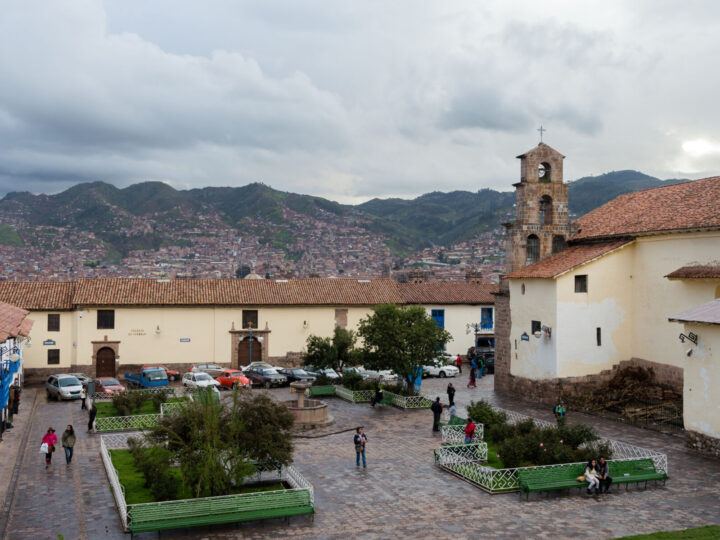
Spend your first day in Cusco taking things nice and easy; at 3,400 meters (around 11,000 feet) above sea level, this city can leave you feeling breathless. Adjust to the altitude and the low oxygen levels by exploring the old town – the focal point of this city – on foot.
Head to the Museo Inka (Inca Museum) to explore over 10,000 Inca artifacts including mummies and gold figurines, as well as the Museo de Arte Precolombino (Museum of Precolombian Art) to admire gold and silver ornaments, some of which date as far back as 1250 BC.
End your walking tour with a visit to the cathedral , where you can find painter Marcos Zapata’s famous rendition of Leonardo da Vinci’s The Last Supper, just this time featuring a guinea pig as part of the feast.
If you’re still feeling good, take the 15-minute walk uphill to the Sacsayhuaman site , a walled complex that served as both a temple and fortress for the Inca and has fantastic views of the city. An easier alternative is a taxi ride from the city; expect to pay around S/10-25 ($2.5-6.3 USD), although the exact fare depends on which road is accessible on that day.
Where to stay in Cusco: Promising affordable comfort in a charming setting, El Mercado ($210 USD double) is a perfect getaway in the city center. The 32 bedrooms are decorated with modern furnishings and artwork, adding a modern twist to a historic casona .
Where to stay in Cusco on a budget: Few places offer the degree of comfort and affordability as MOAF Boutique Hotel ($80 USD). The rooms are bright thanks to plenty of natural light and have modern furnishings and pleasant neutral decoration. This helps to enhance the rooftop views available in some bedrooms, as well as in various communal areas.
Day two: The Sacred Valley
On your second day, it is time to explore the different attractions of the Sacred Valley , where the Urubamba River brings life to otherwise barren land. Take a colectivo (a public van), bus, or taxi from Cusco to the Sacred Valley and the town of Pisac . The former is the cheapest and easiest option; you’ll find they leave every ten minutes or so from Puputi Street, and cost between S/4-10 ($1-2.5 USD).
Pisac is a peaceful little town where you can hike (or take a taxi) to a magnificent Inca fortress that sits in the hills above. The views of the Sacred Valley from the site are mesmerizing. Located only an hour away from Cusco and also home to a busy daily market (although it’s best visited on a Sunday), Pisac is one of the best day trips from Cusco.
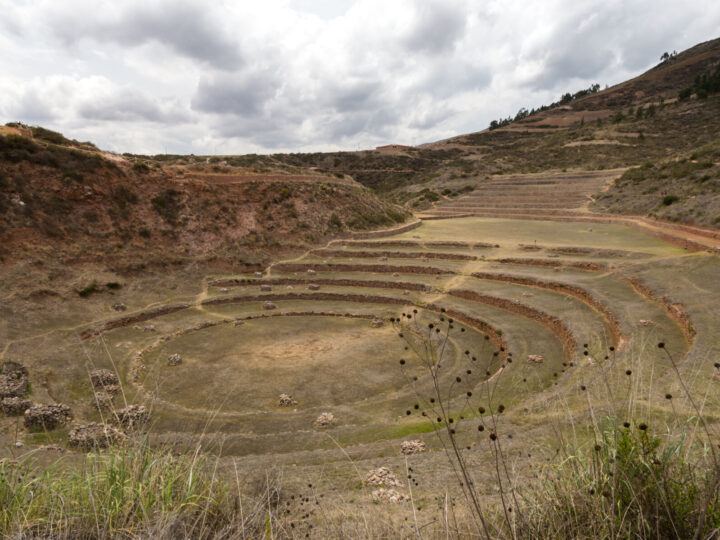
Other great options in the Sacred Valley are Moray , a series of concentric circular stone terraces that were used for testing out growing crops in different conditions, as well as the Salinas de Maras (Maras salt pans), where local people have panned for salt for hundreds of years. You can take local transportation to get to them, or book this tour that’ll take you to each.
From Pisac in the Sacred Valley, you can return to Cusco or continue downriver to Ollantaytambo , another picturesque town home to further archeological sites, as well as horseback riding, rafting and hiking tours. The train to Machu Picchu is available from both.
Where to stay in Ollantaytambo: Right next to the train station, but home to a lush garden and suntrap terrace, El Albergue ($142 USD double) is a tranquil place to while away the evening. They also have a fantastic on-site restaurant that cooks up ingredients from the hotel’s organic vegetable garden.
Where to stay in Ollantaytambo on a budget: Rustic but clean bedrooms are the norm at the affordable Picaflor Tambo Guest House ($42 USD double) run by owners who will ensure you have the most comfortable stay possible.
Head northeast along the train to reach Aguas Calientes , a small town at the base of Machu Picchu and which is filled with bars, restaurants, and markets. The train ride from Cusco to Aguas Calientes takes four to five hours, while the one from Ollantaytambo only takes one and a half hours.
If you choose the latter option, you can spend your morning visiting Ollantaytambo’s archaeological sites before departing and the afternoon in Aguas Calientes relaxing in your hotel, soaking in the thermal baths that give the town its name, or even checking out the local butterfly sanctuary .
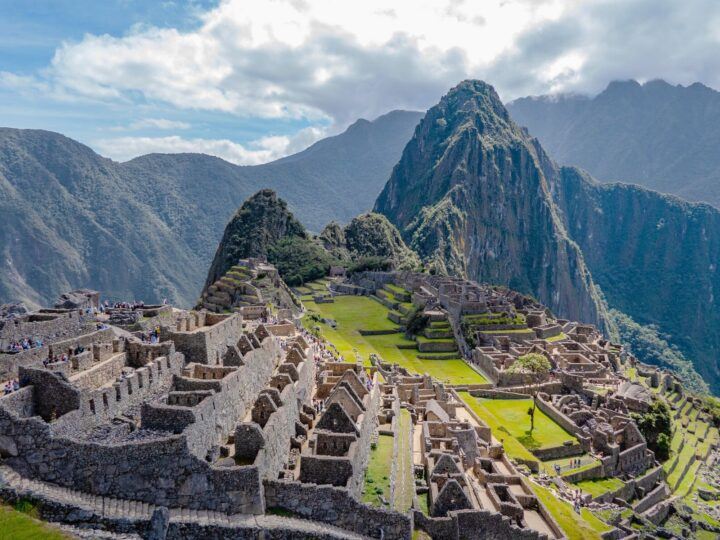
The next day, get up bright and early to board the earliest bus from Aguas Calientes to Machu Picchu – at 5:30 am. By doing this, you can expect to be one of the first to arrive at the site. What a treat: there’s nothing like enjoying your first view of the ruins accompanied by little else than the sound of birdsong.
For the best weather – and for a clear, unobstructed view of the site’s magnificent stonework – read our guide to the best time to visit Machu Picchu and Peru in general.
Feeling adventurous? Eschew the bus and instead hike from Aguas Calientes up to the entrance of Machu Picchu.
However, depending on your fitness level, the hike can take between one and two hours – so start early if you want to see the site at its quietest.
Be aware when planning your trip to Machu Picchu that you must book tickets well in advance as there is a limit on the number of people who can enter the site per day. Your ticket gives you four hours within the grounds, and it generally takes around two hours to explore Machu Picchu.
Note that it’s now mandatory to visit with a guide, which you can hire at the entrance to the site, although you’ll have more control over the language they speak if you book with a tourism agency in Cusco.
It’s another couple of hours to your visit if you plan to hike up Huayna Picchu, too (just note you’ll need to buy a ticket with permission to visit Huayna Picchu in order to do this). This hike is strenuous, but the views across the entire site are a highlight of any trip to Machu Picchu.
It can be pricey visiting Machu Picchu, so make sure to read about how much it costs to visit the Inca citadel before planning your trip.
Return to Cusco in the evening by train.
Spend one last day exploring historic sites, as well as enjoying the city’s culinary traditions. Explore the imposing buildings of the formerly impressive Inca temple of Q’orikancha, join tourists and locals alike for locally-brewed beer in Cholos, head to the ChocoMuseo for a workshop on chocolate-making and spend an evening sampling heady pisco cocktails and listening to lively local music at the Museo del Pisco .
Wrap up your Cusco itinerary by visiting the Mercado San Pedro (San Pedro market), where you’ll find sweaters, bags, and knick-knacks made from Alpaca wool. While these are also available in other markets around the city, you’ll find them for the best prices in San Pedro.
Head back via plane to the capital city, Lima . Two days in Lima is just the right amount of time in order to get a glimpse of life in this dynamic city. Head to the trendy Barranco neighborhood , home to uber-chic cafes and chic bars in restored mansions, with all of this just a few steps away from the beach.
For an insight into the grittier side of Lima, head by taxi to the Callao neighborhood where Lima’s former shipping district and one of its most dangerous places has been transformed through street art and shops selling local arts and crafts – just don’t stray far aware from local hub Callao Monumental as the area remains dangerous for visitors.
Don’t miss the city’s renowned dining scene. For haute cuisine, head to Barranco and the world-famous Central , or dine on Nikkei (a Peruvian take on sushi) at Maido in Miraflores.
Any visitor to the city can’t miss the quintessential Peruvian dish: ceviche , so head to La Mar or Punta Azul in Miraflores to sample your newest favorite dish – washed down with a crisp glass of white or a pisco sour. After all, Peru is the best country in South America for affordable yet outstanding dining .
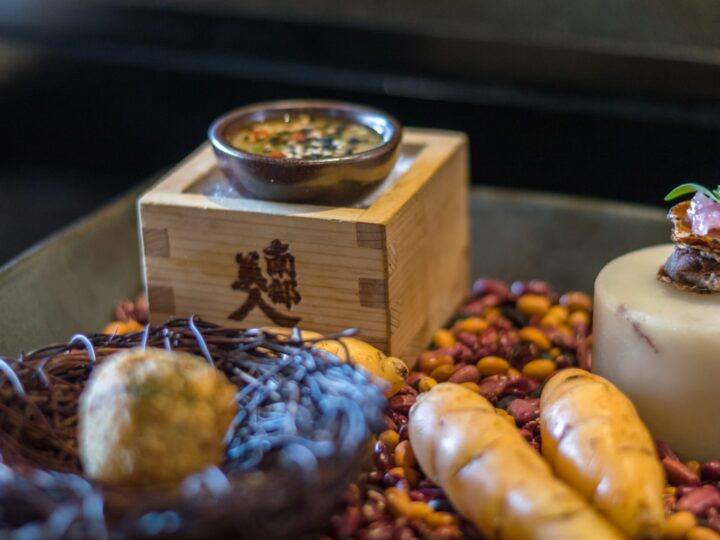
Spend your last days here museum-hopping (the Museo Larco is one not to miss), exploring the old town around the Plaza Mayor , or up the ante by testing the waves of the Pacific Ocean on a surfboard.
Where to stay in Lima: The Barranco neighborhood is known as a place of poets, artists and creatives, so there’s nowhere better to stay than in Second Home ($135 USD double), a grand, eight-room guesthouse in the former home of Peruvian sculptor Victor Delfin, who you might even spot pottering around the house if you’re lucky.
Where to stay in Lima on a budget: One of our favorite places to stay when we’re in Lima, the Lighthouse Bed and Breakfast ($40 USD double) is run by a Peruvian-British couple and offers a handful of doubles with private bathrooms in a pleasant residential area in Miraflores. The terrace out the back where breakfast is served is a gorgeous place to while away the day.
Where to stay in Lima on a budget: Located in Miraflores and offering a youthful, friendly guide Selina Lima ($53 USD double) is our budget pick. (read our comprehensive Selina Lima review ) . Even though it’s a hostel, comfortable and stylishly presented private rooms with private bathrooms are available.
Got more time to spend in Cusco? Read our Cusco itineraries article for trips from three to ten days in length.
10 days in Peru
Overview of this 10-day Peru trip planner:
- Days one through three: Cusco and the Sacred Valley
- Days four through seven: The Inca Trail
Day eight: Machu Picchu
Days nine and ten: lima.
10 days in Peru is the perfect length of a trip that allows you to add the Inca Trail to your Machu Picchu trip. Follow the itinerary above but, instead of taking the train straight to Aguas Calientes on day three of the itinerary above, take a hiking tour of the Inca Trail to Machu Picchu .
Days four through seven: Inca Trail
The trails built by the Inca throughout the Andes were used to connect what was once a vast empire to its territories across Peru and into neighboring Ecuador, Bolivia and Chile.
Known as the Qhapaq Ñan (Royal Road), many of these paths remain today and can be explored on foot – much the same way as they would have been used by the Inca royalty and pilgrims.
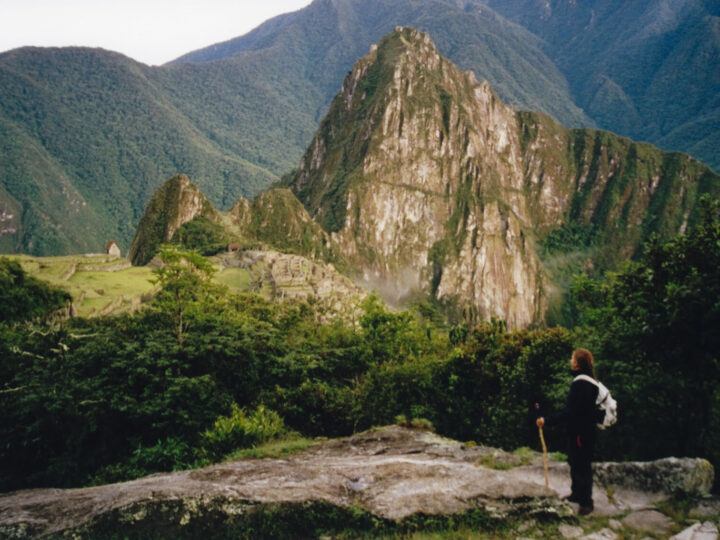
Hiking to Machu Picchu on the 40-kilometer (25-mile) Inca Trail generally takes four days and joining a guided tour is required. If you see three-day Machu Picchu tour operators, it is likely only for the fittest travelers, or the tour only includes part of the trail.
We recommend reading our extensive guide on what you need to know about hiking the Inca Trail before signing up for any tour and reading our comparison of the Inca Trail and Salkantay Trek (another popular trek to Machu Picchu) to understand our options.
This hike is strenuous and can be dangerous in some parts. Even for experienced hikers, it’s challenging, so listen to your body, take your time, and pause if you need to.
The good news is you don’t need to pack food or a tent as those will be provided by the tour company. Some companies even offer a porter service, so you don’t need to carry anything during the entire hike!
The Inca Trail leads directly to Machu Picchu through what is known as the Sun Gate – named as such because the sun’s rays pass through here on the summer solstice. The view from here is also legendary and a privilege only to those who reach the site from the Inca Trail.
Once you’ve explored this magnificent stone fortress, descend to Aguas Calientes via the path or take one of the public buses from the gate of Machu Picchu.
Depending on what time you get to town and your train schedule, you can either spend the night in Aguas Calientes or go directly to Cusco, where you’ll find flights to Lima.
As per the previous itinerary, spend the last two out of your ten days in Peru tasting local dishes, visiting museums, or simply relaxing on the beaches of Lima.
Two weeks in Peru
Overview of this two-week Peru vacation itinerary:
Days one and two: Lima
Day three: pisco and ballestas islands, day four: nazca, days five to eight: arequipa and the colca canyon, days nine and ten: cusco and the sacred valley.
- Days eleven and twelve: Machu Picchu
- Day thirteen: Cusco
- Day fourteen: Lima
With two weeks in Peru, you can explore four main destinations – Lima, Nazca, Arequipa, and Machu Picchu – and famous attractions near to these main draws.
Instead of going straight from Lima to Machu Picchu, spend two days exploring Lima as you would on the last days of the previous itineraries, and then take a day trip from Lima to the Ballestas Islands and Nazca.
Take the bus four hours south to Pisco , one of the most popular towns within striking distance of the city because of – well, you can guess from its name – Pisco, the famous Peruvian spirit. In this town, tourists can visit vineyards and sample their products.
However, if you’re short on time, head directly for Paracas , one of the most popular destinations to visit in Peru . This is where the boat trip to Ballestas Islands, aka the Peruvian Galapagos, starts.
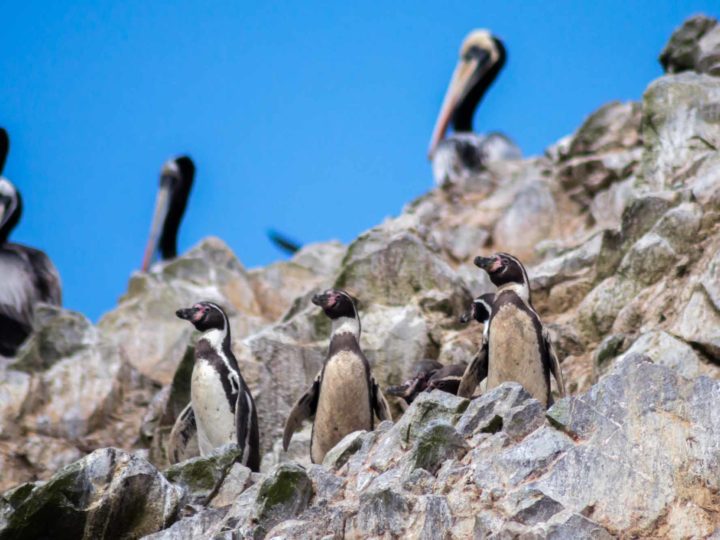
While they’re certainly not as impressive as their Ecuadorian namesake, the Ballestas Islands are still full of a rabble of wildlife, that can include everything from Humboldt penguins to sea lions and pelicans.
Since the entire archipelago is a national reserve, you’re not allowed to swim or disembark on any of the islands, but your two-hour boat tour will give you front-row seats to the raucous melee of sea life that lives upon them.
Book with a local tour company on the day or in advance here .
Stay overnight in Paracas, ready for an early bus the next morning.
Where to stay in Paracas: Located just meters from the beach, the chic Casa Paracas ($108 USD double) will make you wish you had more time to hang here and soak up the sunshine. All rooms have their own private balconies, as well as much-appreciated air conditioning.
Where to stay in Paracas on a budget: Basic but budget-friendly, Atenas Backpacker Hospedaje ($18 USD double) is an extremely cozy home-away-from-home, with plenty of communal spaces and an extremely welcoming atmosphere.
Your next stop is Nazca , a four-hour bus journey from Paracas. This is where you’ll find the massive geoglyphs, the Nazca Lines , whose origins – and purpose – remain one of the greatest mysteries in the world.
For the best views of these remarkable lines, which are in the form of hummingbirds, spiders and bold geometric patterns, take a flight over the desert from the airport in Nazca.
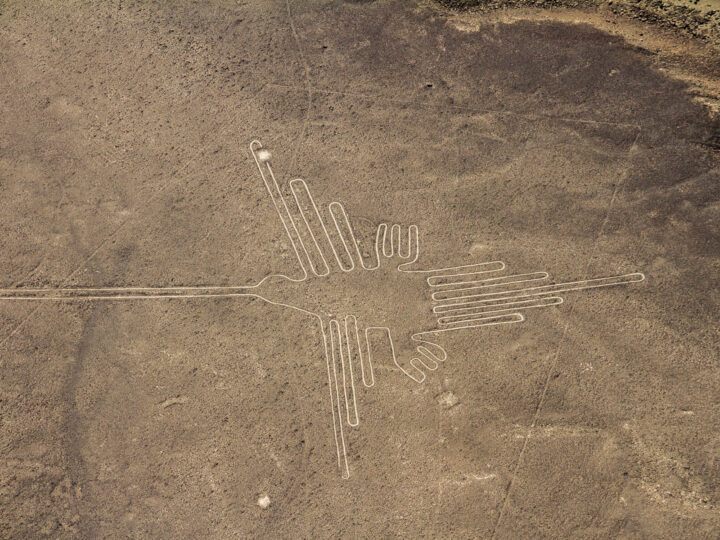
There’s not much to do in Nazca besides wandering around the Plaza de Armas, so get an early night ready for tomorrow.
Where to stay in Nazca: It’s no looker, but Nasca Travel One Hostel ($22 USD) has everything you need for a comfortable one-night stay and is extremely clean and comfortable, particularly as it’s a little away from the town center meaning you’re guaranteed a peaceful night’s sleep.
A six-hour bus journey from Nazca brings you to the White City, Arequipa . Situated in the volcano-studded highlands of southern Peru at 2,335 meters above sea level, Arequipa is your first introduction to altitude, so take it easy once you get off the bus.
Arequipa is a striking place: Volcán Misti stands tall above the city, and the buildings around the center are built using dazzlingly white volcanic stone.
Spend the remaining part of the day exploring Arequipa’s old town – the Monasterio de Santa Catalina , a vast and beautiful nunnery, and the seventeenth-century cathedral are two not to miss – before an evening tasting the lip-smacking rocoto relleno (stuffed spicy pepper), a traditional Arequipan dish.
For more highlights of the city, read this article about things to do in Arequipa and our guide to the best places to stay in Arequipa .
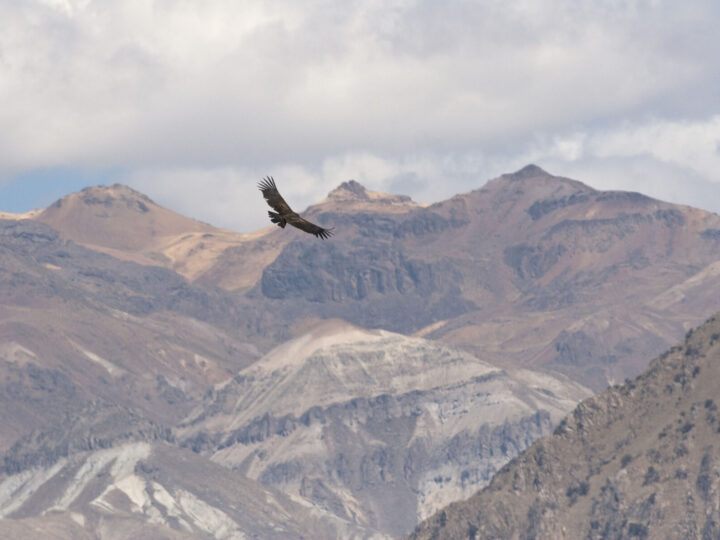
On the afternoon of day six, hop on a minivan to Chivay (3.5 hours) and then onto Cabanaconde (1.5 hours) and spend the night there in preparation for the Colca Canyon trek .
The next day, embark on the two-day Colca Canyon trek , which starts from Cabanaconde and heads down into the bottom of the canyon.
Unlike the Inca Trail where you sleep in tents, you will be spending nights within rustic lodgings inside Sangalle, the oasis town at the bottom of the canyon, offering you a soft bed and a pleasant night’s sleep. But don’t be fooled: this hike is challenging.
After a day hiking into the canyon the only way back out is up – a climb of 1,200 meters (4,000 feet) over a five-kilometer (three-mile) stretch.
Return to Arequipa by bus for an overnight bus to Cusco or for a final night in the city before a bus the next morning.
Where to stay in Arequipa: Set in a charming old house with a gorgeous courtyard for a leisurely cup of coffee or cold beer, La Hostería Boutique Hotel ($72 USD) double) is one of Arequipa’s (and Peru’s) most luxurious hotels . A pool, sun terrace and spa facilities are just some of the highlights here.
Where to stay in Arequipa on a budget: The family-run La Casa de Margott ($30 USD double) has clean and spacious rooms, as well as a pleasant roof terrace for lounging in.
It’s a fair distance from Arequipa to Cusco, so you can expect a ten-hour bus journey to get you from the coastal highlands and up into the Andes.
Unlike flying, which can lead to altitude sickness due to the rapid change in altitude, taking a bus to Cusco is a much gentler form of transport and gives you the opportunity to view some of the country’s incredible mountain landscapes.
Finish your itinerary by following the one-week in Peru itinerary, just shaving off a day in Lima at the very end.
Adapting this itinerary: Want to hike the Inca Trail instead? Spend days fix and six in Arequipa, then head to Cusco for the Inca trail for days seven through ten, with day eleven at Machu Picchu. Spend days twelve and thirteen in Cusco, before heading back to Lima on day fourteen.
One month in Peru
Overview of this one-month Peru backpacking itinerary:
Days three and four: Trujillo and Huanchaco
- Days six and seven: Cajamarca
- Days eight to ten: Chachapoyas
Day eleven: Lima
- Day twelve: Pisco and the Ballestas Islands
- Days thirteen: Nazca
Days fourteen to seventeen: Arequipa and the Colca Canyon
- Days eighteen to nineteen: Puno and Lake Titicaca
- Days twenty to twenty-one: Cusco and Sacred Valley
- Days twenty-two to twenty-five: The Inca Trail
Day twenty-six: Machu Picchu
- Day twenty-seven: Cusco
- Days twenty-eight to thirty: Puerto Maldonado
Do you have one whole month to spend exploring Peru? Lucky you: you’ve got time to add northern Peru to your itinerary. In addition, a slower pace of travel means your body will have the time to adjust to the altitude changes well.
One month in Peru is also plenty of time for seeing the most unmissable destinations in Peru: going to the north but without excluding Machu Picchu or the Inca Trail, as well as stopping in Pisco and the Ballestas Islands and Arequipa, plus a trip into the jungle in Puerto Maldonado.
Touch down in Peru’s lively capital city, Lima . While it might be packed with traffic and a little rough around the edges, this city is a place you’ll soon fall in love with.
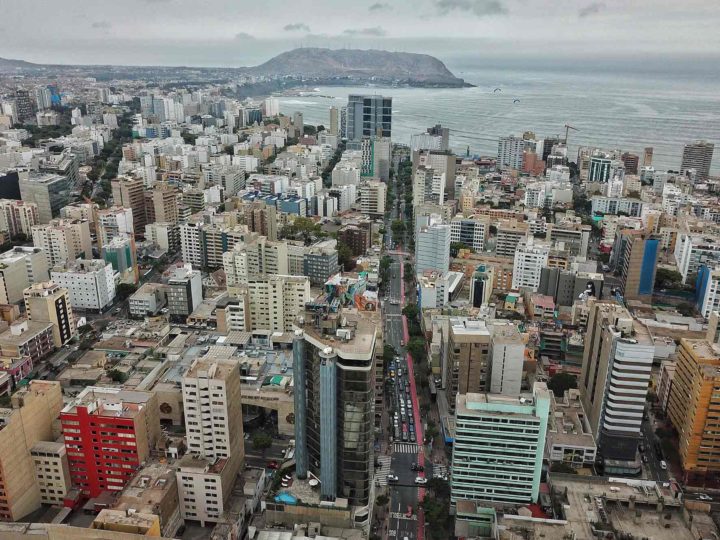
Spend your days museum-hopping (the Museo Larco is one not to miss), exploring the old town around the Plaza Mayor , or up the ante by testing the waves of the Pacific Ocean on a surfboard.
You can also head to the trendy Barranco neighborhood , home to uber-chic cafes and chic bars in restored mansions, with all of this just a few steps away from the beach.
Any visitor to the city can’t miss ceviche, so head to La Mar or Punta Azul in Miraflores to sample your newest favorite dish – washed down with a crisp glass of white or a pisco sour.
From Lima, it’s a grueling nine-hour bus journey to reach Trujillo .
A better alternative is to take one of the multiple one-hour, forty-minute flights from Lima to the airport in Trujillo, which is an easy taxi ride into the city.
Trujillo is a city on few travelers’ bucket lists – but the intrepid who make it here are in for a treat. Many are unaware of the civilizations that predate the Inca Empire, but the archeological sites they left behind are often just as remarkable as Machu Picchu – made more so by the relative lack of visitors at these destinations.
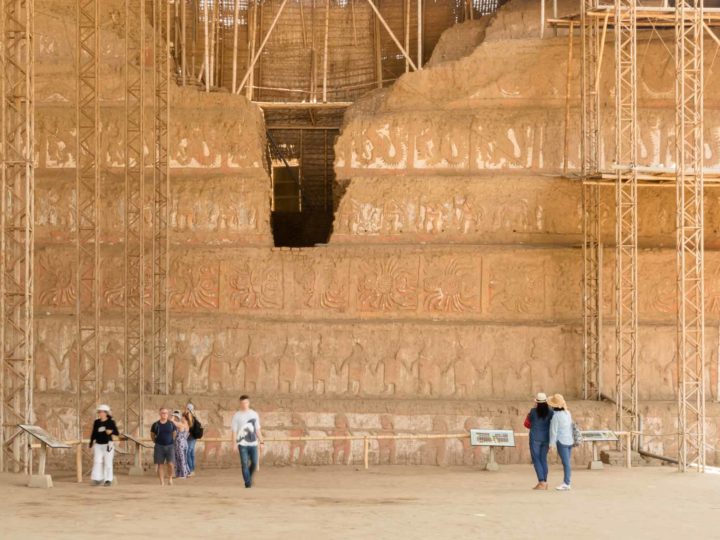
Spend half a day learning about Peru’s remarkable past by taking a bus to Chan Chan , an archeological site just five kilometers away from the city of Trujillo.
Chan Chan was once the capital of the Chimú Empire and is the largest adobe brick city discovered anywhere on earth, having been home to 60,000 people at its apogee around 850 AD.
At the heart of this city was a fortress where temples once paneled with gold, and courtyards and walls decorated with finely carved fish and other symbols of the sea can still be explored.
Another unmissable site to explore in the region is that of the Huacas de Moche . The two pyramids known as the Huaca del Sol and Huaca de la Luna date from 500 AD and are adorned with polychrome friezes, which have been remarkably well preserved and depict the sacrificial rituals with which the Mochica civilization has become associated.
Best explored by a tour from Trujillo, they’re an easy half-day trip from the city.
Alternatively, spend a day on a tour of the Complejo Archeólogico El Brujo (The El Brujo Archeological Complex), a series of small pyramids in which the mummified remains of the Señora de Cao, a shamanic leader, were discovered.
Her body – bearing tattoos of fish, snakes, and spiders – as well as gold and silver artifacts found within her tomb, are on display in the on-site museum.
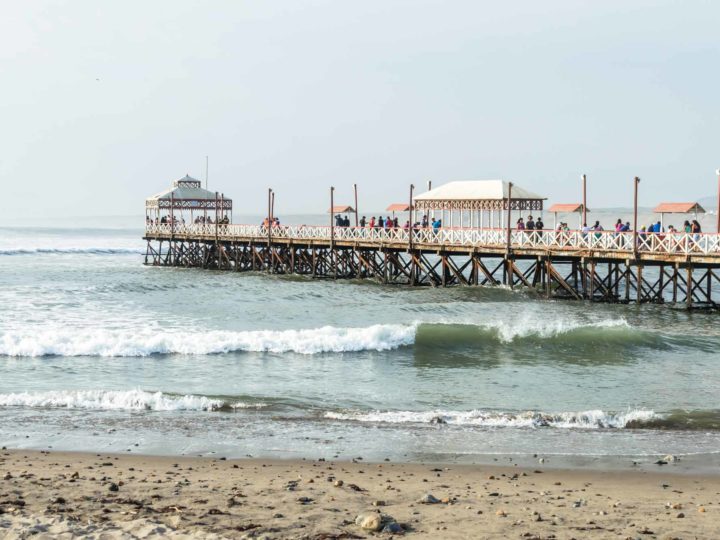
For a relaxing afternoon, consider dropping into Huanchaco , a beachside village a 45-minute bus journey north of Trujillo. Oozing buena onda (good vibes), it’s a great place to swim or surf. Read more about this Peruvian beach town in our complete guide to Huanchaco .
Where to stay in Trujillo: Located not far from the Plaza de Armas, Tierra Viva Trujillo ($100 USD double) might be located within a soulless tower block, but the hotel’s design and clean but chic bedrooms make up for this fact.
Where to stay in Huanchaco: Accommodation options abound, including the glorious tranquil yoga hostel, ATMA $7 USD dorm, $21 USD double), with cozy rooms and a very chilled vibe.
Days five and six: Cajamarca
Your next stop is Cajamarca , an historic Andean town sitting 2,750 meters (9,000 feet) above sea level and a six-hour bus journey east of Trujillo. Home to beautiful buildings constructed during the Spanish conquest, the city’s roots go much deeper.
Head to the El Cuarto del Rescato , the only remaining Inca building in the city and where the Inca emperor, Atahualpa, was captured and later executed by the Spanish and follow this with a trip to the Casa Museo Nicolás Puga, a privately owned museum showcasing 2,000-year-old textiles and other incredible pre-Hispanic treasures.
Adapting this itinerary: Want a more relaxing few days? Head north along the coast (10 hours by bus from Trujillo) for a few days of glorious beach time in Máncora, where the sun shines all year long, and the turquoise water temperature is pleasant for swimming and a popular destination to learn surfing or kitesurfing. A favorite among backpackers thanks to its wild nightlife, Máncora can be replaced with the neighboring surf enclave of Lobitos (1.5 hours south) or the tranquil – and pricey – luxury resorts of remote Las Pocitas. Try the truly remote bungalows at Yemaya ($126 USD double), which are right on the beach.
Spend a day outside of the city by taking a bus to the Ventanillas de Otuzco , a pre-Inca necropolis where the Cajamarca people were buried in holes cut into the volcanic rock. On your way back, visit the Baños del Inca, the Inca thermal baths that are still in use today for a relaxing soak.
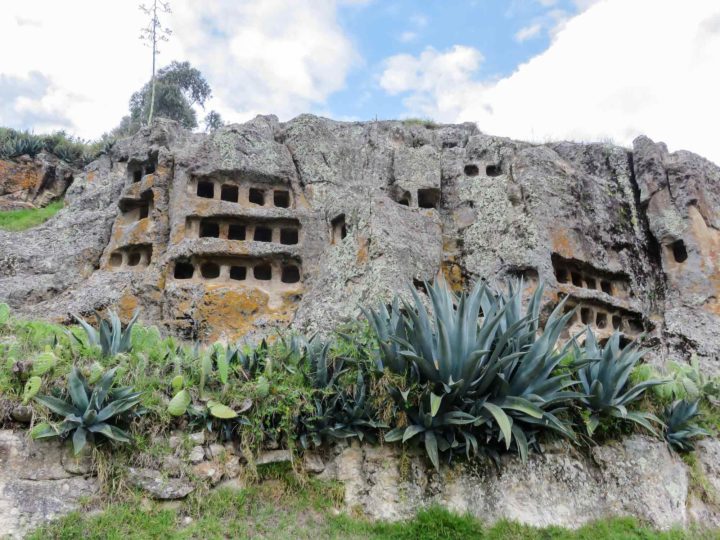
Bear in mind that the bus ride up the mountains is a rough drive, and you might prefer to fly instead – although it won’t save you a huge amount of time. All flights go via Lima (1.5 hours) before heading to Cajamara (1 hour 15 minutes).
Where to stay in Cajamarca: Just off the Plaza de Armas and with a beautiful, flower-filled courtyard, El Cabildo Hostal ($35 USD double) promises comfortable, if somewhat old-fashioned, accommodation.
Where to stay in Cajamarca on a budget: Extremely comfortable and with a location good for both the Plaza de Armas and the bus station, the family-run Chakra Runa Backpacker ($12 USD double) is guaranteed to offer a warm welcome.
Days eight, nine and ten: Chachapoyas
Deeper into the Andes is the market town of Chachapoyas . Getting here isn’t easy: the most direct route is a ten-hour minibus journey, through damp cloud forest and alongside steep mountainsides. Though surrounded by spectacular views, this route is not for the fainthearted.
With that said, Chachapoyas is worth visiting for one particular reason: Kuélap. This site is known as the Machu Picchu of Northern Peru thanks to its mountain-top location – accessible only via cable car, minibus, or a grueling four-hour hike – and the fact it’s the largest ancient stone structure in Peru. It also pre-dates Machu Picchu.
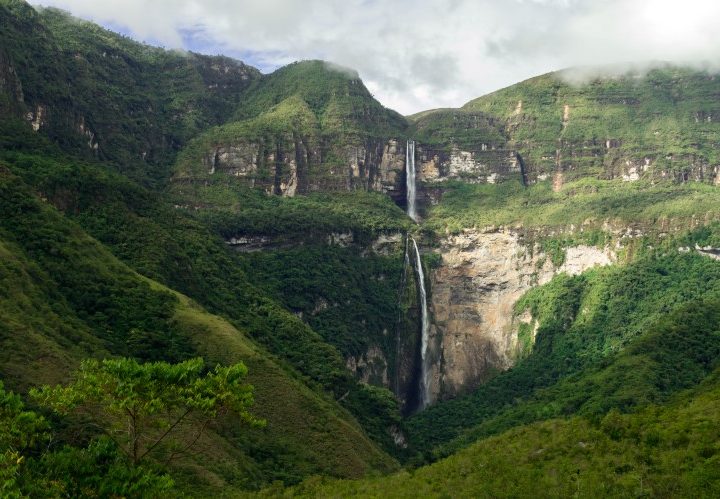
Read more about this magnificent fortress city in our guide to visiting the fortress of Kuélap , which is worthy of a full-day tour from Chachapoyas.
Spend the next few days exploring other key archeological sites, such as the row of ancient sarcophagi located on a wall at Karajía or dropping in at the Museo de Leymabamba , where 219 mummies from the Chachapoya people are on display.
Alternatively, take a bus to Cocachimba and hike to some of the tallest one-drop falls in the world, the dazzling Cataratas de Gocta (Gocta Waterfall).
Where to stay in Chachapoyas: The most luxurious lodgings in Chachapoyas are La Xalca Hotel ($100 USD), another colonial mansion with large, antique-furniture decorated bedrooms, some of which have pretty balconies overlooking the central courtyard and an extensive breakfast buffet. If you’re visiting in winter, ask for a room with carpet, not tiles.
Where to stay in Chachapoyas on a budget: The best budget option in town is Chachapoyas Backpackers Hostal ($22 USD), which has well-sized rooms, all with a private bathroom.
Take a flight with ATSA Airlines (only Monday, Thursday and Saturday; 1.5 hours) from Chachapoyas airport, or a minibus to Jaén (four hours) and a flight from there to Lima (1.5 hours).
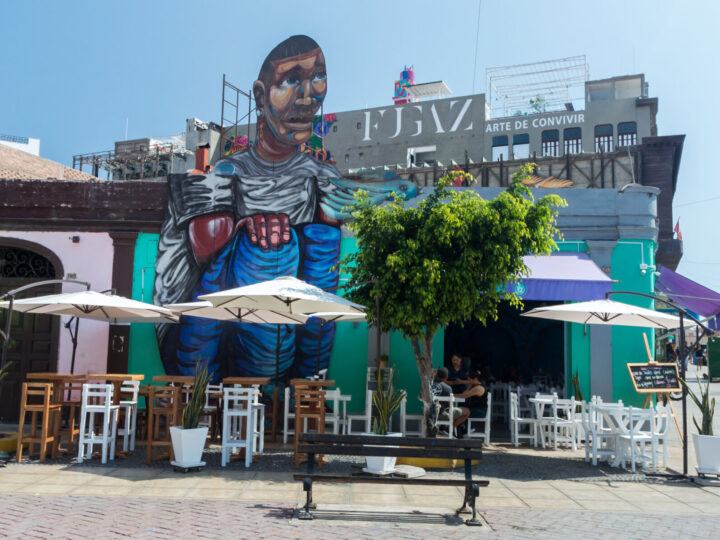
Spend the afternoon relaxing or catching up on any museums or restaurants you didn’t get a chance to visit on your first stay here.
Day Twelve: Pisco and Ballestas Islands
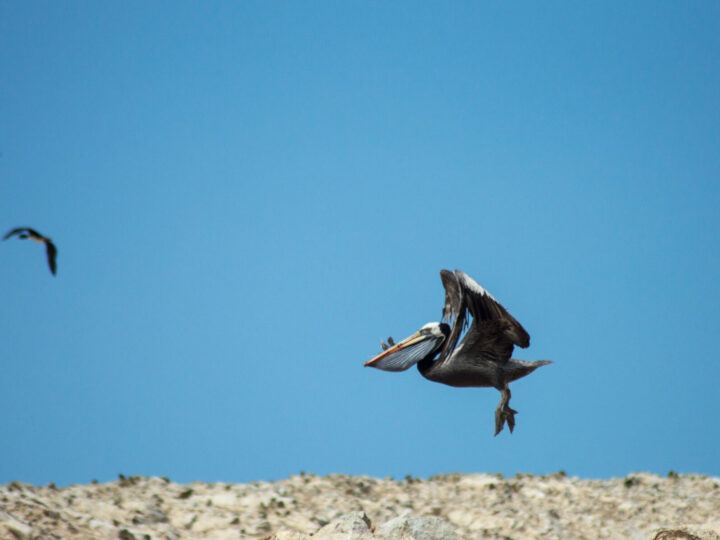
Stay overnight in Paracas, ready for an early bus the next morning.
Day thirteen: Nazca
Spend the remaining part of the day exploring Arequipa’s old town – the Monasterio de Santa Catalina, a vast and beautiful nunnery, and the seventeenth-century cathedral are two not to miss – before an evening tasting the lip-smacking rocoto relleno (stuffed spicy pepper), a traditional Arequipan dish.
For more highlights of the city, read this article about things to do in Arequipa and find out where you should stay in the White City .
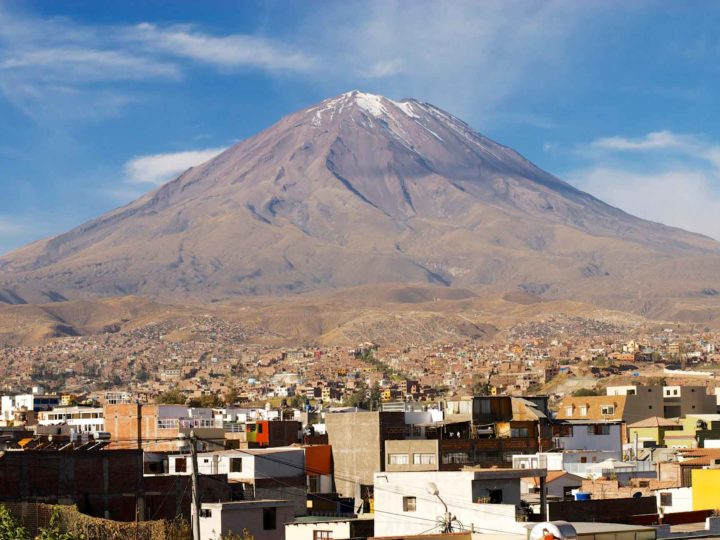
On the afternoon of day six, hop on a minivan to Chivay (3.5 hours) and then onto Cabanaconde (1.5 hours) and spend the night there in preparation for the Colca Canyon trek.
The next day, it’s time to embark upon the two-day Colca Canyon trek , which starts from Cabanaconde and heads down into the bottom of the canyon.
Return to Arequipa for a final night in the city before a bus to Puno the next morning.
Day eighteen and nineteen: Puno and Lake Titicaca
Hop on a six-hour bus that’ll promise fantastic views, especially when navigating the Salinas y Aguada Blanca Reserva Nacional, as it climbs further up into the Andes Mountains to arrive at what can seem to be the very top of the world.
At this high altitude of 3,800 meters (12,507 feet) lies Lago Titicaca, a vast lake covering more than 8,000 square kilometers and spit by the border between Peru and Bolivia. It’s Peru’s most impressive body of water – and one of the most scenic lakes in the whole of South America .
You’ll arrive in Puno , the gateway for all destinations in the Lake Titicaca area. Though small, this city houses accommodations catering to travellers.
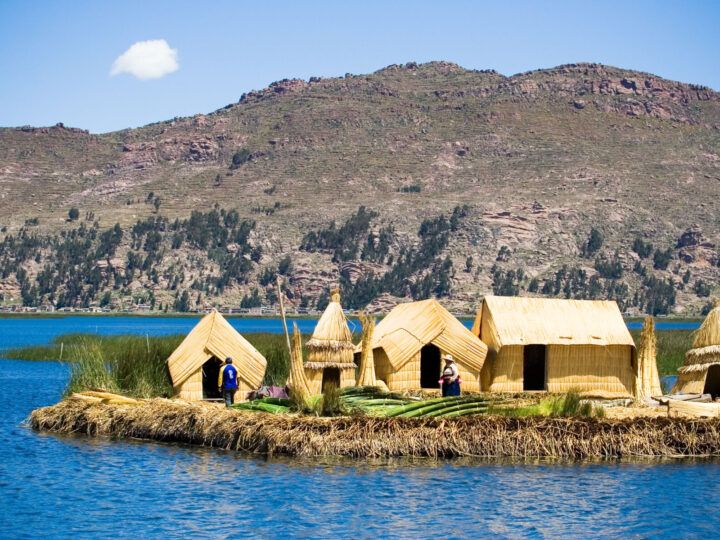
Several options for day trips from Puno are available, but the one to Uros Islands is a must. Comprising over 120 islands, this man-made archipelago is the focal point of Lake Titicaca. Also known as the Floating Islands, each of the islands is made of totora or reeds woven by hand.
You can now stay in a reed guesthouse on the islands – just bear in mind that your money won’t necessarily go to the families themselves. All Ways Travel is the only company I know who pay the communities directly and equitably.
Besides Uros, there are two main destinations on the Peruvian side of Lake Titicaca: Taquile and Amantani. Both are reachable by sailboat and have been inhabited for thousands of years.
Nowadays, they’re best known for their striking textile weaving and you can even spend a night here staying with a local family.
If you can, go further across to the Bolivian side to the Isla del Sol (Sun Island), which is crisscrossed with Inca archeological sites and promises, from every point on the island, spectacular views of Lake Titicaca.
Take your time exploring Lake Titicaca’s secluded corners before you move on to Cusco and Machu Picchu.
Where to stay in Puno: With a flower-filled courtyard and bedrooms tastefully decorated with art, you’ll feel a world away from the bustle of the city at Casa Panqarani ($40 USD double). It even has an excellent on-site restaurant.
Days twenty and twenty-one: Cusco and the Sacred Valley
You should be nice and acclimatized to altitude by now, but it’s still worth taking things easy by exploring the old town – the focal point of this city – on foot. Head to the Museo Inka (Inca Museum) to explore over 10,000 Inca artifacts including mummies and gold figurines, as well as the Museo de Arte Precolombino (Museum of Precolombian Art) to admire gold and silver ornaments, some of which date as far back as 1250 BC.
If you’re still feeling good, take the 15-minute walk uphill to the Sacsayhuaman site , a walled complex that served as both a temple and fortress for the Inca and has fantastic views of the city.
An easier alternative is a taxi ride from the city; expect to pay around S/10-25 ($2.5-6.3 USD), although the exact fare depends on which road is accessible on that day.
On your second day, it is time to explore the Sacred Valley , where the Urubamba River brings life to otherwise barren land. Take a colectivo (a public van), bus, or taxi from Cusco to the town of Pisac. The former is the cheapest and easiest option; you’ll find they leave every ten minutes or so from Puputi Street, and cost between S/4-10 ($1-2.5 USD).
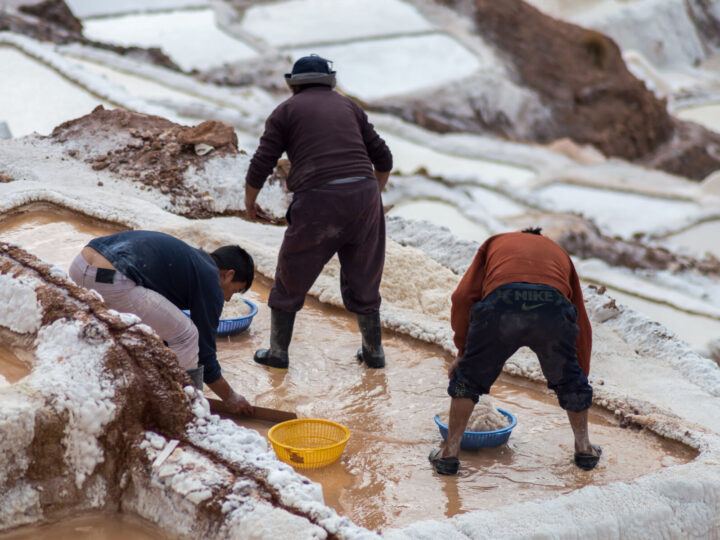
Pisac is a peaceful little town where you can hike (or take a taxi) to a magnificent Inca fortress that sits in the hills above. The views of the Sacred Valley from the site are mesmerizing.
Located only an hour away from Cusco and also home to a busy daily market (although it’s best visited on a Sunday), Pisac is one of the best day trips from Cusco.
Other great options in the Sacred Valley are Moray , a series of concentric circular stone terraces that were used for testing out growing crops in different conditions, as well as the Salinas de Maras (Maras salt pans), where local people have panned for salt for hundreds of years. You can take local transportation to get there, or book this tour that’ll take you to each.
Day twenty-two to twenty-five: The Inca Trail
The trails built by the Inca throughout the Andes were used to connect what was once a vast Empire to its territories across Peru and into neighboring Ecuador, Bolivia, and Chile.
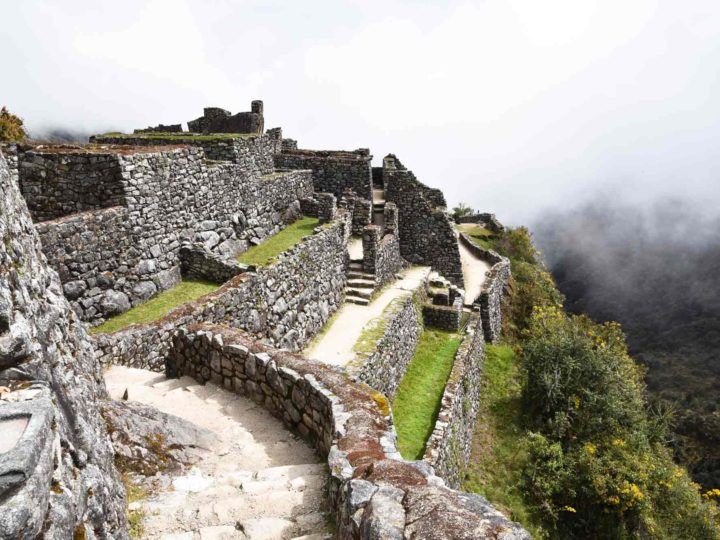
Hiking to Machu Picchu on this 40-kilometre (25-mile) trail generally takes four days and joining a guided tour is required. If you see three-day Machu Picchu tour operators, it is likely only for the fittest travellers, or the tour only includes part of the trail.
We recommend reading our extensive guide on what you need to know about hiking the Inca Trail before signing up for any tour; alternatively, if you want even more of a challenge, consider hiking the Salkantay trek instead .
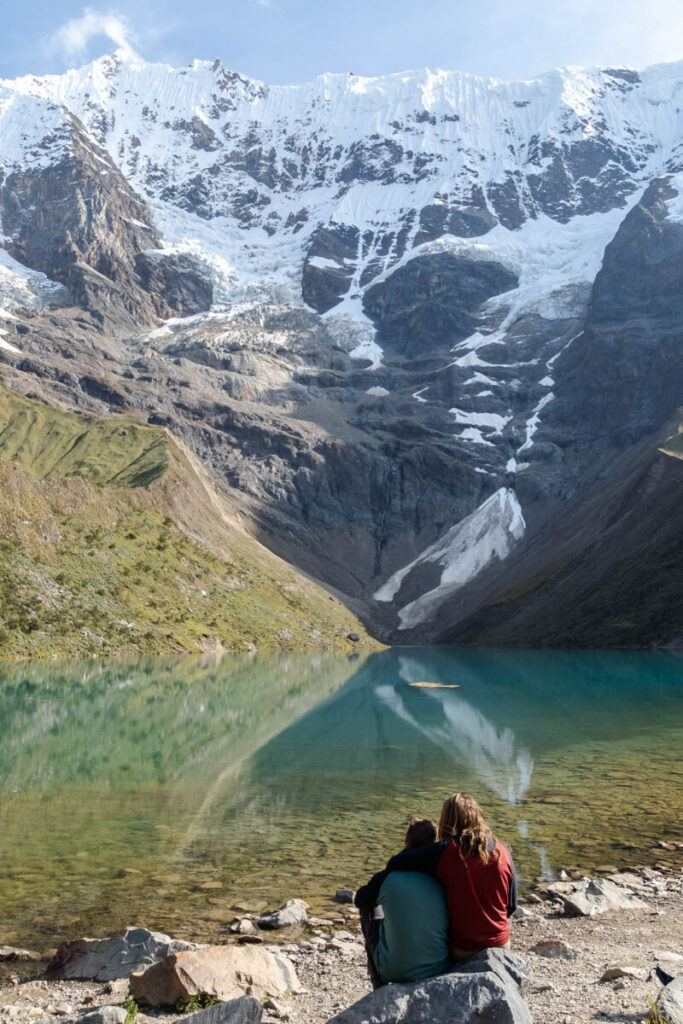
Want a cheeky 5% discount on the Inca trail or Salkantay trek?
Alpaca Expeditions are not only one of the most sustainable companies offering Salkantay and Inca trail treks to Machu Picchu, but their guides, porters and chefs are the ultimate hosts.
They’re now offering Worldly Adventurer readers a 5% discount on all of their hikes – just mention Worldly Adventurer when you enquire!
Depending on what time you get to town and your train schedule, you can either spend the night in Aguas Calientes or go directly back to Cusco.
Day twenty-seven to thirty: Puerto Maldonado
From Cusco, it’s a 45-minute flight to Puerto Maldonado , the last stop on your adventurous month in Peru.
Located at the confluence of the Tambopata and Madre de Dios rivers, Puerto Maldonado is unlike all the other regions you have explored so far: here we’re deep into the tropical rainforest, a place renowned for its rich, untouched wildlife and extremely comfortable eco-lodges, many of which are accessed solely by boat.
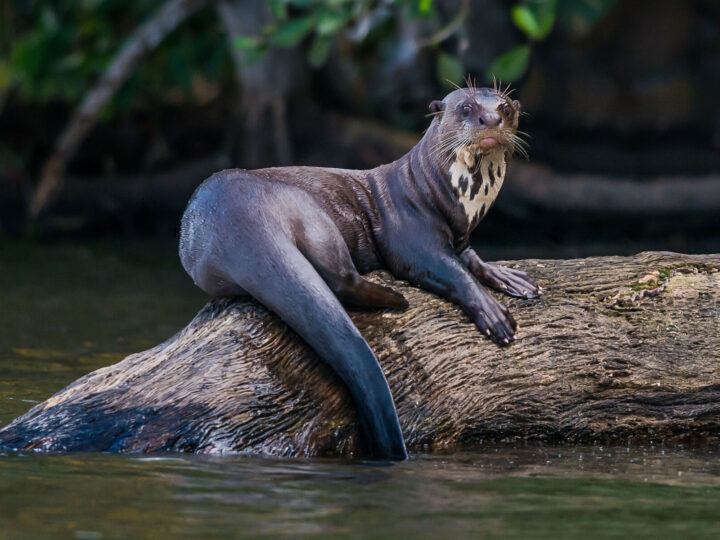
Book a three-night stay in an eco-lodge located in the hard-to-reach and strictly protected Reserva de la Biosfera del Manu (the Manu Biosphere Reserve) or in one of the cheaper lodges located in the Reserva Nacional Tambopata (TambopataNational Reserve) Wherever you stay, you can expect to spot numerous species of monkeys, caiman, capybara and, if you’re extremely lucky, giant otters.
At the end of your stay, return to Lima by plane (1.5 hours) and onto your flight back home.
Where to stay in and around Puerto Maldonado: Located in the Tambopata National Reserve, the fantastic Tambopata Research Center ($236 USD double) is the ultimate place to stay for piranha fishing, nocturnal hiking, birdwatching, ayahuasca rituals, and more.
FAQs about planning a Peru itinerary
How much does a trip to peru cost.
Excluding your flights in and out of Peru, budget travelers can keep their daily travel here below $30 USD per person. But if you plan on staying at hotels and eating at more expensive restaurants, you should budget around $50 USD per person per day. If you’re staying for two weeks in Peru, you’ll need at least $350 USD spending money for expenses outside of tickets and souvenirs.
What should you take to Peru?
Climates and weather conditions vary considerably across Peru, so your packing list will reflect this. Make sure you have light and comfortable hiking clothing, alongside a waterproof jacket for the Inca Trail and Machu Picchu.
Bring medication to help you deal with altitude sickness (and motion sickness if you plan on taking long bus rides), as well as sunblock and a wide-brim hat.
Comfortable hiking shoes, plus a pair of trainers for inside cities, are invaluable, while plenty of layers should keep you warm as you travel from the hot, humid coast up into the mountains. For more detailed information, check out our complete South America packing list .
How far is Lima from Machu Picchu?
Technically, it’s only around 500 kilometers away. But if you plan on getting to Machu Picchu from Lima by car or bus, the distance covers more than 1,000 kilometers, and it will take more than a day in a bus. The best way to reach Machu Picchu from Lima is by flying to Cusco and taking a train to Aguas Calientes.
How can you plan a trip to Machu Picchu?
Planning a trip to Machu Picchu depends on how you want to see this archeological site. If you’re wanting to hike the Inca Trail, you’ll need to book with a tour operator based in Cusco, who will organize your permits for food, porters, accommodation, meals, transportation to and from Cusco and permits for entry to Machu Picchu.
If you want to visit independently, you will need to purchase your own tickets for Machu Picchu via the government’s website . Note that you will need to decide at the point of purchase if you want to include Huayna Picchu, Machu Picchu mountain and the Museo de Sitio Manuel Chavez Ballon (an informative museum about the site located in Aguas Calientes, not Machu Picchu).
You will also need to book your own transportation to and from the site (either via train or minivan), as well as your overnight accommodation in Aguas Calientes. We recommend arriving the day before you visit Machu Picchu but booking an afternoon ticket; by 2pm, the skies should be clear if they’re cloudy in the morning, and most day trippers and Inca Trail hikers will have left by this point, leaving the site must quieter to explore.
What souvenirs should you bring back from Peru?
Peru offers many kinds of souvenirs. We recommend buying handmade Alpaca wool products, such as sweaters and hats. They are available at most local markets, but the best and cheapest ones are available at San Pedro Market, Cusco.
Thursday 28th of December 2023
Great itineraries! Curious what your suggestions would be for 3 weeks in Peru with kids ages 8-14? Any places that would *not* be good with kids? Thinking we'd just take the MP train and not the Inca trail. But would Puerto Maldonado be okay? Tour to Kuelap? Thanks!
Steph Dyson
Sunday 14th of January 2024
Hi Scott, I don't think any of those places wouldn't be good with kids. They're all interesting places to visit and I can't see why it would be an issue. Steph
World Travel Explorers
Sunday 12th of February 2023
Thanks for such a detailed guide and interesting itinerary. We're looking to go to Peru later this year and Cusco in particular sounds amazing.
Wednesday 8th of March 2023
Great - have a brilliant trip! Steph
Don’t Miss Out - on Valencia Travel’s Best Savings - Up to 50% Off Adventures!
12 Day – Classic Peru - 50% OFF
Trek Along the Inca Trail & Machu Picchu - 50% OFF
- Inca Trail Availability
- Our Blog Section
- (Usa / Canada) : 1 - (860) 856 5858
- Sales: 1 - (917) 9832727
- Peru: + 51 992 236 677
Destinations
- Madre de Dios
- Chachapoyas
- Multidestination
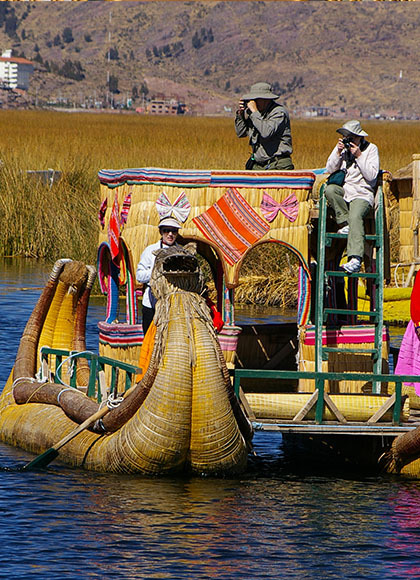
Inca Trail Packages
- Classic Inca Trail - 4 Days Promo
- Classic Inca Trail - Premium - 4 Days
- Short Inca Trail to Machu Picchu - 2 Days Promo
- Inca Trail Express to Machu Picchu - 5 Days Promo
- Salkantay & Inca Trail to Machu Picchu - 7 Days
Inca Trail to Machu Picchu
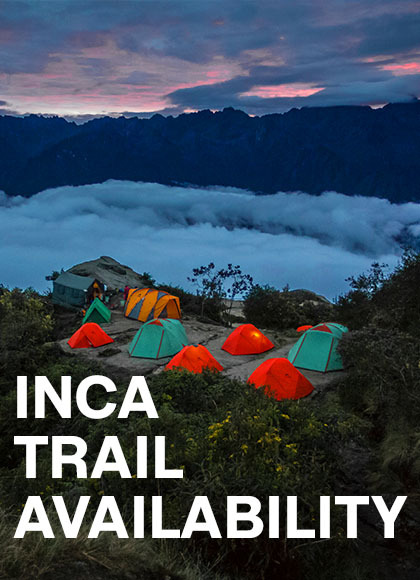
Adventure Packages
- Trek Along the Inca Trail To Machu Picchu - 7 Days Promo
- Salkantay Trek & Machu Picchu - 8 Days Promo
- Lares Trek & Machu Picchu - 7 Days Promo
- Ausangate, Rainbow Mountain & Machu Picchu - 10 Days
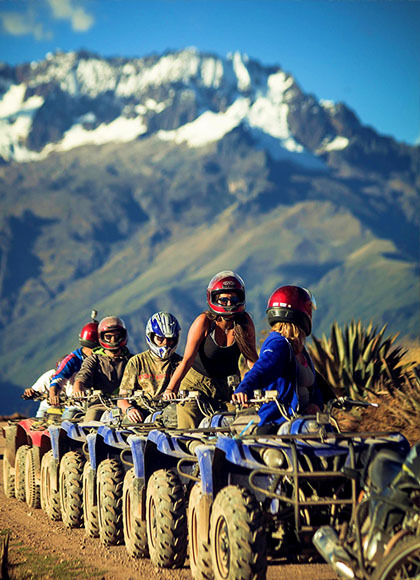
Cultural Packages
- Machu Picchu Express - 7 Days
- 7 Day - Classic Peru Trip - 7 Days Promo
- 12 Day – Classic Peru - 12 Days Promo
- The Best of Peru - 9 Days Promo
- The Best of Magical Peru - 15 Days
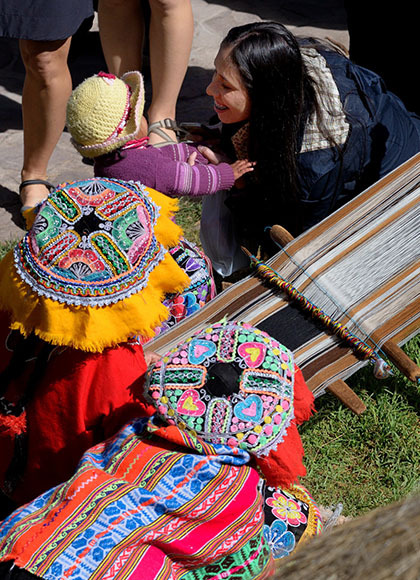
Peru Tours Packages
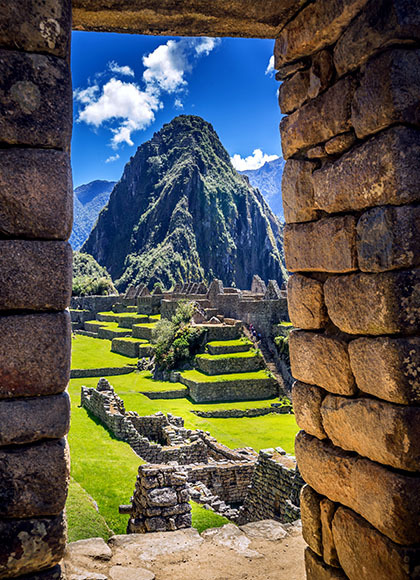
- Tailor-Made Tours
About Valencia Travel
- What others say
- Our Purpose
- Our Philosophy
- Our sustainability efforts
- Our History
- Why Valencia
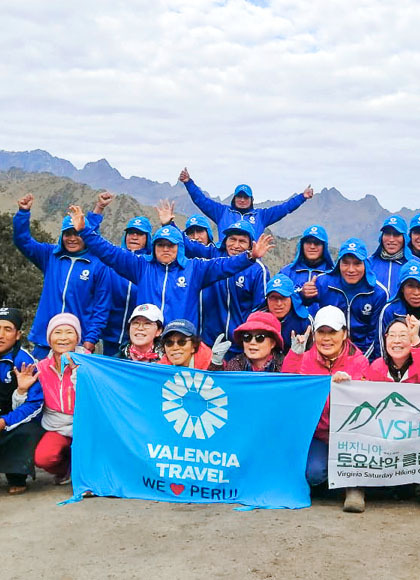
- Classic Inca Trail
- Classic Inca Trail - Premium
- Short Inca Trail to Machu Picchu
- Inca Trail Express to Machu Picchu
- Salkantay & Inca Trail to Machu Picchu
- Trek Along the Inca Trail To Machu Picchu
- Salkantay Trek & Machu Picchu
- Lares Trek & Machu Picchu
- Ausangate, Rainbow Mountain & Machu Picchu
- Machu Picchu Express
- 7 Day - Classic Peru Trip
- 12 Day – Classic Peru
- The Best of Peru
- The Best of Magical Peru
Get our Travel Tips delivered to your Inbox
How Much Should I Budget for My Trip to Peru?

Written by: Claire Dean
Published: 21-02-2023.
Home to some of South America’s most incredible sights, deep Amazon jungle , cuisine, and Inca sites, Peru is probably the perfect destination for your next adventure. With no end to exciting places to visit, Peru is a vibrant country that can be experienced on almost any budget. Whether you’re traveling on a budget or looking to splash out, let’s talk about the costs of traveling in Peru and how to get the most out of this incredible country.
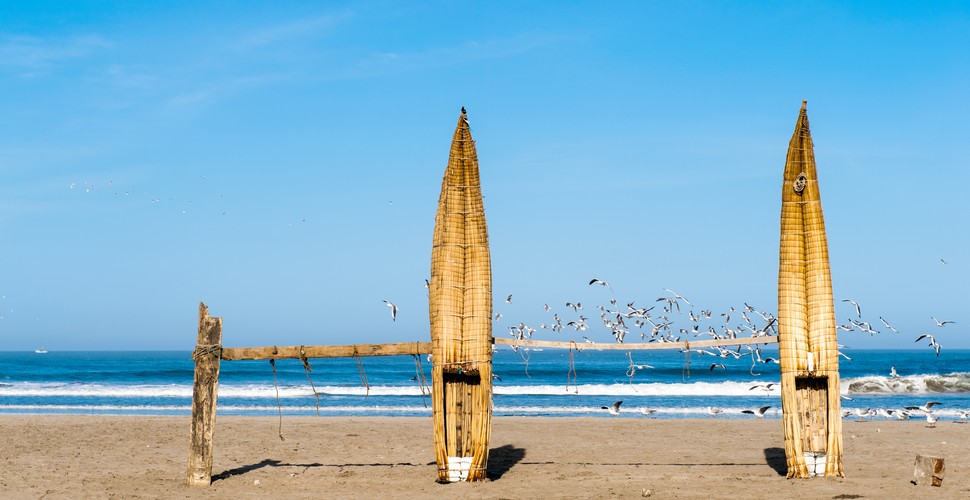
Huanchaco, Peru
Not only is Peru a fantastic destination for adventure seekers and nature lovers, but it is also one of the most affordable ones in South America. Perhaps your biggest expense, which you will need to account for well in advance, is your airline tickets. Flight prices to Peru are very diverse and based on your departure location and the time of year you’re traveling (high vs low season). To find affordable flights to Peru, it might be wise to use platforms that allow you to compare airline tickets, such as Skyscanner.

Andean Girl
The next things to consider are the places you want to explore in the country, as this will be a major factor when calculating your overall travel costs. For example, the prices for a fully customized 8-day trip to Peru, including transportation for the tours, an English-speaking guide, meals, accommodation in an Amazon lodge , and tickets to Machu Picchu , start at over USD 1,000 and then reach the sky, depending on the experience you are looking for.
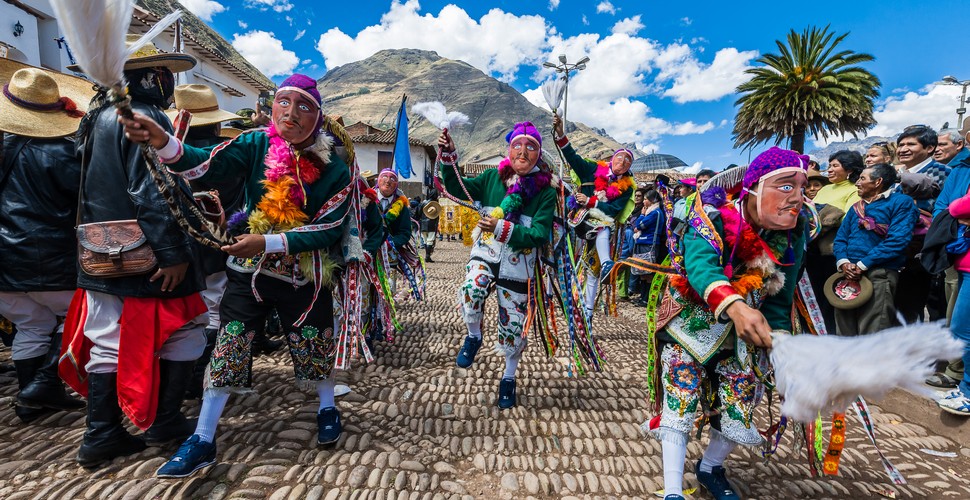
Festival in Pisaq
Accommodation .
Peru offers all different types of accommodation from party hostels to upmarket chic hotels. Here is the general cost of what you should expect to pay per night for accommodation in Peru. (Based on a double room and 2 people sharing). Dorm Room or Hostel $8USD to $35 USD 3-star hotel $75- $150 4-star hotel $180-$300 USD Boutique Hotel $300-$500 USD Luxury Hotel USD 500 and above
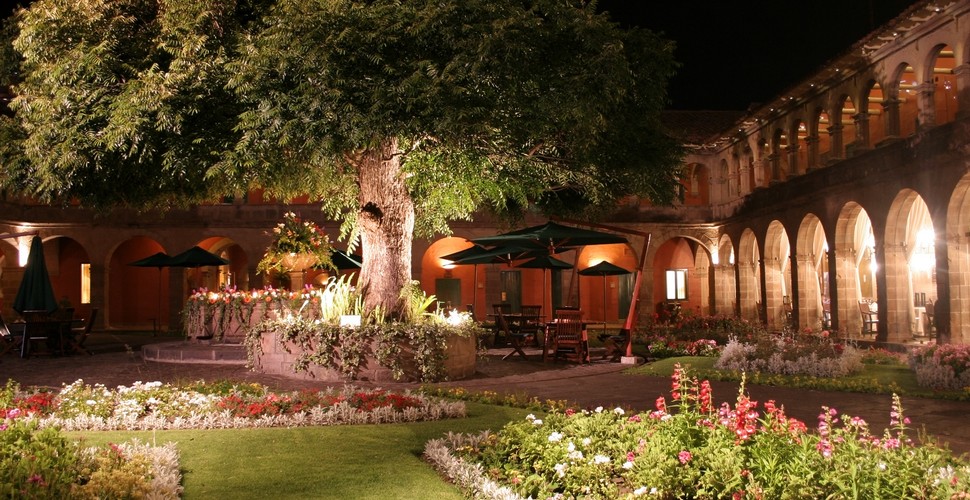
Cusco Luxury Hotel
Peru has a good public transportation system and using public transport is one of the cheapest ways to explore the country. Buses connect most major cities and tourist destinations. The cost of your bus ticket will generally depend on the bus company, the route, and the extras that they offer (e.g. air-conditioning or onboard meals).
Hopping on a train is another great option, specifically if you’re trying to reach Machu Picchu . There are two rail companies operating trains from Cusco to Aguas Calientes (the town closest to Machu Picchu) – Peru Rail and Inca Rail. A one-way budget train ticket from Cusco to the ancient site of Machu Picchu will set you back between USD 70 and $85 USD. Both companies further offer several different travel classes with added extras such as air conditioning and complimentary snacks. For those who want to travel to Machu Picchu in the lap of luxury, The Hiram Bingham Train service is around the USD 900 to get to Machu Picchu in style.
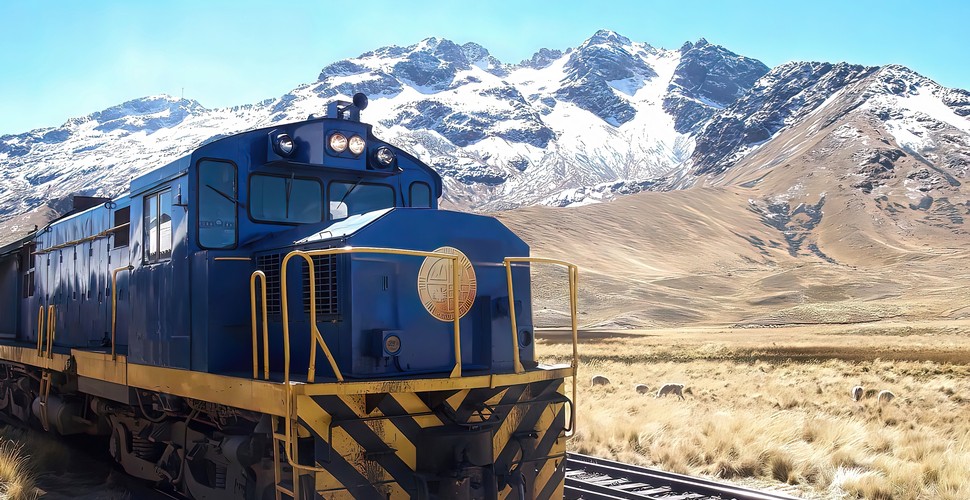
Titicaca Train
Peru is a foodie paradise and eating/drinking all the local goodness here is a huge part of your travel experience to come! If you eat locally, which you definitely should, then food and drink here is very affordable too. Most hostels and hotels in Peru include breakfast in their prices. While this is often a simple affair of cereal, fruit, yogurt, and toast, it’s an ample start to the day and one less meal to worry about.
When it comes to lunch, fresh juice plus a sandwich in a local market will set you back just $1-3 USD, as will a good espresso coffee at a tourist café.
The best value here is to buy a 5l bottle and then decant it into a smaller metal water bottle you carry with you during the day. This saves money and plastic waste. Beers are cheap in Peru too, especially when bought in a store, or at a cheap local place, costing $1-2 each.
For dinner, if you eat in local cafes/restaurants, you can expect to pay around USD 5 for a decent feed. If you want to splash and out in a fairly decent restaurant in Peru however, which you can certainly do in Lima and Cusco , then prices start from around USD 20 and then the sky is the limit!

Causa Rellena
Entrance fees and guides.
Entrance fees and guides can be hard to price up in Peru because if you take a tour or a guided trek to many of the most popular ruins and sights, these will be included in the price. Of course, there are many free and cheap attractions in Peru, but for the main attractions, you will obviously have to spend some cash, especially if it involves a trip to a wonder of the world!
Here are some examples:
Entrance to Pachacamac Ruins by Lima: USD 4 Hot Springs Entrance in Colca Canyon: USD 3 Santa Catalina Monastery Entrance in Arequipa: USD 12 Entrance to Inca Museum in Cusco : USD 3 Entrance to Choquequirao Ruins : $18 USD Entrance to Machu Picchu : $65 USD Cusco Tourist Ticket (10 days): USD 45 This last option is essential if you think you’ll be visiting a lot of the ruins around Cusco as it’s a combined entrance ticket that will save you money in the long run. It covers 16 sights in total, both in and around Cusco and The Sacred Valley. The 10-day ticket is good if you have a decent amount to explore all this city has to offer otherwise, there are a couple of smaller circuit 1-2 day options too for USD 20.

Amazon Lodge Excursion
If you are unsure about how much things will cost on a trip to Peru , contact us here for more detailed information!
SHARE THIS POST
Popular posts.

Coca Tea- The Andean Cure-all!

Solo women travelling in Peru
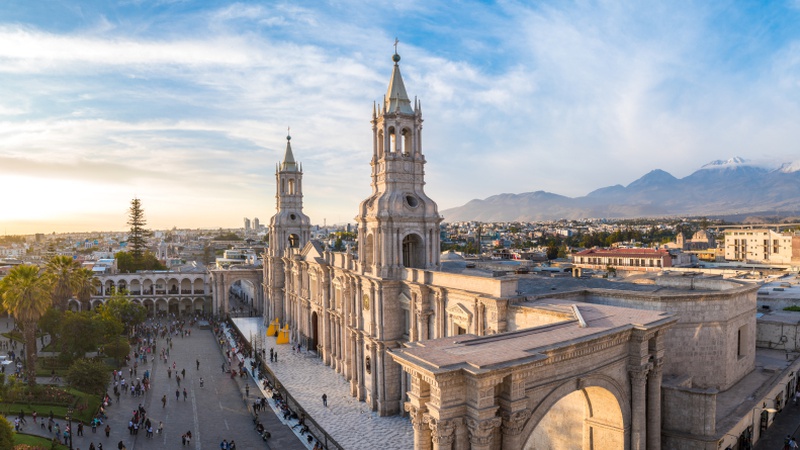
Arequipa, the White City

10 Cusco “MUST-DO'S” that DON'T include Machu Picchu
- Best overall
- Best for exotic trips
- Best for trip interruption
- Best for medical-only coverage
- Best for family coverage
- Best for long trips
- Why You Should Trust Us
Best International Travel Insurance for June 2024
Affiliate links for the products on this page are from partners that compensate us (see our advertiser disclosure with our list of partners for more details). However, our opinions are our own. See how we rate insurance products to write unbiased product reviews.
If you're planning your next vacation or trip out of the country, be sure to factor in travel insurance. Unexpected medical emergencies when traveling can drain your bank account, especially when you're traveling internationally. The best travel insurance companies for international travel can step in to provide you with peace of mind and financial protection while you're abroad.
Best International Travel Insurance
- Best overall: Allianz Travel Insurance
- Best for exotic travel: World Nomads Travel Insurance
- Best for trip interruption coverage: C&F Travel Insured
- Best for medical-only coverage: GeoBlue Travel Insurance
- Best for families: Travelex Travel Insurance
- Best for long-term travel: Seven Corners Travel Insurance
Compare the Best International Travel Insurance Companies
As a general rule, the most important coverage to have in a foreign country is travel medical insurance , as most U.S. health insurance policies don't cover you while you're abroad. Without travel medical coverage, a medical emergency in a foreign country can cost you. You'll want trip cancellation and interruption coverage if your trip is particularly expensive. And if you're traveling for an extended period of time, you'll want to ensure that your policy is extendable.
Here are our picks for the best travel insurance companies for international travel.
Best International Travel Insurance Overall
Allianz travel insurance.
Allianz Travel Insurance offers the ultimate customizable coverage for international trips, whether you're a frequent jetsetter or an occasional traveler. You can choose from an a la carte of single or multi-trip plans, as well as add-ons, including rental car damage, cancel for any reason (CFAR) , adventure sport, and business travel coverage. And with affordable pricing compared to competitors, Allianz is a budget-friendly choice for your international travel insurance needs.
The icing on the cake is Allyz TravelSmart, Allianz's highly-rated mobile app, which has an average rating of 4.4 out of five stars on the Google Play store across over 2,600 reviews and 4.8 out of five stars from over 22,000 reviews on the Apple app store. So, you can rest easy knowing that you can access your policy and file claims anywhere in the world without a hassle.
Read our Allianz Travel Insurance review .
- Check mark icon A check mark. It indicates a confirmation of your intended interaction. Good option for frequent travelers thanks to its annual multi-trip policies
- Check mark icon A check mark. It indicates a confirmation of your intended interaction. Doesn't increase premium for trips longer than 30 days, meaning it could be one of the more affordable options for a long trip
- Check mark icon A check mark. It indicates a confirmation of your intended interaction. Some plans include free coverage for children 17 and under
- Check mark icon A check mark. It indicates a confirmation of your intended interaction. Concierge included with some plans
- con icon Two crossed lines that form an 'X'. Coverage for medical emergency is lower than some competitors' policies
- con icon Two crossed lines that form an 'X'. Plans don't include coverage contact sports and high-altitude activities
- Single and multi-trip plans available
- Trip cancellation and interruption coverage starting at up to $10,000 (higher limits with more expensive plans)
- Preexisting medical condition coverage available with some plans
Best International Travel Insurance for Exotic Trips
World nomads travel insurance.
World Nomads Travel Insurance offers coverage for over 150 specific activities, so you can focus on the adventure without worrying about gaps in your coverage.
You can select its budget-friendly standard plan, starting at $79. Or if you're an adrenaline junkie seeking more thrills, you can opt for the World Nomads' Explorer plan for $120, which includes extra sports like skydiving, scuba diving, and heli-skiing. And World Nomads offers 24/7 assistance, so you can confidently travel abroad, knowing that help is just a phone call away.
Read our World Nomads Travel Insurance review .
- Check mark icon A check mark. It indicates a confirmation of your intended interaction. Coverage for 200+ activities like skiing, surfing, and rock climbing
- Check mark icon A check mark. It indicates a confirmation of your intended interaction. Only two plans to choose from, making it simple to find the right option
- Check mark icon A check mark. It indicates a confirmation of your intended interaction. You can purchase coverage even after your trip has started
- con icon Two crossed lines that form an 'X'. If your trip costs more than $10,000, you may want to choose other insurance because trip protection is capped at up to $10,000 (for the Explorer plan)
- con icon Two crossed lines that form an 'X'. Doesn't offer coverage for travelers older than 70
- con icon Two crossed lines that form an 'X'. No Cancel for Any Reason (CFAR) option
- Coverage for 150+ activities and sports
- 2 plans: Standard and Explorer
- Trip protection for up to $10,000
- Emergency medical insurance of up to $100,000
- Emergency evacuation coverage for up to $500,000
- Coverage to protect your items (up to $3,000)
Best International Travel Insurance for Trip Interruption
C&f travel insured.
C&F Travel Insured offers 100% coverage for trip cancellation, up to 150% for trip interruption, and reimbursement for up to 75% of your non-refundable travel costs with select plans. This means you don't have to worry about losing your hard-earned money on non-refundable travel costs if your trip ends prematurely.
Travel Insured also stands out for its extensive "reasons for cancellation" coverage. Unlike many insurers, the company covers hurricane warnings from the National Oceanic and Atmospheric Administration (NOAA).
Read our C&F Travel Insured review .
- Check mark icon A check mark. It indicates a confirmation of your intended interaction. Offers 2 major plans including CFAR coverage on the more expensive option
- Check mark icon A check mark. It indicates a confirmation of your intended interaction. Cancellation for job loss included as a covered reason for trip cancellation/interruption (does not require CFAR coverage to qualify)
- Check mark icon A check mark. It indicates a confirmation of your intended interaction. Frequent traveler reward included in both policies
- Check mark icon A check mark. It indicates a confirmation of your intended interaction. Up to $1 million in medical evacuation coverage available
- con icon Two crossed lines that form an 'X'. Medical coverage is only $100,000
- con icon Two crossed lines that form an 'X'. Reviews on claims processing indicate ongoing issues
- C&F's Travel Insured policies allow travelers customize travel insurance to fit their specific needs. Frequent travelers may benefit from purchasing an annual travel insurance plan, then adding on CFAR coverage for any portions of travel that may incur greater risk.
Best International Travel Insurance for Medical Coverage
Geoblue travel insurance.
GeoBlue Travel Insurance offers policies that covers emergency medical treatments when you're abroad. While GeoBlue lacks trip cancellation coverage, that allows it to charge lower premiums than the other companies on this list.
GeoBlue plans can cover medical expenses up to $1 million with several multi-trip annual plans available. It offers coinsurance plans for trips within the U.S. and 100% coverage for international trips. It also has a network of clinics in 180 countries, streamlining the claims process. It's worth noting that coverage for pre-existing conditions comes with additional costs.
Read our GeoBlue Travel Insurance review .
- Check mark icon A check mark. It indicates a confirmation of your intended interaction. A subsidary of Blue Cross Blue Shield
- Check mark icon A check mark. It indicates a confirmation of your intended interaction. Offers strong medical plans as long as you have a regular health insurance plan, but it doesn't have to be through Blue Cross
- Check mark icon A check mark. It indicates a confirmation of your intended interaction. Offers long-term and multi-trip travel protection
- con icon Two crossed lines that form an 'X'. Multiple complaints about claims not being paid or being denied
- con icon Two crossed lines that form an 'X'. Does not provide some of the more comprehensive coverage like CFAR insurance
- con icon Two crossed lines that form an 'X'. Buyers who do get claims paid may need to file multiple claim forms
Best International Travel Insurance for Family Coverage
Travelex travel insurance.
Travelex Travel Insurance offers coverage for your whole crew, perfect for when you're planning a family trip. Its family plan insures all your children 17 and under at no additional cost. The travel insurance provider also offers add-ons like adventure sports and car rental collision coverage to protect your family under any circumstance. Got pets? With Travelex's Travel Select plan, you can also get coverage for your furry friend's emergency medical and transportation expenses.
Read our Travelex Travel Insurance review .
Trip cancellation coverage for up to 100% of the trip cost and trip interruption coverage for up to 150% of the trip cost
- Check mark icon A check mark. It indicates a confirmation of your intended interaction. Options to cover sports equipment
- Check mark icon A check mark. It indicates a confirmation of your intended interaction. Option to increase medical coverage
- Check mark icon A check mark. It indicates a confirmation of your intended interaction. Can cancel up to 48 hours before travel when CFAR option is purchased
- Check mark icon A check mark. It indicates a confirmation of your intended interaction. Affordable coverage for budget-conscious travelers
- Check mark icon A check mark. It indicates a confirmation of your intended interaction. Includes generous baggage delay, loss and trip delay coverage
- Check mark icon A check mark. It indicates a confirmation of your intended interaction. Optional "adventure sports" bundle available for riskier activities
- con icon Two crossed lines that form an 'X'. Only two insurance plans to choose from
- con icon Two crossed lines that form an 'X'. Medical coverage maximum is low at up to $50,000 per person
- con icon Two crossed lines that form an 'X'. Pricier than some competitors with lower coverage ceilings
- con icon Two crossed lines that form an 'X'. Some competitors offer higher medical emergency coverage
Travelex travel insurance is one of the largest travel insurance providers in the US providing domestic and international coverage options. It offers a basic, select, and America option. Read on to learn more.
- Optional CFAR insurance available with the Travel Select plan
- Trip delay insurance starting at $500 with the Travel Basic plan
- Emergency medical and dental coverage starting at $15,000
Best International Travel Insurance for Long Trips
Seven corners travel insurance.
Seven Corners Travel Insurance offers specialized coverage that the standard short-term travel insurance policy won't provide, which is helpful if you're embarking on a long-term trip. You can choose from several plans, including the Annual Multi-Trip plan, which provides medical coverage for multiple international trips for up to 364 days. This policy also offers COVID-19 medical and evacuation coverage up to $1 million.
You also get the added benefit of incidental expense coverage. This policy will cover remote health-related services and information, treatment of injury or illness, and live consultations via telecommunication.
Read our Seven Corners Travel Insurance review .
- Check mark icon A check mark. It indicates a confirmation of your intended interaction. Diverse coverage options such as CFAR, optional sports equipment coverage, etc.
- Check mark icon A check mark. It indicates a confirmation of your intended interaction. Available in all 50 states
- con icon Two crossed lines that form an 'X'. Prices are higher than many competitors
- con icon Two crossed lines that form an 'X'. Reviews around claims processing are mixed
- Trip cancellation insurance of up to 100% of the trip cost
- Trip interruption insurance of up to 150% of the trip cost
- Cancel for any reason (CFAR) insurance available
How to Find the Right International Travel Insurance Company
Different travelers and trips require different types of insurance coverage. So, consider these tips if you're in the market to insure your trip.
Determine your needs
Your needs for travel insurance will depend on the type of trip you're taking. You'll need to consider your destination and what you'll be doing there, either business, leisure, or adventure traveling. Policies covering adventure sports and activities will cost more. Longer, more expensive trips will also cost more.
Research the reputation of the company
When researching a company, you'll want to closely review the description of services. You'll want to see how claims are handled, any exceptions, and limitations.
You'll also want to look at the company's customer reviews on sites like Trustpilot, BBB, and Squaremouth, as this will provide insight on the quality of customer service and the claims process. You should also take note of whether companies respond to customer reviews.
Compare prices
You can get quotes through a company's website or travel insurance aggregators like InsureMyTrip and VisitorsCoverage. You'll need to be prepared to provide the following information about your trip:
- Trip destination(s)
- Travel dates
- Number of travelers
- Traveler(s) age/birthday
- State of residence
- Total trip cost
For companies that offer travel medical insurance, you'll also want to play around with the deductible options, as they can affect your policy premium.
Understanding International Travel Insurance Coverage Options
Travel insurance can be confusing, but we're here to simplify it for you. We'll break down the industry's jargon to help you understand what travel insurance covers to help you decide what your policy needs. Bear in mind that exclusions and limitations for your age and destination may apply.
Finding the Best Price for International Travel Insurance
Your policy cost will depend on several factors, such as the length of your trip, destination, coverage limits, and age. Typically, a comprehensive policy includes travel cancellation coverage costs between 5% and 10% of your total trip cost.
If you're planning an international trip that costs $4,500, you can expect to pay anywhere from $225 to $450 for your policy. Comparing quotes from multiple providers can help you find a budget-friendly travel insurance policy that meets your needs.
Why You Should Trust Us: How We Reviewed International Travel Insurance Companies
We ranked and assigned superlatives to the best travel insurance companies based on our insurance rating methodology . It focuses on several key factors, including:
- Policy types: We analyzed company offerings such as coverage levels, exclusions, and policy upgrades, taking note of providers that offer a range of travel-related issues beyond the standard coverages.
- Affordability: We recognize that cheap premiums don't necessarily equate to sufficient coverage. So, we seek providers that offer competitive rates with comprehensive policies and quality customer service. We also call out any discounts or special offers available.
- Flexibility: Travel insurance isn't one-size-fits-all. We highlight providers that offer a wide array of coverage options, including single-trip, multi-trip, and long-term policies.
- Claims handling: The claims process should be pain-free for policyholders. We seek providers that offer a streamlined process via online claims filing and a track record of handling claims fairly and efficiently.
- Quality customer service: Good customer service is as important as affordability and flexibility. We highlight companies that offer 24/7 assistance and have a strong record of customer service responsiveness.
We consult user feedback and reviews to determine how each company fares in each category. We also check the provider's financial rating and volume of complaints via third-party rating agencies.
Read more about how Business Insider rates insurance products here.
International Travel Insurance FAQs
The best insurance policy depends on your individual situation, including your destination and budget. However, popular options include Allianz Travel Insurance, World Nomads, and Travel Guard.
You should pay attention to any limitations regarding covered cancellations, pre-existing conditions, and adventure activities. For example, if you're worried you may have to cancel a trip for work reasons, ensure that you've worked at your company long enough to qualify for cancellation coverage, as that is a condition with some insurers. You should also see if your destination has any travel advisories, as that can affect your policy.
Typically, your regular health insurance won't cover you out of the country, so you'll want to make sure your travel insurance has adequate medical emergency coverage. Depending on your travel plans, you may want to purchase add-ons, such as adventure sports coverage, if you're planning on doing anything adventurous like bungee jumping.
Travel insurance is worth the price for international travel because they're generally more expensive, so you have more to lose. Additionally, your regular health insurance won't cover you in other countries, so without travel insurance, you'll end up paying out of pocket for any emergency medical care you receive out of the US.
You should purchase travel insurance as soon as possible after making payment on your trip. This makes you eligible for add-ons like coverage for pre-existing conditions and CFAR. It also mitigates the chance of any losses in the days leading up to your trip.
- Main content
This is How Much it Costs to Go to a Music Festival in 2024
Festivals are a great way to see a variety of artists for a lower price than individual shows – but they can still be expensive.
Music Festival Costs 2024

Getty Images
When it comes to music festival costs, ticket prices are just the tip of the iceberg.
Key Takeaways
- Music festival tickets alone typically cost between $200 and $600, before you factor in additional expenses like travel and food.
- Don’t forget to budget for your travel expenses, food and beverages, clothing and other miscellaneous costs associated with your festival experience.
- Combining travel and entertainment, music festivals can fit into a healthy budget as long as you make the decision carefully regarding your own financial situation.
Bringing in hundreds of thousands of guests for a weekend, music festivals are popular, high-energy events where attendees can see dozens of their favorite artists in a short time.
These events are beloved not only for bringing together top performers, food and experiences, but also because you can spend less money than you would to see several individual shows.
That said, music festivals are still expensive – especially if you have to travel to attend them. Seat Geek estimates the average music festival ticket ranges between $200 and $600, but that doesn’t account for food and drink, travel or other purchases you might need to budget for.
With all this in mind, can a music festival still fit into your budget? Read on for more about the costs you should consider before purchasing a pass and if it makes financial sense for you.
Music Festival Costs
When you just look at ticket costs, music festivals seem like a great deal. Tickets ranging from $200 to $600 typically include access to dozens of shows. With the average concert ticket more than $100, the price per show is remarkably low, and therefore inexpensive – at least according to girl math .
Unfortunately, ticket prices are just the tip of the iceberg, Adrianna Adams, certified financial planner and head of financial planning at Domain Money, said in an email.
“Depending on the festival, you might spend anywhere from $800 to $3,000 for tickets, travel, accommodations, food and drink, depending on the level of luxury you prefer,” she said.
Here are four costs to consider before attending a music festival:
1. Tickets
The most obvious cost associated with attending a music festival is your entry ticket itself. The actual cost of your ticket will vary significantly based on the festival, how long you attend and the tier of access you purchase.
For instance, compare 2024 and 2025 costs of general admission to VIP tickets for a full weekend (three to four days, depending on the festival) at three popular festivals below:
These base costs also vary on what amenities they include; extras like parking, transportation or special entry access can boost the price.
2. Food and Drink
During a sweaty weekend filled with lots of walking, jumping around and other activities, staying fed and hydrated are important. Unfortunately, the prices of food and drink at music festivals have gained notoriety for being extravagant.
You’ll need to be prepared to either pack your own food and drinks (if allowed by the festival) or shell out a premium.
3. Travel and Accommodations
If you don’t live in the city where the music festival is taking place, you’ll have to budget for travel and a place to stay as well. While you can try and pinch pennies by road-tripping and camping instead of staying in a hotel (depending on the festival), costs can still be high. Finding a cheap flight could be even more difficult, as festival weekends are typically considered “peak” travel season in their destinations.
4. Other Miscellaneous Costs
Basics aside, there are other costs that you’ll need to be prepared for ahead of your music festival trip. Want to go all out on an extravagant outfit to match influencers or your favorite artist? Don’t forget to build a budget for clothes, makeup and accessories.
You also might be tempted by merchandise or souvenirs you weren’t expecting, so having some padding in your budget can allow for those purchases.
Are Music Festivals Worth the Cost?
All in all, it’s not as simple as music festivals costing less than several individual concerts. Between travel, food and ticket prices, attending a festival can be an expensive experience, so whether or not it fits into your lifestyle will depend on your own financial priorities.
“Personal finance is unique to each individual, tailored to what you prioritize and value. Many of my clients feel happy and fulfilled spending around $3,000 to $5,000 annually on entertainment, which includes sporting event tickets, concert and festival passes and streaming service subscriptions,” Adams said.
A healthy budget includes both “needs” like housing and groceries and “wants” like entertainment and travel, so for some, music festivals can fill the latter category. Just make sure you plan for all the hidden costs and don’t sacrifice any of the purchases you need to make in order to attend.
“Deciding in advance whether your music festival expenses will come from your entertainment or travel budget can help you maximize your happiness and financial satisfaction,” Adams said.
Entertainment Spending
Erica Sandberg Oct. 11, 2023

Tags: money , personal finance , personal budgets , consumers , entertainment
Popular Stories
Mortgages and Advice

Family Finance

Saving and Budgeting

Credit Cards

Personal Loans

SEE TODAY'S TOP COUPONS
Kohl's Coupons

Wayfair Coupons

Lowe's Coupons

Best Buy Coupons

Walmart Promo Codes

Comparative assessments and other editorial opinions are those of U.S. News and have not been previously reviewed, approved or endorsed by any other entities, such as banks, credit card issuers or travel companies. The content on this page is accurate as of the posting date; however, some of our partner offers may have expired.

Your Money Decisions
Advice on credit, loans, budgeting, taxes, retirement and other money matters.
You May Also Like
Best websites to make money online.
Geoff Williams June 21, 2024
Best Gas Apps to Save You Money
Are budget apps safe.
Erica Sandberg June 21, 2024
15 Affordable Wedding Venue Ideas
Maryalene LaPonsie June 20, 2024

Wealthiest Generation
Erica Sandberg June 18, 2024

What to Do if Your Identity Is Stolen
Maryalene LaPonsie June 18, 2024

Budget Counseling – Do You Need It?
Erica Lamberg June 17, 2024

How Much to Buy a Boat v. a Yacht
Erica Sandberg June 14, 2024

What Is Cash Stuffing?
Geoff Williams June 13, 2024

How to Get Out of Debt
Geoff Williams June 12, 2024

10 Cheap Father's Day Gift Ideas
Jessica Walrack June 11, 2024

Grocery Receipt Apps Worth Trying
Geoff Williams June 10, 2024

Cash Wedding Gift Guidelines for 2024
Jessica Walrack June 7, 2024

Spending for a Graduation Gift
Erica Sandberg June 5, 2024

How to Save for a Wedding
Erica Sandberg and Emma Kerr June 4, 2024

Expert-Approved Thrifting Tips
Erica Lamberg June 3, 2024

How to Negotiate With Debt Collectors
Jessica Walrack May 31, 2024

10 Hobbies That Can Make You Money
Jessica Walrack May 30, 2024

What is a Cohabitation Agreement?
Erica Lamberg May 29, 2024

Four Questions to Ask on the First Date
Erica Sandberg May 29, 2024

Chinese outbound travel recovery lags due to costs, visa snags
- Medium Text

FLIP TO DOMESTIC TRAVEL

Sign up here.
Reporting by Sophie Yu in Beijing, Casey Hall in Shanghai and Lisa Barrington in Seoul; Additional reporting by Diana Mandia in Gdansk; Editing by Miyoung Kim and William Mallard
Our Standards: The Thomson Reuters Trust Principles. New Tab , opens new tab

Thomson Reuters
Casey has reported on China's consumer culture from her base in Shanghai for more than a decade, covering what Chinese consumers are buying, and the broader social and economic trends driving those consumption trends. The Australian-born journalist has lived in China since 2007.

World Chevron
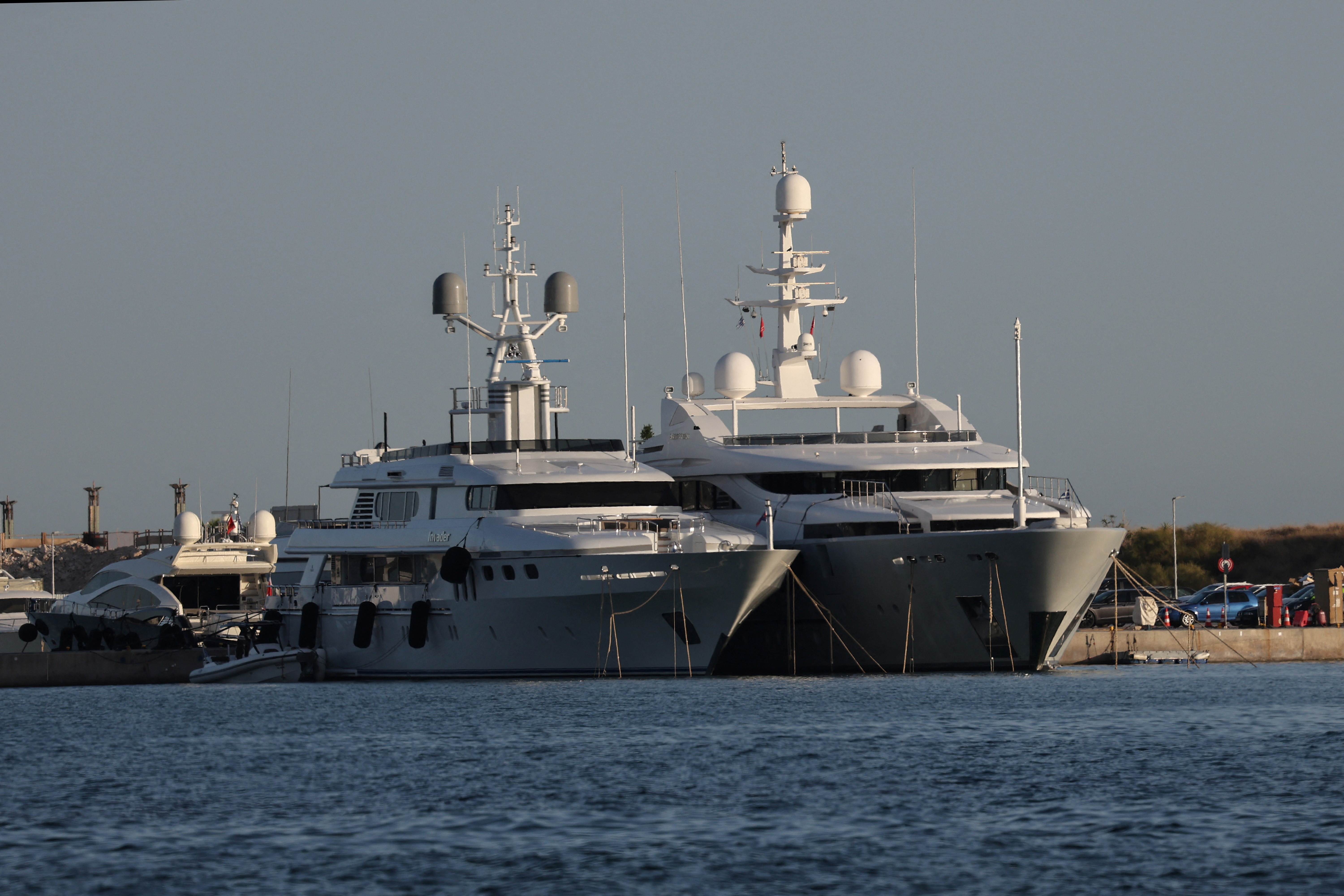
Greek yacht crew charged for arson on Hydra island
The crew, all Greeks, were arrested at an Athens-area marina after allegations that they started the forest fire late on Friday. They denied the charges, Greek media reported.
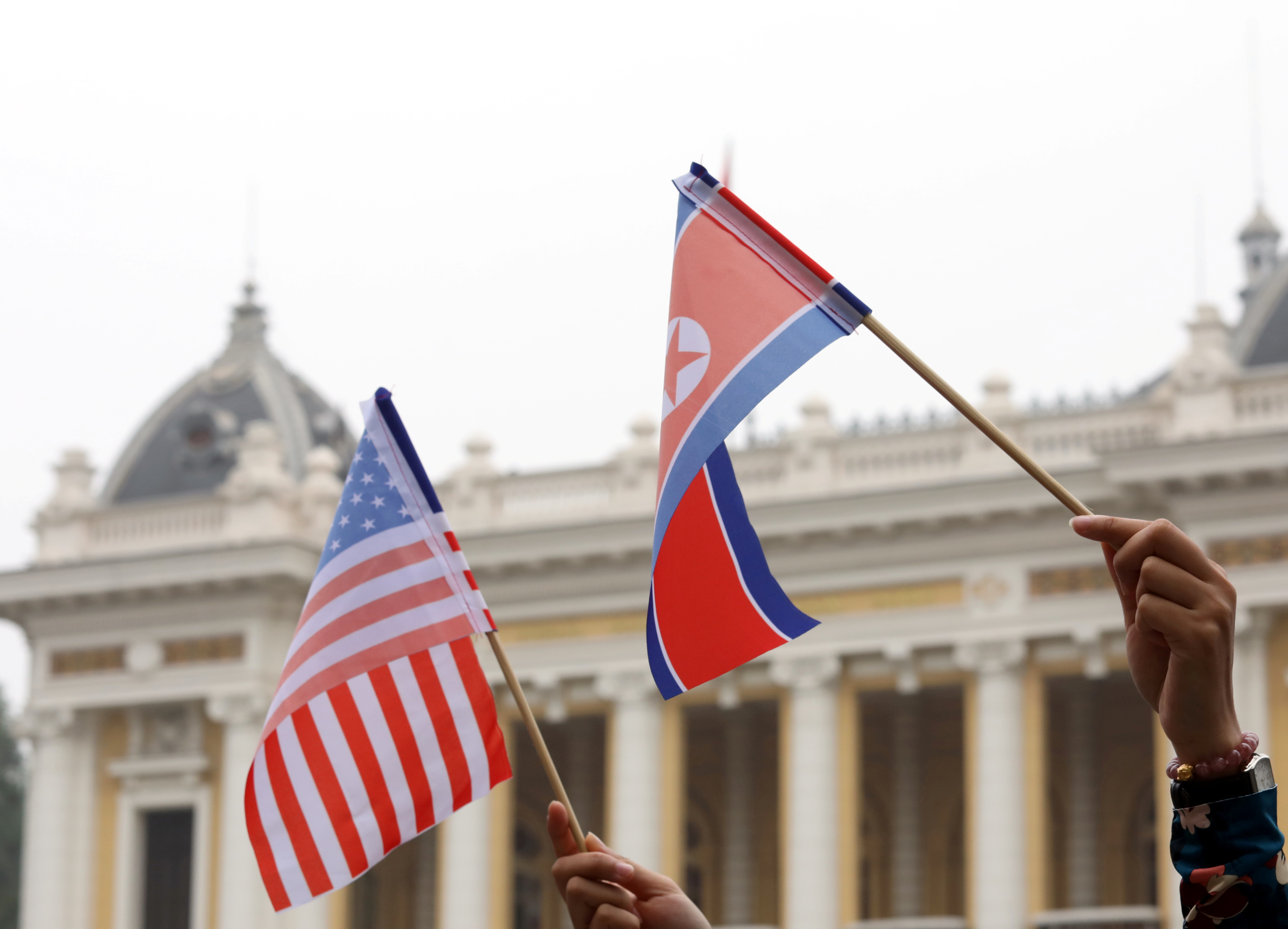

Peru: Ancient Civilizations and Southern Skies
- March 25 - April 3, 2025

Quick Facts

with MIT Professor Rick Binzel
Professor of Planetary Science and Joint Professor of Aerospace Engineering
- $8,640 per person double occupancy
- Trip Type Land & Rail
- Maximum Capacity: 30
- Tour Operator: Criterion Travel at 888-328-2089 or email [email protected]
Trip Highlights
This program itinerary has been carefully crafted by the tour operator, faculty leadership, and MIT Alumni Travel to ensure a curated experience that emphasizes in-depth learning. A key feature of the trip is a two-night stay at the awe-inspiring 15th-century Inca citadel of Machu Picchu with time to experience and reflect, without the crowds.
Explore the best of Peru’s rich ancient history and cultural traditions including Machu Picchu, the Sacred Valley of the Inca and Cuzco, while also observing the Southern Skies’ Magellanic Clouds, Southern Cross, and the Southern Milky Way. A highlight: visit Machu Picchu with a two-night stay at Belmond’s Machu Picchu Sanctuary Lodge, the only property next to the entrance of this UNESCO World Heritage site. Also, consider joining an optional pre-trip extension to the Nazca Lines & Ballestas Islands, and an optional post-trip extension exploring the Peruvian altiplano and Lake Titicaca.
Detailed trip information to be posted soon! In the meantime, if you would like to hold a spot on this program, please call Criterion Travel or email MIT Alumni Travel at [email protected] .
Enrichment Lecturer
About traveling with MIT Professor Rick Binzel in 2019, one MIT traveler commented “This is our fifth trip with Rick, and he is the reason why. He is fantastic. Rick’s lectures are wonderful ... Rick also made himself available to everyone to answer questions at any time.”
Richard Binzel is a Professor of Planetary Science and Joint Professor of Aerospace Engineering at MIT and holds a MacVicar Faculty Fellowship in recognition of outstanding teaching. Ancient Inca astronomy is an enduring passion for him, unraveling the mix of myths, legends, and precise knowledge that determines key elements of Machu Picchu. Read more about Professor Binzel .
Together we’ll unravel the mysteries of Ancient Inca astronomy, demystify how the seasonal motions of the Sun can be traced, and reveal how Machu Picchu served as an observatory for watching the heavens to determine the timing of cultural rituals. We’ll also take advantage ourselves to marvel at the many wonders of the southern skies, including sightings of the Southern Cross. — MIT Professor Richard Binzel
- Please note that the MIT Alumni Travel Program does not conduct tours. The Alumni Travel Program acts as a facilitator with tour operators ; tour participants work directly with the tour operators to make travel arrangements.
- For more details, please see About the Alumni Travel Program.
- Also, check out our What to Expect page .
- MIT travelers are strongly encouraged to purchase travel insurance . Travelers are free to use any insurance company they prefer. For questions about trip insurance through Meyer Insurance, please call 866-679-7836.

It's the longest bridge ever built in Peru, and so far, it goes nowhere
It is the longest bridge ever built in Peru, a massive structure of cement and iron spanning the Nanay River as it connects to untouched areas of the Peruvian Amazon
So far, it goes nowhere.
The bridge is part of a federal highway project to connect Iquitos , in Peru's northeast, to the El Estrecho district on the Colombian border, in total some 188 kilometers (117 miles). It faces mounting opposition from Indigenous tribes who fear that the construction will lead to land grabbing, deforestation and drug trafficking, which have plagued similar projects across the world´s largest rainforest.
“The highway will kill us,” Everest Ochoa, a member of the Maijuna indigenous group that lives in the Peruvian Amazon, told The Associated Press. “We have to stop this project for the sake of our children, to protect the land for them."
Construction work is at a standstill as the government conducts a study of the area, but the Ministry of Transportation has already built the country’s largest bridge, which extends 2.3 kilometers (1.4 miles) over the Nanay River, a tributary of the Amazon River.
Indigenous leaders say the communities along the highway route have not been consulted
“The government didn’t ask us anything about the highway passing through our territory and we want our rights to be respected”, said community leader Artur Francis Cruz Ochoa.
His community, Nuevo Arenal, is next to the bridge and has already suffered, he said. “Drugs have already started to infiltrate our community, young people are already consuming them. With the construction of the highway, it will get worse.”
In the village of Sucusari, also near the future path of the road, people echo the same fears. It is a community of thatched houses, where the 180 inhabitants live a traditional lifestyle, fishing, hunting and growing fruit for local markets, mostly aguaje, an Amazon delicacy.
“We will lose land, animals, fish, the water will be contaminated, and the forest. If the forest is lost, we won’t have water. We won’t have life without water," said Sebastian Rios Ochoa. "With the highway, the abundance we have now will end.”
In a written message to AP , the Ministry of Transportation said the project’s objective is to connect people along the path and promote local economies, strengthen trade and help bring security to border areas.
The ministry said the construction of the bridge is considered an infrastructure project for public services and, as such, is not required to undergo prior consultation with the Indigenous tribes, according to Peru’s legislation.
The Iquitos-El Estrecho is the largest and most expensive highway construction in Peru´s Amazon, according to a recent report by Peruvian Society of Environmental Law, a nonprofit. The report says there has already been land-grabbing and deforestation in Indigenous lands.
The highway will cross two protected areas, Maijuna Kichwa and Ampiyacu Apayacu, which cover about 8,000 square kilometers (3,000 square miles) of old-growth forest, according to the report.
Zoila Ochoa Garay, 58, cries inconsolably when she speaks about her community of Nuevo Arenal, where the first stretch of the highway begins.
“Since this highway project began, people have been invading our community’s land," she said. "There is no justice here.”
Fabiano Maisonnave in Brasilandia, Brazil , contributed to this report.
The Associated Press’ climate and environmental coverage receives financial support from multiple private foundations. AP is solely responsible for all content. Find AP’s standards for working with philanthropies, a list of supporters and funded coverage areas at AP.org.
From news to politics, travel to sport, culture to climate – The Independent has a host of free newsletters to suit your interests. To find the stories you want to read, and more, in your inbox, click here .


IMAGES
VIDEO
COMMENTS
How much does it cost to travel to Peru? You should plan to spend around $60 (S/.224) per day on your vacation in Peru. This is the average daily price based on the expenses of other visitors. Past travelers have spent, on average for one day: $16 (S/.60) on meals; $8.29 (S/.31) on local transportation; $50 (S/.188) on hotels
The Cost of Travel in Peru: A 2023 Budget Breakdown. Lauren Juliff July 31, 2023 |. Peru is such a wonderful country to travel in. Cusco embodies European classiness while Lima is bustling and vibrant. Machu Picchu is full of enchantment while Huacachina mysterious and rare. Colca Canyon is stunningly vast while Arequipa is surrounded by volcanoes.
Peru Travel Costs. Accommodation - A bed in a 4-6-bed dorm costs 35-65 PEN while a bed in a dorm with 10 or more beds generally costs 32-38 PEN. A private room costs 115-170 PEN per night. Free Wi-Fi is standard and most hostels also have a kitchen or include free breakfast.
A trip to Peru for one person usually costs between $22 and $182 per day and $43 to $364 for two people. This is a wide range of costs, and the daily average per person from our data is $60 (S/.224) per person. This average includes food, accommodation, sightseeing, and local transportation expenses contributed from other travelers.
Budget travel: $30 to $35 per day. Mid-range travel: $40 to $100 per day. Luxury travel: $100+ per day. It is possible to make a great Peru tour even with a limited budget. You can cut down on expenses by eating at cheaper restaurants or market food stalls and cooking for yourself during the trip.
Generally speaking Peru is a cheap country to travel around, however it does of course depend on your budget and trip style. For example, backpackers can easily spend $20-25 a day, staying in a dorm bed at a hostel and eating local meals. Those who prefer more comfort or luxury will want to budget for between $30-40 a day.
Average Trip to Peru Cost in 2024. An average one-week trip to Peru for two people will cost around $5,200: Average Accommodation Cost: $125 per night. Average Flight Cost: $1,000 per person. Food, Drink & Activities: $125 per person, per day. Transportation: $500 total.
My Peru trip cost $149 per day, excluding my round-trip flights from and to the United States. Daily Budget. Excluding flights. $149. Including flights. $210. Peru Trip's Cost Per Day. A mid-range budget traveler can expect to spend approximately $130 per day in Peru.
The Daily Cost of Peru Travel. First, let's look at the overall cost per day based on your expenses. Budgets mentioned include ONLY the basics: accommodation, food, & transport. (Additional expenses are mentioned further down) $1 USD = 3.24 PEN. Low-budget travel: $25-30 USD per day (roughly 80-95 PEN) Mid-budget travel: $35-40 USD per day ...
An hour-long flight from Lima to Cuzco can cost upwards of S/375, whereas bus rides can run as low as S/112 but will take roughly 20 hours. Well-known companies include Peru Hop (with flexible routes that operate from Lima to southern Peru) and Cruz del Sur (including 22 fixed routes throughout Peru).
Total Food and Drink spend inc. coffee and alcohol = $145 USD. Other Expenses = $20 USD. The rough amount you can therefore expect to spend in Peru over a fortnight is around $820 USD. This is roughly $55-60 USD per day, which is in the region of £40-45 GBP per day or 50-55 Euros.
For more choices in the $50-$150 USD range, check out our guide to the best hotels and guesthouses in Peru. Treat yourself to a delicious dish every now and then, costing around S/20 ($6 USD) per plate. One must-try is "Arroz con pato" which literally translates to "Rice with duck.".
Here is everything you need to know about the cost of travel in Peru… Is Peru cheap to travel? Peru is one of the cheapest countries you can travel within Latin America. This is especially true when compared to the more expensive countries such as Brazil, Costa Rica, or Chile. This makes Peru a perfect destination for travelers on any kind of ...
Peru Travel Budget. Setting your daily budget is really important before your trip. This will help you to travel longer, and also avoid any nasty surprises when checking your bank account. In Peru, the average backpacker will be spending roughly £20-25 a day. This includes staying in a nice hostel, eating local meals (look out for the Menú ...
Get to the heart of Peru with one of our in-depth, award-winning guidebooks, covering maps, itineraries, and expert guidance. Peru. $ 25.99. South America. $ 29.99. in partnership with getyourguide.
Costs of Traveling in Peru. Travel on a budget in Peru, from $340 − $450 USD weekly per person, mid-range $1000 − $2070 USD, and high-end from $2030 − $2930 USD. However, costs depend on factors like accommodation, transportation, and activities. We did not include flights. Check flight prices here.
The average cost for one person to visit Peru for a week is $1,089-$1,938 ($156-$277 per day) Food, Travel, and Sightseeing: $45 to $82 per day for one person's daily expenses. Flights: $360 to $626 for economy. Lodging: $69 to $91 per night for one 2 or 3-star hotel room. or $101 to $123 per night for a 1-bed vacation rental
Trip to Peru cost FAQ 1. How much does it cost to travel to Peru? Traveling through Peru is not expensive. For example, if you are a middle-class traveler, traveling for 3 weeks in Peru will cost $1810 per person (if you are traveling as a couple). For accommodations, food, transport, and activities you spend 21 days x $60 on average = $1260.
Costs of Travel in Peru (Average Prices in US Dollars) Cost of Transport in Peru. Local, long-distance bus rides: $5-$15; Intercity El Metropolitano bus in Lima: Under $1 (S/. 2.50) Peru Hop ticket: $159 for a 'Get Quick' pass / $199 for a 'Full South' Pass;
The Peru travel cost will be largely defined by the way you travel. Either by bus or by plane. But the prices of local flights in Peru are not too high, and in some cases, they are comparable to bus trips. From Lima, you can fly all over the country with many different airlines offering services at many different prices. For example, a flight ...
How much does an average entrance to travel attractions in Peru cost? The average cost of entry tickets in Peru is: 5.40 USD (20 PEN) - 11 USD (40 PEN) The most important tourist attractions in Peru that we recommend: Machu Picchu, Parque de la exposición, Sacsayhuamán, Moray, Hands
10 days in Peru. Overview of this 10-day Peru trip planner: Days one through three: Cusco and the Sacred Valley. Days four through seven: The Inca Trail. Day eight: Machu Picchu. Days nine and ten: Lima. 10 days in Peru is the perfect length of a trip that allows you to add the Inca Trail to your Machu Picchu trip.
Peru has a good public transportation system and using public transport is one of the cheapest ways to explore the country. Buses connect most major cities and tourist destinations. The cost of your bus ticket will generally depend on the bus company, the route, and the extras that they offer (e.g. air-conditioning or onboard meals).
Typically, a comprehensive policy includes travel cancellation coverage costs between 5% and 10% of your total trip cost. If you're planning an international trip that costs $4,500, you can expect ...
GA Admission Cost : VIP Admission Cost : Coachella (2025) Starting at $499: Starting at $1,069: Lollapalooza (2024) Starting at $409: Starting at $1,670: Austin City Limits (2024) Starting at $380 ...
BEIJING/SHANGHAI, June 17 (Reuters) - A recovery in Chinese overseas travel from the COVID-19 pandemic is fading as rising costs and difficulties in securing visas cement a preference for local ...
This program itinerary has been carefully crafted by the tour operator, faculty leadership, and MIT Alumni Travel to ensure a curated experience that emphasizes in-depth learning. A key feature of the trip is a two-night stay at the awe-inspiring 15th-century Inca citadel of Machu Picchu with time to experience and reflect, without the crowds.
Follow CNN Travel. US Crime + Justice World Africa ... Last year's winner, Central of Lima, Peru, now joins them on that list. The world's 50 best restaurants 2024 1. ...
Two finance hubs in Asia have topped Mercer's 2024 Cost of Living report, which lists the world's most expensive cities for expatriates. CNN values your feedback 1.
So far, it goes nowhere. The bridge is part of a federal highway project to connect Iquitos, in Peru's northeast, to the El Estrecho district on the Colombian border, in total some 188 kilometers ...